
Valley of Genius: The Uncensored History of Silicon Valley (As Told by the Hackers, Founders, and Freaks Who Made It Boom)
by
Adam Fisher
Published 9 Jul 2018
Stewart is not a Marxist, but it was a very Marxist view of the information economy. Steven Levy: It was a conversation, they were engaging. The whole thing was almost like a jazz improvisation. Just like building up in one of those long Coltrane songs or something like that. Stewart Brand: I was really just restating something that was written down in Levy’s book as “the hacker ethic.” Steven Levy: Information should be free. Stewart Brand: My only addition to that was to take away the “should” and turn it into a “want.” Steven Levy: He hacked me! That’s the way I put it. Stewart Brand: “Information wants to be free” was the meme that got loose and went viral from that discussion.
…
But while the engineers fought their individual battles for money and credit, it took a writer from New York City to realize that this new class of creatives added up to a bona fide culture complete with its own lore, jokes, and ethic. Steven Levy made the argument in a popular ethnography entitled Hackers: Heroes of the Computer Revolution, and the weekend-long book party for its release was the first Hackers Conference. At the confab, the hackers of Silicon Valley (and beyond) met each other for the first time and awoke to the fact that they had nearly everything in common. Steven Levy: When I first started writing about technology, I did a story for Rolling Stone about hackers at Stanford, but it turned out to be totally different than what I thought it was going to be.
…
Kevin Kelly: We had the conference at Fort Cronkhite in southern Marin. It was barracks, really primitive barracks. Steven Levy: It was at this old army camp in the Headlands. A beautiful place, Fort Cronkhite. Kevin Kelly: And so some of the people who we invited came. The number 114 sticks in my mind. I think that was maybe the number of people that finally were there. They were all hackers to varying degrees. I think there was only one or two women. Maybe three or four. All the rest were guys. David Levitt: The Hackers Conference tried not to be a boys’ club, but they did not try that hard. Steven Levy: When I got out there my spirits soared. All those people were there and what they shared was that personality which I wrote about in the book.

Dogfight: How Apple and Google Went to War and Started a Revolution
by
Fred Vogelstein
Published 12 Nov 2013
Fadell is not shy: Leo Kelion, “Tony Fadell: From iPod father to thermostat start-up,” BBC News, 11/29/2012. Fadell was truly: Steven Levy, The Perfect Thing: How the iPod Shuffles Commerce, Culture, and Coolness (New York: Simon & Schuster, 2006), 54–74. Forstall couldn’t have been: Satariano et al., “Scott Forstall.” Despite the feuding: Christina Kinon, “Say What? Mike stolen during live Q&A on Fox,” New York Daily News, 6/30/2007; Steven Levy’s interview on FOX News is accessible at www.youtube.com/watch?v=uayBcHDxfww. Levy wrote about: Steven Levy, “A Hungry Crowd Smells iPhone, and Pounces,” Newsweek, 12/22/2007. Looking back, the iPhone launch: These two paragraphs come from Apple financial statements and various news reports and reviews widely available at the time.
…
Software developers would rush to write software for a platform in such demand. A self-reinforcing software ecosystem would be born. Page listened gamely. He looked at the prototype Rubin had brought with him. But Page had pretty much decided what he was going to do before the meeting even started: What if Google just bought Android? he asked. He later told Steven Levy, the author of In the Plex, “We had that vision [about what the future of mobile should look like], and Andy came along and we were like ‘Yeah we should do it. He’s the guy.’” Google bought Android for about $50 million plus incentives, and by July 2005 Rubin and his seven other Android cofounders were sharing their vision of the world with the rest of Google’s management team
…
He ran the company’s new mobile-computing group, where he developed some early PDAs (the Velo and Nino), which sold decently. They also introduced him to the power of digital music on portable devices. Fadell was getting ready to start his own company when Apple’s head of hardware, Jon Rubinstein, called, trying to recruit Fadell for a job that, astonishingly, he was not allowed to disclose. According to Steven Levy’s book The Perfect Thing, Fadell took the call on a ski slope in Colorado in January and expressed interest on the spot. He had idolized Apple since he was twelve, according to Levy. That was when he’d spent the summer of ’81 caddying to save up enough money to buy an Apple II. Weeks after Rubinstein’s call, Fadell joined Apple, only discovering then that he was being hired as a consultant to help build the first iPod.

Free as in Freedom
by
Sam Williams
Published 16 Nov 2015
During his final stages of conflict with the administrators at the Laboratory for Computer Science over password systems, Stallman initiated a software " strike,"See Steven Levy, Hackers (Penguin USA [paperback], 1984): 419. refusing to send lab members the latest version of Emacs until they rejected the security system on the lab's computers. The move did little to improve Stallman's growing reputation as an extremist, but it got the point across: commune members were expected to speak up for basic hacker values. "A lot of people were angry with me, saying I was trying to hold them hostage or blackmail them, which in a sense I was," Stallman would later tell author Steven Levy. "I was engaging in violence against them because I thought they were engaging in violence to everyone at large."
…
From a hacker perspective, sitting in a car amidst all this mess is like listening to a CD rendition of nails on a chalkboard at full volume. "Imperfect systems infuriate hackers," observes Steven Levy, another warning I should have listened to before climbing into the car with Stallman. "This is one reason why hackers generally hate driving cars-the system of randomly programmed red lights and oddly laid out one-way streets causes delays which are so goddamn unnecessary [Levy's emphasis] that the impulse is to rearrange signs, open up traffic-light control boxes … redesign the entire system."See Steven Levy, Hackers (Penguin USA [paperback], 1984): 40. More frustrating, however, is the duplicity of our trusted guide.
…
There was Richard Greenblatt, the lab's in-house Lisp expert and author of MacHack, the computer chess program that had once humbled A.I. critic 43 Hubert Dreyfus. There was Gerald Sussman, original author of the robotic block-stacking program HACKER. And there was Bill Gosper, the in-house math whiz already in the midst of an 18-month hacking bender triggered by the philosophical implications of the computer game LIFE.See Steven Levy, Hackers (Penguin USA [paperback], 1984): 144. Levy devotes about five pages to describing Gosper's fascination with LIFE, a math-based software game first created by British mathematician John Conway. I heartily recommend this book as a supplement, perhaps even a prerequisite, to this one. Members of the tight-knit group called themselves " hackers."
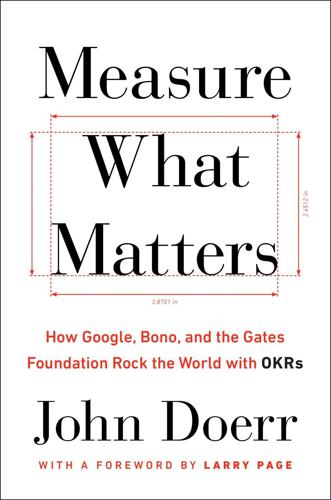
Measure What Matters: How Google, Bono, and the Gates Foundation Rock the World With OKRs
by
John Doerr
Published 23 Apr 2018
They intuitively grasped how OKRs could keep an organization on course through the gales of competition or the tumult of a hockey-stick growth curve. Along with Eric Schmidt, who two years later became Google’s CEO, Larry and Sergey would be tenacious, insistent, even confrontational in their use of OKRs. As Eric told author Steven Levy, “Google’s objective is to be the systematic innovator of scale. Innovator means new stuff. And scale means big, systematic ways of looking at things done in a way that’s reproducible.” Together, the triumvirate brought a decisive ingredient for OKR success: conviction and buy-in at the top. * * * — As an investor, I am long on OKRs.
…
The Gospel of 10x If Andy Grove is the patron saint of aspirational OKRs, Larry Page is their latter-day high priest. In technology, Google stands for boundless innovation and relentless growth. In the world of objectives and key results, the company is synonymous with exponentially aggressive goals, or what author Steven Levy calls “the gospel of 10x.” Consider Gmail. The main problem with earlier web-based email systems was meager storage, typically 2 to 4 megabytes. Users were forced to delete old emails to make room for new ones. Archives were a pipe dream. During Gmail’s development, Google’s leaders considered offering 100MB of storage—an enormous upgrade.
…
It reinvented the category and forced competitors to raise their game by orders of magnitude. Such 10x thinking is rare in any sector, on any stage. Most people, Larry Page observes, “ tend to assume that things are impossible, rather than starting from real-world physics and figuring out what’s actually possible.” In Wired , Steven Levy elaborated: The way Page sees it, a ten percent improvement means that you’re doing the same thing as everybody else. You probably won’t fail spectacularly, but you are guaranteed not to succeed wildly. That’s why Page expects Googlers to create products and services that are ten times better than the competition.
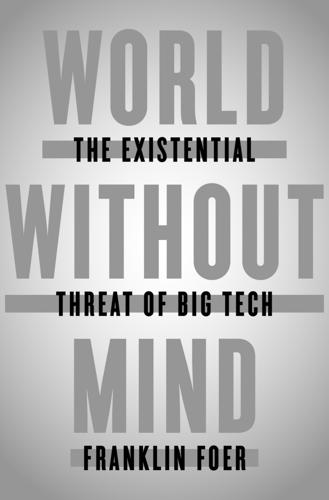
World Without Mind: The Existential Threat of Big Tech
by
Franklin Foer
Published 31 Aug 2017
“There was a cloak-and-dagger element to the procedure”: Steven Levy, In the Plex (Simon & Schuster, 2011), 354. “If you don’t have a reason to talk about it, why talk about it?”: Levy, In the Plex, 355. “Google’s leadership doesn’t care terribly much about precedent or law”: Levy, In the Plex, 353. “We are not scanning all those books to be read by people”: George Dyson, Turing’s Cathedral (Pantheon, 2012), 312–13. “Being negative is not how we make progress”: Page, Google Keynote, May 15, 2013. “How exciting is it to come to work if the best you can do”: Steven Levy, “Google’s Larry Page on Why Moon Shots Matter,” Wired, January 17, 2013.
…
But their discomfort only stirred Page to push forward with his point. “If we solve the problem I outlined, then we’re doing everything.” In moments of candor, Page and Brin admit that they imagine going even further than that—it’s not just about creating an artificial brain but welding it to the human. As Brin once told the journalist Steven Levy, “Certainly if you had all the world’s information directly attached to your brain, or an artificial brain that was smarter than your brain, you’d be better off.” Or as he added on a separate occasion, “Perhaps in the future, we can attach a little version of Google that you just plug into your brain.”
…
When the company decided to digitize every book in existence, it considered copyright law a trivial annoyance, hardly worth a moment’s hesitation. Of course, Google must have had an inkling of how its project would be perceived. That’s why it went about its mission quietly, to avoid scrutiny. “There was a cloak-and-dagger element to the procedure, soured by a clandestine taint,” Steven Levy recounts of the effort, “like ducking out of a 1950s nightclub to smoke weed.” Google’s trucks would pull up to libraries and quietly walk away with boxes of books to be quickly scanned and returned. “If you don’t have a reason to talk about it, why talk about it?” Larry Page would argue, when confronted with pleas to publicly announce the existence of its program.

Don't Be Evil: How Big Tech Betrayed Its Founding Principles--And All of US
by
Rana Foroohar
Published 5 Nov 2019
Marissa Mayer (who once dated Larry Page) once pointed out that if you want to understand Page and his cofounder, you had to know they both went to Montessori schools, where the philosophy emphasizes firing students’ imaginations rather than just stuffing their heads with book learning. Mayer believes their unconventional educations fostered in both Googlers a willful independence and determination to go their own way, regardless of the expectations of others. As she put it to tech journalist Steven Levy in his wonderfully reported book about Google, In the Plex, one of the best sources for early history on the company, “In Montessori school you go paint because you have something to express or you just want to do it that afternoon, not because the teacher said so. This is really baked into how Larry and Sergey approach problems.”14 Just how much their early educations shaped them is impossible to tell, but there’s no question that their college years only reinforced this freewheeling “rules are made to be broken” ideal.
…
But the Googlers felt, in typical form, that such pesky rules didn’t apply to them. Plus, they couldn’t understand why anyone would think it was better for authors to make money on books than for the entire world to have free access to information. So in 2002, they simply began scanning pages, albeit covertly. As tech writer Steven Levy put it in his book, In the Plex, which devotes twenty pages to the book-scanning project, “The secrecy was yet another expression of the paradox of a company that sometimes embraced transparency and other times seemed to model itself on the NSA.”19 Schmidt, who had by then decided that “evil is what Sergey says is evil,”20 was all for the project, which he declared “genius.”21 The publishing industry disagreed.
…
Consider the issues of data privacy and antitrust, for example. One of the major turning points for Google on those issues was the acquisition in 2007 of the ad network DoubleClick, which was the leading firm that helped advertisers and ad agencies decide which websites would be best for hosting their ads. As Steven Levy writes in In the Plex, “the DoubleClick deal radically broadened the scope of the information Google collected about everyone’s browsing activity on the Internet.”20 Competitors and regulators alike questioned the deal, which eventually went through, in large part because Chicago School thinking didn’t really leave any room for a good antitrust argument against it (despite the fact that it would allow Google to essentially control the vast majority of advertising online).
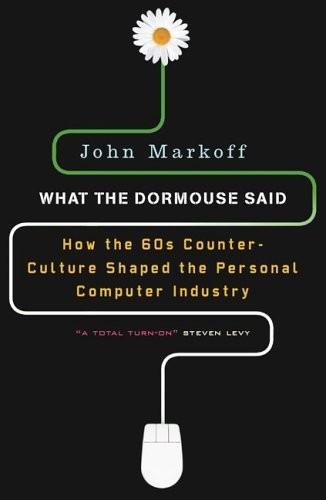
What the Dormouse Said: How the Sixties Counterculture Shaped the Personal Computer Industry
by
John Markoff
Published 1 Jan 2005
.: Creative Computing Press, 1976), pp. 247–50. 5.Ibid. 6.Author interview, Lee Felsenstein, Palo Alto, Calif., August 9, 2001. 7.Fred Moore, unpublished interview with Steven Levy, n.d. 8.John Draper website http://www.webcrunchers.com/crunch/story.html. 9.Author interview with Steven Jobs, Cupertino, Calif., June 2000. 10.Fred Moore, personal journal, 1975. 11.Fred Moore, unpublished interview with Steven Levy, n.d. 12.Ibid. 13.Homebrew Computer Club newsletter 1, March 15, 1975. 14.Ibid. 15.Author interview, Lee Felsenstein, Palo Alto, Calif., August 9, 2001. 16.Tape of San Francisco computer-club planning meeting, April 1975, courtesy of Irene Moore. 17.Doerr’s remark would later be linked to the dot-com era, but he made the claim first with respect to the personal-computer industry.
…
—Kevin Starr, author of Coast of Dreams: California on the Edge, 1990–2003 “John Markoff ’s wonderful recounting of the origins of personal computerdom makes a mind-blowing case that our current silicon marvels were inspired by the psychedelic-tinged, revolution-minded spirit of the Sixties. It’s a total turn-on.” —Steven Levy, author of Hackers, Crypto, and Insanely Great “Beautifully written, What the Dormouse Said does that important job of placing in a historical context the development of modern computer technology. It tells us not only what happened, but why. These people changed our world as much as any group ever and now I understand not only how it came to be but also why it was probably inevitable.”
…
Musicologist John Chowning, who at SAIL invented the technology that underlies modern music synthesizers, called it a “Socratean abode.” SAIL embodied what University of California computer scientist and former SAIL systems programmer Brian Harvey called the “hacker aesthetic.” Harvey’s description was a reaction to what Steven Levy in Hackers: Heroes of the Computer Revolution had described as a “hacker ethic,” which he characterized as the unspoken manifesto of the MIT hackers: Access to computers—and anything which might teach you something about the way the world works—should be unlimited and total. Always yield to the Hands-On Imperative!

The Filter Bubble: What the Internet Is Hiding From You
by
Eli Pariser
Published 11 May 2011
The risk, as Eli Pariser shows, is that each of us may unwittingly come to inhabit a ghetto of one.” —Clay Shirky, author of Here Comes Everybody and Cognitive Surplus “ ‘Personalization’ sounds pretty benign, but Eli Pariser skillfully builds a case that its excess on the Internet will unleash an information calamity—unless we heed his warnings. Top-notch journalism and analysis.” —Steven Levy, author of In the Plex: How Google Thinks, Works and Shapes Our Lives “The Internet software that we use is getting smarter, and more tailored to our needs, all the time. The risk, Eli Pariser reveals, is that we increasingly won’t see other perspectives. In The Filter Bubble, he shows us how the trend could reinforce partisan and narrow mindsets, and points the way to a greater online diversity of perspective.”
…
This isn’t to say that geeks and software engineers are friendless or even socially inept. But there’s an implicit promise in becoming a coder: Apprentice yourself to symbolic systems, learn to carefully understand the rules that govern them, and you’ll gain power to manipulate them. The more powerless you feel, the more appealing this promise becomes. “Hacking,” Steven Levy writes, “gave you not only an understanding of the system but an addictive control as well, along with the illusion that total control was just a few features away.” As anthropologist Coleman points out, beyond the Jocks-and-Nerds stereotypes, there are actually many different geek cultures. There are open-software advocates, most famously embodied by Linux founder Linus Torvalds, who spend untold hours collaboratively building free software tools for the masses, and there are Silicon Valley start-up entrepreneurs.
…
One of the best parts of the writing process was the opportunity to call up or sit down with extraordinary people and ask them questions. I’m thankful to the following folks for responding to my inquiries and helping inform the text: C. W. Anderson, Ken Auletta, John Battelle, Bill Bishop, Matt Cohler, Gabriella Coleman, Dalton Conley, Chris Coyne, Pam Dixon, Caterina Fake, Matthew Hindman, Bill Joy, Dave Karpf, Jaron Lanier, Steven Levy, Diana Mutz, Nicholas Negroponte, Markus Prior, Robert Putnam, John Rendon, Jay Rosen, Marc Rotenberg, Douglas Rushkoff, Michael Schudson, Daniel Solove, Danny Sullivan, Philip Tetlock, Clive Thompson, and Jonathan Zittrain. Conversations with Ethan Zuckerman, Scott Heiferman, David Kirkpatrick, Clay Shirky, Nicco Mele, Dean Eckles, Jessi Hempel, and Ryan Calo were especially provocative and helpful.

Coders: The Making of a New Tribe and the Remaking of the World
by
Clive Thompson
Published 26 Mar 2019
Bruce Damer DigiBarn TV: Mary Allen Wilkes Programming the LINC Computer in the mid-1960s, YouTube, 15:41, April 25, 2011, accessed August 16, 2018, https://www.youtube.com/watch?v=Cmv6p8hN0xQ. “a jig right around the equipment”: Joe November, “LINC: Biology’s Revolutionary Little Computer,” Endeavour 28, no. 3 (September 2004): 125–31. began to cluster around the lab: This section is drawn from Steven Levy’s superb book, particularly chapters 3 (“Spacewar”) and 4 (“Greenblatt and Gosper”): Steven Levy, Hackers: Heroes of the Computer Revolution—25th Anniversary Edition (Sebastopol, CA: O’Reilly Media, 2010). “in milliseconds to what you were doing”: Levy, Hackers, 67. “of the sun or moon it was”: Levy, Hackers, 139. a $120,000 machine: Russell Brandom, “ ‘Spacewar!’
…
Surrounded by a growing crew of young men—and they were all men—the students would spend all night in the lab, often with the lights turned out, lit by the eerie cathode rays. They were enthralled by the feeling of being in a direct, intellectual loop with the computer—“the rush of having this live keyboard under you and having this machine respond in milliseconds to what you were doing,” as Gosper later told the journalist Steven Levy in Levy’s book Hackers. They’d have an idea, code it, and instantly see the results; then tweak more and more, watching each idea come alive on-screen. When they started pursuing a new coding challenge, time stood still. “I was really proud of being able to hack around the clock and not really care what phase of the sun or moon it was,” Gosper said.
…
If they were hacking in the wee hours, as was typical, and their computer broke down, they’d need the proper tools to fix it—only to find that the daytime staff had locked the tools away. So they’d simply hack the locks (making a “master” key from a blank), and abscond with what they needed. “To a hacker, a closed door is an insult, and a locked door is an outrage,” as Steven Levy wrote of those MIT coders in Hackers. “Just as information should be clearly and elegantly transported within a computer, and just as software should be freely disseminated, hackers believed that people should be allowed access to files or tools that might promote the hacker quest to find out and improve the way the world works.

The Internet Is Not the Answer
by
Andrew Keen
Published 5 Jan 2015
The end result of this gigantic math project was an algorithm they called PageRank, which determined the relevance of the Web page based on the number and quality of its incoming links. “The more prominent the status of the page that made the link, the more valuable the link was and the higher it would rise when calculating the ultimate PageRank number of the web page itself,” explains Steven Levy in In the Plex, his definitive history of Google.62 In the spirit of Norbert Wiener’s flight path predictor device, which relied on a continuous stream of information that flowed back and forth between the gun and its operator, the logic of the Google algorithm was dependent on a self-regulating system of hyperlinks flowing around the Web.
…
“How big do you think this could be?” Doerr asked them when they met in 1999. “Ten billion,” Larry Page immediately shot back about a “business” that, at that point, not only didn’t have any revenue, but didn’t even have a coherent model for making money. “And I don’t mean market cap. I mean revenues.” Doerr, Steven Levy noted, “just about fell off his chair” at Page’s boldness.67 But he nonetheless invested in Google, joining Michael Moritz from Sequoia Capital in a joint $25 million Series A round. But two years after the investment, in spite of Google’s establishing itself as the Web’s dominant search engine with 70 million daily search requests, the company—which by now had appointed the “grown-up” Eric Schmidt as CEO—hadn’t figured out a successful business model for monetizing the popularity of its free technology.
…
Doing away with the CPM pricing, Google introduced the auction sales model to AdWords, which some of America’s leading academic economists later described as “spectacularly successful” and “the dominant transaction mechanism in a large and rapidly growing industry.”68 Rather than buying online advertising at a set price, advertisers were now able to bid in what Steven Levy calls a real-time “unique auction” that simultaneously made online advertising more effective and profitable.69 Alongside AdWords, Google also developed an increasingly successful product called AdSense, which provided the tools to buy and measure advertising on websites not affiliated with the search engine.

From Satori to Silicon Valley: San Francisco and the American Counterculture
by
Theodore Roszak
Published 31 Aug 1986
"Buddhist Anarchism" by Gary Snyder, Copy- From The Journal for Beings, McClure, Ferlinghetti & the Protection of All Meltzer, editors, City Lights, San Francisco. DELACORTE PRESS for "All Watched Over by Machines of Loving Grace" by Richard Brautigan, copyright 1968. Excerpted from The Pill Versus the Springhill Mine Disaster, reprinted by permission of Delacorte Press/Seymour Lawrence, New York. DOUBLEDAY & CO. for Hackers by Steven Levy, copyright 1984. PRAEGER PUBLISHERS Society, edited for quote by Bill Voyd from Shelter and by Paul Oliver, copyright 1969. SAN FRANCISCO FOCUS MAGAZINE view with Stewart Brand in the for quotes from an inter- February 1985 issue. SAN FRANCISCO ORACLE for quotes from issues #6, 1967, and #12, 1967.
…
Robert Snyder, Buckminster Fuller, graphical Monologue! Scenario, New An Autobio- Martin's Press, York, 1970, p. 38. 4. Bill Voyd, "Drop City", Sources, Harper 5. St. Hugh Press, & Row, in New Theodore Roszak, Gardner, Children of Prosperity, New St. Martin's York, 1978, p. 37. New 6. Steven Levy, Hackers, Doubleday, p. 169-170. 7. Hackers, 8. San Francisco Oracle, No. 9. San Francisco Focus Magazine, Feb. 1985, 10. ed. York, 1972, p. 276. p. York, 1984, 251. 6, 1967. San Francisco Oracle, No. 56 12, 1967. p. 107. FROM SATORI TO SILICON VALLEY Theodore Roszak Theodore Roszak General Studies at is Professor of History and Chairman of California State University, Hay ward.

Crypto: How the Code Rebels Beat the Government Saving Privacy in the Digital Age
by
Steven Levy
Published 15 Jan 2002
My agent, Flip Brophy, was once again a flawless advisor and facilitator. And some early readers caught mistakes and offered great suggestions (I won’t cite them by name because any errors are solely mine). Those who discover more are encouraged to get in touch with me through my Web site (www.steven levy.com), where I will post corrections and updates. Words, even in plaintext, can’t express what I owe my family, Andrew and Teresa. Steven Levy, September 2000 preface the telegraph, telephone, radio, and especially the computer have put everyone on the globe within earshot—at the price of our privacy. It may feel like we’re performing an intimate act when, sequestered in our rooms and cubicles, we casually use our cell phones and computers to transmit our thoughts, confidences, business plans, and even our money.
…
Davis, “Use of Clipper Chip in AT&T TSD 3600 During Phase of Production,” memo to Sessions, December 23, 1992. 240 Encryption, Law Enforcement Briefing document sent to Tenet, February 19, 1993. 244 slide show “Telecommunications Overview” prepared by the FBI’s Advanced Telephony Unit. 248 Barlow “Jackboots on the Infobahn,” reprinted in Ludlow’s High Noon on the Electronic Frontier, pp. 207–13. 249 Denning See Steven Levy, “Clipper Chick,” Wired, September 1996. 249 Pilgrim maiden Sterling, The Hacker Crackdown, p. 299. 249 important step “Statement by the Press Secretary,” The White House, April 16, 1993. 250 Times article John Markoff, “New Communication System Stirs Talk of Privacy vs. Eavesdropping,” April 16, 1993. 252 It’s not America Steven Levy, “Uncle Sam.” 252 Safire “Sink the Clipper,” New York Times, February 4, 1994. 253 lion’s den Baker’s speech was adapted as “Don’t Worry Be Happy: Why Clipper Is Good for You,” in Wired, June 1994. 253 Skipjack E.
…
Penguin Books Ltd, 27 Wrights Lane, London W8 5TZ, England Penguin Books Australia Ltd, Ringwood, Victoria, Australia Penguin Books Canada Ltd, 10 Alcorn Avenue, Toronto, Ontario, Canada M4V 3B2 Penguin Books (N.Z.) Ltd, 182–190 Wairau Road, Auckland 10, New Zealand Penguin Books Ltd, Registered Offices: Harmondsworth, Middlesex, England First published in 2001 by Penguin, A member of Penguin Putnam Inc. Copyright © Steven Levy, 2001 All rights reserved ISBN 0-7865-2194-5 Electronic edition: February 2002 Without limiting the rights under copyright reserved above, no part of this publication may be reproduced, stored in or introduced into a retrieval system, or transmitted, in any form or by any means (electronic, mechanical, photocopying, recording or otherwise), without the prior written permission of both the copyright owner and the above publisher of this book.
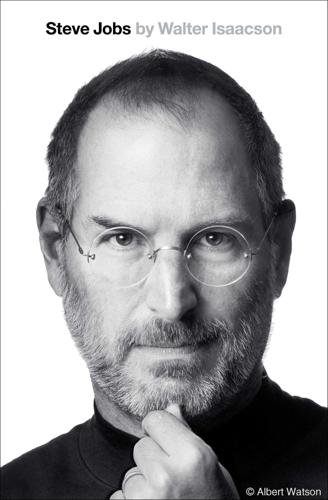
Steve Jobs
by
Walter Isaacson
Published 23 Oct 2011
The Stanford Commencement: Interviews with Steve Jobs, Laurene Powell. Steve Jobs, Stanford commencement address. A Lion at Fifty: Interviews with Mike Slade, Alice Waters, Steve Jobs, Tim Cook, Avie Tevanian, Jony Ive, Jon Rubinstein, Tony Fadell, George Riley, Bono, Walt Mossberg, Steven Levy, Kara Swisher. Walt Mossberg and Kara Swisher interviews with Steve Jobs and Bill Gates, All Things Digital conference, May 30, 2007; Steven Levy, “Finally, Vista Makes Its Debut,” Newsweek, Feb. 1, 2007. CHAPTER 36: THE iPHONE An iPod That Makes Calls: Interviews with Art Levinson, Steve Jobs, Tony Fadell, George Riley, Tim Cook. Frank Rose, “Battle for the Soul of the MP3 Phone,” Wired, Nov. 2005.
…
The article also described the mix of volatility and charisma displayed by his boss: “Jobs sometimes defends his ideas with highly vocal displays of temper that aren’t always bluster; rumor has it that he has threatened to fire employees for insisting that his computers should have cursor keys, a feature that Jobs considers obsolete. But when he is on his best behavior, Jobs is a curious blend of charm and impatience, oscillating between shrewd reserve and his favorite expression of enthusiasm: ‘Insanely great.’” The technology writer Steven Levy, who was then working for Rolling Stone, came to interview Jobs, who urged him to convince the magazine’s publisher to put the Macintosh team on the cover of the magazine. “The chances of Jann Wenner agreeing to displace Sting in favor of a bunch of computer nerds were approximately one in a googolplex,” Levy thought, correctly.
…
You could grab its cute little handle and lift it out of the elegant white box and plug it right into a wall socket. People who had been afraid of computers now wanted one, and they wanted to put it in a room where others could admire and perhaps covet it. “A piece of hardware that blends sci-fi shimmer with the kitsch whimsy of a cocktail umbrella,” Steven Levy wrote in Newsweek, “it is not only the coolest-looking computer introduced in years, but a chest-thumping statement that Silicon Valley’s original dream company is no longer somnambulant.” Forbes called it “an industry-altering success,” and John Sculley later came out of exile to gush, “He has implemented the same simple strategy that made Apple so successful 15 years ago: make hit products and promote them with terrific marketing.”

The Everything Store: Jeff Bezos and the Age of Amazon
by
Brad Stone
Published 14 Oct 2013
Six months after that investment, over the summer of 1998, Bezos and MacKenzie were in the Bay Area for a camping trip with friends, and Bezos told Shriram that he wanted to meet the Google guys. On a Saturday morning, Shriram picked up Bezos and his wife at a local hotel, the Inn at Saratoga, and drove them to his home. Page and Brin met them there for breakfast and demonstrated their modest search engine. Years later, Bezos told journalist Steven Levy that he was impressed by the Google guys’ “healthy stubbornness” as they explained why they would never put advertisements on their home page.6 Brin and Page left Shriram’s house after breakfast. Revealing once again his utter faith in passionate entrepreneurs’ power to harness the Internet, Bezos immediately told Shriram that he wanted to personally invest in Google.
…
Oprah Winfrey included the Rocketbook among her Ten Favorite Things in the inaugural issue of O magazine, and Wired wrote of the device, “It’s like an object that has tumbled out of the future.”2 NuvoMedia had an aggressive road map for rapid development. Eberhard planned to exploit economies of scale and advances in technology to improve the Rocketbook’s screen quality and battery life while driving down its price. (Over the 1999 holiday season, the basic model cost $169.) “Within five years,” he told Newsweek’s Steven Levy that December, “We’ll have front-surface technology that doesn’t require you to read behind glass.”3 But NuvoMedia still needed fresh capital, and Eberhard was growing nervous about the unsustainable dot-com bubble and the deteriorating fund-raising climate. In February 2000, he sold NuvoMedia to a Burbank-based interactive TV-guide firm called Gemstar in a stock transaction worth about $187 million.
…
My editor Jim Aley provided a careful first read. Diana Suryakusuma helped me assemble the photographs under a tight deadline. My friend and colleague Ashlee Vance proved an invaluable sounding board when I needed to discuss the thornier challenges of telling this story. I also want to thank fellow journalists Steven Levy, Ethan Watters, Adam Rogers, George Anders, Dan McGinn, Nick Bilton, Claire Cain Miller, Damon Darlin, John Markoff, Jim Brunner, Alan Deutschman, Tom Giles, Doug MacMillan, Adam Satariano, Motoko Rich, and Peter Burrows. Nick Sanchez provided stellar research and reporting assistance for this book, and Morgan Mason from the journalism program at the University of Nevada at Reno assisted with interviews of Amazon associates at the fulfillment center in Fernley, Nevada.
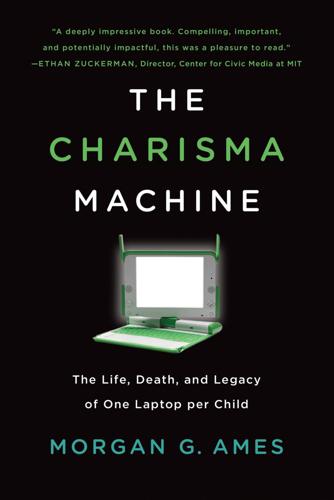
The Charisma Machine: The Life, Death, and Legacy of One Laptop Per Child
by
Morgan G. Ames
Published 19 Nov 2019
Under these conditions, Papert says, computers could finally scale up the ideals of “progressive education.”30 Papert attributes his realization that computers can be powerful tools for learning to his experiences with MIT’s hacker community, which he first encountered in Minsky’s Artificial Intelligence Lab in the 1960s. This group, which was first described in detail by journalist Steven Levy in his book Hackers: Heroes of the Computer Revolution (1984) and later analyzed by scholars tracing early computing cultures, also believed in unrestricted access to the mainframe computers in Minsky’s lab—Papert describes joining this group for all-night hacking sessions. Extending MIT’s longstanding culture of elaborate “hacks” (pranks), this group started calling themselves “hackers.”
…
“Impatient with the glacial pace of incremental reform, free of institutional memories of past shooting-star reforms” that failed to revolutionize day-to-day schooling and “sometimes hoping for quick profits as well as a quick fix,” educational historians David Tyack and Larry Cuban explain, reformers point to technology—such as Papert’s Logo-enabled computers and OLPC’s laptops—as the best method to “reinvent” education.75 4. Antiauthority and the Glorification of Healthy Rebellion The deep distrust of school apparent in these descriptions of constructionism reflects the hacker community’s mistrust of authority figures more generally—a mistrust so codified in the culture that Steven Levy canonized it in two of the six tenets of what he called the “hacker ethic.” Levy described this ethic, the core principles of the hacker community, drawing on the time he spent with the hacker group at MIT; the ethic was subsequently embraced by many in the hacker world. The third tenet reads, “Mistrust authority; promote decentralization,” and the fourth is “Hackers should be judged by their hacking, not bogus criteria such as degrees, age, race, sex, or position.”76 This group decried school as an example of the authority they distrusted; instead, they found great solace in computers and celebrated others who felt the same.
…
Technical books such as The Boy Mechanic: 700 Things for Boys to Do (1913), the frontispiece of which “shows a boy ready to step off a cliff in a glider that he has built according to the instructions on page 171,” provided one avenue to channel this rebellion and a clearly-stated target: boys.82 Later, certain kinds of masculine rebellion became an integral part of early cyberculture communities, which historians Fred Turner and Nathan Ensmenger have shown adopted individualist countercultural norms to push back against early notions of computer programmers as mindless suits, low-status clerical work, or tools for corporate control.83 Narratives about the kinds of “all in good fun” masculine rebellion that computers could enable were popularized in the 1980s through nonfiction books such as Steven Levy’s Hackers, novels such as Neuromancer by William Gibson, and movies such as War Games and Tron.84 These media imbued cyberspace with metaphors steeped in rebellion: of the Wild West, of Manifest Destiny, of a new frontier of radical individualism and ecstatic self-fulfillment.85 It also encouraged a libertarian sensibility, where each actor was considered responsible for their own actions, education, and livelihoods—even when that meant ignoring the massive infrastructures that made the seemingly freewheeling space of the cyberspace frontier possible.

The Code: Silicon Valley and the Remaking of America
by
Margaret O'Mara
Published 8 Jul 2019
One result was one of the most famous pieces of television advertising in history, the jaw-dropping spot broadcast into millions of American living rooms during the 1984 Super Bowl, when a lithe young woman ran through a droning audience, hurled a hammer at a Big Brother–like image projected on a blue screen, and shattered it.5 The barely veiled punch at IBM, Apple’s chief rival, reflected a broader anti-establishment streak in this techie rhetoric that went beyond marketing plans and ad slogans. “Mistrust Authority—Promote Decentralization,” read one plank of the “hacker ethic” journalist Steven Levy used in 1984 to describe the remarkable new subculture of hardware and software geeks who had helped make the computer personal. “Authority” meant Big Blue, big business, and big government. It was the perfect message for the times. After more than ten years of unrelentingly dismal business news—plant shutdowns, blue-collar jobs vanishing overseas, fumbling corporate leaders, and the pummeling of American brands by foreign competitors—high-tech companies presented a bright, promising contrast.
…
The personal computer had triumphantly moved in, particularly for American children and teenagers. Computer nerds had become familiar, sympathetic pop-culture characters, whether they were fictional figures from movies or television, or real-life multimillionaires like Jobs and Gates. Right at the same time that the SDI battles were brewing, journalist Steven Levy was immortalizing the history of this rebellious breed in Hackers. (The Valley tech community had been so delighted by their heroic portrayal in the book that they reclaimed the label as an honorific, and Stewart Brand began holding an annual “Hackers Conference” to celebrate the movement they had forged.)
…
In 1985 came the most famous of the early BBSs: The WELL, or Whole Earth ’Lectronic Link, started by Stewart Brand and his merry band of hackers up in Marin County. The WELL’s fame came from the Silicon Valley celebrities who made it their first online hangout, including Grateful Dead lyricist John Perry Barlow, journalist Steven Levy, Lotus founder Mitch Kapor, and of course Brand himself. The bland Ohioans running CompuServe (now owned by even blander tax preparer H&R Block) couldn’t compete with The WELL’s glamour and dash. The WELL’s pedigree was decidedly countercultural, as it hired a clutch of its founding staff from the legendary Tennessee commune The Farm, and devoted considerable discussion-thread and file-swapping bandwidth to the Dead.
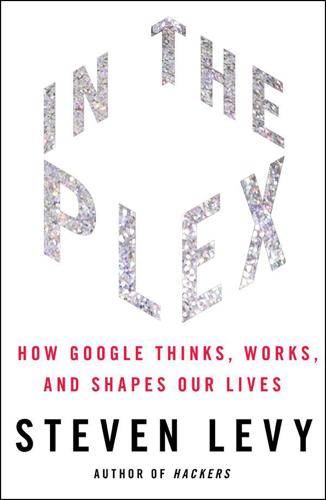
In the Plex: How Google Thinks, Works, and Shapes Our Lives
by
Steven Levy
Published 12 Apr 2011
ALSO BY STEVEN LEVY The Perfect Thing: How the iPod Shuffles Commerce, Culture, and Coolness Crypto: How the Code Rebels Beat the Government— Saving Privacy in the Digital Age Insanely Great: The Life and Times of Macintosh, the Computer That Changed Everything Artificial Life: The Quest for a New Creation The Unicorn’s Secret: Murder in the Age of Aquarius Hackers: Heroes of the Computer Revolution Simon & Schuster 1230 Avenue of the Americas New York, NY 10020 www.SimonandSchuster.com Copyright © 2011 by Steven Levy All rights reserved, including the right to reproduce this book or portions thereof in any form whatsoever.
…
For more information or to book an event contact the Simon & Schuster Speakers Bureau at 1-866-248-3049 or visit our website at www.simonspeakers.com. Designed by Ruth Lee Mui Manufactured in the United States of America 10 9 8 7 6 5 4 3 2 1 Library of Congress Cataloging-in-Publication Data Levy, Steven. In the plex : how Google thinks, works, and shapes our lives / Steven Levy. —1st Simon & Schuster hbk. ed. p. cm. Includes bibliographical references and index. 1. Google (Firm). 2. Google. 3. Internet industry—United States. I. Title. HD9696.8.U64G6657 2011 338.7'6102504—dc22 2010049964 ISBN 978-1-4165-9658-5 ISBN 978-1-4165-9671-4 (ebook) Contents Prologue Searching for Google One The World According to Google: Biography of a Search Engine Two Googlenomics: Cracking the Code on Internet Profits Three Don’t Be Evil: How Google Built Its Culture Four Google’s Cloud: Building Data Centers That Hold Everything Ever Written Five Outside the Box: The Google Phone Company and the Google TV Company Six GuGe: Google’s Moral Dilemma in China Seven Google.gov: Is What’s Good for Google Good for Government—or the Public?
…
I also drew on the accounts of the company provided by other journalists, notably John Battelle, The Search (Portfolio, 2005), David Vise and Mark Malseed, The Google Story (Delacorte, 2005), Randall Stross, Planet Google (Free Press, 2008), Richard Brandt, Inside Larry and Sergey’s Brain (Portfolio, 2009), and Ken Auletta, Googled (Penguin, 2009). I also consulted the hundreds of articles in magazines, newspapers, and online sources. Prologue 1 “Have you heard of Google?” I wrote about the APM trip in “Google Goes Globe-Trotting,” Newsweek, November 3, 2007. 2 “Google, the Net’s hottest search engine” Steven Levy, “Free PCs … for a Price,” Newsweek, February 22, 1999. It was an article about Bill Gross, contrasting his GoTo search engine’s prowess unfavorably to Google’s. 4 “We envision a world” The description is reprinted in a blog item by Dan Siroker, “What would you say you do here?” Siroker Brothers (blog), May 11, 2006.
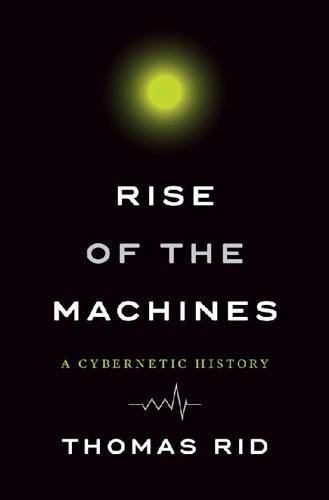
Rise of the Machines: A Cybernetic History
by
Thomas Rid
Published 27 Jun 2016
OEMsr-435 (New York: Bell Telephone Laboratories, 1944). 3.James Ellis, The Possibility of Secure Non-Secret Digital Encryption, research report no. 3006 (Cheltenham, UK: GCHQ/CESG, 1970). 4.Quoted in Steven Levy, Crypto (New York: Penguin, 2000), 396. 5.Clifford Cocks, quoted in Simon Singh, The Code Book (London: Fourth Estate, 1999), 285. 6.Ellis, Possibility. 7.“You did more with it than we did,” Ellis once told fellow cryptographer Whitfield Diffie, but he refused to say more. See the last paragraph of Steven Levy’s Crypto. 8.Whitfield Diffie and Martin Hellman, “New Directions in Cryptography,” IEEE Transactions on Information Theory 22, no. 6 (November 1976): 644–54. 9.For an excellent and more detailed description, see Levy, Crypto, 90–124. 10.Martin Gardner, “A New Kind of Cipher That Would Take Millions of Years to Break,” Scientific American 237, no. 2 (August 1977): 120–24. 11.Singh mentions three thousand letters; Levy, seven thousand.
…
The article that spelled out the idea became one of his most influential papers, “Numbers Can Be a Better Form of Cash Than Paper.” But using this improved form of cash was not only about convenience and security. If crypto cash would not be adopted widely, Chaum feared, “invisible mass surveillance” would be inevitable, “perhaps irreversible.”17 Chaum’s idea was magically simple and powerful. Steven Levy, a perceptive chronicler of the grand cryptography debate of the 1990s, called him the “Houdini of crypto.”18 So powerful were Chaum’s ideas that an entire movement arose. That movement believed crypto was en route to making the state as we know it obsolete. Many of these early cryptographers had been exposed to a powerful streak of American culture: civil libertarianism with its deep-seated distrust of the federal government—or of any government.
…
May and Hughes began to rope in others. A group of sixteen people started meeting every Saturday in an office building near Palo Alto full of small tech start-ups. The room had a conference table and corporate-gray carpeting. Stewart Brand was at one of the first meetings, as were Kevin Kelly and Steven Levy, the two Wired writers. They were all united by that unique Bay Area blend: passionate about technology, steeped in counterculture, and unswervingly libertarian. The crypto group also shared one other thing: a frustration with the slow pace of cryptographic progress. Chaum’s ideas were ten years old, yet there was still no digital cash, no anonymity by remailer, no privacy, and no security built into the emerging cyberspace.

Whole Earth: The Many Lives of Stewart Brand
by
John Markoff
Published 22 Mar 2022
BACK TO NOTE REFERENCE 22 Ken Kelley, “The Interview: Whole Earthling and Software Savant Stewart Brand,” SF Focus, February 1985, 76. BACK TO NOTE REFERENCE 23 Steven Levy, Hackers: Heroes of the Computer Revolution (New York: Anchor Press/Doubleday, 1984), 27–32. BACK TO NOTE REFERENCE 24 Fentress,“The Next to Last Book on Earth.” BACK TO NOTE REFERENCE 25 John Markoff, “Up to Date,” BYTE, March 1985, 355. BACK TO NOTE REFERENCE 26 Steven Levy, “Hackers at 30: ‘Hackers’ and ‘Information Wants to Be Free,’ ” WIRED BackChannel, https://www.wired.com/story/hackers-at-30-hackers-and-information-wants-to-be-free/ BACK TO NOTE REFERENCE 27 Levy, “Hackers at 30.”
…
Although the first issue of the combined Whole Earth Review was titled “Computers as Poison,” Brand was outwardly sanguine: “Computers suppress our animal presence,” he told an SF Focus interviewer. “When you communicate through a computer, you communicate like an angel.”[23] Just a few years later he would realize how naive he had been. * * * Shortly after he arrived in Sausalito, Kevin Kelly read Steven Levy’s Hackers: Heroes of the Computer Revolution, a book that portrayed three generations of “white hat” computer hackers (the good guys) ranging from the young programmers at MIT’s AI Lab decades earlier, through the Homebrew Computer Club, to the then new world of video game design. (The term hacker had only recently entered the national lexicon.
…
Brand married Ryan Phelan in 1983 in a Zen Buddhist ceremony at Green Gulch, a rural retreat center and farm in the hills overlooking the Pacific Ocean. To appease Phelan’s mother, a Catholic prayer was read during the ceremony. Kevin Kelly had the original idea of an event that would allow the characters in Steven Levy’s Hackers to meet one another. Brand and Phelan helped organize the event, which was held in the fall of 1984. In response to a remark by Apple cofounder Steve Wozniak, Brand said, “Information wants to be expensive . . . and information wants to be free.” Virtually everyone ignored the first half of his aphorism, and “Information wants to be free” would become the rallying cry of the dot-com era.
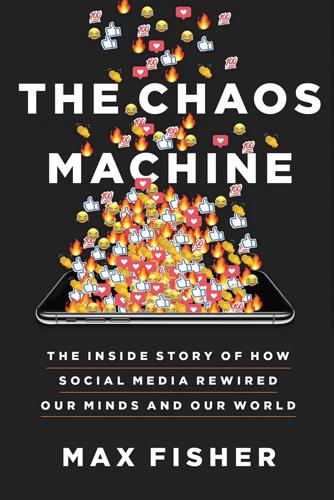
The Chaos Machine: The Inside Story of How Social Media Rewired Our Minds and Our World
by
Max Fisher
Published 5 Sep 2022
For Friendster: “The Friendster Autopsy: How a Social Network Dies,” Robert McMillan, Wired, February 27, 2013, and “Friendster Patents Social Networking,” Pete Cashmore, Mashable, July 7, 2006. For Orkut: “Google’s Orkut Captivates Brazilians,” by Seth Kugel, New York Times, April 9, 2006. For Myspace: “The Decline of Myspace: Future of Social Media,” Karl Kangur, DreamGrow, August 13, 2012. 7 get off the startup roller coaster: Facebook: The Inside Story, Steven Levy, 2020, relays detailed, firsthand accounts from Zuckerberg and other high-ranking employees of the decision to turn down the Yahoo offer, as well as the subsequent news feed episode. 8 a matter of consensus: This phenomenon, known to social scientists as common knowledge, is perhaps best captured in “How Does Media Influence Social Norms?
…
Milner, 2021: 58. 40 “an outcome they prodded”: Ibid. 41 “Trolling is basically”: Schwartz. 42 “the perfect conditions”: Phillips and Milner: 78. 43 Auernheimer bragged of his role: “The End of Kindness: Weev and the Cult of the Angry Young Man,” Greg Sandoval, The Verge, September 12, 2013. 44 In 2010, TechCrunch: “We’re Awarding Goatse Security a Crunchie Award for Public Service,” Michael Arrington, TechCrunch, June 14, 2010. 45 “journalists drank alongside hackers”: “Lulz and Leg Irons: In the Courtroom with Weev,” Molly Crabapple, Vice News, March 19, 2013. 46 “We’re making a blue-ocean bet”: “The Kleiner Perkins sFund: A $250 Million Bet That Social Is Just Getting Started,” Michael Arrington, TechCrunch, October 21, 2010. 47 “three themes that you CEOs”: “CEO 2.0,” address by Bing Gordon to Endeavor Entrepreneur Summit in San Francisco, California, June 28, 2011. 48 the North American video game crash: A comprehensive account of this history can be found in “No Girls Allowed,” Tracey Lien, Polygon.com, December 2, 2013. 49 “They weren’t fighting for the right”: “How the Alt-Right’s Sexism Lures Men into White Supremacy,” Aja Romano, Vox, April 26, 2018. 50 “I remember people saying”: Facebook: The Inside Story, Steven Levy, 2020: 213. 51 Robin Dunbar had proposed: “Coevolution of Neocortical Size, Group Size, and Language in Humans,” Robin Dunbar, Behavioral and Brain Sciences 16, 1993. 52 the average Facebook user had about 130 friends: This was reported by Facebook’s now-defunct statistics page as of 2010. See, for example, “10 Fascinating Facebook Facts,” Mashable, July 22, 2010. 53 Friendster even capped: “Friends, Friendsters, and Top 8: Writing Community into Being on Social Network Sites,” Danah Boyd, First Monday 11, no. 12, December 2006. 54 “escaping the Dunbar curse”: “Like, How Many Friends Does Facebook Need?”
…
Adamic, Science 348, no. 6239, May 7, 2015. 28 “associated with adopting more extreme”: Ibid. 29 “Which of the big questions”: Exchange is from the comments field in “For the Next Hour I’ll Be Here Answering Your Questions on Facebook,” Mark Zuckerberg, Facebook.com, June 30, 2015. 30 “Every time you use Facebook”: “Inside Facebook’s AI Machine,” Steven Levy, Wired, February 2017. 31 “If they do these”: “News Feed: Getting Your Content to the Right People,” Adam Mosseri, presentation to Facebook F8 conference in San Francisco, April 21, 2016. 32 “When users spend more”: Doerr: 161. 33 Facebook engineers were automatically: “I was an eng leader on Facebook’s NewsFeed,” Krishna Gade, Twitter, February 11, 2021.

The Innovators: How a Group of Inventors, Hackers, Geniuses and Geeks Created the Digital Revolution
by
Walter Isaacson
Published 6 Oct 2014
The members of the “Signals and Power Subcommittee” tended to the relays, wires, circuits, and crossbar switches, which were rigged together on the underside of the board to provide a complex hierarchy of controllers for the numerous trains. In this tangled web they saw beauty. “There were neat regimental lines of switches, and achingly regular rows of dull bronze relays, and a long, rambling tangle of red, blue, and yellow wires—twisting and twirling like a rainbow-colored explosion of Einstein’s hair,” Steven Levy wrote in Hackers, which begins with a colorful depiction of the club.2 Members of the Signals and Power Subcommittee embraced the term hacker with pride. It connoted both technical virtuosity and playfulness, not (as in more recent usage) lawless intrusions into a network. The intricate pranks devised by MIT students—putting a live cow on the roof of a dorm, a plastic cow on the Great Dome of the main building, or causing a huge balloon to emerge midfield during the Harvard-Yale game—were known as hacks.
…
The first issue, in October 1972, had on its cover a drawing of a boat sailing into the sunset and the hand-scrawled declaration “Computers are mostly used against people instead of for people; used to control people instead of to free them; Time to change all that—we need a PEOPLE’S COMPUTER COMPANY.”81 Most issues featured lots of line drawings of dragons—“I loved dragons ever since I was thirteen,” Albrecht recalled—and stories about computer education, BASIC programming, and various learning fairs and do-it-yourself technology festivals.82 The newsletter helped to weave together electronic hobbyists, do-it-yourselfers, and community-learning organizers. Another embodiment of this culture was Lee Felsenstein, an earnest antiwar protestor with an electrical engineering degree from Berkeley who became a featured character in Steven Levy’s Hackers. Felsenstein was far from being a Merry Prankster. Even in the heady days of student unrest at Berkeley, he eschewed sex and drugs. He combined a political activist’s instinct for community organizing with an electronic geek’s disposition for building communications tools and networks.
…
But if they did a search and returned right away to revise their query, it meant that they were dissatisfied and the engineers should learn, by looking at the refined search query, what they had been seeking in the first place. Anytime users scrolled to the second or third page of the search results, it was a sign that they were unhappy with the order of results they received. As the journalist Steven Levy pointed out, this feedback loop helped Google learn that when users typed in dogs they also were looking for puppies, and when they typed in boiling they might also be referring to hot water, and eventually Google also learned that when they typed in hot dog they were not looking for boiling puppies.158 One other person came up with a link-based scheme very similar to PageRank: a Chinese engineer named Yanhong (Robin) Li, who studied at SUNY Buffalo and then joined a division of Dow Jones based in New Jersey.

Protocol: how control exists after decentralization
by
Alexander R. Galloway
Published 1 Apr 2004
Hackers are the type of technophiles you like to have around in a pinch, for given enough time they generally can crack any problem (or at least find a suitable kludge). Thus, as Bruce Sterling writes, the term hacker “can signify the freewheeling intellectual exploration of the highest and deepest potential of computer systems.”8 Or as Steven Levy glowingly reminisces about the original MIT hackers of the early sixties, “they were such fascinating people. . . . Beneath their often unimposing exteriors, they were adventurers, visionaries, power, it exists as an abstraction” (p. 13). A protocological analysis shows that control is almost never in abstract form.
…
You can create art and beauty on a computer. Computers can change your life for the better.12 Several of Levy’s points dovetail with my earlier conclusions about protocol. Like the hacker’s access to computers, protocol is unlimited and total. Like the hacker’s mistrust of authority, protocol also seeks to eliminate arbitrary 9. Steven Levy, Hackers: Heroes of the Computer Revolution (New York: Anchor Press/Doubleday, 1984), p. ix. 10. This dictum is attributed to Stewart Brand, who wrote that “[o]n the one hand information wants to be expensive, because it’s so valuable. The right information in the right place just changes your life.
…
Hacking 161 Access to computers . . . should be unlimited and total. All information should be free. Mistrust authority— promote decentralization. Hackers should be judged by their hacking, not bogus criteria such as degrees, age, race, or position. You can create art and beauty on a computer. Computers can change your life for the better. —Steven Levy, 1984 We explore . . . and you call us criminals. We seek after knowledge . . . and you call us criminals. We exist without skin color, without nationality, without religious bias . . . and you call us criminals . . . Yes, I am a criminal. My crime is that of curiosity. My crime is that of judging people by what they say and think, not what they look like.

A People’s History of Computing in the United States
by
Joy Lisi Rankin
O’Neill, and Kerry J. Freedman, Transforming Computer Technology: Information Pro cessing for the Pentagon, 1962–1986 (Baltimore: Johns Hopkins University Press, 1996); M. Mitchell Waldrop, The Dream Machine: J. C. R. Licklider and the Revolution That Made Computing Personal (New York: Penguin Books, 2002); Steven Levy, Hackers: Heroes of the Computer Revolution (Sebastopol, CA: O’Reilly Media, 2010). 51. Corbató, Merwin- Daggett, and Daley, “An Experimental Time- Sharing System,” 337. 52. Kurtz, Rieser, and Meck, “Application to the National Science Foundation”; Kemeny, “A Computing Center at a Liberal Arts College.” 53.
…
Note that all subsequent references to Kiewit Comments refer to the Rauner Library collection. 6. United States President’s Science Advisory Committee, Panel on Computers in Education (John R. Pierce et al.), Computers in Higher Education: Report of the President’s Science Advisory Committee (Washington, DC: The White House, February 1967). 7. Detail on copies sold from Steven Levy, Hackers: Heroes of the Computer Revolution (Sebastopol, CA: O’Reilly Media, 2010), 168; and from Bob Johnstone, Never Mind the Laptops: Kids, Computers, and the Transformation of Learning (New York: iUniverse, 2003), 66. 8. “Huntington,” People’s Computer Company 1, no. 1 (October 1972): 3. 9.
…
Fano (1989), Charles Babbage Institute, retrieved from the University of Minnesota Digital Conservancy, http://hdl .handle.net/11299/107281; David Walden and Tom Van Vleck, eds., The Compatible Time Sharing System (1961–1973), 50th Anniversary Commemorative Overview (Washington, DC: IEEE Computer Society, 2011), http://multicians.org /t hvv/compatible-t ime-sharing-system.pdf; Steven Levy, Hackers: Heroes of the Computer Revolution (Sebastopol, CA: O’Reilly Media, 2010). 12. John L. Rudolph, Scientists in the Classroom: The Cold War Reconstruction of American Science Education (New York: Palgrave, 2002); Audra J. Wolfe, “Speaking for Nature and Nation: Biologists as Public Intellectuals in Cold War Culture” (PhD diss., University of Pennsylvania, 2002); Audra J.

The Mysterious Mr. Nakamoto: A Fifteen-Year Quest to Unmask the Secret Genius Behind Crypto
by
Benjamin Wallace
Published 18 Mar 2025
I benefited immensely from the prior work of other journalists, interviewers, and researchers who have covered parts of this story. In particular, I am indebted to articles, books, and podcasts by John Biggs, Gwern Branwen, Thomas Brewster, Adrian Chen, Andy Cush, Dustin Dreifuerst, Tim Ferriss, Lex Fridman, Andy Greenberg, Adrianne Jeffries, Steven Levy, Cheyenne Ligon, Jameson Lopp, Giana Magnoli, Max Marty, Peter McCormack, Robert McMillan, Andrew O’Hagan, Arthur van Pelt, Nathaniel Popper, Jamie Redman, Ed Regis, Bailey Reutzel, Pete Rizzo, Kai Sedgwick, Charlie Shrem, Tom Simonite, Paul Vigna, Daniel Walters, Nicole Weinstock, and Rob Wile.
…
GO TO NOTE REFERENCE IN TEXT had written Hashcash: Adam Back, “[ANNOUNCE] hash cash postage implementation,” CP, March 28, 1997. GO TO NOTE REFERENCE IN TEXT who had written to him in August of 2008: Pete Rizzo, “Read Adam Back’s Complete Emails with Bitcoin Creator Satoshi Nakamoto,” Bitcoin Magazine, February 23, 2024. GO TO NOTE REFERENCE IN TEXT driving a Volkswagen van: Steven Levy, “E-Money (That’s What I Want),” Wired, December 1994. GO TO NOTE REFERENCE IN TEXT sitting in a hot tub: Adriana Hamacher, “How David Chaum Went from Inventing Digital Cash to Pioneering Digital Privacy,” Decrypt, April 8, 2022. GO TO NOTE REFERENCE IN TEXT “I don’t tell that to people.”: Levy, “E-Money.”
…
.”: Levy, “E-Money.” GO TO NOTE REFERENCE IN TEXT “mathematicians with guns”: Tim Starr, interview. GO TO NOTE REFERENCE IN TEXT Mathematicians with Guns twenty revolutionaries gathered in a living room: Details of the first cypherpunk meeting are from Steven Levy, Crypto: Secrecy and Privacy in the New Code War (New York: Penguin, 2002), 209–11; Andy Greenberg, This Machine Kills Secrets: Julian Assange, the Cypherpunks, and Their Fight to Empower Whistleblowers (New York: Plume, 2013), 79–81; and Timothy C. May, email to Seth Morris, “GAMES: The ‘Crypto Anarchy Game,’ ” CP, February 23, 1994.

The Man From the Future: The Visionary Life of John Von Neumann
by
Ananyo Bhattacharya
Published 6 Oct 2021
Steven Wolfram, 1984, ‘Universality and Complexity in Cellular Automata’, Physica D, 10(1–2), pp. 1–35. 46. Steven Wolfram, 2002, A New Kind of Science, Wolfram Media, Champagne, Ill. https://www.wolframscience.com/nks/. 47. Steven Levy, 2002, ‘The Man Who Cracked the Code to Everything …’, Wired, 1 June 2002, https://www.wired.com/2002/06/wolfram/. 48. Steven Levy, ‘Great Minds, Great Ideas’, Newsweek, 27 May 2002, p. 59, https://www.newsweek.com/great-minds-great-ideas-145749. 49. https://writings.stephenwolfram.com/2020/04/finally-we-may-have-a-path-to-the-fundamental-theory-of-physics-and-its-beautiful/. 50.
…
The company’s flagship product, Mathematica, is a powerful tool for technical computing, written in a language he designed. Since its launch in 1988, millions of copies have been sold. Wolfram began to work seriously on automata theory at the IAS. His achievements in the field are lauded – not least by himself – and he is dismissive of his predecessors. ‘When I started,’ he told journalist Steven Levy, ‘there were maybe 200 papers written on cellular automata. It’s amazing how little was concluded from those 200 papers. They’re really bad.’37 Like Fredkin, Wolfram thinks that the complexity of the natural world arises from simple computational rules – possibly just one rule – executed repeatedly.38 Wolfram guesses that a single cellular automaton cycling through this rule around 10400 times would be sufficient to reproduce all known laws of physics.39 There is, however, one thing the two scientists disagree about: who came up with the ideas first.40 Fredkin insists he discussed his theories of digital cosmogenesis with Wolfram at the meeting in the Caribbean, and there catalysed his incipient interest in cellular automata.
…
Von Neumann called the struts ‘rigid members’, an expression that I avoid for reasons that I hope are obvious. 19. He chooses a transmission state with its output on the southern side. 20. Umberto Pesavento, 1995, ‘An Implementation of Von Neumann’s Self-reproducing Machine’, Artificial Life, 2(4) (1995), pp. 337–54. 21. For a look at the history of that field, see Steven Levy, 1993, Artificial Life: A Report from the Frontier Where Computers Meet Biology, Vintage, New York. 22. Arthur W. Burks, 1966, Theory of Self-reproducing Automata, University of Illinois Press, Urbana. 23. Details are from Conway’s biography: Siobhan Roberts, 2015, Genius at Play: The Curious Mind of John Horton Conway, Bloomsbury, London. 24.

Survival of the Richest: Escape Fantasies of the Tech Billionaires
by
Douglas Rushkoff
Published 7 Sep 2022
Chapter 2: Mergers and Acquisitions 25 Tech companies actively sought : Douglas Rushkoff, Cyberia: Life in the Trenches of Hyperspace (New York: HarperOne, 1994). 25 “new communalists” : Fred Turner, From Counterculture to Cyberculture: Stewart Brand, the Whole Earth Network, and the Rise of Digital Utopianism (Chicago: University of Chicago Press, 2006). 26 Operation Sundevil : Bruce Sterling, The Hacker Crackdown: Law and Disorder on the Electronic Frontier (New York: Bantam, 1992). 26 “Governments of the Industrial World” : John Perry Barlow, “A Declaration of the Independence of Cyberspace,” Electronic Frontier Foundation, 1996, https:// www .eff .org /cyberspace -independence. 26 fungus and bacteria : Qi Hui Sam, Matthew Wook Chang, and Louis Yi Ann Chai, “The Fungal Mycobiome and Its Interaction with Gut Bacteria in the Host,” International Journal of Molecular Sciences , February 4, 2017, https:// www .ncbi .nlm .nih .gov /pmc /articles /PMC5343866 /. 28 extolled the virtues of the deal : Saul Hansell, “America Online Agrees to Buy Time Warner for $165 Billion; Media Deal is Richest Merger,” New York Times , January 11, 2000, https:// www .nytimes .com /2000 /01 /11 /business /media -megadeal -overview -america -online -agrees -buy -time -warner -for -165 -billion .html. 28 the piece I wrote placed in the Guardian : Douglas Rushkoff, “Why Time Is Up for Warner,” Guardian , January 20, 2000, https:// www .theguardian .com /technology /2000 /jan /20 /onlinesupplement10. 29 People blamed : Seth Stevenson, “The Believer,” New York Magazine , July 6, 2007, https:// nymag .com /news /features /34454 /. 30 hired investment bank Salomon Smith Barney : Tim Arango, “How the AOL–Time Warner Merger Went So Wrong,” New York Times , January 10, 2010, https:// www .nytimes .com /2010 /01 /11 /business /media /11merger .html. 31 probably borrowed : Steven Levy, Facebook: The Inside Story (New York: Blue Rider Press, 2020). 32 stocks quadruple : Lisa Pham, “This Company Added the Word ‘Blockchain’ to Its Name and Saw Its Shares Surge 394%,” Bloomberg , October 27, 2017, https:// www .bloomberg .com /news /articles /2017 -10 -27 /what -s -in -a -name -u -k -stock -surges -394 -on -blockchain -rebrand. 33 “independent, host-led local organizations” : Dave Lee, “Airbnb Using ‘Independent’ Host Groups to Lobby Policymakers,” Financial Times , March 21, 2021, https:// www .ft .com /content /1afb3173 -444a -47fa -99ec -554779dde236. 33 Google was outspending : Shaban Hamza, “Google for the First Time Outspent Every Other Company to Influence Washington in 2017,” Washington Post , January 23, 2018, https:// www .washingtonpost .com /news /the -switch /wp /2018 /01 /23 /google -outspent -every -other -company -on -federal -lobbying -in -2017 /. 33 outspent by Facebook : Lauren Feiner, “Facebook Spent More on Lobbying than Any Other Big Tech Company in 2020,” CNBC , January 22, 2021, https:// www .cnbc .com /2021 /01 /22 /facebook -spent -more -on -lobbying -than -any -other -big -tech -company -in -2020 .html. 33 Numerous studies : Martin Gilens and Benjamin I.
…
Why Nietzsche Is Misunderstood,” Guardian , October 6, 2018, https:// www .theguardian .com /books /2018 /oct /06 /exploding -nietzsche -myths -need -dynamiting. 78 übermensch wannabes : Alex Ross, “Nietzsche’s Eternal Return,” New Yorker , October 4, 2019, https:// www .newyorker .com /magazine /2019 /10 /14 /nietzsches -eternal -return. 78 “I no longer believe” : Ross, “Nietzsche’s Eternal Return.” 79 “it’s hard to find actual examples” : Steven Levy, “Google’s Larry Page on Why Moon Shots Matter,” Wired , January 17, 2013, https:// www .wired .com /2013 /01 /ff -qa -larry -page /. 80 Zuckerberg told The New Yorker : Evan Osnos, “Can Mark Zuckerberg Fix Facebook before It Breaks Democracy?,” New Yorker , September 10, 2018, https:// www .newyorker .com /magazine /2018 /09 /17 /can -mark -zuckerberg -fix -facebook -before -it -breaks -democracy. 81 “I don’t expect” : Rick Merritt, “Moore’s Law Dead by 2022, Expert Says,” EE Times , August 27, 2013, https:// www .eetimes .com /moores -law -dead -by -2022 -expert -says /.
…
v =qYeZwUVx5MY. 139 Transitioning slowly : Richard Heinberg, Power: Limits and Prospects for Human Survival (Gabriola, BC, Canada: New Society, 2021). 139 Degrowth is the only surefire way : For more on degrowth, see the books and resources listed on the Post Carbon Institute website, https:// www .postcarbon .org /. 140 the worst accusations about these people : For more, see Whitney Webb, One Nation Under Blackmail (Chicago: Trine Day, 2022); Whitney Webb, “The Cover-Up Continues: The Truth About Bill Gates, Microsoft, and Jeffrey Epstein,” Unlimited Hangout , July 24, 2021, https:// unlimitedhangout .com /2021 /05 /investigative -reports /the -cover -up -continues -the -truth -about -bill -gates -microsoft -and -jeffrey -epstein /. 140 “at the forefront” : Steven Levy, “Bill Gates and President Bill Clinton on the NSA, Safe Sex, and American Exceptionalism,” Wired , November 12, 2013. 141 Funders, scientists, and royals : Whitney Webb, “Isabel Maxwell: Israel’s ‘Back Door’ into Silicon Valley,” Unlimited Hangout, July 24, 2021, https:// unlimitedhangout .com /2020 /07 /investigative -reports /isabel -maxwell -israels -back -door -into -silicon -valley /; Naomi Klein, The Shock Doctrine: The Rise of Disaster Capitalism , (Toronto: Alfred A.
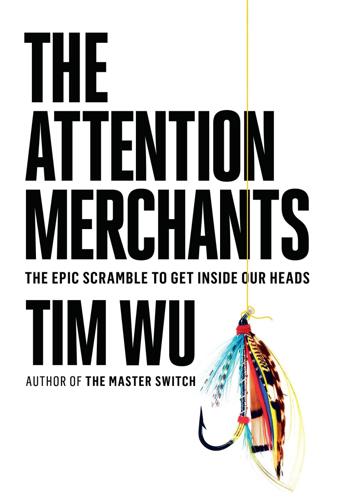
The Attention Merchants: The Epic Scramble to Get Inside Our Heads
by
Tim Wu
Published 14 May 2016
.*7 The walled garden made AOL money, some of it real, but also hastened the site’s loss of allure to the Internet, whose open design was the opposite of AOL’s, and which was by now growing a greater variety of things to see and do. By 2000, many people were just using AOL to connect to the web, finding ways to escape the walled garden and avoid AOL’s advertising blight altogether. These were only some of AOL’s many hidden weaknesses that contributed to its catastrophic implosion over the early 2000s. It was already, in Steven Levy’s memorable description, a “dead man walking”22 in advance of a meltdown fully chronicled elsewhere. Suffice it to say here: despite a $164 billion merger with Time Warner and its rich troves of content, AOL, as originally conceived, would become irrelevant, ultimately brought down by the rise of the popular, open Internet and its fast-multiplying attractions.
…
Of course, there was, as there always is, a quid pro quo: in its ripest state, the buying public was exposed to sales pitches; which might prove useful but then again might not. Google also began to collect a lot of information about a lot of people. Nevertheless, Page, who had the most qualms about advertising, told Wired’s Steven Levy that he’d begun to feel that AdWords was a good and just innovation. “From that point on,” writes Levy, “Brin and Page saw nothing but glory in the bottom line.”18 Page may have felt he’d outwitted the Devil, but so do all Faustian characters. While the safeguards in AdWords would keep Google’s core product uncompromised for the time being, corporate life is long, and shareholder demand for growth unremitting.
…
Rob Tannenbaum and Craig Marks, I Want My MTV: The Uncensored Story of the Music Video Revolution (New York: Penguin, 2011), 140. 17. Klein, Stealing Time, 247. 18. Swisher, Aol.com, 280. 19. William Forbes, Behavioural Finance (West Sussex, UK: Wiley, 2009), 158. 20. Klein, Stealing Time, at 167. 21. Complaint, SEC v. Kelly, 817 F.Supp.2d 340 (S.D.N.Y. 2011) (08 Civ. 04612), 2008 WL 2149270, at *2. 22. Steven Levy, “Dead Man Walking?,” Newsweek, January 21, 1996, http://www.newsweek.com/dead-men-walking-176866. CHAPTER 17: ESTABLISHMENT OF THE CELEBRITY-INDUSTRIAL COMPLEX 1. Edwin Diamond, “Why the Power Vacuum at Time Inc. Continues,” New York, October 23, 1972. 2. Alan Brinkley, The Publisher (New York: Alfred A.
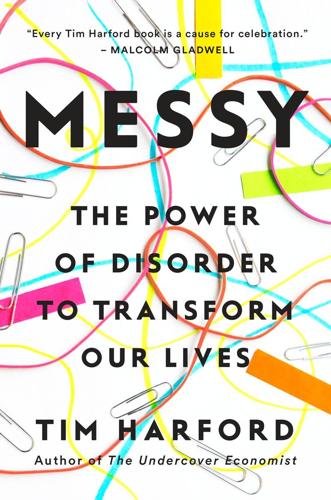
Messy: The Power of Disorder to Transform Our Lives
by
Tim Harford
Published 3 Oct 2016
Larry and Sergey left red and blue inflatable gym balls around, less as an aesthetic statement and more because they liked to work out with them.25 Google soon moved again, to an office-park facility in Mountain View. This office space later became known as the NullPlex, the space before the Googleplex itself. But again, the space was crude—a “mishmash,” said the facilities manager, George Salah. A “mongrel style,” said Steven Levy, journalist and unofficial historian of Google. One of the first high-priority projects to be tackled in the new space was the problem of how to make searches more responsive to the latest news. Google set up a war room, and again, it was a straightforward, unassuming space. Half a dozen engineers grabbed a conference room, set up their computers the way they wanted, and got to work.
…
Neither did he complain when the engineer later changed his mind and decided he’d like to put the wall back again; instead, he mused that the process had “made it a more Googley environment.” Any veteran of MIT’s Building 20 would recognize the thought process. And when the suit-and-tie executive Eric Schmidt joined Google as the new boss in 2001, he reassured Salah, “Don’t change a thing. Make sure it looks like a dorm room.”26 “No matter what happened,” writes Steven Levy, “engineers would have the run of the place.”27 • • • The offices at Chiat/Day may have looked superficially different from the offices at Kyocera, but they were managed with fundamentally the same tidy-minded aesthetic: This place should look the way the boss wants it to look. Google’s offices, like Building 20 at MIT, have been managed very differently: It doesn’t matter how this place looks.
…
Hilts, “Last Rites for a ‘Plywood Palace’ That Was a Rock of Science,” The New York Times, March 31, 1998, http://www.nytimes.com/1998/03/31/science/last-rites-for-a-plywood-palace-that-was-a-rock-of-science.html?pagewanted=all&src=pm; Eve Downing, “Letting Go,” Spectrum (Spring 1998), http://spectrum.mit.edu/articles/letting-go/; and Steven Levy, Hackers: Heroes of the Computer Revolution, 25th Anniversary Edition (Sebastopol, CA: O’Reilly Media, 2010). 19. A lovely half-hour documentary, “Building 20: The Magical Incubator” was made by MIT in 1998. It’s tape T1217 in the MIT archives, online at: http://teachingexcellence.mit.edu/from-the-vault/mits-building-20-the-magical-incubator-1998; a definitive account of the merits of Building 20 is in chapter three of Stewart Brand, How Buildings Learn: What Happens After They’re Built (New York: Viking, 1994). 20.
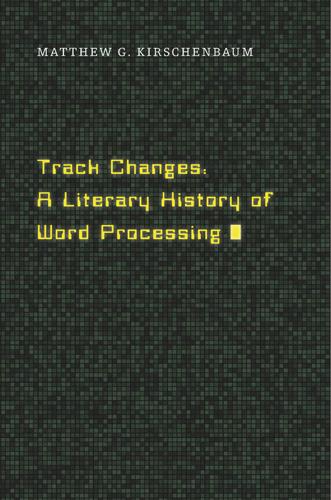
Track Changes
by
Matthew G. Kirschenbaum
Published 1 May 2016
A wrong choice on the part of a first-time buyer—who might arrive at the local computer store primed with good or bad advice from friends and the latest industry gossip gleaned from computer magazines, only to first be subjected to a hard sell from the sales staff—could mean thousands of dollars wasted or worse. Steven Levy, a technology journalist, summed up the nature of the decision: “I compare using a word processor to living with somebody. You go into it with all kinds of enthusiasms, and things are wonderful. Then, you see other word processors promising more. More features, friendlier style. The question is, is it worth tossing over a relationship in which you’ve invested months for a word-transpose toggle, an indexing function you’ll use maybe twice, and a split-screen capability?
…
VisiCalc, the spreadsheet program which debuted in 1979 for the Apple II, quickly sold several hundred thousand copies; indeed, its availability helped drive sales of the Apple computer itself.4 Its conception was influenced by the kind of early computer-generated imagery then on the big screen in films like Star Wars, particularly the “heads-up” combat displays: “Like Luke Skywalker jumping into the turret of the Millennium Falcon, [Dan] Bricklin saw himself blasting out financials, locking onto profit and loss numbers that would appear suspended in space before him,” wrote one commentator, tongue not entirely in cheek. “It was to be a business tool cum video game, a Saturday Night Special for M.B.A.s.”5 Journalist Steven Levy described the competitive culture that would arise around VisiCalc hacks and tricks, the quest for the “perfect” spreadsheet: “Spreadsheet hackers lose themselves in the world of what-if,” he wrote.6 Spreadsheets indeed lent themselves to speculation and scenario-spinning, to a future-oriented fugue state induced by the rows and columns scrolling past, figures rippling across the screen as fingertips adjusted a variable in a hidden formula.
…
For Bukowski and his Macintosh, see Jed Birmingham, “Charles Bukowski, William Burroughs, and the Computer,” RealityStudio, September 11, 2009, http://realitystudio.org/bibliographic-bunker/charles-bukowski-william-burroughs-and-the-computer/. 7. Charles Bukowski, “16-Bit Intel 8088 Chip,” Aileron 6, no. 1 (1985). 8. Steven Levy, quoted in Whole Earth Software Catalog, 46. 9. Judy Grahn, email to the author, January 2, 2012. 10. See Alexis C. Madrigal, “The Time Exxon Went Into the Semiconductor Business (and Failed),” Atlantic, May 17, 2013, http://www.theatlantic.com/technology/archive/2013/05/the-time-exxon-went-into-the-semiconductor-business-and-failed/275993/. 11.

Palo Alto: A History of California, Capitalism, and the World
by
Malcolm Harris
Published 14 Feb 2023
“By the end of the 1960s,” writes economist Harry Braverman in his study of postwar shifts in the composition of the labor force, “rising rates of unemployment among ‘professionals’ of various kinds once more brought home to them that they were not the free agents they thought they were, who deigned to ‘associate themselves’ with one or another corporation, but truly part of a labor market, hired and fired like those beneath them.”2 The newest inventions and advances were for unused missiles. Making missiles and database systems was, if not morally repugnant, at least boring and pointless. Journalist Steven Levy writes that computers were “loathed by millions of common, patriotic citizens” who saw them as a “dehumanizing factor in society.”i3 The dull technophile engineer with a new stereo became a stereotype, and the Japanese commodity-electronics industry threatened from across the Pacific. Information technology was meant for more, and a line of theorist-administrators saw it coming together, starting with Vannevar Bush.
…
MIT’s famous anti-authoritarian hackers constantly thwarted administrative attempts to lock down their AI lab, proving repeatedly that there was no lock for sale that they couldn’t crack. But when Massachusetts militants planned to demonstrate at their beloved lab, the programmers didn’t object to the steel plates and Plexiglas. “Though previously some of the hackers had declared, ‘I will not work in a place that has locks,’” writes Steven Levy in his account of the lab in Hackers: Heroes of the Computer Revolution, “after the demonstrations were over, and after the restricted lists were long gone, the locks remained.”103 It was the end of an era. Locking down was easier for corporations than it was for public and pseudo-public institutions such as universities.
…
Baran and Paul Marlor Sweezy, Monopoly Capital: An Essay on the American Economic and Social Order (New York: Monthly Review Press, 1966), 332. 63. Baran, The Political Economy of Growth, 26. 64. Johnson, The Broken Heart of America, 370–71. 65. Lester D. Earnest, “The Internet’s Grandfather, an Inventive Fraudster with Many Descendants” (Stanford University, January 25, 2014), https://web.stanford.edu/~learnest/nets/sage.htm. 66. Steven Levy, Hackers: Heroes of the Computer Revolution (Sebastopol, CA: O’Reilly Media, 2010), 132. 67. Joel N. Shurkin, Terman’s Kids: The Groundbreaking Study of How the Gifted Grow Up (Boston: Little, Brown, 1992), 206. 68. Henry L. Minton, Lewis M. Terman: Pioneer in Psychological Testing (New York: NYU Press, 1988), 241 Chapter 3.2 The Solid State 1.

100 Plus: How the Coming Age of Longevity Will Change Everything, From Careers and Relationships to Family And
by
Sonia Arrison
Published 22 Aug 2011
See “President Clinton Announces the Completion of the First Survey of the Entire Human Genome, Hails Public and Private Efforts Leading to This Historic Achievement,” Human Genome Project Information, June 25, 2000, www.ornl.gov/sci/techresources/Human_Genome/project/clinton1.shtml; and www.ornl.gov/sci/techresources/Human_Genome/project/clinton2.shtml. 56 Ibid. 57 Steven Levy, “Geek Power: Steven Levy Revisits Tech Titans, Hackers, Idealists,” Wired, April 19, 2010, www.wired.com/magazine/2010/04/ff_hackers/all/1. 58 Jeff Bezos, “We Are What We Choose,” Princeton University address to the Class of 2010 Baccalaureate, May 30, 2010, www.youtube.com/watch?v=vBmavNoChZc. 59 Nicholas Wade, “Researchers Say They Created a Synthetic Cell,” New York Times, May 20, 2010, www.nytimes.com/2010/05/21/science/21cell.html. 60 J.
…
Bioinformatics are moving at the speed of Moore’s Law and sometimes faster. To the extent that wealthy technology moguls influence public opinion and hackers seem cool, the context for the longevity meme is sizzling hot. In a Wired magazine interview in April 2010, Bill Gates, America’s richest man, told reporter Steven Levy that if he were a teenager today, “he’d be hacking biology.”57 Gates elaborated, saying, “Creating artificial life with DNA synthesis, that’s sort of the equivalent of machine-language programming.” Whether or not his comments were meant as an endorsement of the field, the smart whiz kids who read Wired probably see it that way.

Snowden's Box: Trust in the Age of Surveillance
by
Jessica Bruder
and
Dale Maharidge
Published 29 Mar 2020
Privacy advocates, politicians, technologists, and civil libertarians were alarmed by the Orwellian plan. Together, they formed a motley opposition with members ranging from the ACLU to Rush Limbaugh. “The precise object of their rage is the Clipper chip, officially known as the MYK-78 and not much bigger than a tooth,” wrote journalist Steven Levy. “Just another tiny square of plastic covering a silicon thicket. A computer chip, from the outside indistinguishable from thousands of others. It seems improbable that this black Chiclet is the focal point of a battle that may determine the degree to which our civil liberties survive in the next century.
…
p. 5 “peak indifference”: Cory Doctorow, “We Cannot Afford to Be Indifferent to Internet Spying,” Guardian, December 9, 2013. pp. 5–6 Clipper chip: Andi Wilson Thompson, Danielle Kehl, and Kevin Bankston, “Doomed to Repeat History? Lessons from the Crypto Wars of the 1990s,” New America, June 17, 2015, https://newamerica.org/; Steven Levy, “The Battle of the Clipper Chip,” New York Times Magazine, June 12, 1994; Philip Elmer-Dewitt, “Who Should Keep the Keys?” Time, March 14, 1994; Stewart A. Baker, “Don’t Worry Be Happy: Why Clipper Is Good for You,” Wired, May 1994. For a more appropriate soundtrack to government intrusion, try “Be Worry, Don’t Happy,” Oleg Berg’s minor-key transposition of the Bobby McFerrin classic: youtube.com/watch?
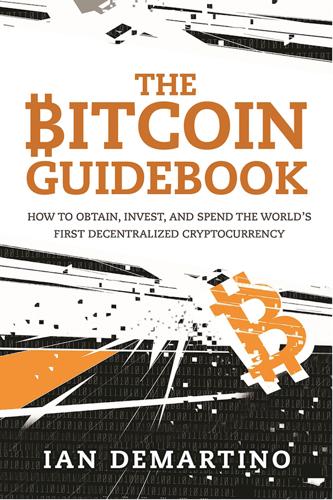
The Bitcoin Guidebook: How to Obtain, Invest, and Spend the World's First Decentralized Cryptocurrency
by
Ian Demartino
Published 2 Feb 2016
In her 1994 article in the Journal of Criminal Justice Education, Dorothy Denning, then a chair of computer science at Georgetown University, wrote about one of these dangers: “[Cryptography] can be used to implement untraceable cash and anonymous, untraceable transactions. While such services can offer many privacy benefits, they also could facilitate money laundering and fraud.”5 Denning wasn’t the only one to express such misgivings. In a December 1994 Wired article, Steven Levy quotes a member of the American Bankers Association, Kawika Daguio, who writes: Speaking for myself, it would be dangerous and unsound public policy to allow fully untraceable, unlimited value digital currency to be produced…. It opens up opportunities for abuse that aren’t available to criminals now.
…
There is also the concern of becoming a target. If people can publicly see that you have just come into a large amount of money, this presents its own set of problems. Beyond that, privacy is just a human-rights issue. In an article about Digicash, the pre-Bitcoin attempt at a digital currency I talked about in an earlier chapter, Wired’s Steven Levy quotes the cryptographer and then-Digicash employee Niels Ferguson: Oh, the number of times I’ve had to argue with people that they need privacy! They’ll say, “I don’t care if you know where I spend my money.” I usually tell them, “What if I hire a private investigator to follow you around all day?
…
As it turns out, a lot, because the encryption techniques that are essential to Bitcoin have been the focus of a public debate since at least the early 1990s, and that debate ended up placing everything related to the topic of encryption under the umbrella of criminal activity. The association between Bitcoin and criminal elements was born directly from that. Back in 1995, author Steven Levy visited the offices of the now-defunct Cygnus Solutions, an early Internet cryptography company, and spoke about what the early Cypherpunks of the day were trying to accomplish: The people in this room hope for a world where an individual’s informational footprints—everything from an opinion on abortion to the medical record of an actual abortion—can be traced only if the individual involved chooses to reveal them; a world where coherent messages shoot around the globe by network and microwave, but intruders and feds trying to pluck them out of the vapor find only gibberish; a world where the tools of prying are transformed into the instruments of privacy.
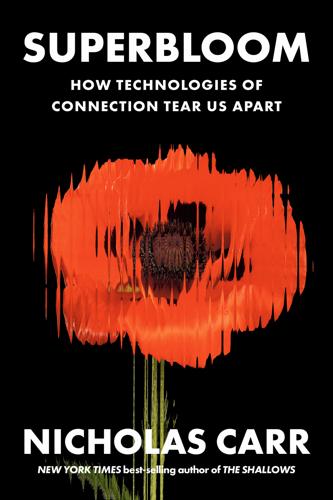
Superbloom: How Technologies of Connection Tear Us Apart
by
Nicholas Carr
Published 28 Jan 2025
He expressed regret for sparking the fury but at the same time defended the feed: “We agree, stalking isn’t cool; but being able to know what’s going on in your friends’ lives is.”14 What Zuckerberg didn’t mention is that the company’s traffic measures were already showing that the feed was a huge success. It was doing exactly what it was designed to do. The journalist Steven Levy later reported on the scene playing out inside Facebook’s headquarters while the users were fuming: Sanghvi and her team were looking at the logs and finding something amazing. Even as hundreds of thousands of users expressed their disapproval of News Feed, their behavior indicated that they felt otherwise.
…
John, “When Information Becomes T.M.I.,” New York Times, September 10, 2006. 13.Christopher M. Hoadley et al., “Privacy as Information Access and Illusory Control: The Case of the Facebook News Feed Privacy Outcry,” Electronic Commerce Research and Applications 9 (2010): 50–60. 14.Quoted in Tom Loftus, “Mark Zuckerberg’s Best Quotes,” Wall Street Journal, February 1, 2012. 15.Steven Levy, Facebook: The Inside Story (New York: Penguin Random House, 2020), 142–143. 16.Joshua Melvin, “Protestors Contest Facebook Breast Policy,” Mercury News, December 27, 2008; and Urmee Khan, “Breastfeeding Photo Ban by Facebook Sparks Global Protest by Mothers,” Telegraph, December 30, 2007. 17.Kate Klonick, “The New Governors: The People, Rules, and Processes Governing Online Speech,” Harvard Law Review 131, no. 6 (2018): 1598–1670. 18.Ibid. 19.Adam Satariano and Mike Isaac, “Profit and Pain in Doing Facebook’s Dirty Work,” New York Times, September 1, 2021.
…
Eliot was a classmate of Lippmann’s at Harvard. Chapter 7: The Dislocated I 1.Andrew Perrin and Sara Atske, “About Three-in-Ten U.S. Adults Say They Are ‘Almost Constantly’ Online,” Pew Research, March 26, 2021; and Emily A. Vogels et al., “Teens, Social Media and Technology 2022,” Pew Research, August 10, 2022. 2.Steven Levy, Facebook: The Inside Story (New York: Blue Rider, 2020), 181. 3.Patricia Lockwood, No One Is Talking about This (New York: Riverhead Books, 2021), 3. 4.For a review of relevant research, see Nicholas Carr, “How Smartphones Hijack Our Minds,” Wall Street Journal, October 7, 2017. 5.Charles Horton Cooley, Human Nature and the Social Order (1902; repr.
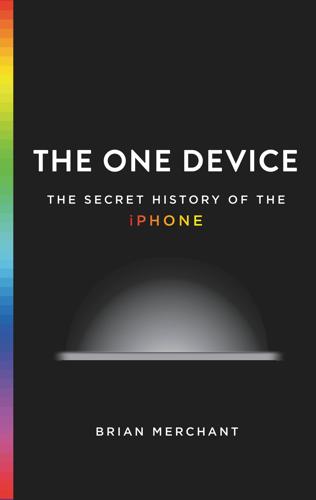
The One Device: The Secret History of the iPhone
by
Brian Merchant
Published 19 Jun 2017
They helped prove that user interface design, long derided as dull—the province of grey user settings and drop-down menus; “knobs and dials” as Christie puts it—was ripe for innovation. As Bas and Imran’s stars rose inside Apple, they started casting around for new frontiers. Fortunately, they were about to find one. While training to be a civil engineer in Massachusetts, Brian Huppi idly picked up Steven Levy’s Insanely Great. The book documents how in the early 1980s Steve Jobs separated key Apple players from the rest of the company, flew a pirate flag above their department, and drove them to build the pioneering Macintosh. Huppi couldn’t put it down. “I was like, ‘Wow, what would it be like to work at a place like Apple?’”
…
When you ask Siri a question, here’s what happens: Your voice is digitized and transmitted to an Apple server in the Cloud while a local voice recognizer scans it right on your iPhone. Speech-recognition software translates your speech into text. Natural-language processing parses it. Siri consults what tech writer Steven Levy calls the iBrain—around 200 megabytes of data about your preferences, the way you speak, and other details. If your question can be answered by the phone itself (“Would you set my alarm for eight a.m.?”), the Cloud request is canceled. If Siri needs to pull data from the web (“Is it going to rain tomorrow?”)
…
In 1968, an idealistic computer scientist named Doug Engelbart brought together hundreds of interested industry onlookers at the San Francisco Civic Center—the same civic center where the iPhone 7 demo was made nearly forty years later—and introduced a handful of technologies that would form the foundational DNA of modern personal computing. Not only did Engelbart show off publicly a number of inventions like the mouse, keypads, keyboards, word processors, hypertext, videoconferencing, and windows, he showed them off by using them in real time. The tech journalist Steven Levy would call it “the mother of all demos,” and the name stuck. A video feed shared the programs and technologies being demoed onscreen. It was a far cry from the more polished product launches Jobs would become famous for decades later; Engelbart broadcast his own head in the frame as, over the course of an hour and a half, he displayed new feats of computing and made delightfully odd quips and self-interruptions.
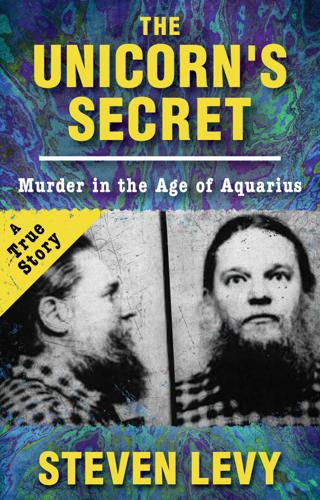
The Unicorn's Secret
by
Steven Levy
Published 6 Oct 2016
I would also like to acknowledge the support of my family and friends, in particular Bruce Buschel, John Brockman, Helen and Lester Levy, Diane Levy, William Mooney, David Rosenthal, Randall Rothenberg, David Weinberg, Tim Whitaker, and Deborah Wise. Finally, I was lucky in having the companionship of Teresa Carpenter, who had been down this path before; besides her constant love and patience, I was able to get free advice at odd hours. STEVEN LEVY New York City, 1988 ABOUT THE AUTHOR Steven Levy is editor in chief of the online tech publication Backchannel. Former senior staff writer for WIRED and former chief technology correspondent for Newsweek, he is the author of seven books, including Hackers, Insanely Great, Artificial Life, The Perfect Thing, and Crypto.
…
The Unicorn’s Secret Murder in the Age of Aquarius Steven Levy CONTENTS PROLOGUE: Of Excellent Reputation 1 A CONDITION OF MYSTERY 2 THE MAKING OF THE GURU 3 DOODLEBUG 4 THE MAYOR OF POWELTON 5 FALLEN ANGEL 6 TURNING THE CORNER 7 WHERE FEAR COMES FROM 8 A PRISONER ON THE PLANET OF PATIENCE 9 PRIVATE INVESTIGATORS 10 “I DIDN’T KILL HER” 11 THE DARK SIDE 12 THE UNICORN’S SECRET 13 THE FLIGHT OF THE UNICORN EPILOGUE A NOTE ON SOURCES IMAGE GALLERY ACKNOWLEDGMENTS ABOUT THE AUTHOR Prologue: Of Excellent Reputation First to take the stand was a corporate attorney. Like the others, he seemed steeped in an air of unreality.
…
His most recent book is the New York Times bestseller In the Plex: How Google Thinks, Works, and Shapes Our Lives. All rights reserved, including without limitation the right to reproduce this ebook or any portion thereof in any form or by any means, whether electronic or mechanical, now known or hereinafter invented, without the express written permission of the publisher. Copyright © 1988 by Steven Levy Cover design by Olivia Brodtman ISBN: 978-1-5040-4213-0 This edition published in 2016 by Open Road Integrated Media, Inc. 180 Maiden Lane New York, NY 10038 www.openroadmedia.com Find a full list of our authors and titles at www.openroadmedia.com FOLLOW US @OpenRoadMedia

The Age of Surveillance Capitalism
by
Shoshana Zuboff
Published 15 Jan 2019
Reed Albergotti et al., “Employee Lawsuit Accuses Google of ‘Spying Program,’” Information, December 20, 2016, https://www.theinformation.com/employee-lawsuit-accuses-google-of-spying-program. 6. See Steven Levy, In the Plex: How Google Thinks, Works, and Shapes Our Lives (New York: Simon & Schuster, 2011), 116; Hal R. Varian, “Biography of Hal R. Varian,” UC Berkeley School of Information Management & Systems, October 3, 2017, http://people.ischool.berkeley.edu/~hal/people/hal/biography.html; “Economics According to Google,” Wall Street Journal, July 19, 2007, http://blogs.wsj.com/economics/2007/07/19/economics-according-to-google; Steven Levy, “Secret of Googlenomics: Data-Fueled Recipe Brews Profitability,” Wired, May 22, 2009, http://archive.wired.com/culture/culturereviews/magazine/17-06/nep_googlenomics; Hal R.
…
Why did Google’s Gmail, launched in 2004, scan private correspondence to generate advertising? As soon as the first Gmail user saw the first ad targeted to the content of her private correspondence, public reaction was swift. Many were repelled and outraged; others were confused. As Google chronicler Steven Levy put it, “By serving ads related to content, Google seemed almost to be reveling in the fact that users’ privacy was at the mercy of the policies and trustworthiness of the company that owned the servers. And since those ads made profits, Google was making it clear that it would exploit the situation.”64 In 2007 Facebook launched Beacon, touting it as “a new way to socially distribute information.”
…
Pressure for profit mounted sharply, despite the fact that Google Search was widely considered the best of all the search engines, traffic to its website was surging, and a thousand résumés flooded the firm’s Mountain View office each day. Page and Brin were seen to be moving too slowly, and their top venture capitalists, John Doerr from Kleiner Perkins and Michael Moritz from Sequoia, were frustrated.25 According to Google chronicler Steven Levy, “The VCs were screaming bloody murder. Tech’s salad days were over, and it wasn’t certain that Google would avoid becoming another crushed radish.”26 The specific character of Silicon Valley’s venture funding, especially during the years leading up to dangerous levels of startup inflation, also contributed to a growing sense of emergency at Google.
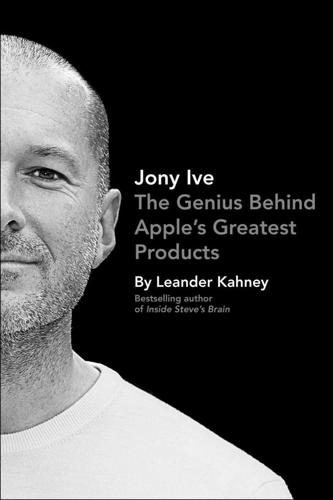
Jony Ive: The Genius Behind Apple's Greatest Products
by
Leander Kahney
Published 14 Nov 2013
“Apple Takes a Bold New Byte at iMac,” New Zealand Herald, http://www.nzherald.co.nz/technology/news/article.cfm?c_id=5&objectid=787149, January 21, 2002. 10. Email from Ken Segall, April 2013. 11. Interview with Dennis Boyle, October 2012. 12. Steven Levy, “The New iPod” Newsweek, http://www.thedailybeast.com/newsweek/2004/07/25/the-new-ipod.html, July 25, 2004. 13. Steven Levy, The Perfect Thing: How the iPod Shuffles Commerce, Culture, and Coolness (Simon & Schuster, 2006) 102. 14. Jonathan Ive in conversation with Dylan Jones, editor of British GQ, following his award of honorary doctor at the University of the Arts London, © Nick Carson 2006.
…
Interview with Jon Rubinstein, October 2012. 6. Interview with Doug Satzger, January 2013. 7. Christopher Stringer testimony, Apple v. Samsung trial, San Jose Federal Courthouse, July 2012. 8. Ibid. 9. Ibid. 10. Interview with Gautam Baksi, June 2013. CHAPTER 8 Design of the iPod 1. Steven Levy, The Perfect Thing: How the iPod Shuffles Commerce, Culture, and Coolness (Simon & Schuster, 2006), 36. 2. Ibid., 38. 3. Ibid., 133. 4. Sheryl Garratt, “Jonathan Ive: Inventor of the decade,” The Guartdian, http://www.guardian.co.uk/music/2009/nov/29/ipod-jonathan-ive-designer, November 28, 2009. 5.

The Connected Company
by
Dave Gray
and
Thomas Vander Wal
Published 2 Dec 2014
Platforms are the company’s long-term memory, where knowledge and experience is stored and hard-coded into habits, routines, and autonomic functions. Notes for Chapter Sixteen HOTEL CHECK-INS “Designing Service Systems by Bridging the ‘Front stage’ and ‘Back stage,’ by Robert J. Glushko and Lindsay Tabas, Information Systems and E-Business Management, 7, no. 4 (September 2009): 407–427. CUSTOMER SERVICE AT AMAZON VS ZAPPOS Steven Levy, “Jeff Bezos Owns the Web in More Ways Than You Think,” Wired, November 13, 2011. AMAZON AUCTIONS, ZSHOPS, AND MARKETPLACE Consumer Reports Talks with Amazon.com, recorded live on May 11, 2011, http://www.ustream.tv/recorded/14630179. Chapter 17. Power and control in networks An organization’s data is found in its computer systems, but a company’s intelligence is found in its biological and social systems
…
But such areas create conditions that are conducive to connection. Those very casual, simple conversations, when repeated over a long period of time, give people a greater awareness of the information patterns in the company as a whole. Google’s Director of Facilities, George Salah, intentionally increased density to increase the energy in the company. Steven Levy tells the story in his book In the Plex: How Google Thinks, Works, and Shapes Our Lives (Simon & Schuster): Salah was surprised that when Silicon Graphics occupied the building, all the cubicles had relatively high walls. And the desks were all oriented inward, with almost no one facing out. So as you walk through the building, you couldn’t find a soul,” he says.
…
The Great Reset: How New Ways of Living and Working Drive Post-Crash Prosperity By Richard Florida, Harper, 2010. How Buildings Learn: What Happens After They’re Built By Stewart Brand, Viking Adult, 1994. Human Sigma: Managing the Employee-Customer Encounter By John Fleming and Jim Asplund, Gallup Press, 2007. In the Plex: How Google Thinks, Works, and Shapes Our Lives By Steven Levy, Simon and Schuster, 2011. Information Rules: A Strategic Guide to the Network Economy By Carl Shapiro and Hal R. Varian, Harvard Business Review Press, 1998. The Innovator’s Dilemma: When New Technologies Cause Great Firms to Fail By Clayton Christensen, Harvard Business Review Press, 1997.

Life After Google: The Fall of Big Data and the Rise of the Blockchain Economy
by
George Gilder
Published 16 Jul 2018
In general, it could be argued from the consumer point of view that the better the search engine is, the fewer advertisements will be needed for the consumer to find what they want. This of course erodes the advertising supported business model of the existing search engines. . . . [W]e believe the issue of advertising causes enough mixed incentives that it is crucial to have a competitive search engine that is transparent and in the academic realm. Steven Levy’s definitive book on Google describes the situation as Google developed its ad strategy in 1999: “At the time the dominant forms of advertising on the web were intrusive, annoying and sometimes insulting. Most common was the banner ad, a distracting color rectangle that would often flash like a burlesque marquee.
…
Larry Page, hey, virtually all his quotes are accessible on Google! 4. David Gelernter, Mirror Worlds (New York: Oxford University Press, 1992). 5. Page, ibid. 6. If you prefer the text version beyond all the Google search resources on the saga of its inventors and founders, it is lavishly there in Steven Levy’s In the Plex: How Google Thinks, Works, and Shapes our Lives (New York: Simon & Schuster, 2011), or in the silken New Yorker prose of media-savvy Ken Auletta, Googled: The End of the World as We Know It (New York: Penguin Books, 2010). The Olympian view from on high is expounded by Eric Schmidt and Jonathan Rosenberg, with a foreword by Larry Page, How Google Works (New York: Hachette, 2014). 7.
…
Peter Thiel, with Blake Masters, Zero to One: Notes on Startups, or How to Build the Future (New York: Crown Business, 2014), 75. 2. Alexander Mordvintsev, Christopher Olah, and Mike Tyka, “Inceptionism: Going Deeper into Neural Networks,” Google Research Blog, June 17, 2015, https://research.googleblog.com/2015/06/inceptionism-going-deeper-into-neural.html. 3. Steven Levy, “Inside Deep Dreams: How Google Made Its Computers Go Crazy,” Wired, December 11, 2015, https://www.wired.com/2015/12/inside-deep-dreams-how-google-made-its-computers-go-crazy/. 4. “Here’s How To Make Your Own Dreamscope A.I. Images” by “burnersxxx,” July 16, 2015, https://burners.me/tag/dreamscope/.
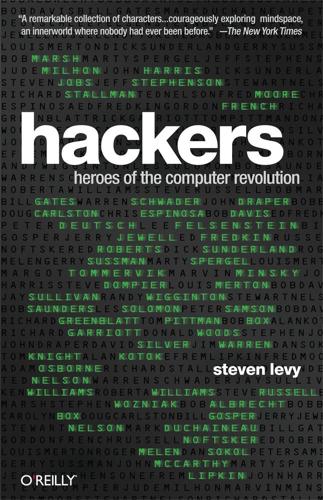
Hackers: Heroes of the Computer Revolution - 25th Anniversary Edition
by
Steven Levy
Published 18 May 2010
Hackers Steven Levy Editor Mike Hendrickson Copyright © 2010 Steven Levy O’Reilly books may be purchased for educational, business, or sales promotional use. Online editions are also available for most titles (http://my.safaribooksonline.com). For more information, contact our corporate/institutional sales department: (800) 998-9938 or corporate@oreilly.com. The O’Reilly logo is a registered trademark of O’Reilly Media, Inc. Hackers and related trade dress are trademarks of O’Reilly Media, Inc. Many of the designations used by manufacturers and sellers to distinguish their products are claimed as trademarks.
…
In 1991, his efforts came to the attention of those in charge of parceling out the coveted McArthur Fellowship “genius grants.” The last time I saw him, Stallman was organizing a demonstration against the Lotus Development Corporation. His protest regarded their software patents. He believed, and still does, that information should be free. —Steven Levy August 1993 Appendix C. Afterword: 2010 “It’s funny,” says Bill Gates. “When I was young, I didn’t know any old people. When we did the microprocessor revolution, there was nobody old, nobody. They didn’t make us meet with journalists who were old people. I didn’t deal with people in their 30s.
…
Those are all pretty deep problems that need the same type of crazy fanaticism of youthful genius and naiveté that drove the PC industry, and can have the same impact on the human condition.” In other words, Gates expects hackers to be the heroes of the next revolution, too. Sounds good to me. —Steven Levy May 2010 Appendix D. Notes The main source of information for Hackers was over a hundred personal interviews conducted in 1982 and 1983. Besides these, I refer to a number of written sources. Part One Chapter 1 Some of the TMRC jargon was codified by Peter Samson in the unpublished "An Abridged Dictionary of the TMRC Language," circa 1959.

We Are Data: Algorithms and the Making of Our Digital Selves
by
John Cheney-Lippold
Published 1 May 2017
Citing computer scientist Jonathan Grudin, in digital technology, we encounter a “steady erosion of clearly situated action. We are losing control and knowledge of the consequences of our actions. . . . We no longer control access to anything we disclose.”78 Gibberish and Obfuscation A prophetic anecdote begins Wired’s first-ever story on Internet privacy. It was early in 1993, and technology journalist Steven Levy had just arrived at the office of a Silicon Valley start-up. He was on assignment to observe a “cypherpunk” meeting, a group whose members used mathematically complex cryptography, or secret coding, to make their digital data turn to gibberish. His description of the meeting was a “time warp to the days when hackers ran free”: fifteen “techie-cum-civil libertarians” randomly lay on the floor or wandered around cubicles, only to eventually collect themselves, hours after the scheduled time, in order to share their crypto secrets.
…
Christian Fuchs, Social Media: A Critical Introduction (Thousand Oaks, CA: Sage, 2013). 55. Wu, “United States of Secrets.” 56. Kevin Haggerty and Richard Ericson, “The Surveillant Assemblage,” British Journal of Sociology 51, no. 4 (2000): 605–622. 57. “DoubleClick.net Usage Statistics,” BuiltWith.com, July 28, 2016, http://trends.builtwith.com; Steven Levy, “How Google Search Dealt with Mobile,” Backchannel, January 15, 2015, https://backchannel.com; Frederic Lardinois, “Gmail Now Has 425 Million Users,” TechCrunch, June 28, 2012, http://techcrunch.com. 58. Microsoft, “Microsoft Statement on Proposed Acquisition of DoubleClick by Google,” April 15, 2007, http://news.microsoft.com. 59.
…
,” Journal of Social Issues 33, no. 3 (1977): 66–84; Leysia Palen and Paul Dourish, “Unpacking ‘Privacy’ for a Networked World,” Proceedings of the SIGCHI Conference on Human Factors in Computing Systems, 2003, 129. 76. Palen and Dourish, “Unpacking ‘Privacy,’” 132. 77. Ibid., 131 78. Jonathan Grudin, “Desituating Action: Digital Representation of Context,” Microsoft Research, 1991, http://research.microsoft.com. 79. Steven Levy, “Crypto Rebels,” Wired, May–June 1993, http://archive.wired.com. 80. Google, “Google’s Mission Is to Organize the World’s Information and Make It Universally Accessible and Useful,” 2015, www.google.com. 81. Brunton and Nissenbaum, “Vernacular Resistance.” 82. Daniel Howe, Helen Nissenbaum, and Vincent Toubiana, “TrackMeNot,” 2015, https://cs.nyu.edu. 83.

How Big Things Get Done: The Surprising Factors Behind Every Successful Project, From Home Renovations to Space Exploration
by
Bent Flyvbjerg
and
Dan Gardner
Published 16 Feb 2023
“It can produce a graceful and iconic tower.”16 Even further removed from cheap and ugly is Apple’s dazzling, ethereal headquarters in Cupertino, California, designed by Norman Foster, Steve Jobs, and Jony Ive, where modularity played a major role, too. As conceived by Jobs, “This would be a workplace where people were open to each other and open to nature, and the key to that would be modular sections, known as pods, for work or collaboration,” the journalist Steven Levy summarized. “Jobs’ idea was to repeat those pods over and over: pod for office work, pod for teamwork, pod for socializing, like a piano roll playing a Philip Glass composition.”17 That extended to how the building was put together. “We viewed the construction process as a manufacturing project and wanted to do as much outside of here as possible,” Apple’s CEO Tim Cook told Wired magazine.
…
Gleick et al., “California Water 2020: A Sustainable Vision,” Pacific Institute, May 1995, http://s3-us-west-2.amazonaws.com/ucldc-nuxeo-ref-media/dd359729-560b-4899-aaa2-1944b7a42e5b. 9. Steve Jobs’s full comments, which were prompted by a tough question from the audience, can be seen in the following video: 258t, “Steve Jobs Customer Experience,” YouTube, October 16, 2015, https://www.youtube.com/watch?v=r2O5qKZlI50. 10. Steven Levy, “20 Years Ago, Steve Jobs Built the ‘Coolest Computer Ever.’ It Bombed,” Wired, July 24, 2020, https://www.wired.com/story/20-years-ago-steve-jobs-built-the-coolest-computer-ever-it-bombed/. 11. Colin Bryar and Bill Carr, Working Backwards: Insights, Stories, and Secrets from Inside Amazon (New York: St.
…
See also #HGTV, “What It’s Like to Live in a Sears Catalog Home,” YouTube, May 13, 2018, https://www.youtube.com/watch?v=3kb24gwnZ18. 15. Author interview with Mike Green, June 5, 2020. 16. Dan Avery, “Warren Buffett to Offer a Fresh Approach on Modular Construction,” Architectural Digest, May 20, 2021; author interviews with Danny Forster, January 4 and 27, 2021. 17. Steven Levy, “One More Thing: Inside Apple’s Insanely Great (or Just Insane) New Mothership,” Wired, May 16, 2017, https://www.wired.com/2017/05/apple-park-new-silicon-valley-campus/. 18. Leif Lia et al., “The Current Status of Hydropower Development and Dam Construction in Norway,” Hydropower & Dams 22, no. 3 (2015); “Country Profile Norway,” International Hydropower Association, https://www.hydropower.org/country-profiles/norway. 19.
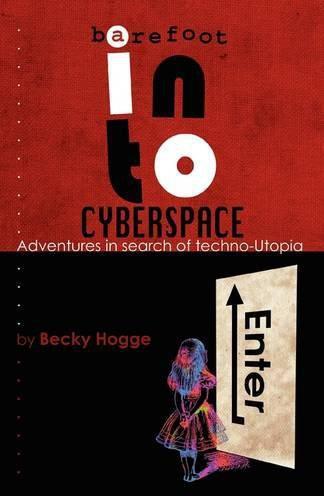
Barefoot Into Cyberspace: Adventures in Search of Techno-Utopia
by
Becky Hogge
,
Damien Morris
and
Christopher Scally
Published 26 Jul 2011
In December 1968, Engelbart demonstrated a number of his experimental ideas to a conference of computer scientists in the San Francisco Convention Center. The event was later dubbed “The Mother of all Demos”, thanks to the fact that it was the world’s first sighting of a number of computing technologies, including the mouse, email and hypertext. According to Steven Levy, author of Hackers: Heroes of the Computer Revolution, “Engelbarts support staff was as elaborate as one would find at a modern Grateful Dead concert” and that support staff included Stewart Brand, who volunteered a lot of time to set up the networked video links and cameras that made Engelbart’s demonstration go off with such a bang.
…
Brand had a sense that profound things were going on, “and I’ve sort of been drumming my fingers ever since because so many of the things that were foreseen at that point took a long time to arrive. So when I did the piece for Rolling Stone (the magazine’s publisher) Jann Wenner said at the time, ‘Well, you’ve just set in motion a whole new body of journalism that’s going to track down all this stuff.’ And in fact, it was ten years later that Steven Levy did the book Hackers, which sort of told the rest of the story.” Spurred on by Levy’s Hackers, in 1984, the same year of the inaugural Chaos Communication Congress in Germany, Brand convened the US’s first Hacker Con, in Marin County, California. “Organising the Hackers Conference was like some of the early hacking at MIT, so collaborative and rapid you couldnt keep track of who did what…” he wrote at the time, “But once they were on the scene, they were the worlds easiest group to work with.

The Tyranny of Metrics
by
Jerry Z. Muller
Published 23 Jan 2018
Not only that, but with an eye on their eventual exit to some better job with another organization, mobile managers are on the lookout for metrics of performance that can be deployed when the headhunter calls. THE LURE OF IT Yet another factor is the spread of information technology (IT). In the early 1980s the invention and rapid adoption of the electronic spreadsheet and the resulting ease of tabulating and manipulating figures had wide-ranging effects. As a prescient analyst of the phenomenon, Steven Levy, wrote in 1984, The spreadsheet is a tool, but it is also a worldview—reality by the numbers…. Because spreadsheets can do so many important things, those who use them tend to lose sight of the crucial fact that the imaginary businesses that they can create on their computers are just that—imaginary.
…
Yves Morieux and Peter Tollman, Six Simple Rules: How to Manage Complexity Without Getting Complicated (Boston, 2014), p. 6. 14. Rakesh Khurana, Searching for a Corporate Savior: The Irrational Quest for Charismatic CEOs (Princeton, 2002), esp. chap. 3. The phenomenon is by no means confined to the corporate sector. 15. Steven Levy, “A Spreadsheet Way of Knowledge,” Harper’s, November 1984, now online at https://medium.com/backchannel/a-spreadsheet-way-of-knowledge-8de60af7146e. 16. Seth Klarman, A Margin of Safety: Risk-Averse Value Investing for the Thoughtful Investor (New York, 1991). CHAPTER 5. PRINCIPALS, AGENTS, AND MOTIVATION 1.
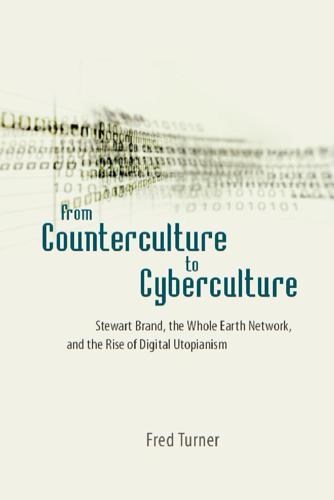
From Counterculture to Cyberculture: Stewart Brand, the Whole Earth Network, and the Rise of Digital Utopianism
by
Fred Turner
Published 31 Aug 2006
That year, a handful of selfdescribed computer hackers had been working with Art Kleiner, Kevin Kelly, and others to help generate ideas for the Software Catalog. But hackers as a group came to Brand’s attention only when one of the Catalog’s reviewers, a Bay area freelancer named Steven Levy, finished his book Hackers: Heroes of the Computer Revolution. In the book, Levy traced the origin of “hacking” back to the 1940s and the campus of MIT. There, at least a decade before the school began to teach computer programming to its undergraduates, the term referred to a particular style of work. According to Steven Levy, a Tak i n g t h e W h o l e E a r t h D i g i t a l [ 133 ] “hack” was “a project undertaken or a product built not solely to fulfill some constructive goal, but with some wild pleasure taken in mere involvement.”58 The first computer hackers emerged at MIT in 1959.
…
Having been alerted to the existence of a new and potentially influential community by a member of their own Whole Earth network (Levy), Brand and Kelly reached out to that community and entrepreneurially extended and diversified their own networks. In that sense, Brand and Kelly bridged what sociologist Ronald Burt would call a “structural hole” between their own, largely countercultural, network and the networks that governed production within key parts of the computer and software industries. Steven Levy, of course, had made the first connection, along with Whole Earth staffers such as Art Kleiner, who had been talking with hackers like Lee Felsenstein about directions for the Software Catalog. Now Brand, Kelly, and others were building on these connections and opening a much broader road between the two communities.
…
When CoEvolution Quarterly became the Whole Earth Review in 1984, Kelly inherited a growing network of potential writers and sources, one that increasingly spanned countercultural and technical communities. Kelly soon began to publish writers who had first appeared on the WELL or in connection with either the Hackers’ Conference or the Software Catalog, such as Steven Levy and Howard Rheingold. As Kelly began to travel in the Bay area’s digital circles, and especially as he and other Whole Earth regulars became interested in the emerging technologies of virtual reality, he picked up new writers. In 1989, for instance, he published an interview with novelist William Gibson, as well as a “Cyberpunk 101” reading list.

Facebook: The Inside Story
by
Steven Levy
Published 25 Feb 2020
ALSO BY STEVEN LEVY In the Plex Crypto The Perfect Thing Insanely Great Artificial Life The Unicorn’s Secret Hackers An imprint of Penguin Random House LLC penguinrandomhouse.com Copyright © 2020 by Steven Levy Penguin supports copyright. Copyright fuels creativity, encourages diverse voices, promotes free speech, and creates a vibrant culture. Thank you for buying an authorized edition of this book and for complying with copyright laws by not reproducing, scanning, or distributing any part of it in any form without permission. You are supporting writers and allowing Penguin to continue to publish books for every reader.
…
You are supporting writers and allowing Penguin to continue to publish books for every reader. Blue Rider Press is a registered trademark and its colophon is a trademark of Penguin Random House LLC. LIBRARY OF CONGRESS CATALOGING-IN-PUBLICATION DATA Names: Levy, Steven, author. Title: Facebook: the inside story / Steven Levy. Description: [New York] : Blue Rider Press, [2020] | Includes bibliographical references and index. Identifiers: LCCN 2019047909 (print) | LCCN 2019047910 (ebook) | ISBN 9780735213159 (hardcover) | ISBN 9780735213166 (ebook) Subjects: LCSH: Facebook (Firm)—History. | Facebook (Electronic resource)—Social aspects.
…
Classification: LCC HM743.F33 L48 2020 (print) | LCC HM743.F33 (ebook) | DDC 302.30285—dc23 LC record available at https://lccn.loc.gov/2019047909 LC ebook record available at https://lccn.loc.gov/2019047910 International Edition ISBN: 9781524746834 While the author has made every effort to provide accurate telephone numbers, Internet addresses, and other contact information at the time of publication, neither the publisher nor the author assumes any responsibility for errors or for changes that occur after publication. Further, the publisher does not have any control over and does not assume any responsibility for author or third-party websites or their content. pid_prh_5.5.0_c0_r1 In memory of Lester Levy, 1920–2017. Sorry you didn’t see that Super Bowl, Dad. Contents Also by Steven Levy Title Page Copyright Dedication Introduction PART ONE 1. ZuckNet 2. Ad-Boarded 3. Thefacebook 4. Casa Facebook 5. Moral Dilemma 6. The Book of Change PART TWO 7. Platform 8. Pandemic 9. Sheryl World 10. Growth! 11. Move Fast and Break Things 12.
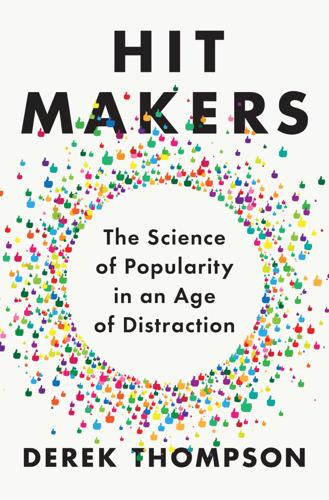
Hit Makers: The Science of Popularity in an Age of Distraction
by
Derek Thompson
Published 7 Feb 2017
Talking was social; radio was broadcast: Derek Thompson, “Facebook and Fear,” The Atlantic, May 10, 2016, www.theatlantic.com/technology/archive/2016/05/the-facebook-future/482145/. “the perfect personalized newspaper”: Steven Levy, “Inside the Science That Delivers Your Scary-Smart Facebook and Twitter Feeds,” Wired, April 22, 2014, www.wired.com/2014/04/perfect-facebook-feed/. the “dozen doughnuts” problem: Steven Levy, “How 30 Random People in Knoxville May Change Your Facebook News Feed,” Backchannel, January 30, 2015, https://backchannel.com/revealed-facebooks-project-to-find-out-what-people-really-want-in-their-news-feed-799dbfb2e8b1#.srntqeuy7.
…
Facebook’s ability to watch its readers as they read is the dream of any publisher, going back to George Gallup.59 But it turns out that when a personalized newspaper holds up a perfect mirror before its audience, the reflection can be kind of gross. When the News Feed relies exclusively on user behavior, it can become pure sludge, an endless stream of nutrition-free diversions. The journalist Steven Levy has called this the “dozen doughnuts” problem. People know they shouldn’t eat doughnuts all day, but if a coworker puts a dozen doughnuts by your desk each afternoon, you might eat until your mouth is caked in sugar. The News Feed, too, can be a daily tabloid—a hyperminiaturized serving of celebrities, quizzes, and other forms of empty calories that people click on, telling Facebook’s algorithms to serve more doughnuts.

The Idealist: Aaron Swartz and the Rise of Free Culture on the Internet
by
Justin Peters
Published 11 Feb 2013
The US government provided the network infrastructure and initially decided to restrict commercial use of the service. (The last of these restrictions wasn’t lifted until 1995.) Thus these early users, prohibited from exploiting the network for profit, used it instead to foster the free exchange of information. This munificent ideology was encoded into what the author Steven Levy described in his insightful book Hackers as the “hacker ethic.” Hackers—a term for early computer programmers—wrote computer code and believed that other hackers should share their code and computing resources with their peers. This policy was, in part, a pragmatic one: at the time, computing resources were scarce, and possessiveness impeded productivity.
…
There are many battles to fight, and we need to keep going.70 Later that night, Swartz returned to the Supreme Court steps, where he talked and laughed and played the board game SET with the other members of his tribe, waiting for morning to come and the world to set itself right. The next morning, the courtroom was completely full. The Federal Reserve chairman Alan Greenspan was there; so was Hackers author Steven Levy. Jack Valenti was there, as was Sonny Bono’s widow, Representative Mary Bono. “The courtroom itself was an impressive structure,” Swartz noted on his blog. “Everything was very, very tall.”71 The court seemed skeptical of Lessig’s argument. “Many Justices repeatedly said that they felt [the CTEA] was a dumb law, that it took things out of the public domain without justification,” Swartz reported later on his blog.
…
year=1998&post=1998-10-22$5. 17 Michael Hart to Book People mailing list, October 19, 1998, http://onlinebooks.library.upenn.edu/webbin/bparchive?year=1998&post=1998-10-19$5. 18 Eric Eldred to Book People mailing list, October 19, 1998, http://onlinebooks.library.upenn.edu/webbin/bparchive?year=1998&post=1998-10-19$4. 19 Kaplan, “Online Publisher Challenges.” 20 Steven Levy, “Lawrence Lessig’s Supreme Showdown,” Wired, October 2002, http://archive.wired.com/wired/archive/10.10/lessig.html. 21 David Streitfeld, “The Cultural Anarchist vs. the Hollywood Police State,” Los Angeles Times, September 22, 2002, http://articles.latimes.com/2002/sep/22/magazine/tm-copyright38. 22 Naftali Bendavid, “Lawyer in Microsoft Case Cut Teeth at U. of C.”

Rise of the Robots: Technology and the Threat of a Jobless Future
by
Martin Ford
Published 4 May 2015
Narrative Science’s technology is used by top media outlets, including Forbes, to produce automated articles in a variety of areas, including sports, business, and politics. The company’s software generates a news story approximately every thirty seconds, and many of these are published on widely known websites that prefer not to acknowledge their use of the service. At a 2011 industry conference, Wired writer Steven Levy prodded Narrative Science co-founder Kristian Hammond into predicting the percentage of news articles that would be written algorithmically within fifteen years. His answer: over 90 percent.2 Narrative Science has its sights set on far more than just the news industry. Quill is designed to be a general-purpose analytical and narrative-writing engine, capable of producing high-quality reports for both internal and external consumption across a range of industries.
…
A few places in which the story of the sardine fishermen of Kerala has been told are The Rational Optimist by Matt Ridley, A History of the World in 100 Objects by Neil MacGregor, The Mobile Wave by Michael Saylor, Race Against the Machine by Erik Brynjolfsson and Andrew McAfee, Content Nation by John Blossom, Planet India by Mira Kamdar, and “To Do with the Price of Fish,” The Economist, May 10, 2007. And now this book joins the list. CHAPTER 4 1. David Carr, “The Robots Are Coming! Oh, They’re Here,” New York Times (Media Decoder blog), October 19, 2009, http://mediadecoder.blogs.nytimes.com/2009/10/19/the-robots-are-coming-oh-theyre-here. 2. Steven Levy, “Can an Algorithm Write a Better News Story Than a Human Reporter?,” Wired, April 24, 2012, http://www.wired.com/2012/04/can-an-algorithm-write-a-better-news-story-than-a-human-reporter. 3. Narrative Science corporate website, http://narrativescience.com. 4. George Leef, “The Skills College Graduates Need,” Pope Center for Education Policy, December 14, 2006, http://www.popecenter.org/commentaries/article.html?
…
Davenport, Paul Barth, and Randy Bean, “How ‘Big Data’ Is Different,” MIT Sloan Management Review, July 20, 2012, http://sloanreview.mit.edu/article/how-big-data-is-different. 7. Charles Duhigg, “How Companies Learn Your Secrets,” New York Times, February 16, 2012, http://www.nytimes.com/2012/02/19/magazine/shopping-habits.html. 8. As quoted in Steven Levy, In the Plex: How Google Thinks, Works, and Shapes Our Lives (New York: Simon and Schuster, 2011), p. 64. 9. Tom Simonite, “Facebook Creates Software That Matches Faces Almost as Well as You Do,” MIT Technology Review, March 17, 2014, http://www.technologyreview.com/news/525586/facebook-creates-software-that-matches-faces-almost-as-well-as-you-do/. 10.
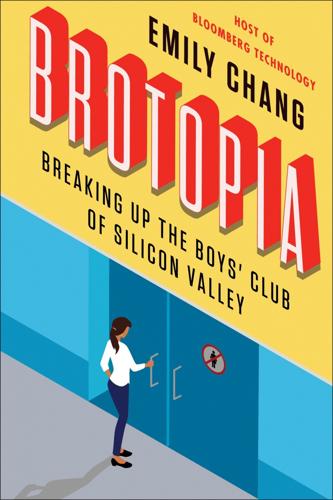
Brotopia: Breaking Up the Boys' Club of Silicon Valley
by
Emily Chang
Published 6 Feb 2018
AdWords allowed advertisers to place ads directly on the search results page, and AdSense enabled website owners to display Google ads that matched their content. Through AdSense, Wojcicki and the team at Google saw the chance to make all content on the web a potential advertising platform for the company. The potential was earth-shattering. “You do the content and leave the selling of the ads to Google,” she told Steven Levy in 2003, when he was a reporter at Newsweek. She predicted that the new technology would “change the economics of the web.” That proved to be an enormous understatement. Google’s new advertising platforms not only changed the economics of the web but also disrupted the economics of the magazine, newspaper, and television industries, and advertising itself
…
And it’s worth examining: Erik Larson, “Google Sued for Allegedly Paying Women Less Than Male Peers,” Bloomberg, Sept. 14, 2017, https://www.bloomberg.com/news/articles/2017-09-14/google-sued-by-women-workers-claiming-gender-discrimination. Google had no marketing budget: Adam Levy, “Susan Wojcicki: From Google Doodles to YouTube CEO,” Motley Fool, July 5, 2015, https://www.fool.com/investing/general/2015/07/05/susan-wojcicki-from-google-doodles-to-youtube-ceo.aspx. “You do the content”: Steven Levy, In the Plex (New York: Simon & Schuster, 2011), 84. In this particular column: Rachel Hutton, “Meeting Our Campus Celebrities,” Stanford Daily, Nov. 9, 1998, https://stanforddailyarchive.com/cgi-bin/stanford?a=d&d=stanford19981109-01.1.4&e=-------en-20--1--txt-txIN-------. “outstandingly attractive woman”: Hutton, “Meeting Our Campus Celebrities.”
…
“Of course I do”: Sheryl Sandberg, “Sheryl Sandberg: Bloomberg Studio 1.0 (Full Show),” interview by author, Bloomberg, Aug. 9, 2017, video, 24:16, https://www.bloomberg.com/news/videos/2017-08-10/sheryl-sandberg-bloomberg-studio-1-0-full-show-video. “broader group of employees”: “Uber Report: Eric Holder’s Recommendations for Change.” A true marvel: Steven Levy, “One More Thing: Inside Apple’s Insanely Great (or Just Insane) New Mothership,” Wired, May 16, 2017, https://www.wired.com/2017/05/apple-park-new-silicon-valley-campus. “everything an Apple employee”: Beth Spotswood, “Apple’s Campus Has Everything—Oh, Except Daycare,” SFist, May 19, 2017, http://sfist.com/2017/05/19/apples_campus_has_everything_-_oh_e.php.
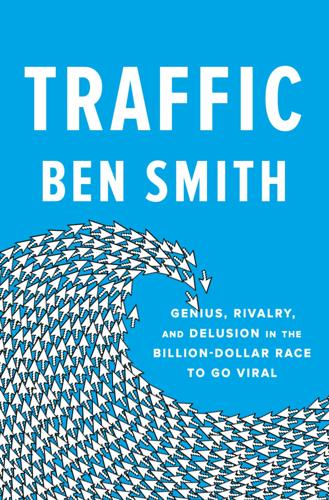
Traffic: Genius, Rivalry, and Delusion in the Billion-Dollar Race to Go Viral
by
Ben Smith
Published 2 May 2023
It was a monumental decision, setting off a frantic wave of competition between the two platforms for this apparently positive and inspirational new source of traffic mined from politics and social movements. That frenzy would later draw in companies from BuzzFeed and The Huffington Post to The New York Times, all hungering after the traffic Facebook could send them. Facebook chronicler Steven Levy later wrote that after failing to acquire Twitter, “Facebook tried to copy a number of Twitter’s features, including a real-time urgency and an increased viral pulse.” He speculated that if Facebook had done the deal, it might not have felt so driven to compete with Twitter to mine the traffic and attention of politics, and that “maybe the News Feed would not have courted so much of the toxicity it became known for later on.”
…
Go to note reference in text Cerami had met: Ari Berman, Herding Donkeys: The Fight to Rebuild the Democratic Party and Reshape American Politics (New York: Picador, 2012). Go to note reference in text In an email to Twitter’s: Nick Bilton, Hatching Twitter: A True Story of Money, Power, Friendship, and Betrayal (New York: Portfolio, 2014). Go to note reference in text He speculated that if Facebook: Steven Levy, “The Alternative Universe Where Facebook Bought Twitter,” Wired, March 6, 2020, https://www.wired.com/story/the-alternate-universe-where-facebook-bought-twitter. Go to note reference in text Chapter 13—$100 Million “I had looked over”: Joshua Green, Devil’s Bargain: Steve Bannon, Donald Trump, and the Nationalist Uprising (New York: Penguin Books, 2017).
…
Ryan Holiday’s 2018 Conspiracy supplied both secret narrative and Peter Thiel’s motivations in the plot against Gawker (along with a lot of digressions about classicism), and his reporting undergirds parts of chapters 9 and 27. David Kirkpatrick’s 2010 The Facebook Effect offers a rare glimpse at how Facebook saw itself, and how episodes like the One Million Voices Against FARC shaped its own actions and identity. Steven Levy’s 2020 Facebook: The Inside Story helped me understand how the company and our perceptions of it had changed. AJ Daulerio’s beautiful newsletter on sobriety, The Small Bow, offered a glimpse of both his own experience and Aileen Gallagher’s, and allowed me to include his perspective though Daulerio didn’t cooperate with this book.
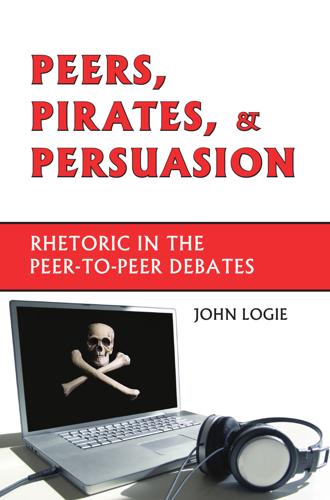
Peers, Pirates, and Persuasion: Rhetoric in the Peer-To-Peer Debates
by
John Logie
Published 29 Dec 2006
While it is already difficult to recall in full the culture and language of the first wave of hackers, there are a number of texts that function effectively as “time capsules,” offering snapshots of early hackers and their activities. Among the most important of these is a 1984 book by Steven Levy with the telling title, Hackers: Heroes of the Computer Revolution. Levy’s choice of “heroes” is underscored by the paperback edition’s front cover blurb, which reads, “What Tom Wolfe did for the original astronauts, Steven Levy has done for hackers.” Implicit in this comparison is the suggestion that hackers, like astronauts, are explor- Pa r l orPr e s s wwwww. p a r l or p r e s s . c om Hackers, Crackers, and the Criminalization of Peer-to-Peer Technologies 25 ers.
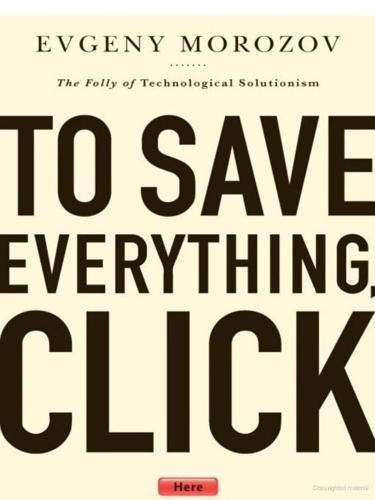
To Save Everything, Click Here: The Folly of Technological Solutionism
by
Evgeny Morozov
Published 15 Nov 2013
Our new algorithmic overlords should not aspire to act like ethical automatons; only by being self-reflexive and morally imaginative can they live up to the heavy burden of their civic responsibilities. Alas, their current attitude is nowhere near that ideal. Wired ’s Steven Levy, in his hagiographic biography of Google, observes that “Brin and Page both believed that if Google’s algorithms determined what results were best—and long clicks indicated that the algorithms were satisfying the people who did the searching—who were they to mess with it.” Believe this they did—but why didn’t Steven Levy bother to inquire why? It’s time our technology reporters learn to control their hagiographic impulses and start challenging the just-so narratives spouted by Silicon Valley.
…
(New York: HarperCollins, 2009), 48. 133 “to the extent that . . . new media”: Anthony Ha, “Sean Parker: Defeating SOPA was the ‘Nerd Spring,’” TechCrunch, March 12, 2012, http://techcrunch.com/2012/03/12/sean-parker-defeating-sopa-was-the-nerd-spring. 133 “a vegetarian trapped inside the sausage factory”: quoted in Steven Levy, In the Plex: How Google Thinks, Works, and Shapes Our Lives (New York: Simon & Schuster, 2011), 327. 133 “an incumbent protection machine”: Derek Thompson, “Google’s CEO: ‘The Laws Are Written by Lobbyists,’” The Atlantic, October 1, 2010, http://www.theatlantic.com/technology/archive/2010/10/googles-ceo-the-laws-are-written-by-lobbyists/63908. 133 “it is overdue to rethink”: Noveck, Wiki Government, 16. 133 “the digital environment offers”: ibid., 40. 133 “most of the work”: ibid., 40. 134 “a generative governance system can”: Parag Khanna and Ayesha Khanna, Hybrid Reality: Thriving in the Emerging Human-Technology Civilization, Kindle ed.
…
Siegler, “Marissa Mayer’s Next Big Thing: ‘Contextual Discovery’—Google Results without Search,” TechCrunch, December 8, 2010, http://techcrunch.com/2010/12/08/googles-next-big-thing. 144 “It is a mistake to look into the mirror”: James Robinson, “Twitter and Facebook Riot Restrictions Would Be a Mistake, Says Google Chief,” The Guardian, August 27, 2011, http://www.guardian.co.uk/media/2011/aug/27/twitter-facebook-riot-restrictions-eric-schmidt. 145 “our role in the system”: Ian Paul, “Facebook CEO Challenges the Social Norm of Privacy,” PCWorld, January 11, 2010, http://www.pcworld.com/article/186584/facebook_ceo_challenges_the_social_norm_of_privacy.html. 145 What sociologist Donald MacKenzie wrote: Donald MacKenzie, An Engine, Not a Camera: How Financial Models Shape Markets (Cambridge, MA: MIT Press, 2008). 146 “Brin and Page both believed”: Steven Levy, In the Plex: How Google Thinks, Works, and Shapes Our Lives (New York: Simon & Schuster, 2011), 174. 147 “democracy on the Web works”: “Ten Things We Know to Be True,” Google, http://www.google.com/about/company/philosophy. 147 “We’re scientists”: quoted in Shawn Donnan, “Think Again,” Financial Times, July 8, 2011, http://www.ft.com/intl/cms/s/2/b8e8b560-a84a-11e0–9f50–00144feabdc0.html. 148 “It never occurred to me”: quoted in Levy, In the Plex, 171. 148 “criticize the consumer for doing things”: Julie Moos, “Transcript of Google CEO Eric Schmidt’s Q&A at NAA,” Poynter.org, April 7, 2009, http://www.poynter.org/latest-news/top-stories/95079/transcript-of-google-ceo-eric-schmidts-qa-at-naa. 149 “filters no longer filter out”: David Weinberger, Too Big to Know: Rethinking Knowledge Now that the Facts Aren’t the Facts, Experts Are Everywhere, and the Smartest Person in the Room Is the Room (New York: Basic Books, 2012), 11. 149 “instead of reducing information and hiding”: ibid., 13. 149 Weinberger identifies five “most basic properties”: ibid., 50. 150 This was the case with the Occupy Wall Street discussion: Tarleton Gillespie, “Can an Algorithm Be Wrong?
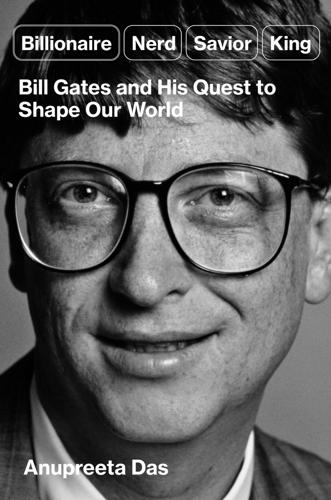
Billionaire, Nerd, Savior, King: Bill Gates and His Quest to Shape Our World
by
Anupreeta Das
Published 12 Aug 2024
When the Gates Foundation made a $100 million donation to establish a children’s vaccine fund, Auletta wrote: “The Gates Foundation… had made many generous gifts in the past, but what was unusual about this gift was that it was made in such a public way.” Gates did receive some favorable coverage. In the August 1999 issue of Newsweek magazine, the tech journalist Steven Levy portrayed Gates as a family man “who just wants to have fun.”7 As Gates told Levy, “When somebody’s successful, people leap to simple explanations that might make sense. So you get these myths. People love to have any little story. Yes, I’m intense. I’m energetic. I like to understand what our market position is.
…
Steve Hamm, “Bill Gates: ‘I’m Humble. I’m Respectful.’ ” Bloomberg, February 9, 1998. 4. Steve Lohr, “The Chairman’s Vision,” The New York Times, June 16, 2000. 5. Frank Rich, “Love That Bill,” The New York Times, March 7, 1998. 6. Ken Auletta, World War 3.0 (New York: Random House, 2001): 131. 7. Steven Levy, “Behind the Gates Myth,” Newsweek, August 29, 1999. 8. John Jurgensen, “In Bill Gates’s Mind, A Life of Processing,” The Wall Street Journal, September 10, 2019. Also see: Gates, “The Day I Knew What I Wanted to Do for the Rest of My life,” GatesNotes, September 20, 2019. 9. “When in Seattle, Bono Bunks with Bill Gates,” Reuters, May 2005. 10.
…
Apoorva Mandavilli, “A Multibillion-Dollar Plan to End Polio, and Soon,” The New York Times, June 9, 2021. 5. Robert Fortner, “Has the Billion Dollar Crusade to Eradicate Polio Come to an End?” BMJ 374, no. 1818 (2021). 6. Maria Di Mento, “Bill Gates Made 2022’s Biggest Charitable Donation: $5 Billion,” Associated Press, December 30, 2022. 7. Steven Levy, “Bill Gates Is Upbeat on Climate, Capitalism and Even Politics,” Wired, March 18, 2021. 8. Bill Gates, “By 2026, the Gates Foundation Aims to Spend $9 Billion a Year,” GatesNotes, July 13, 2022. Further Reading Alger, Horatio, Jr. Ragged Dick and Struggling Upward. New York: Penguin Books, 1985.

The Wide Lens: What Successful Innovators See That Others Miss
by
Ron Adner
Published 1 Mar 2012
The value blueprint builds on these perspectives, with a focus on designing the most effective configuration to deliver the value proposition. 88 $550 device: “Sony Shows Data Discman,” New York Times, September 13, 1991. 88 The Rocket, developed by NuvoMedia: Martin Arnold, “From Gutenberg to Cyberstories,” New York Times, January 7, 1999. 88 That same year the SoftBook: Peter Lewis, “Taking on New Forms, Electronic Books Turn a Page,” New York Times, July 2, 1998. 88 Gemstar released two models: Ken Feinstein, “RCA REB1100 eBook Review,” CNET.com, February 21, 2001, http://reviews.cnet.com/e-book-readers/rca-reb1100-ebook/4505-3508_7-4744438.xhtml. 89 proof that the electronic book was ready for the mainstream: Doreen Carvajal, “Long Line Online for Stephen King E-Novella,” New York Times, March 16, 2000. 90 Random House’s e-book revenues doubled: Nicholas Bogaty, “eBooks by the Numbers: Open eBook Forum Compiles Industry Growth Stats,” International Digital Publishing Forum, press release, July 22, 2002, http://old.idpf.org/pressroom/pressreleases/ebookstats.htm. 90 “difficult to find, buy and read e-books”: Steven Levy, “The Future of Reading,” Newsweek, November 26, 2007. 90 Paltry content and intense digital rights management: Ginny Parker Woods, “Sony Cracks Open New Book with Reader,” Toronto Star, February 20, 2006. 90 “We’ve been very cautious in launching [the Reader]”: Michael Kanellos, “Sony’s Brave Sir Howard,” CNET.com, January 17, 2007, http://news.cnet.com/Sonys-brave-Sir-Howard/2008-1041_3-6150661.xhtml. 90 almost 20 percent cheaper than the Librié: Sony Librié ebook Review, eReaderGuide.Info, www.ereaderguide.info/sony_librie_ebook_reader_review.htm. 90 10,000 titles available at Connect.com: Edward Baig, “Sony Device Gets E-Book Smart,” USA Today, October 5, 2006. 91 the iPod of the book industry: David Derbyshire, “Electronic BookOpens New Chapter for Readers,” Daily Telegraph, September 28, 2006. 91 much fanfare from the press: Amanda Andrews, “Sony’s Hitting the Books,” Australian, February 28, 2006. 92 lowering publisher confidence: George Cole, “Will the eBook Finally Replace Paper?
…
Accessed July 15, 2011. 201 “no Kenyan is locked out of accessing basic banking services”: “M-Kesho: ‘Super Bank Account’ from Safaricom and Equity Bank,” Techmtaa.com, May 18, 2010, http://www.techmtaa.com/2010/05/18/m-kesho-super-bank-account-from-safaricom-and-equity-bank/. 207 “Creative Zen Vision:M certainly has the goods”: “CNET Editors Cover the Best of CES 2006,” CNET.com, http://www.cnet.com/4520-11405_1-6398234-1.xhtml. 207 “hand-held computer that’s fully in the iPhone’s class”: Walt Mossberg, “Palm’s New Pre Takes On iPhone,” Wall Street Journal, June 3, 2009. 207 “the Android tablet concept”: David Pogue, “It’s a Tablet. It’s Gorgeous. It’s Costly,” New York Times, November 10, 2010. 209 90 percent of the world that used Windows: Ian Fried, “Are Mac Users Smarter?” CNET.com, July 12, 2002, http://news.cnet.com/2100-1040-943519.xhtml. 210 iPod, boasting 100 million customers: Steven Levy, “Why We Went Nuts About the iPhone,” Newsweek, July 16, 2007. 210 Apple’s stock shot up 44 percent: Matt Krantz, “iPhone Powers up Apple’s Shares,” USA Today, June 28, 2007. 211 “four times the number of PCs that ship every year”: Morris, “Steve Jobs Speaks Out.” 211 Ericsson released the R380: Dave Conabree, “Ericsson Introduces the New R380e,” Mobile Magazine, September 25, 2001. 211 Palm followed up with its version: Sascha Segan, “Kyocera Launches First Smartphone in Years,” PC Magazine, March 23, 2010, http://www.pcmag.com/article2/0,2817,2361664,00.asp#fbid=C81SVwKJIvh. 211 “one more entrant into an already very busy space”: “RIM Co-CEO Doesn’t See Threat from Apple’s iPhone,” InformationWeek, February 12, 2007. 212 the phone was exclusively available from only one carrier: In a handful of markets regulators ruled the exclusivity arrangement illegal. 212 “The bigger problem is the AT&T network”: David Pogue, “The iPhone Matches Most of Its Hype,” New York Times, June 27, 2007. 212 priced at a mere $99 in 2007: Kim Hart, “Rivals Ready for iPhone’s Entrance; Pricey Gadget May Alter Wireless Field,” Washington Post, June 24, 2007. 212 “cause irreparable damage to the iPhone’s software”: Apple, press release, September 24, 2007. 213 “I say I like our strategy”: Steve Ballmer interviewed on CNBC, January 17, 2007. 213 They ran out of the older model six weeks before the July 2008 launch: Tom Krazit, “The iPhone, One Year Later,” CNET.com, June 26, 2008, http://news.cnet.com/8301-13579_3-9977572-37.xhtml. 213 60 percent went to buyers who already owned at least one iPod: Apple COO Tim Cook’s comments at Goldman Sachs Technology and Internet Conference, cited in JPMorgan analyst report, “Strolling Through the Apple Orchard: The Good, the Bad and the Ugly Scenarios,” March 4, 2008. 215 the average iPhone user paid AT&T $2,000: Jenna Wortham, “Customers Angered as iPhones Overload AT&T,” New York Times, September 2, 2009. 215 as high as $18 per user per month: Tom Krazit, “Piper Jaffray: AT&T Paying Apple $18 per iPhone, Per Month,” CNET.com, October 24, 2007, http://news.cnet.com/8301-13579_3-9803657-37.xhtml. 216 Apple announced its 10 billionth app download: Apple.com, “iTunes Store Tops 10 Billion Songs Sold,” February 25, 2010, http://www.apple.com/pr/library/2010/02/25iTunes-Store-Tops-10-Billion-Songs-Sold.xhtml.

Electronic and Algorithmic Trading Technology: The Complete Guide
by
Kendall Kim
Published 31 May 2007
Macgregor’s software is a central hub for trading used by 100 blue-chip 146 Electronic and Algorithmic Trading Technology institutional clients including Babson Capital, Delaware Investments, and T. Rowe Price with about $5.5 trillion in assets. Rumors circulated that Reuters, SunGard, and Thomson Financial were among the bidders for Macgregor, according to industry sources.6 Broker neutrality will remain an important element in acquiring other order management systems. Steven Levy, president and CEO of Macgregor, says, ‘‘It is important to note that your broker neutrality and anonymity requirements will continue to be held paramount. You will continue to be able to trade with any broker and liquidity venue you chose.’’ This may possibly be the beginning trend of broker-dealers acquiring order management systems.
…
Herring, 44 Risk Effect, 11 Rule 390, 39, 43, 44, 45, 46, 49 P S Paper Portfolio, 54 Pegging, 101 Peter Bergan, 63 Piper Jaffray, 61, 62 Plexus Group, 36, 63, 94, 106, 143 Portfolio Insurance, 8, 11 Portware, 3, 35, 108, 165, 169 Post-trade, 21, 24, 53, 54, 68, 86, 103, 105, 134 Pre-trade, 21, 24, 53, 54, 63, 64, 67, 86, 91, 103, 107, 108, 109, 134 Prime Broker, 34, 153, 154, 155, 156, 158, 159, 160, 162 Program Trading, 8, 10, 12, 29, 30, 32, 33, 34, 80, 81, 100 Proprietary trading, 62 Putnam Investments, 92 Sales trader, 26 Salomon Brothers, 3 S&P 500, 10, 11, 12 Sarbanes-Oxley, 44 Security Exchange Act of 1934, 43 Securities Exchange Commission (SEC), 2, 6, 7, 10, 47, 75, 125, 126, 128, 130, 134, 135, 136, 137 Securities Industry Automation Corp (SIAC), 83, 87, 89 Self Regulatory Organizations (SRO), 126, 131, 133, 135 Sell-side, 4, 20, 77 Settlements, 15, 17, 18, 27, 43, 89, 153, 154 Slippage, 65 Smart order routing, 22, 101 Soft dollars, 21, 51 Sonic Financial Technologies, 36, 80, 143 Specialist, 43 Speer Leads & Kellog (SLK), 143 Straight Through Processing (STP), 19, 27, 116, 162 Strategy enabler, 19, 85 STN, 36 Sungard, 75, 89, 172, 173, 175 SunGard Transaction Network (STN), 145 Sub-penny Rule, 125, 128, 132, 140 Steven Levy, 146 Q Quant House, 170 Quantitative Services Group (QSG), 36, 106, 170 R Rabbit Portfolio, 54 Radianz, 173 Ray Killian, 143 Real Time (TCA), 65 Real-time data, 19 Reconciliation, 18 REDIPlus, 72, 74, 143 T T. Rowe Price, 146 TABB Group, 21, 72, 75, 81, 84, 87, 103, 104, 131, 144, 153, 155, 158, 160, 163 Index 203 Telekurs Financial, 121 Thomas Loeb, 94 Thomson, 89, 116, 117, 118, 119 Time slicing, 101 Time Weighted Average Price (TWAP), 10, 60, 62, 101, 150 TowerGroup, 161 Trade Reporting and Compliance Engine (TRACE) Reporting, 70, 120, 121 Trade Through Rule, 39, 125, 131, 132 TradeWeb, 69, 116, 117, 118, 119, 121 Transaction Cost Analysis (TCA), 22, 63, 147 Transaction Cost Research (TCR), 103 Transaction Network Services, Inc.

This Machine Kills Secrets: Julian Assange, the Cypherpunks, and Their Fight to Empower Whistleblowers
by
Andy Greenberg
Published 12 Sep 2012
That strategy meant that the members of the L0pht, hackers with names like Kingpin, Weld Pond, Count Zero, Space Rogue, Brian Oblivion, Silicosis, and Dildog, could refine their skills and break ground in digital penetration without ever stepping across the law. The L0pht’s misfits adhered instead to a sort of modernized version of the hacker code laid out ten years before by Steven Levy in the book Hackers: Don’t hack anyone else’s machines. Don’t break the law. Share everything, both physical materials and information. Ethics aside, the L0pht was a wellspring of epic mischief. Kingpin, a brilliant baby-faced hacker in his early twenties, had developed a hardware kit to eavesdrop on the unencrypted signals from pagers, a protocol known as POCSAG.
…
With the exception of any stray facts that may have been missed in my efforts to note all sources, everything I’ve written that’s not cited below can be attributed to my own reporting. Primary sources and interviews aside, I’m particularly indebted to a few prior books and articles as instructive signposts for my reporting and primary sources in their own right. They include Daniel Ellsberg’s memoir Secrets, Suelette Dreyfus and Julian Assange’s Underground, Steven Levy’s Crypto, Daniel Domscheit-Berg’s memoir Inside WikiLeaks, Robert Manne’s “The Cypherpunk Revolutionary: Julian Assange” in Australia’s The Monthly, Nathaniel Rich’s “The Most Dangerous Man In Cyberspace” in Rolling Stone, and Raffi Khatchadourian’s spectacular New Yorker article “No Secrets.” PROLOGUE: THE MEGALEAK trick companies’ employees into revealing their passwords over the phone Suelette Dreyfus and Julian Assange.
…
The Puzzle Palace (New York: Penguin Books, 1983). only weakness is the identity that ties them to their frail bodies Vernor Vinge. “True Names.” In True Names and the Opening of the Cyberspace Frontier (New York: Tor, 2001), first published in Dell Binary Star #5, 1981. M. T. Graves and the Dungeon Steven Levy. Crypto (New York: Penguin Books, 2001), p. 187. Herbert Zim’s Codes & Secret Writing Ibid. produce a solution in minutes Levy, p. 188. remove the pad’s random noise, breaking the ciphers “The Vernon Story,” published by the Center for Cryptologic History, NSA.gov, available at http://www.nsa.gov/about/_files/cryptologic_heritage/publications/coldwar/venona_story.pdf “Poe’s dictum will be hard to defend in any form” Martin Gardner.

Whiplash: How to Survive Our Faster Future
by
Joi Ito
and
Jeff Howe
Published 6 Dec 2016
Hip-Hop Dancer,” TechRepublic, July 27, 2015, http://www.techrepublic.com/article/julia-hu-lark-founder-digital-health-maven-hip-hop-dancer/. 4 And expected to increase in value to $3 trillion by 2020. Michael De Waal-Montgomery, “China and India Driving $3T Consumer Electronics Boom, Smart Home Devices Growing Fastest,” VentureBeat, n.d., http://venturebeat.com/2015/11/05/china-and-india-driving-3t-consumer-electronics-boom-smart-home-devices-growing-fastest/. 5 Steven Levy, “Google’s Larry Page on Why Moon Shots Matter,” WIRED, January 17, 2013, http://www.wired.com/2013/01/ff-qa-larry-page/. 6 David Rowan, “Chinese Pirates Are Tech’s New Innovators,” Wired UK, June 1, 2010. 7 David Barboza, “In China, Knockoff Cellphones Are a Hit,” New York Times, April 27, 2009, http://www.nytimes.com/2009/04/28/technology/28cell.html. 8 Robert Neuwirth, “The Shadow Superpower,” Foreign Policy, accessed May 29, 2016, https://foreignpolicy.com/2011/10/28/the-shadow-superpower/. 9 Douglas S.
…
Lide, ed., A Century of Excellence in Measurements, Standards, and Technology: A Chronicle of Selected NIST Publications 1901–2000, NIST Special Publication 958 (Washington, D.C.: U.S. Department of Commerce, National Institute of Standards and Technology, 2001). 38 W. Diffie and M. Hellman, “New Directions in Cryptography,” IEEE Transactions in Information Theory 22, no. 6 (November 1976): 644–54, doi:10.1109/TIT.1976.1055638. 39 Steven Levy, “Battle of the Clipper Chip,” New York Times Magazine, June 12, 1994, http://www.nytimes.com/1994/06/12/magazine/battle-of-the-clipper-chip.html. 40 R. L. Rivest, A. Shamir, and L. Adleman, “A Method for Obtaining Digital Signatures and Public-Key Cryptosystems,” Communications of the ACM 21, no. 2 (February 1978): 120–26, doi:10.1145/359340.359342. 41 AP, “Firm Shuts Down Privacy Feature,” Calgary Herald, October 9, 2001. 42 CCNMatthews (Canada), “Radialpoint CEO a Finalist for Ernst & Young Entrepreneur of the Year Awards,” MarketWired, July 29, 2005. 43 Roberto Rocha, “What Goes Around Comes Around; Montreal-Based Akoha.com Encourages Acts of Kindness by Turning Altruism into a Game,” Gazette, July 14, 2009. 44 The Akoha Team, “Akoha Shutting Down August 15 2011,” Akoha Blog, August 2, 2011, https://blog.akoha.com/2011/08/02/akoha-shutting-down-august-15-2011/. 45 Michael J.

12 Bytes: How We Got Here. Where We Might Go Next
by
Jeanette Winterson
Published 15 Mar 2021
And no one was showing the girls pictures of the ENIAC and its all-female team, nor were professors goading the boys to see if any of them could manage what the women had done – without a manual. * * * In fact, history was being distorted to exclude those women and others like them. In 1984, Steven Levy published his bestselling book Hackers: Heroes of the Computer Revolution. Levy’s book has no women in it. Women aren’t heroes and they aren’t important in computing. The book is still in print, without corrections, and is marketed as a ‘classic’. * * * 1984 is the slipping point. Young women began dropping out of computer-science courses, or not enrolling at all.
…
Susan Sellers, 1994 The Dialectic of Sex: The Case for Feminist Revolution, Shulamith Firestone, 1970 Sapiens: A Brief History of Humankind, Yuval Noah Harari, 2011 Invisible Women: Exposing Data Bias in a World Designed for Men, Caroline Criado Perez, 2019 The I-Ching Testosterone Rex: Myths of Sex, Science, and Society, Cordelia Fine, 2017 (and everything she has written and will write) The Gendered Brain: The New Neuroscience That Shatters the Myth of the Female Brain, Gina Rippon, 2019 The Future Isn’t Female Unlocking the Clubhouse: Women in Computing, Jane Margolis and Allan Fisher, 2002 Programmed Inequality: How Britain Discarded Women Technologists and Lost Its Edge in Computing, Marie Hicks, 2017 Algorithims of Oppression: How Search Engines Reinforce Racism, Safiya Umoja Noble, 2018 The Glass Universe: How the Ladies of the Harvard Observatory Took the Measure of the Stars, Dava Sobel, 2016 Let it Go: My Extraordinary Story – from Refugee to Entrepreneur to Philanthropist, the memoir of Dame Stephanie Shirley, 2012 (If you don’t have time for this, just find her TED Talk.) Uncanny Valley, Anna Wiener, 2020 The Second Sex, Simone de Beauvoir, 1949 Hackers: Heroes of the Computer Revolution, Steven Levy, 1984 Psychology of Crowds, Gustave Le Bon, 1896 Lean In: Women, Work, and the Will to Lead, Sheryl Sandberg, 2013 Difficult Women: A History of Feminism in 11 Fights, Helen Lewis, 2020 A Room of One’s Own, Virginia Woolf, 1929 Your Computer Is on Fire, various editors, 2021 (haven’t read this at time of going to press but looks great) The Blank Slate: The Modern Denial of Human Nature, Steven Pinker, 2002 Of Woman Born: Motherhood as Experience and Institution, Adrienne Rich, 1976 The Better Half: On the Genetic Superiority of Women, Sharon Moalem, 2020 Jurassic Car Park Nineteen Eighty-Four, George Orwell, 1949 The War of the Worlds, H.
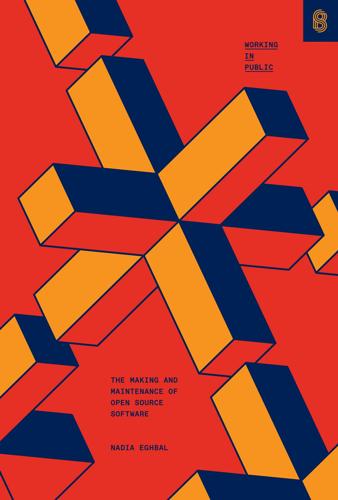
Working in Public: The Making and Maintenance of Open Source Software
by
Nadia Eghbal
Published 3 Aug 2020
Code, like livestock, needs liberation from humanity, even at the expense of personal convenience. To write free software, then, was to be free of the constraints that normally plagued commercial software environments. Free software was counterculture, and it fell right in line with the burgeoning hacker culture of the times. The term “hacker” was popularized by author Steven Levy, who memorably captured a portrait of the 1980s hacker generation in the book Hackers: Heroes of the Computer Revolution. In Hackers, Levy profiles a number of well-known programmers of the time, including Bill Gates, Steve Jobs, Steve Wozniak, and Richard Stallman. He suggests that hackers believe in sharing, openness, and decentralization, which he calls the “hacker ethic.”17 According to Levy’s portrait, hackers care about improving the world, but don’t believe in following the rules to get there.
…
,” GNU Operating System, July 30, 2019, https://www.gnu.org/philosophy/free-sw.en.html. 16 Nicole Martinelli, “Walking the Walk: Why It’s a Crooked Path for Free Software Activists,” Super User, February 8, 2019, https://superuser.openstack.org/articles/walking-the-walk-why-its-a-crooked-path-for-free-software-activists/. 17 Steven Levy, Hackers: Heroes of the Computer Revolution - 25th Anniversary Edition (Sebastopol, CA: O’Reilly, 2010). 18 Linus Torvalds (torvalds), “Add Support for AR5BBU22 [0489:e03c],” Linux Pull Requests, GitHub, May 11, 2012, https://github.com/torvalds/linux/pull/17#issuecomment-5654674. 19 Eric S.

Prediction Machines: The Simple Economics of Artificial Intelligence
by
Ajay Agrawal
,
Joshua Gans
and
Avi Goldfarb
Published 16 Apr 2018
Scott Forstall, quoted in “How the iPhone Was Born,” Wall Street Journal video, June 25, 2017, http://www.wsj.com/video/how-the-iphone-was-born-inside-stories-of-missteps-and-triumphs/302CFE23-392D-4020-B1BD-B4B9CEF7D9A8.html. Chapter 13 1. Steve Jobs in Memory and Imagination: New Pathways to the Library of Congress, Michael Lawrence Films, 2006, https://www.youtube.com/watch?v=ob_GX50Za6c. Chapter 14 1. Steven Levy, “A Spreadsheet Way of Knowledge,” Wired, October 24, 2014, https://backchannel.com/a-spreadsheet-way-of-knowledge-8de60af7146e. 2. Nick Statt, “The Next Big Leap in AI Could Come from Warehouse Robots,” The Verge, June 1, 2017, https://www.theverge.com/2017/6/1/15703146/kindred-orb-robot-ai-startup-warehouse-automation. 3.
…
This discussion is based on Dirk Bergemann and Alessandro Bonatti, “Selling Cookies,” American Economic Journal: Microeconomics 7, no. 2 (2015): 259–294. 7. One example is Mastercard Advisors consulting services, which use Mastercard’s vast quantity of data to provide a variety of predictions, ranging from consumer fraud to retention rates. See http://www.mastercardadvisors.com/consulting.html. Chapter 17 1. As told to Steven Levy. See Will Smith, “Stop Calling Google Cardboard’s 360-Degree Videos ‘VR,’” Wired, November 16, 2015, https://www.wired.com/2015/11/360-video-isnt-virtual-reality/. 2. Jessir Hempel, “Inside Microsoft’s AI Comeback,” Wired, June 21, 2017, https://www.wired.com/story/inside-microsofts-ai-comeback/. 3.
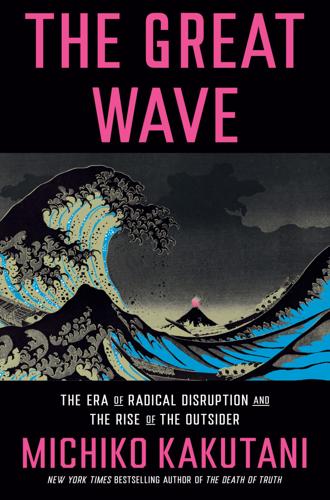
The Great Wave: The Era of Radical Disruption and the Rise of the Outsider
by
Michiko Kakutani
Published 20 Feb 2024
Or if they are little more than virtue signaling—like the safety pins some liberals attached to their jackets after Trump’s election (meant to signify solidarity with the oppressed), or the ubiquitous black squares that appeared on Instagram, meant to show support for Black Lives Matter—well-meaning gestures, perhaps, but no substitute for real and sustained commitment to change. Chapter 7 THE CENTRIFUGAL REPUBLIC: Why Hackers, Politicians, and Business Leaders Embraced Decentralization … Be water. —Bruce Lee In his classic 1984 book, HACKERS: HEROES OF THE Computer Revolution, the journalist Steven Levy defined the “hacker ethic,” emerging among MIT students and early Silicon Valley pioneers during the middle decades of the twentieth century. Its central precepts, he wrote, included the following: “Access to computers—and anything that might teach you something about the way the world works—should be unlimited and total”; “All information should be free”; and “Mistrust Authority—Promote Decentralization.”
…
GO TO NOTE REFERENCE IN TEXT As of early 2022, a survey found: Taylor Rogers, “Companies Urged to Honour Racial Justice Pledges,” Financial Times, Jan. 18, 2022, ft.com/content/f29449c1-aa80-40b3-9794-5b02bb557019. GO TO NOTE REFERENCE IN TEXT Chapter 7: The Centrifugal Republic Its central precepts, he wrote: Steven Levy, Hackers: Heroes of the Computer Revolution (Sebastopol, California: O’Reilly Media, 2010), 23–25. GO TO NOTE REFERENCE IN TEXT the development of “packet switching”: “The Origins of the Internet,” in “A Short History of the Internet,” Science and Media Museum, Dec. 3, 2020, scienceandmediamuseum.org.uk/objects-and-stories/short-history-internet#what-is-packet-switching.

Surveillance Valley: The Rise of the Military-Digital Complex
by
Yasha Levine
Published 6 Feb 2018
An auto-suggest spellchecker feature allowed Google to recognize minor but important quirks in the way people used language in order to guess the meaning of what people typed rather than just matching text to text. “Today, if you type ‘Gandhi bio,’ we know that ‘bio’ means ‘biography.’ And if you type ‘bio warfare,’ it means ‘biological,’” another Google engineer explained. Steven Levy, a veteran tech journalist whose early career included a stint at Stewart Brand’s Whole Earth Software Catalog in the 1980s, gained unprecedented insider access to write the history of Google. The result was In the Plex: How Google Thinks, Works, and Shapes Our Lives, a hagiographic but highly informative story of Google’s rise to dominance.
…
The story of Sergey Brin’s search for terrorists in Google’s logs comes from I’m Feeling Lucky: The Confessions of Google Employee Number 59, an amazing insider account by former Google employee Douglas Edwards. All direct quotes of Edwards in this chapter come from his book. 2. Vivian Marino, “Searching the Web, Searching the Mind,” New York Times, December 23, 2001. 3. Google engineer Amit Patel, quoted in Steven Levy, In the Plex: How Google Thinks, Works, and Shapes Our Lives (New York: Simon & Schuster, 2011), 46. 4. Douglas Edwards, I’m Feeling Lucky: The Confessions of Google Employee Number 59 (New York: Houghton Mifflin Harcourt, 2011), chap. 16. 5. President George W. Bush, “Remarks on Improving Counterterrorism Intelligence,” the American Presidency Project, University of California, Santa Barbara, February 14, 2003, http://www.presidency.ucsb.edu/ws/index.php?
…
John Ince, “The Lost Google Tapes,” January 2000, quoted in Walter Isaacson’s The Innovators, chap. 11. 32. “It’s all recursive. It’s all a big circle,” Larry Page later explained at a computer forum a few years after launching Google. “Navigating Cyberspace,” PC forum held in Scottsdale, AZ, 2001, quoted in Steven Levy’s In the Plex, 21. 33. John Battelle, “The Birth of Google,” Wired, August 1, 2005. 34. Ince, “The Lost Google Tapes,” quoted in Isaacson, The Innovators, chap. 11. 35. Sergey Brin and Larry Page, “The PageRank Citation Ranking: Bringing Order to the Web,” Stanford University InfoLab, January 29, 1998, http://ilpubs.stanford.edu:8090/422/1/1999-66.pdf. 36.
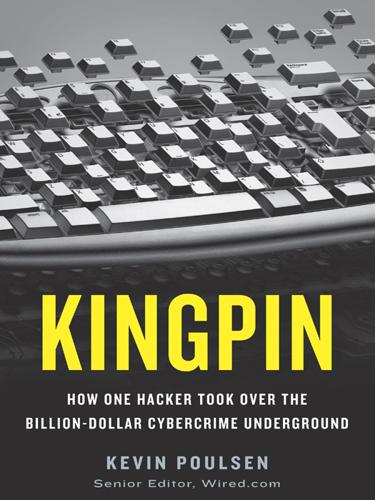
Kingpin: How One Hacker Took Over the Billion-Dollar Cybercrime Underground
by
Kevin Poulsen
Published 22 Feb 2011
See http://www.securityfocus.com/comments/articles/203/5729/threaded (May 24, 2001). Max says he did not consider himself an informant and only provided technical information. Chapter 4: The White Hat 1 The first people to identify themselves as hackers: The seminal work on the early hackers is Steven Levy, Hackers: Heroes of the Computer Revolution (New York: Anchor Press/Doubleday, 1984). Also see Steve Wozniak and Gina Smith, iWoz: From Computer Geek to Cult Icon: How I Invented the Personal Computer, Co-Founded Apple, and Had Fun Doing It (New York: W. W. Norton and Company, 2006). 2 Tim was at work one day: This anecdote was recalled by Tim Spencer.
…
District Court for the Eastern District of New York. 4 “We were lucky in this case, because Salgado’s purchaser was cooperating with the FBI”: Written testimony of Robert S. Litt, deputy attorney general, before the Subcommittee on Telecommunications, Trade and Consumer Protection, House Commerce Committee, September 4, 1997 (http://www.justice.gov/criminal/cybercrime/daag9_97.htm). 5 But the feds lost the crypto wars: For a detailed history, see Steven Levy, Crypto: How the Code Rebels Beat the Government—Saving Privacy in the Digital Age (New York: Penguin Books, 2002). Chapter 31: The Trial 1 “So, you take my girls out to party now?”: Interview with Giannone. 2 Once a jury is seated, a defendant’s chances for acquittal are about one in ten: Fiscal year 2006.

Lurking: How a Person Became a User
by
Joanne McNeil
Published 25 Feb 2020
We can back up our files, but this is a time-consuming task that isn’t exactly fail-proof. While backing up files is an individual solution, Google’s deletion of information is a break in shared knowledge: blog readers looking to reread an old post that has been lost are left with only their faulty memories of it. Steven Levy’s 2011 book In the Plex details a baffling exchange with Sergey Brin, who couldn’t understand why he was writing a book about the company in the first place. “Why don’t you just write some articles?” Brin asked Levy. “Or release this a chapter at a time?” (Mark Zuckerberg had similar antipathy. On his own social network, in its early years, he responded to the profile topic “Favorite Books” with “I don’t read.”)
…
Information about the event I was part of at the Institute of Contemporary Arts is on its website (“The Influence of Technology,” February 25, 2014), along with the dead YouTube link. The transcript of my talk is available here: https://archive.fo/OcY4H. In addition to the quotes from Sergey Brin about books in “That horrid Google on the prowl!!!,” in Steven Levy’s In the Plex (Simon & Schuster, 2011), and Ken Auletta’s Googled: The End of the World as We Know It (Penguin Press, 2009, 124), I found Zuckerberg’s statement “I don’t read” in Katherine Losse’s memoir The Boy Kings (Free Press, 2012, 6). In addition to Auletta and Levy’s encounters with Brin, John Battelle says in the footnotes of his book The Search (Portfolio, 2005) that “in exchange for sitting down with me, Page wanted the right to review every mention of Google, Page, or Brin in my book, then respond in footnotes.
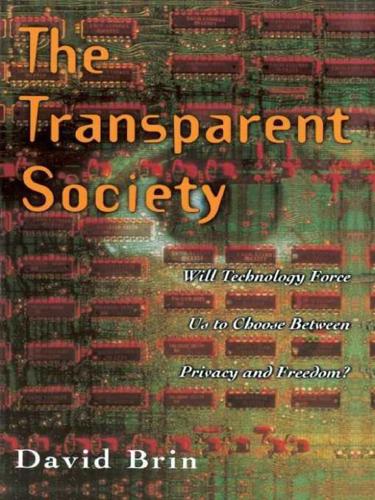
The Transparent Society: Will Technology Force Us to Choose Between Privacy and Freedom?
by
David Brin
Published 1 Jan 1998
When the CDA was argued before the United States Supreme Court, one aspect in dispute was whether Internet-based services such as America Online should be viewed as “common carriers,” which are not responsible for content, or whether their role is more that of “publishers,” answerable if some client uses their channels to pander or commit libel. At that level, the arguments may seem picky and recondite. But the fundamental issue can be expressed more simply. As Newsweek correspondent Steven Levy put it, Here is the nub: in cyberspace, the most democratic of mediums, should priority be given to allowing adults to exercise their constitutional right to speech? Or, as the CDA dictates, should they have to curb their expression—even certain constitutionally protected speech with redeeming social value like sex-education, highfalutin nude art, and George Carlin comedy routines—so that Net-surfing children will not be exposed to so-called patently offensive content?
…
By constantly ratcheting up the number of bits in their keys, encryptors should retain the advantage at any particular point in time. Assuming both sides truly have the same level of power available. But what if one side quietly gets its mitts on a petaflop machine, or a potent quantum unit, years ahead of its competitors? Then the inherent advantage shifts dramatically. As Steven Levy of Newsweek put it, “The strength of cryptography determines whoʼs going to try to break in.... if itʼs the Mafia or a national government, theyʼll have plenty of resources.” (Recall box 3 of the “plausibility matrix” on page 272.) The important thing to realize is that you can never know if this is not already the case.
…
In fact, both companies are said to be developing high-speed Web browsers to patrol the Net looking for music infringements. Well-funded content owners may be among the first to have truly sophisticated software agents doing their work of policing their own self-interest on the Net around the clock. 108 ... one paramount source of danger ... Steven Levy, Newsweek technology columnist and author of Crypto, a book about the cryptography revolution, who has been following the “Clipper chip” controversy and its followons, observed the persistence of single-direction ire in the controversy over encryption. “As the years go by, the subject gains more attention, almost all of it directed at attacking the governmentʼs case....” 109 ... governments that are well grounded in what works ...

Exploding the Phone: The Untold Story of the Teenagers and Outlaws Who Hacked Ma Bell
by
Phil Lapsley
Published 5 Feb 2013
Riches, or promises of riches, or maybe just a fun job that might pay the bills beckoned. In 1976 former phone phreaks Steve Jobs and Steve Wozniak were selling Apple I computers to their fellow hobbyists. “Jobs placed ads in hobbyist publications and they began selling Apples for the price of $666.66,” journalist Steven Levy wrote. “Anyone in Homebrew could take a look at the schematics for the design, Woz’s BASIC was given away free with the purchase of a piece of equipment that connected the computer to a cassette recorder.” The fully assembled and tested Apple II followed later that year. By 1977 microcomputers had begun to enter the mainstream.
…
Just as the phone company thought it was natural to mix computers and phone switches, John Draper thought it was natural to mix computers and phone phreaking. Draper was not the first to have this insight; students at MIT in the mid-1960s had interfaced one of the school’s PDP-6 microcomputers to the telephone line and used it as a computerized blue box. According to hacker historian Steven Levy, “At one point, [the telephone company] burst into the ninth floor at Tech Square, and demanded that the hackers show them the blue box. When the hackers pointed to the PDP-6, the frustrated officials threatened to take the whole machine, until the hackers unhooked the phone interface and handed it over.”
…
Bevard, “Five Students Psych Bell System, Place Free Long Distance Calls,” Harvard Crimson, May 31, 1966 <db991>. 8 Locke dug up the Herald article: Ron Kessler, “Student Dialers Play Their Way to Global Phone Calls, Non-Pay,” Boston Herald, May 27, 1966, p. 1 <db471>. 10 “Signaling Systems for Control of Telephone Switching”: C. Breen and C. A. Dahlbom, “Signaling Systems for Control of Telephone Switching,” Bell System Technical Journal, vol. 39, no. 6, November 1960, p. 1381 <db445>. 11 used a telephone dial to select the train to be controlled: Steven Levy, Hackers: Heroes of the Computer Revolution, 25th Anniversary Edition (Sebastopol, CA: O’Reilly Media), p. 8. Chapter 2: Birth of a Playground 14 the best known was created by Claude Chappe: J-M Dilhac, “The Telegraph of Claude Chappe—An Optical Telecommunications Network for the XVIIth Century,” IEEE Global History Network, at http://www.ieeeghn.org/wiki/images/1/17/Dilhac.pdf. 15 In America the inventor was Samuel Morse: The Supreme Court of the United States declared Morse to be the sole inventor of the telegraph; see Tom Standage, The Victorian Internet: The Remarkable Story of the Telegraph and the Nineteenth Century’s On-line Pioneers (New York: Walker Publishing Company, 2007), p. 183.

Amazon Unbound: Jeff Bezos and the Invention of a Global Empire
by
Brad Stone
Published 10 May 2021
He founded Blue Origin—the name refers to humanity’s birthplace, Earth—with a hypothesis that quickly proved incorrect: that significant advancements in space would require alternatives to liquid-fueled rockets. For the first few years, Blue resembled “a club more than a company,” as journalist Steven Levy later wrote in Wired, a think tank that included a dozen aficionados, like novelist Neal Stephenson and science historian George Dyson, who brainstormed radical and unproven ways to travel into space. By 2003, Bezos had changed course, acknowledging the unrivaled efficiency of conventional liquid propulsion.
…
Anne Kornblut, Matt Mosk, Adam Piore, Sean Meshorer, Ethan Watters, Michael Jordan, Fred Sharples, Ruzwana Bashir, Adam Rogers, Daniel McGinn, and Charles Duhigg all offered friendship and assistance at various moments of need. Nick and Chrysta Bilton generously hosted me on several trips to Los Angeles; Nick and Emily Wingfield offered the same hospitality in Seattle. Steven Levy has provided wise counsel and invaluable friendship over many years. I’m extremely fortunate to have a large and supportive family, including my brothers, Brian Stone and Eric Stone, Dita Papraniku Stone and Becca Zoller Stone, Luanne Stone, Maté Schissler and Andrew Iorgulescu, and Jon and Monica Stone.
…
the firm landed a Falcon 9 booster: Loren Grush, “SpaceX Successfully Lands Its Rocket on a Floating Drone Ship for the First Time,” The Verge, April 8, 2016, https://www.theverge.com/2016/4/8/11392138/spacex-landing-success-falcon-9-rocket-barge-at-sea (January 24, 2021). “a club more than a company”: Steven Levy, “Jeff Bezos Wants Us All to Leave Earth—for Good,” Wired, October 15, 2018, https://www.wired.com/story/jeff-bezos-blue-origin/ (January 24, 2021). Residents of the town of Van Horn: Clare O’Connor, “Jeff Bezos’ Spacecraft Blows Up in Secret Test Flight; Locals Describe ‘Challenger-Like’ Explosion,” Forbes, September 2, 2011, https://www.forbes.com/sites/clareoconnor/2011/09/02/jeff-bezos-spacecraft-blows-up-in-secret-test-flight-locals-describe-challenger-like-explosion/?
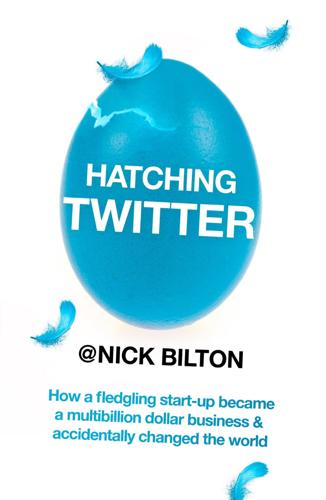
Hatching Twitter
by
Nick Bilton
Published 5 Nov 2013
(IEDs were “improvised explosive devices” planted by insurgents to kill Americans.) “Interesting,” Jack said nervously, pulling his head back inside and taking a deep breath. He looked at the others in his helicopter and smiled slightly. Scott was snapping pictures with a digital camera, Cohen was on his BlackBerry, and Steven Levy, a reporter, was writing in his notepad. Beyond Cohen’s ability to talk his way into almost any situation, he also had another very impressive skill: an knack for bringing the press along on his excursions. Levy, a columnist for Wired, had been invited to come along as this particular delegation’s embedded reporter.
…
Marin, Ryan Block, Tom Bodkin, Danah Boyd, Matt Buchanan, David Carr, Brian Chen, Mathias Crawford, Tony and Mary Conrad, Tom Conrad, Paddy Cosgrave, Dennis Crowley, Damon Darlin, Anil Dash, Mike Driscoll, Aaron Durand, Josh Felser, Tim Ferris, Brady Forrest, David Gallhager, Michael Galpert, John Geddes, Shelly Gerrish, Ashley Khaleesi Granata, Mark Hansen, Quentin Hardy, Leland Hayward, Erica Hintergardt, Mat Honan, Arianna Huffington, Kate Imbach, Larry Ingrassia, Walter Isaccson, Mike Issac, Joel Johnson, Andrei Kallaur, Paul Kedrosky, Kevin Kelly, Jeff Koyen, Brian Lam, Jeremy LaTrasse, Steven Levy, Allen Loeb, Kati London, Om Malik, John Markoff, Hubert McCabe, Christopher Michel, Claire Cain Miller, Trudy Muller, Tim O’Reilly, Carolyn Penner, Nicole Perlroth, Megan Quinn, Narendra Rocherolle, Jennifer Rodriguez, Evelyn Rusli, Naveen Selvadurai, Ryan and Devon Sarver, Elliot Schrage, Mari Sheibley, MG Siegler, Courtney Skott, Robin Sloan, Andrew Ross Sorkin, Suzanne Spector, Brad Stone, David Streitfeld, Gabriel Stricker, Arthur Sulzberger Jr., Kara Swisher, Clive Thompson, Deep Throat, Baratunde Thurston, Mark Trammell, Sara Morishige Williams, Nick Wingfield, Jenna Wortham, Aaron Zamost, Edith Zimmerman.

Black Code: Inside the Battle for Cyberspace
by
Ronald J. Deibert
Published 13 May 2013
MIT Museum Hack archivist Brian Leibowitz notes that in the 1960s students on campus began to use the word as a noun to describe a great prank, and by the late 1960s the meaning included activities that “tested limits of skill, imagination, and wits.” By the mid-1980s, the term was primarily being used at MIT to describe “pranks” and “unapproved exploring” of parts of the Institute or inaccessible places on campus. Over time hacking came to connote a wide range of often extreme methods and ends. Steven Levy, author of Hackers, points out that “the word now has two branches, one used among computer programmers and the one used in the media.” But few self-identified hackers remain faithful to the original spirit and ethic that first attracted people like Oxblood Ruffin and me; and, worse, today “hacker” and “hacking” are almost entirely synonymous with criminal acts, one or the other word invariably emblazoned in headlines each time Anonymous strikes or a data breach occurs.
…
The relationship between the Occupy Movement and Anonymous is detailed in Sean Captain, “The Real Role of Anonymous in Occupy Wall Street,” Fast Company, October 17, 2011, http://www.fastcompany.com/1788397/the-real-role-of-anonymous-at-occupy-wall-street. 8 is it wise to actually encourage DDoS attacks: Yochai Benkler explains why Anonymous should not be viewed as a threat to national security in “Hacks of Valor,” Foreign Affairs, April 4, 2012, http://www.foreignaffairs.com/articles/137382/yochai-benkler/hacks-of-valor. 9 One of the few to study this question in depth: Gabriella Coleman’s work offers a comprehensive history and analysis of Anonymous: Gabriella Coleman “Our Weirdness Is Free: The Logic of Anonymous – Online Army, Agent Chaos, and Seeker of Justice,” Triple Canopy (2012), http://canopycanopycanopy.com/15/our_weirdness_is_free; and “Peeking Behind the Curtain at Anonymous: Gabriella Coleman at TEDGlobal 2012,” TED Blog, June 27, 2012, http://blog.ted.com/2012/06/27/peeking-behind-the-curtain-at-anonymous-gabriella-coleman-at-tedglobal–2012/. 10 MIT Museum Hack archivist: A history of MIT hacks is detailed in T.F. Peterson, Nightwork: A History of Hacks and Pranks at MIT, (Cambridge: MIT Press, 2011). See especially Brian Leibowitz, “A Short History of the Terminology,” in Nightwork, ed. T.F. Peterson. See also Steven Levy, Hackers: Heroes of the Computer Revolution (Sebastopol: O’Reilly Media, Inc., 2010). 11 “… and the one used in the media”: Molly Sauter’s SXSW presentation on media portrayals of hackers is available at “Policy Effects of Media Portrayals of Hacktivists,” SXSW, http://schedule.sxsw.com/2012/events/event_IAP12520. 12 numerous examples of security research being stifled: The Electronic Frontier Foundation traces the chilling effects of the “anti-circumvention” provisions in the DMCA on research in “Unintended Consequences: Twelve Years Under the DMCA,” https://www.eff.org/wp/unintended-consequences-under-dmca/#footnoteref13_pdu4ggq.

Broad Band: The Untold Story of the Women Who Made the Internet
by
Claire L. Evans
Published 6 Mar 2018
Cavers seek connections, which they discover through systematic survey, collective effort, and a willingness to forge ahead into the darkness, knowing full well that when the end appears, it may be a small place, a crack in the rock so tight only the wind can broach it. The game is a set of instructions for re-creating Mammoth; those instructions explode into pencil passageways, antechambers, and pits. Adventure can be won only with a map, just as caves are survived only by those who know the way back out. Steven Levy, in his history of computer culture, compares Adventure to the craft of programming itself, writing that “the deep recesses you explored in the Adventure world were akin to the basic, most obscure levels of the machine that you’d be traveling in when you hacked assembly code. You could get dizzy trying to remember where you were in both activities.”
…
“Adventure’s Colossal Cave, at least”: Walt Bilofsky, “Adventures in Computing,” Profiles: The Magazine for Kaypro Users 2, no. 1 (1984): 25, https://archive.org/stream/PROFILES_Volume_2_Number_1_1984-07_Kaypro_Corp_US/PROFILES_Volume_2_Number_1_1984-07_Kaypro_Corp_US_djvu.txt. “the deep recesses you explored”: Steven Levy, Hackers: Heroes of the Computer Revolution, 25th Anniversary Edition (Sebastopol, CA: O’Reilly Media, 2010), 113. His daughters were told to use it: Jerz, “Somewhere Nearby Is Colossal Cave.” “analogous to the democratization of reading”: Mary Ann Buckles, “Interactive Fiction: The Computer Storygame ‘Adventure’” (PhD thesis, University of California, San Diego, 1985).

Data Action: Using Data for Public Good
by
Sarah Williams
Published 14 Sep 2020
USING DATA CREATIVELY The term hacker conjures up images that range from nefarious Russian spies trying to influence the United States elections to computer geeks sitting in their dorm rooms eating junk food and playing Minecraft. For many, hacking means following the hacker ethos, summarized in the preface of Hackers: Heroes of the Computer Revolution, by Steven Levy: “sharing, openness, decentralization, and getting your hands on machines at any cost to improve the machines, and to improve the world.” 1 Yet the Hacker Code of Ethics, as first documented in Levy's book, leaves ample room for interpretation. This means “hacks” can be used toward the development of both “good” and “bad” applications.
…
ACM 56, no. 7 (July 2013): 33–36, https://doi.org/10.1145/2483852.2483864; Amelia McNamara and Mark Hansen, “Teaching Data Science to Teenagers,” in Proceedings of the Ninth International Conference on Teaching Statistics, 2014. 63 Nicole Lazar and Christine Franklin, “The Big Picture: Preparing Students for a Data-Centric World,” Chance 28, no. 4 (2015): 43–45. Chapter 3 1 Steven Levy, Hackers: Heroes of the Computer Revolution, vol. 14 (Garden City, NY: Anchor Press/Doubleday, 1984). 2 Patrick Greenfield, “The Cambridge Analytica Files: The Story so Far,” Guardian, March 25, 2018, https://www.theguardian.com/news/2018/mar/26/the-cambridge-analytica-files-the-story-so-far. 3 Annabel Latham, “Cambridge Analytica Scandal: Legitimate Researchers Using Facebook Data Could Be Collateral Damage,” The Conversation, accessed July 6, 2019, http://theconversation.com/cambridge-analytica-scandal-legitimate-researchers-using-facebook-data-could-be-collateral-damage-93600. 4 “Reporter Shows the Links between the Men behind Brexit and the Trump Campaign,” NPR.org, accessed July 6, 2019, https://www.npr.org/2018/07/19/630443485/reporter-shows-the-links-between-the-men-behind-brexit-and-the-trump-campaign. 5 Matthew Rosenberg, “Academic behind Cambridge Analytica Data Mining Sues Facebook for Defamation,” New York Times, March 15, 2019, https://www.nytimes.com/2019/03/15/technology/aleksandr-kogan-facebook-cambridge-analytica.html. 6 Matthew Zook et al., “Ten Simple Rules for Responsible Big Data Research,” PLOS Computational Biology 13, no. 3 (March 30, 2017): e1005399, https://doi.org/10.1371/journal.pcbi.1005399. 7 One notable way of alienating entire communities is by crime mapping: creating hot-spot analyses to pinpoint where crimes take place is to mark clusters as criminal neighborhoods.

WTF?: What's the Future and Why It's Up to Us
by
Tim O'Reilly
Published 9 Oct 2017
Satya Nadella, Reid Hoffman, Jeff Immelt, Peter Schwartz, Peter Bloom, Andy McAfee, Erik Brynjolfsson, David Autor, Larry Katz, Anne-Marie Slaughter, Sebastian Thrun, Yann LeCun, Joaquin Quiñonero Candela, Mike George, Rana Foroohar, Robin Chase, David Rolf, Andy Stern, Natalie Foster, Betsy Masiello, Jonathan Hall, Lior Ron, Paul Buchheit, Sam Altman, Esther Kaplan, Carrie Gleason, Zeynep Ton, Mikey Dickerson, Wael Ghonim, Tim Hwang, Henry Farrell, Amy Sellars, Mike McCloskey, Hank Green, Brandon Stanton, Jack Conte, Limor Fried, Phil Torrone, Seth Sternberg, Palak Shah, Keller Rinaudo, Stephane Kasriel, Bryan Johnson, Patrick Collison, Roy Bahat, Paddy Cosgrave, Steven Levy, Lauren Smiley, Bess Hochstein, Nat Torkington, Clay Shirky, Lawrence Wilkinson, Jessi Hempel, Mark Burgess, Carl Page, Maggie Shiels, Adam Davidson, and Winnie King, you also gave me the gift of your time and insight during the research and writing that led up to this book. I’d also like to thank the people who taught me much of what I’ve shared in this book.
…
Betsy Beyer, Chris Jones, Jennifer Petoff, and Niall Richard Murphy (Sebastopol, CA: O’Reilly, 2016), online at https://www.safaribooksonline.com/library/view/site-reliability-engineering/9781491929117/ch01.html. CHAPTER 7: GOVERNMENT AS A PLATFORM 125 “subsidized access to data they were willing to pay for”: Carl Malamud, “How EDGAR Met the Internet,” media.org, retrieved March 30, 2017, http://museum.media.org/edgar/. 126 freely available on the Internet: Steven Levy, “The Internet’s Own Instigator,” Backchannel, September 12, 2016, https://backchannel.com/the-internets-own-instigator-cb6347e693b. 128 “the first Internet president”: Omar Wasow, “The First Internet President,” The Root, November 5, 2008, http://www.theroot.com/the-first-internet-president-1790900348. 129 “vending machine government”: “The Next Government: Donald Kettl,” IBM Center for the Business of Government, retrieved March 30, 2017, http://www.businessofgovernment.org/blog /presidential-transition/next-government-donald-kettl. 130 “not merely at an election one day in the year, but every day”: “Thomas Jefferson to Joseph C.
…
,” talk given at Next:Economy Summit, San Francisco, October 10–11, 2016, https://www.safaribooksonline.com/library/view/next economy-summit-2016/9781491976067/video282513.html. 332 automate the application for asylum: Elena Cresci, “Chatbot That Overturned 160,000 Parking Fines Now Helping Refugees Claim Asylum,” Guardian, March 6, 2017, https://www.theguardian.com/tech nology/2017/mar/06/chatbot-donotpay-refugees-claim-asylum-legal-aid. 335 with an apprenticeship: Steven Levy, “How Google Is Remaking Itself as a ‘Machine Learning First’ Company,” Backchannel, June 22, 2016, https://backchannel.com/how-google-is-remaking-itself-as-a-machine-learning-first-company-ada63defcb70. 336 “The Internet Was Built on O’Reilly Books”: Publishers Weekly, February 21, 2000. That cover was reproduced in a blog post by brian d. foy, “The Internet Was Built on O’Reilly Books,” program mingperl.com, October 28, 2015, https://www.programmingperl.org/2015/10/the-internet-was-built-on-oreilly-books/. 337 the cover story featured Charles Benton: Make, January 2005, https://www.scribd.com/doc/33542837/MAKE-Magazine-Volume-1. 337 “If you can’t open it, you don’t own it”: Phil Torrone, “Owner’s Manifesto,” Make, November 26, 2006, http://makezine.com/2006/11/26/owners-manifesto/. 338 denying them the right to repair: Cory Doctorow, Information Doesn’t Want to Be Free: Laws for the Internet Age (San Francisco: McSweeney’s, 2014). 338 who controls products that the consumers nominally own: Jason Koebler, “Why American Farmers Are Hacking Their Tractors with Ukrainian Firmware,” Vice, March 21, 2017, https://motherboard.vice.com/en_us/article/why-american-farmers-are-hacking-their-tractors-with-ukrainian-firmware. 338 we wrote a book together: Dale Dougherty and Tim O’Reilly, Unix Text Processing (Indianapolis: Hayden, 1987). 339 study of motivations of people working on open source software projects: Karim Lakhani and Robert Wolf, “Why Hackers Do What They Do: Understanding Motivation and Effort in Free/Open Source Software Projects,” in Perspectives on Free and Open Source Software, ed.
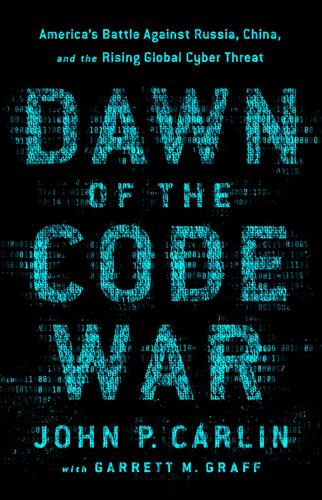
Dawn of the Code War: America's Battle Against Russia, China, and the Rising Global Cyber Threat
by
John P. Carlin
and
Garrett M. Graff
Published 15 Oct 2018
As a term, hacking derived from the good-natured pranks central to the culture of places like MIT, where students delighted in practical jokes and collegiate stunts such as surreptitiously placing an old Chevrolet, painted like an MIT police car, atop the school’s iconic Great Dome, or writing a computer program that calculated the most efficient way to travel over all of New York City’s subway system. The school even hosted a website, hacks.mit.edu, recounting its proud history of “good hacks.” By comparison, MIT labeled devious computer- or phone-related endeavors as “cracking.” As Steven Levy wrote in his 1984 book Hackers, which began to popularize the term, computer programmers and designers were “adventurers, visionaries, risk-takers, artists, and the ones who most clearly saw why the computer was a truly revolutionary tool.”9 Levy described a “Hacker Ethic” that held that “essential lessons can be learned about the systems—about the world—from taking things apart, seeing how they work, and using this knowledge to create new and even more interesting things.
…
In this new era, though, the software appeared just as improvised—sold on floppy discs packaged in Ziploc bags, with simplistic graphics and labels stuck on by hand.34 The definition of the term hacker morphed, too, as the internet grew large enough—and accrued enough users—that damaging it could cause real harm. In fact, when Steven Levy’s book Hackers was published in the early 1980s, it was written as an elegy to a lost time and generation, when free-minded thinkers and tinkerers dominated the computer landscape—before the buttoned-up bureaucrats seized control of the digital world. “It is painful for me to bring back the memories of this time,” said Richard Stallman in the book, the MIT hacker who had advocated for no passwords.
…
“Hello New York: Michael Fusco on Violent Crime in New York,” Saturday Night Live, NBC, www.nbc.com/saturday-night-live/video/leftover-night/n10009?snl=1. 8. John Perry Barlow, “A Declaration of the Independence of Cyberspace,” Electronic Frontier Foundation, n.d., www.eff.org/cyberspace-independence. 9. Steven Levy, Hackers: Heroes of the Computer Revolution (O’Reilly Media, 2010), ix. 10. Ibid., 27. 11. Ibid., 91–92. 12. Ibid., 134. 13. John Markoff, “The Odyssey of a Hacker: From Outlaw to Consultant,” New York Times, January 29, 2001, www.nytimes.com/2001/01/29/business/the-odyssey-of-a-hacker-from-outlaw-to-consultant.html. 14.
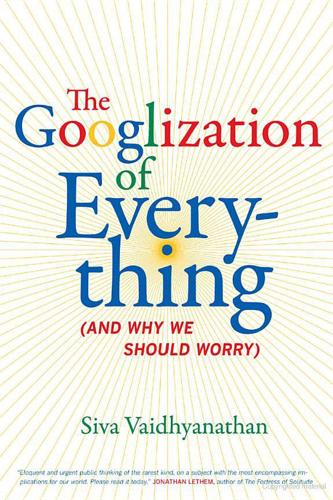
The Googlization of Everything:
by
Siva Vaidhyanathan
Published 1 Jan 2010
In the late 1990s, a search for “Asian” on almost any other search engine would have generated torrents of pornography featuring Asian models. Today, such a search on Google generates a first page of links devoted to Asian American history and culture and Asian foods. 5. Introduction to the Google Ad Auction, 2009, video online at www .youtube.com; Steven Levy, “Secret of Googlenomics: Data-Fueled Recipe Brews Profitability,” Wired, May 22, 2009; Search Advertising: Dr. Hal Varian, SIMS 141, course in the School of Information, University of California at Berkeley, 2007, video available at www.youtube.com; “Talking Business: Stuck in Google’s NOT ES TO PAGES 15 –18 223 Doghouse,” New York Times, September 13, 2008; “Big Brands?
…
Ogilvy, “Google in China: Government Censorship and Corporate Reputation,” Journal of Business Strategy 28, no. 3 (2007): 12–22. NOTES TO PAGES 130–35 243 34. Matt Looney and Evan Hansen, “Google Pulls Anti-scientology links,” CNET News, March 21, 2002, http://news.cnet.com. 35. Schrage, Testimony of Google Inc.; Steven Levy, “Google and the China Syndrome,” Newsweek, February 13, 2006, 14; “Here Be Dragons,” Economist, January 28, 2006, 59–60. 36. Nolan, The China Dilemma, 57. 37. Ibid. 38. Iris Hong, “Google Boosts China Revenues but Falls Back in Share of Searches,” Telecomasia.net, June 8, 2009, www.telecomasia.net. 39.
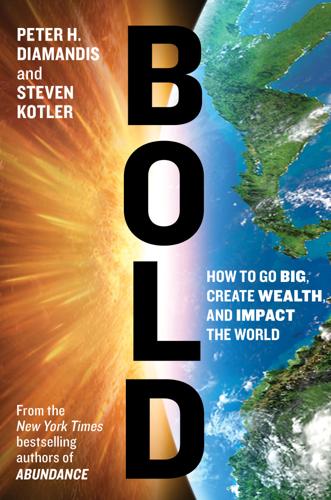
Bold: How to Go Big, Create Wealth and Impact the World
by
Peter H. Diamandis
and
Steven Kotler
Published 3 Feb 2015
They laughed at us and said it was impossible. But they were willing to try. . . . And now, six years later we can translate between sixty-four different languages. In many languages, we’re better than an average human translator and we can do it instantly and for free.”41 Or, to offer an even more colorful example, in a Steven Levy story for Wired, Astro Teller talked about wheeling an imaginary time machine into Page’s office, plugging it in, and then demonstrating that it works. “Instead of being bowled over,” says Teller, “Page asks why it needs a plug. Wouldn’t it be better if it didn’t use power at all? It’s not because he’s not excited about time machines or ungrateful that we built it.
…
v=9pmPa_KxsAM. 40 Joann Muller, “No Hands, No Feet: My Unnerving Ride in Google’s Driverless Car,” Forbes, March 21, 2013, http://www.forbes.com/sites/joannmuller/2013/03/21/no-hands-no-feet-my-unnerving-ride-in-googles-driverless-car/. 41 Robert Hof, “10 Breakthrough Technologies 2013: Deep Learning,” MIT Technology Review, April 23, 2013, http://www.technologyreview.com/featuredstory/513696/deep-learning/. 42 Steven Levy, “Google’s Larry Page on Why Moon Shots Matter,” Wired, January 17, 2013, http://www.wired.com/2013/01/ff-qa-larry-page/all/. 43 Larry Page, “Beyond Today—Larry Page—Zeitgeist 2012.” 44 Larry Page, “Google+: Calico Announcement,” Google+, September 2013, https://plus.google.com/+LarryPage/posts/Lh8SKC6sED1. 45 Harry McCracken and Lev Grossman, “Google vs.
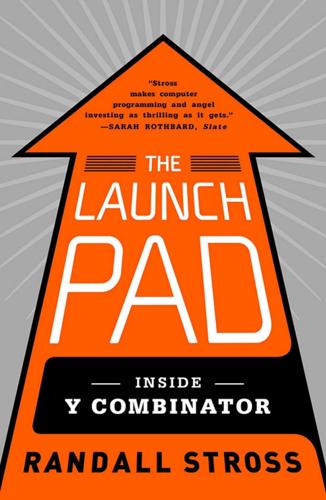
The Launch Pad: Inside Y Combinator, Silicon Valley's Most Exclusive School for Startups
by
Randall Stross
Published 4 Sep 2013
Carleen Hawn, “The F|R Interview: Y Combinator’s Paul Graham,” Gigaom, May 3, 2008, http://gigaom .com/2008/05/03/the-fr-interview-y-combinators-paul-graham/. 4. PG, “Great Hackers,” July 2004, www.paulgraham.com/gh.html. 5. PG, “The Word ‘Hacker,’ ” April 2004, http://paulgraham.com/gba.html. Steven Levy’s Hackers: Heroes of the Computer Revolution (Garden City, NY: Doubleday, 1984) extricates the word “hacker” from derogatory associations. To Levy, “hacker” simply means “those computer programmers and designers who regard computing as the most important thing in the world.” He traces the hacker culture back to the Tech Model Railroad Club at MIT in the late 1950s. 6.
…
HT, “What I Expected.” 14. HT, “Demo Day,” Meal Ticket blog, February 13, 2007, http://mealticket.wordpress.com/2007/02/13/demo-day/. 15. HT, “What I Expected.” 16. HT, “What I Expected.” 17. Patrick Collison, “Surprises,” Patrick Collison blog, October 18, 2009, http://collison.ie/blog/2009/10/surprises. 18. Steven Levy, “Taking the Millions Now,” Newsweek, April 5, 2008, www.newsweek.com/2008/04/05/taking-the-millions-now.html. 19. “Graduate Entrepreneurs Sell Business for Millions,” University of Oxford press release, May 7, 2008, www.ox.ac.uk/media/news_stories/2008/080507b.html. 20. HT, “Leaving Live Current and Vancouver,” HT blog, September 5, 2009, http://blog.harjtaggar.com/leaving-live-current-and-vancouver. 21.

An Ugly Truth: Inside Facebook's Battle for Domination
by
Sheera Frenkel
and
Cecilia Kang
Published 12 Jul 2021
Sulzberger’s kind notes on our coverage were always a welcome surprise in our inbox, and his enthusiasm for our tech coverage has been inspiring. This book also builds on the reporting of many other journalists who have tirelessly worked to shed light on the company. To name a few: Ryan Mac, Craig Silverman, Sarah Frier, Deepa Seetharaman, Casey Newton, Julia Angwin, Kara Swisher, David Kirkpatrick, Steven Levy, Jeff Horowitz, Lizza Dwoskin, Julia Carrie Wong, Brandy Zadrozny, and Ben Collins. Our readers—Kashmir Hill, Jessica Garrison, Kevin Roose, Natasha Singer, Scott Shane, and Brian Chen—were incredibly generous. They offered pages of feedback—from the most abstract and philosophical to specific challenges to reporting and our ideas.
…
“It was the first point where we had to look at the future”: Mark Zuckerberg’s August 16, 2016 interview with Sam Altman, “How to Build the Future,” can be viewed on YouTube. 15. he spent most of his time working on an idea: Stephen Levy, “Inside Mark Zuckerberg’s Lost Notebook,” Wired, February 12, 2020. 16. Zuckerberg imagined a personalized hierarchy of “interesting-ness”: Steven Levy, Facebook: The Inside Story (New York: Blue Rider Press, 2020). 17. But the morning brought angry users: Tracy Samantha Schmidt, “Inside the Backlash against Facebook,” Time, September 6, 2006. 18. “When we watched people use it”: UCTV’s “Mapping the Future of Networks with Facebook’s Chris Cox: The Atlantic Meets the Pacific,” October 8, 2012, can be viewed on YouTube. 19.
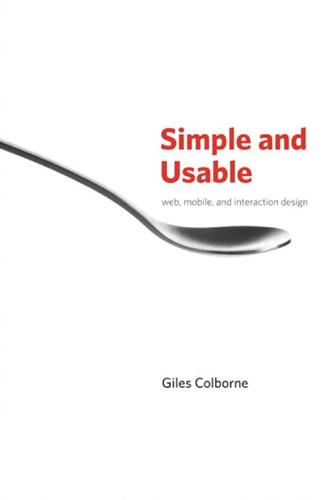
Simple and Usable Web, Mobile, and Interaction Design
by
Giles Colborne
Published 14 Sep 2010
That’s sort of the middle, and that’s where most people stop…. But the really great person will keep on going and find the key, the underlying principle of the problem—and come up with an elegant, really beautiful solution that works.” —Steve Jobs (quoted in Insanely Great: The Life and Times of Macintosh, the Computer that Changed Everything by Steven Levy) As Luke Wroblewski, former Chief Design Architect at Yahoo!, says, ”Your first design may seem like a solution, but it is usually just an early definition of the problem you are trying to solve.” In my experience, roughly the first third of any project is spent trying to figure out what’s really important.

Predictive Analytics: The Power to Predict Who Will Click, Buy, Lie, or Die
by
Eric Siegel
Published 19 Feb 2013
They “came up with a classifier” by working to “find a plane [in hyperspace] which says that most things on this side of the place are red, and most of the things on that side of the plane are the opposite of red.” This is descriptive and definitional of machine learning. Steven Levy, “TED 2011: The ‘Panda’ That Hates Farms: A Q&A with Google’s Top Search Engineers,” Steven Levy interview with Amit Singhal and Matt Cutts of Google, March 3, 2011. www.wired.com/business/2011/03/the-panda-that-hates-farms/all/. Aaron Wheeler, “How Google’s Panda Update Changed SEO Best Practices Forever—Whiteboard Friday,” Daily SEO blog, June 23, 2011. www.seomoz.org/blog/how-googles-panda-update-changed-seo-best-practices-forever-whiteboard-friday.
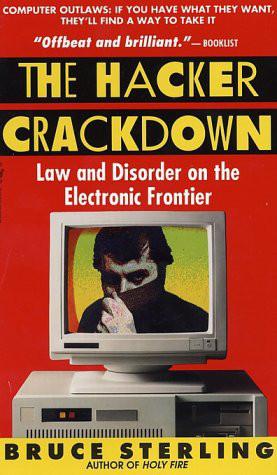
The Hacker Crackdown
by
Bruce Sterling
Published 15 Mar 1992
Hacking can describe the determination to make access to computers and information as free and open as possible. Hacking can involve the heartfelt conviction that beauty can be found in computers, that the fine aesthetic in a perfect program can liberate the mind and spirit. This is "hacking" as it was defined in Steven Levy's much-praised history of the pioneer computer milieu, Hackers, published in 1984. Hackers of all kinds are absolutely soaked through with heroic anti-bureaucratic sentiment. Hackers long for recognition as a praiseworthy cultural archetype, the postmodern electronic equivalent of the cowboy and mountain man.
…
Sixty people attended, myself included—in this instance, not so much as a journalist as a cyberpunk author. Many of the luminaries of the field took part: Kapor and Godwin as a matter of course. Richard Civille and Marc Rotenberg of CPSR. Jerry Berman of the ACLU. John Quarterman, author of The Matrix. Steven Levy, author of Hackers. George Perry and Sandy Weiss of Prodigy Services, there to network about the civil-liberties troubles their young commercial network was experiencing. Dr. Dorothy Denning. Cliff Figallo, manager of the Well. Steve Jackson was there, having finally found his ideal target audience, and so was Craig Neidorf, "Knight Lightning" himself, with his attorney, Sheldon Zenner.
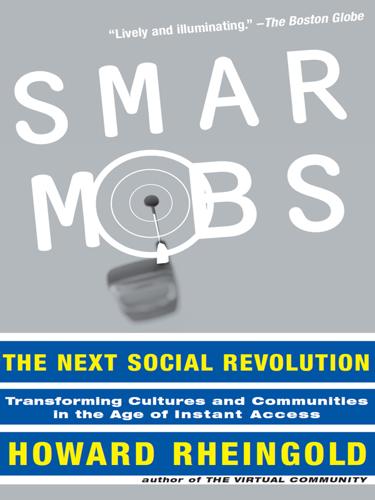
Smart Mobs: The Next Social Revolution
by
Howard Rheingold
Published 24 Dec 2011
Before the word “hacker” was misappropriated to describe people who break into computer systems, the term was coined (in the early 1960s) to describe people who create computer systems. The first people to call themselves hackers were loyal to an informal social contract called “the hacker ethic.” As Steven Levy described it, this ethic included these principles: Access to computers should be unlimited and total. Always yield to the Hands-On Imperative. All information should be free. Mistrust authority—promote decentralization.45 Without that ethic, there probably wouldn’t have been an Internet to commercialize.
…
Wilkinson, “Reciprocal Food Sharing in the Vampire Bat,” Nature 308 (March 8, 1984): 181184. 43. Manfred Milinski, “TIT FOR TAT in Sticklebacks and the Evolution of Cooperation,” Nature 325 (29 January 1987): 433435. 44. P. Farb, Man’s Rise to Civilization as Shown by the Indians of North America from Primeval Times to the Coming of the Industrial State (New York: Dutton, 1968). 45. Steven Levy, Hackers: Heroes of the Computer Revolution (New York: Doubleday, 1984). 46. J. H. Saltzer, D. P. Reed, and D. D. Clark, “End-to-End Arguments in System Design,” ACM Transactions on Computer Systems 2 (November 1984): 277288. 47. Howard Rheingold, Tools for Thought (Cambridge: MIT Press, 2000). 48.

Zucked: Waking Up to the Facebook Catastrophe
by
Roger McNamee
Published 1 Jan 2019
Fire in the Valley: The Making of the Personal Computer, by Paul Freiberger and Michael Swaine (Berkeley: Osborne/McGraw-Hill, 1984), is the best book I know on the early days of the personal computer industry, from computer clubs to the start of Microsoft and Apple, to the battle that followed. The revised edition, which bears a different subtitle, follows the industry into its declining years. Hackers: Heroes of the Computer Revolution, by Steven Levy (New York: Anchor Press/Doubleday, 1984), investigates a key subculture in Silicon Valley. Levy wrote this as it was happening, which makes the book particularly helpful, as in the case of The Facebook Effect. Cyberpunk: Outlaws and Hackers on the Computer Frontier, by Katie Hafner and John Markoff (New York: Simon & Schuster, 1991), picks up the story of Hackers and carries it forward
…
There is a very strong argument that the success of Amazon represents the greatest accomplishment of any startup since 1990. Bezos is amazing. His relatively low profile masks the pervasive influence of his company. Like The Facebook Effect, In the Plex: How Google Thinks, Works, and Shapes Our Lives, by Steven Levy (New York: Simon & Schuster, 2011), is exceptionally sympathetic to its subject. That is the price of getting access to a tech giant. As long as you remind yourself that Google adjusts search results based on what it perceives to be your interests and that YouTube’s algorithms promote conspiracy theories, you will get a great deal of value from this book.

Genius Makers: The Mavericks Who Brought A. I. To Google, Facebook, and the World
by
Cade Metz
Published 15 Mar 2021
Brockman vowed to build the new lab they all seemed to want: Cade Metz, “Inside OpenAI, Elon Musk’s Wild Plan to Set Artificial Intelligence Free,” Wired, April 27, 2016, https://www.wired.com/2016/04/openai-elon-musk-sam-altman-plan-to-set-artificial-intelligence-free/. nearly $2 million for the first year: OpenAI, form 990, 2016. Musk and Altman painted OpenAI as a counterweight: Steven Levy, “How Elon Musk and Y Combinator Plan to Stop Computers from Taking Over,” “Backchannel,” Wired, December 11, 2015, https://www.wired.com/2015/12/how-elon-musk-and-y-combinator-plan-to-stop-computers-from-taking-over/. backed by over a billion dollars in funding: Ibid. AI would be available to everyone: Ibid.
…
as a twenty-year-old college sophomore: Tad Friend, “Sam Altman’s Manifest Destiny,” New Yorker, October 3, 2016, https://www.newyorker.com/magazine/2016/10/10/sam-altmans-manifest-destiny. “Self-belief is immensely powerful”: Sam Altman blog, “How to Be Successful,” January 24, 2019, https://blog.samaltman.com/how-to-be-successful. “As time rolls on and we get closer to something”: Steven Levy, “How Elon Musk and Y Combinator Plan to Stop Computers from Taking Over,” Backchannel, Wired, December 11, 2015, https://www.wired.com/2015/12/how-elon-musk-and-y-combinator-plan-to-stop-computers-from-taking-over/. “It will just be open source and usable by everyone”: Ibid. he and his researchers released a new charter for the lab: “OpenAI Charter,” OpenAI blog, https://openai.com/charter/.

The Master Algorithm: How the Quest for the Ultimate Learning Machine Will Remake Our World
by
Pedro Domingos
Published 21 Sep 2015
“Spreadsheet data manipulation using examples,”* by Sumit Gulwani, William Harris, and Rishabh Singh (Communications of the ACM, 2012), is an example of how computers can program themselves by observing users. Competing on Analytics, by Tom Davenport and Jeanne Harris (HBS Press, 2007), is an introduction to the use of predictive analytics in business. In the Plex, by Steven Levy (Simon & Schuster, 2011), describes at a high level how Google’s technology works. Carl Shapiro and Hal Varian explain the network effect in Information Rules (HBS Press, 1999). Chris Anderson does the same for the long-tail phenomenon in The Long Tail (Hyperion, 2006). The transformation of science by data-intensive computing is surveyed in The Fourth Paradigm, edited by Tony Hey, Stewart Tansley, and Kristin Tolle (Microsoft Research, 2009).
…
The Birth of the Mind, by Gary Marcus (Basic Books, 2004), explains how evolution could give rise to the human brain’s complex abilities. Chapter Five “Evolutionary robotics,” by Josh Bongard (Communications of the ACM, 2013), surveys the work of Hod Lipson and others on evolving robots. Artificial Life, by Steven Levy (Vintage, 1993), gives a tour of the digital zoo, from computer-created animals in virtual worlds to genetic algorithms. Chapter 5 of Complexity, by Mitch Waldrop (Touchstone, 1992), tells the story of John Holland and the first few decades of research on genetic algorithms. Genetic Algorithms in Search, Optimization, and Machine Learning,* by David Goldberg (Addison-Wesley, 1989), is the standard introduction to genetic algorithms.
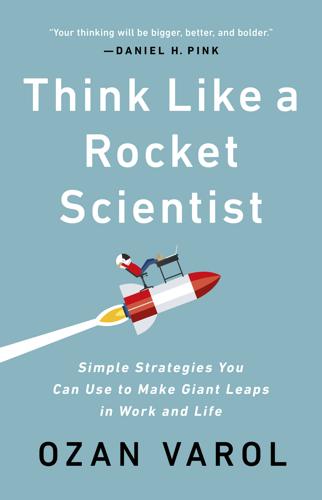
Think Like a Rocket Scientist: Simple Strategies You Can Use to Make Giant Leaps in Work and Life
by
Ozan Varol
Published 13 Apr 2020
c_id=137&objectid=10890750; “Google Tests Out Internet-Beaming Balloons in Skies Over New Zealand,” (San Francisco) SFist, June 16, 2013, http://sfist.com/2013/06/16/google_tests_out_internet-beaming_b.php; Derek Thompson, “Google X and the Science of Radical Creativity,” Atlantic, November 2017, www.theatlantic.com/magazine/archive/2017/11/x-google-moonshot-factory/540648/; Loon.com, “Loon: The Technology,” video, YouTube, uploaded June 14, 2013, www.youtube.com/watch?v=mcw6j-QWGMo&feature=youtu.be; Alex Davies, “Inside X, the Moonshot Factory Racing to Build the Next Google,” Wired, July 11, 2018, www.wired.com/story/alphabet-google-x-innovation-loon-wing-graduation; Steven Levy, “The Untold Story of Google’s Quest to Bring the Internet Everywhere—by Balloon,” Wired, August 13, 2013, www.wired.com/2013/08/googlex-project-loon. 2. Chris Anderson, “Mystery Object in Sky Captivates Locals,” Appalachian News-Express, October 19, 2012, www.news-expressky.com/news/article_f257128c-1979-11e2-a94e-0019bb2963f4.html. 3.
…
,” Forbes, August 8, 2017, www.forbes.com/sites/innovatorsdna/2017/08/08/how-does-amazon-stay-at-day-one/#36d005d67e4d. 45. Tim Ferriss, “Maria Sharapova,” episode 261 (transcript), Tim Ferriss Show, May 30, 2018, https://tim.blog/2018/05/30/tim-ferriss-show-transcript-maria-sharapova. 46. Elizabeth Gilbert, Big Magic: Creative Living Beyond Fear (New York: Riverhead Books, 2015), 259. 47. Steven Levy, “Google Glass 2.0 Is a Startling Second Act,” Wired, July 18, 2017, www.wired.com/story/google-glass-2-is-here. 48. Heather Hargreaves, “How Google Glass Will Change How You Do Business,” Entrepreneur Handbook, March 25, 2019. 49. Ian Osterloh, “How I Discovered Viagra,” Cosmos, April 27, 2015, https://cosmosmagazine.com/biology/how-i-discovered-viagra; Jacque Wilson, “Viagra: The Little Blue Pill That Could,” CNN, March 27, 2013, www.cnn.com/2013/03/27/health/viagra-anniversary-timeline/index.html. 50.

For Profit: A History of Corporations
by
William Magnuson
Published 8 Nov 2022
He stayed there for a mere two years, and, by all accounts, his time was marked by social awkwardness and loads of skipped classes. Reading through early interviews and articles about Zuckerberg, a single feature appears with almost comical frequency. At some point, after being asked a question, Zuckerberg would simply stare back at the interviewer, not answering, for minutes at a time. One author, Steven Levy, referred to these episodes as “trancelike silences.” Another described the look as an “intense stare that bordered on the psychopathic.” Another named it “the eye of Sauron.” “He will sit back and stare at people,” one early coworker said. Despite the awkwardness, though, by his sophomore year, Zuckerberg had become something of a celebrity on campus due to a series of popular but controversial programs he launched at the university.
…
John Cassidy, “Me Media,” New Yorker, May 14, 2006; Michael M. Grynbaum, “Mark E. Zuckerberg ’06: The Whiz Behind thefacebook.com,” Harvard Crimson, June 10, 2004. 4. Claire Hoffman, “The Battle for Facebook,” Rolling Stone, Sept. 15, 2010; S. F. Brickman, “Not-So-Artificial Intelligence,” Harvard Crimson, Oct. 23, 2003. 5. Steven Levy, Facebook: The Inside Story 13 (2020). 6. Interview with Mark Zuckerberg, “How to Build the Future,” Y Combinator, Aug. 16, 2016. 7. Katharine A. Kaplan, “Facemash Creator Survives Ad Board,” Harvard Crimson, Nov. 19, 2003. 8. Kaplan, “Facemash Creator Survives Ad Board”; Hoffman, “The Battle for Facebook.” 9.
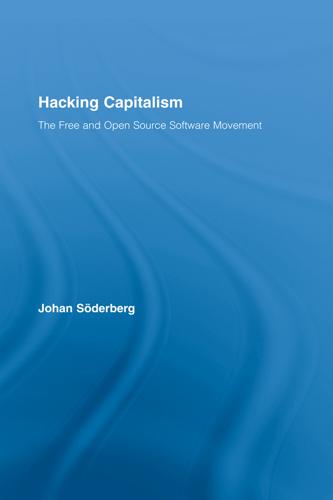
Hacking Capitalism
by
Söderberg, Johan; Söderberg, Johan;
A principal difference, though not the only one, is the motivational force behind hacking. The advocates of appropriate technology were led to experiment with Do-It-Yourself techniques as a deduction of their politics. Hackers, on the other hand, write code primarily for the sake of it, and politics flows from this playfulness. Steven Levy writes about the hardware hackers gathering at the Home-brew Computer Club in the mid 1970s. His retrospect gives an account of the two, partially coinciding, partially inconsistent, sentiments expressed by the people involved. They were drawn together by the excitement of tinkering with electronics.
…
One of the principles of Cudos is that scientific results ought to be freely shared among colleagues. 10. John Markoff, What the Dormouse Said: How the Sixties Counterculture Shaped the Personal Computer Industry (New York: Viking, 2005). 11. Langdon Winner, The Whale and the Reactor—A Search for Limits in an Age of High Technology (Chicago: The University of Chicago Press, 1986). 12. Steven Levy, Hackers—Heroes of the Computer Revolution (New York: Delta, 1994), 214. 13. Paul Ceruzzi, “Inventing Personal Computing”, in ed. Donald MacKenzie & Judy Wajcman, The Social Shaping of Technology, 2nd edition (Buckingham: Philadelphia, Pa: Open University Press 1999). 14. In the United States, the scope of copyright was originally limited to the protection of maps, charts, and books.

Chokepoint Capitalism
by
Rebecca Giblin
and
Cory Doctorow
Published 26 Sep 2022
It wasn’t until mid-2005 that Google Video even offered a way to play back its videos, and even then, clumsily, it required users to install separate software to do so.5 Google was eating YouTube’s dust. That’s not to say things were progressing entirely smoothly above the pizza shop. From the moment users began uploading videos, the founders were sweating under legal pressure from irate content companies demanding they do more to prevent copyright infringement. As journalist Steven Levy explains, however, they pressed on: “Even though YouTubers knew that people who were uploading videos didn’t really have the right to do so, they believed that YouTube would be all right as long as there weren’t complaints from copyright holders about specific videos, in which case they could respond.”6 This approach was backed by the US’s “safe harbor” law, which protects platforms from liability for hosting infringing content that is uploaded by users, so long as they move “expeditiously” to remove it once it comes to their attention.
…
Jean Burgess and Joshua Green, YouTube: Online Video and Participatory Culture, 2nd ed. (London: Polity, 2018), 2. 3. Burgess and Green, YouTube, 74. 4. Jefferson Graham, “Video Websites Pop Up, Invite Postings,” USA Today, Nov. 21, 2005, https://usatoday30.usatoday.com/tech/news/techinnovations/2005-11-21-video-websites_x.htm. 5. Steven Levy, In the Plex: How Google Thinks, Works, and Shapes Our Lives (New York: Simon & Schuster, 2011), 247. 6. Levy, In the Plex, 248. 7. 17 USC § 512; “Directive on Electronic Commerce,” 2000/31/EC, Official Journal L178, European Parliament and the Council of the European Union, June 8, 2020, Articles 12–14, https://eur-lex.europa.eu/legal-content/EN/TXT/HTML/?

The Power Law: Venture Capital and the Making of the New Future
by
Sebastian Mallaby
Published 1 Feb 2022
In sum, it is true that military dollars supported both university research and, via procurement spending, the growth of private businesses, but it is not clear that this factor explains why Silicon Valley emerged as America’s leading innovation hub. Indeed, Silicon Valley only overtook the Boston area in the late 1970s and 1980s—precisely when federal funding and military procurement became less important. BACK TO NOTE REFERENCE 5 Steven Levy, Hackers: Heroes of the Computer Revolution (Sebastopol, Calif.: O’Reilly Media, 2010), 14. BACK TO NOTE REFERENCE 6 Spencer E. Ante, Creative Capital: Georges Doriot and the Birth of Venture Capital (Boston: Harvard Business Press, 2008), 167. BACK TO NOTE REFERENCE 7 Another unpersuasive theory about Silicon Valley’s advantage emphasizes the weather.
…
BACK TO NOTE REFERENCE 7 Another unpersuasive theory about Silicon Valley’s advantage emphasizes the weather. Aside from the fact that the weather isn’t bad in Santa Barbara and Los Angeles, two university towns that were among the four original hubs for the Pentagon’s ARPANET, it isn’t quite clear that weather attracted engineering talent. In his classic history of early programmers, Steven Levy reports that luring engineers from MIT to San Francisco was “no small feat, since hackers were generally opposed to the requirements of California life, particularly driving and recreational exposure to the sun.” Levy, Hackers, 134. BACK TO NOTE REFERENCE 8 To be sure, some inventions did originate in the Valley: the microprocessor (Intel); the computer mouse (Xerox PARC); and so on.
…
,” Forbes, Oct. 4, 1999, forbes.com/1999/10/04/feat.html#10cf995a1652. BACK TO NOTE REFERENCE 34 Moritz recalled, “The understanding when we invested was that a CEO would, among others, be hired over time.” Moritz, author interviews. BACK TO NOTE REFERENCE 35 Steven Levy, In the Plex: How Google Thinks, Works, and Shapes Our Lives (New York: Simon & Schuster, 2011), 79–80. BACK TO NOTE REFERENCE 36 The lieutenant was Dave Whorton. See John Heilemann, “Journey to the (Revolutionary, Evil-Hating, Cash-Crazy, and Possibly Self-Destructive) Center of Google,” GQ, Feb. 14, 2005.
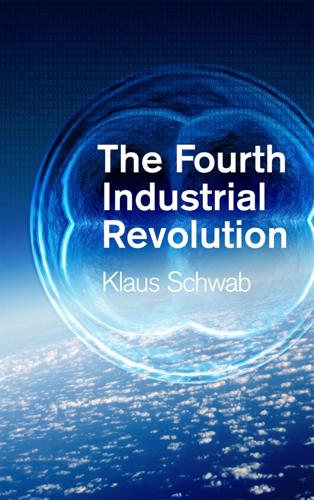
The Fourth Industrial Revolution
by
Klaus Schwab
Published 11 Jan 2016
http://www.independent.co.uk/news/science/stephen-hawking-transcendence-looks-at-the-implications-of-artificial-intelligence-but-are-we-taking-9313474.html 61 Greg Brockman, Ilya Sutskever & the OpenAI team, “Introducing OpenAI”, 11 December 2015 https://openai.com/blog/introducing-openai/ 62 Steven Levy, “How Elon Musk and Y Combinator Plan to Stop Computers From Taking Over”, 11 December 2015 https://medium.com/backchannel/how-elon-musk-and-y-combinator-plan-to-stop-computers-from-taking-over-17e0e27dd02a#.qjj55npcj 63 Sara Konrath, Edward O’Brien, and Courtney Hsing. “Changes in dispositional empathy in American college students over time: A meta-analysis.”

Hacker, Hoaxer, Whistleblower, Spy: The Story of Anonymous
by
Gabriella Coleman
Published 4 Nov 2014
They quickly distinguished their politics and ethics from the university hackers of MIT, Carnegie Mellon, and Stanford; these hackers, who in the 1960s stayed up all night to access their beloved computers otherwise tied up for official use during the day, were chronicled majestically by journalist Steven Levy.14 Though these early hackers also had an affinity for pranking, they abided by a a more robust ethos of transparency and access than underground hackers. Many underground hackers were puckish in their pranking and hacking pursuits. They were mischief-makers and merry wanderers of the network.
…
Many of these insights are delectably explored in Lewis Hyde’s majestic account Trickster Makes this World: Mischief, Myth, and Art (New York: Farrar, Straus and Giroux, 1998). 11. Ibid. p. 9 12. Alex Galloway and Eugene Thacker. The Exploit: A Theory of Networks (Minneapolis, MN: University of Minnesota Press, 2007). 13. Phil Lapsley, Exploding the Phone: The Untold Story of the Teenagers and Outlaws Who Hacked Ma Bell (New York: Grove Press, 2013), 226. 14. Steven, Levy, Hackers: Heroes of the Computer Revolution—25th Anniversary Edition (Sebastapol: CA O’Reilly Media, 2010). 15. Adam L. Penenberg, “A Private Little Cyberwar,” forbes.com, Feb. 21, 2000. 16. “Biography of u4ea,” soldierx.com, last accessed May 21, 2014, available at https://www.soldierx.com/hdb/u4ea. 17.
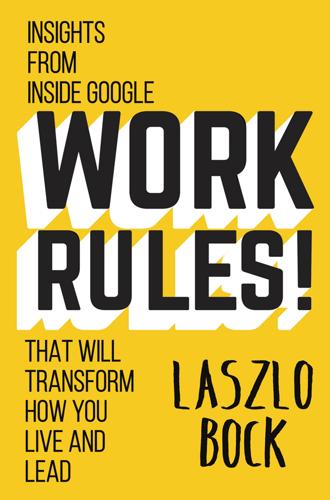
Work Rules!: Insights From Inside Google That Will Transform How You Live and Lead
by
Laszlo Bock
Published 31 Mar 2015
“I’d say this is something that followed me into adulthood.”21 Larry’s and Sergey’s ideas about how work could be were also informed by their early experiences at school. As Sergey has commented: “I do think I benefited from the Montessori education, which in some ways gives the students a lot more freedoms to do things at their own pace.” Marissa Mayer, at the time a Google vice president of product management and now CEO of Yahoo, told Steven Levy in his book In the Plex: “You can’t understand Google… unless you know that both Larry and Sergey were Montessori kids.”22 This teaching environment is tailored to a child’s learning needs and personality, and children are encouraged to question everything, act of their own volition, and create.
…
Adam Lashinsky, “Larry Page: Google should be like a family,” Fortune, January 19, 2012, http://fortune.com/2012/01/19/larry-page-google-should-be-like-a-family/. 20. Larry Page’s University of Michigan Commencement Address, http://googlepress.blogspot.com/2009/05/larry-pages-university-of-michigan.html. 21. Mark Malseed, “The Story of Sergey Brin,” Moment, February–March 2007, http://www.momentmag.com/the-story-of-sergey-brin/. 22. Steven Levy, In the Plex: How Google Thinks, Works, and Shapes Our Lives (New York: Simon & Schuster, 2011). 23. John Battelle, “The Birth of Google,” Wired, August 2005, http://www.wired.com/wired/archive/13.08/battelle.html. “Our History in Depth,” Google, http://www.google.com/about/company/history/. 24.

Machines of Loving Grace: The Quest for Common Ground Between Humans and Robots
by
John Markoff
Published 24 Aug 2015
Bloomfield, The Question of Artificial Intelligence: Philosophical and Sociological Perspectives, in Annals of the History of Computing 10, no. 3 (1998). 15.Ibid. 16.Nilsson, The Quest for Artificial Intelligence, 77. 17.AI@50, Dartmouth College Artificial Intelligence Conference, July 13–15, 2006. 18.Interview with John McCarthy, Stanford University, July 19, 2001. 19.Steven Levy, Hackers: Heroes of the Computer Revolution (New York: Anchor Press/Doubleday, 1984). 20.Interview with John McCarthy, Stanford University, July 19, 2001. 21.Raj Reddy, “Celebration of John McCarthy’s Accomplishments,” Stanford University, March 25, 2012, YouTube, https://www.youtube.com/watch?
…
.%20interface%20agents.pdf. 27.Ibid. 6|COLLABORATION 1.Rodney Brooks, Flesh and Machines: How Robots Will Change Us (New York: Pantheon, 2002), 28. 2.Ibid., 29. 3.Ibid., 31. 4.Rodney Brooks, “Elephants Don’t Play Chess,” Robotics and Autonomous Systems 6 (1990): 3–15, people.csail.mit.edu/brooks/papers/elephants.ps.Z. 5.Ibid. 6.Brooks, Flesh and Machines, 31. 7.Steven Levy, Hackers: Heroes of the Computer Revolution (New York: Anchor Press/Doubleday, 1984), 132. 8.R. H. MacMillan, Automation: Friend or Foe, (Cambridge, UK: Cambridge University Press, 1956), 1. 9.Levy, Hackers, 130. 10.Lee Felsenstein, “The Golemic Approach,” LeeFelsenstein.com, http://www.leefelsenstein.com/wp-content/uploads/2013/01/Golemic_Approach_MS.pdf. 11.Ibid., 4. 12.Evgeny Morozov, “Making It,” New Yorker, January 13, 2014, http://www.newyorker.com/arts/critics/atlarge/2014/01/13/140113crat_atlarge_morozov?

The Optimist: Sam Altman, OpenAI, and the Race to Invent the Future
by
Keach Hagey
Published 19 May 2025
CHAPTER 9“A RIDE ON A ROCKET” 1.Max Chafkin, The Contrarian: Peter Thiel and Silicon Valley’s Pursuit of Power (New York: Penguin Press, 2021), 170–72. 2.David Brooks, “The Creative Monopoly,” The New York Times, April 23, 2012. 3.Blake Masters, “CS183: Startup—Peter Thiel Class 1 Notes Essay,” April 3, 2012. 4.Blake Masters, “CS183: Startup—Peter Thiel Class 15 Notes Essay,” May 31, 2012. 5.Bruce Gibney, “What Happened to the Future,” Founders Fund website, updated January 2017. 6.Elizabeth Weil, “Sam Altman Is the Oppenheimer of Our Age,” New York, September 25, 2023. 7.Stross, The Launch Pad, 196. 8.Sophie Bearman, “OpenAI’s Sam Altman: The Human Behind the Machine,” Life in Seven Songs podcast, The San Francisco Standard, September 24, 2024. 9.Peter Thiel, “The New Atomic Age We Need,” The New York Times, November 27, 2015. 10.Kyle Russel, “Y Combinator and Mithril Invest in Helion, a Nuclear Fusion Startup,” TechCrunch, August 1, 2014. 11.David Perell, “I Interviewed the Man Behind ChatGPT: Sam Altman,” YouTube video, 21:24, uploaded November 27, 2024. 12.Stross, Launchpad, 28. 13.Steven Levy, “YC Has Gone Supernova,” Wired, June 28, 2017. 14.Nathaniel Rich, “Silicon Valley’s Start-up Machine,” The New York Times Magazine, May 2, 2013. 15.Eliezer S. Yudkowsky, “The Low Beyond,” 1996. 16.Ed Regis, “Meet the Extropians,” Wired, October 1, 1994. 17.Jon Evans, “Extropia’s Children, Chapter 1: The Wunderkind,” Gradient Ascent, October 17, 2022. 18.Sabine Atkins, “Introducing Another Atkins (was Re: just me),” ExI Mailing List, September 14, 2000. 19.LessWrong, “Rationalist Movement,” accessed November 29, 2024. 20.Eliezer Yudkowsky, “Coherent Extrapolated Volition,” The Singularity Institute, San Francisco, 2004. 21.
…
Accessed June 15, 2024. 2.Elon Musk, “OpenAI first ever to defeat world’s best players in competitive eSports. Vastly more complex than traditional board games like chess & Go,” Twitter, August 11, 2017. 3.Jordan Novet, “Amazon Lost Cloud Market Share to Microsoft in the Fourth Quarter: KeyBanc,” CNBC, January 12, 2018. 4.Ashley Stewart, “Bill Gates Never Left,” Business Insider, April 30, 2024. 5.Steven Levy, “What OpenAI Really Wants,” Wired, September 25, 2023. 6.Ilya Sutskever, Oriol Vinyals, Quoc V. Le, “Sequence to Sequence Learning with Neural Networks,” Neural Information Processing Systems (NIPS) conference, September 10, 2014. 7.Levy, “What OpenAI Really Wants.” 8.Richard Lea, “Google Swallows 11,000 Novels to Improve AI’s Conversation,” The Guardian, September 28, 2016. 9.Alec Radford, Karthic Narasimhan, Tim Alimans, Ilya Sutskever, “Improving Language Understanding by Generative Pre-Training,” OpenAI, 2018. 10.Elon Musk v.

From Airline Reservations to Sonic the Hedgehog: A History of the Software Industry
by
Martin Campbell-Kelly
Published 15 Jan 2003
See Thomas Kuhn, The Structure of Scientific Revolutions (University of Chicago Press, 1962); Thomas Parke Hughes, Networks of Power: Electrification in Western Society, 1880–1930 (Johns Hopkins University Press, 1983); Nathan Rosenberg, Inside the Black Box: Technology and Economics (Cambridge University Press, 1982). 26. Douglas K. Smith and R. C. Alexander, Fumbling the Future: How Xerox Invented, Then Ignored, the First Personal Computer (Morrow, 1988); Michael A. Hiltzik, Dealers of Lightning: Xerox PARC and the Dawn of the Computer Age (HarperBusiness, 1999). 27. Steven Levy, Insanely Great: The Life and Times of Macintosh, the Computer That Changed Everything (Penguin, 1994). 28. See, e.g., “A Fierce Battle Brews Over the Simplest Software Yet,” Business Week, November 21, 1983: 61–63. 29. Phil Lemmons, “A Guided Tour of VisiOn,” Byte, June 1983: 256ff. 30. Irene Fuerst, “Broken Windows,” Datamation, March 1, 1985: 46, 51–52. 31.
…
Enthusiasts have not done such a good job of recording the corporate and intellectual history of videogames, although there are some important exceptions. The best and most systematic historical account of the industry is Leonard Herman’s Phoenix: The Fall and Rise of Videogames (second edition: Rolenta, 1997). 3. Steven Levy, Hackers: Heroes of the Computer Revolution (Penguin, 1994). 4. Interview with Nolan Bushnell in Slater, Portraits in Silicon, pp. 296–307. 5. Scott Cohen, Zap! The Rise and Fall of Atari (McGraw-Hill, 1984), p. 30. 6. Watkins, Competitive Assessment of the US Video Game Industry, p. 7. 7. Cohen, Zap!
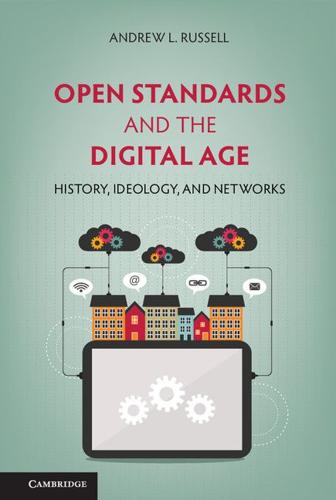
Open Standards and the Digital Age: History, Ideology, and Networks (Cambridge Studies in the Emergence of Global Enterprise)
by
Andrew L. Russell
Published 27 Apr 2014
In many ways, hackers were responding to the prevailing closed world discourse that was obsessed with geopolitical containment and driven by the military centralization of command and control. The hacker ideology of the 1960s had its roots in communities of programmers at MIT and in the San Francisco Bay area. According to Steven Levy’s account, East Coast hackers emphasized their technical fascination with computers (the Hands-On Imperative) and disdain for any gatekeepers that interfered; West Coast hackers tended to situate their tinkering within a broader countercultural critique of technology and authority in modern society.
…
Nelson, Sources of Industrial Leadership: Studies of Seven Industries (New York: Cambridge University Press, 1999), 79–132; Chandler, Inventing the Electronic Century, 94–106; Ceruzzi, A History of Modern Computing, 128–143, 161–173; Gerald W. Brock, The Second Information Revolution (Boston: Harvard University Press, 2003), 106–111. 29 Steven Levy, Hackers: Heroes of the Computer Revolution (New York: Doubleday, 1984); Edwards, Closed World; Atsushi Akera, “Voluntarism and the Fruits of Collaboration: The IBM User Group, Share,” Technology and Culture 42 (2001): 710–736; Fred Turner, From Counterculture to Cyberculture: Stewart Brand, the Whole Earth Network, and the Rise of Digital Utopianism (Chicago: University of Chicago Press, 2006); John Markoff, What the Dormouse Said: How the Sixties Counterculture Shaped the Personal Computer Industry (New York: Penguin, 2006); Ted Friedman, Electric Dreams: Computers in American Culture (New York: New York University Press, 2005); Steven W.
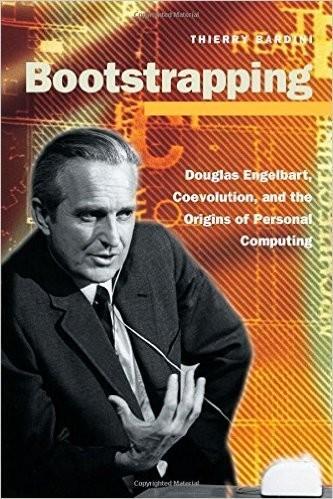
Bootstrapping: Douglas Engelbart, Coevolution, and the Origins of Personal Computing (Writing Science)
by
Thierry Bardini
Published 1 Dec 2000
There were two main ways to interface with NLS, through teletypes, for the purpose of com- munications over the ARPANET, and through display terminals or consoles in the "special device channel." The teletype terminal, a distant offspring of research in type printing for te- legraphy, had been the standard interface for time-sharing systems since the early 1960's. It was basically a typewriter transformed for telegraphy input and printing, accurately described by Steven Levy as "a typewriter converted 128 SRI and the oN-Line System for tank warfare, its bottom anchored In a military gray housing" (Levy 1984a, 28). As John McCarthy recollected: My first attempts to do something about time sharing was in the fall of 1957, when I came to the MIT Computation Center on a Sloan Foundation fellowship from Dartmouth College.
…
In the graphical user interface, signs do exhibit a "similarity" with the thing in the world that they represent: they are iconic previsualiza- tions of objects that they participate in creating in the world: papers, docu- ments, texts, pictures, and so on. 17 It is obvious from the start, therefore, that the graphical interface is iconic in essence, since with it, we move from an in- dexical manipulation to iconic visualization. As Steven Levy realized, and as Alan Kay very often commented, this tran- sition happened with the creation of an illusion. The virtual desktop was not a mere metaphor, since the user did not identify the false residual of the meta- phor. Instead, it was an effect produced by the craft of the designer in making the user believe that there is a correspondence between the icons that he or she moves and transforms on the screen and the referential paper objects that they represent.
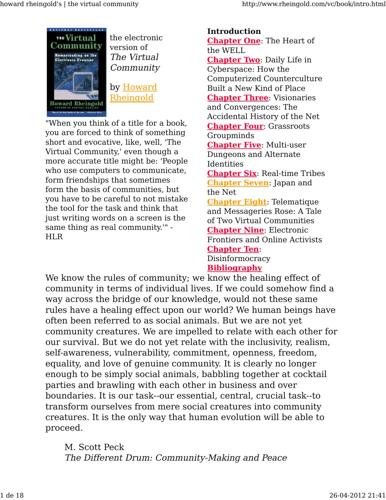
Howard Rheingold
by
The Virtual Community Homesteading on the Electronic Frontier-Perseus Books (1993)
Published 26 Apr 2012
They wanted to reinvent computing; the computer industry giants and the mainstream of computer science weren't interested in reinventing computing. So Licklider and his successors at ARPA, Robert Taylor and Ivan Sutherland (both in their twenties), started funding the young hackers--the original hackers, as chronicled in Steven Levy's book Hackers, not the ones who break into computer systems today. They also funded Engelbart, whose Augmentation Research Center (ARC) at Stanford Research Institute lasted for more than a decade and created the first word processors, conferencing systems, hypertext systems, mouse pointing devices, mixed video and computer communications--the technical foundation for half a dozen of the biggest high-tech industries today.
…
Baxter reported that he had been informed that the Hackers' Conference was an 26-04-2012 21:46 howard rheingold's | the virtual community 15 de 36 http://www.rheingold.com/vc/book/9.html underground organization of computer outlaws that was probably part of the same grand conspiracy as the NuPrometheus League. Hacker used to mean something different from what it means now. Steven Levy's 1984 book Hackers: Heroes of the Computer Revolution was about the unorthodox young programmers who created in the 1960s and 1970s the kind of computer technology that nonprogrammers used in the 1980s and 1990s. Although they kept odd hours and weren't fashion plates, and although they weren't averse to solving lock-picking puzzles, the original hackers were toolmakers, not burglars.

The Contrarian: Peter Thiel and Silicon Valley's Pursuit of Power
by
Max Chafkin
Published 14 Sep 2021
advocacy group Mijente: “Anduril’s New Border Surveillance Contract with the U.S. Marine Corps and CPB,” Mijente, July 24, 2019, https://mijente.net/2019/07/anduril/; “Palantir Played Key Role in Arresting Families for Deportation, Document Shows,” Mijente, May 2, 2019, https://mijente.net/2019/05/palantir-arresting-families/. advanced artificial intelligence: Steven Levy, “Inside Anduril, Palmer Luckey’s Bid to Build a Border Wall,” Wired, June 11, 2018, https://www.wired.com/story/palmer-luckey-anduril-border-wall/. posted the same message: Kari Paul, “Tech Workers Protest Data Mining Firm Palantir for Role in Immigrant Arrests,” The Guardian, May 13, 2019, https://www.theguardian.com/us-news/2019/may/13/tech-workers-palantir-immigration-protest-github.
…
landing the contract: Cade Metz et al., “What’s a Palantir? The Tech Industry’s Next Big I.P.O.,” The New York Times, August 26, 2020, https://www.nytimes.com/2020/08/26/technology/palantir-ipo.html. CHAPTER NINETEEN: TO THE MAT urged Zuckerberg to consider: Kirkpatrick, The Facebook Effect. early-morning board meeting: Steven Levy, Facebook: The Inside Story (New York: Blue Rider Press, 2020), 158. not long after the IPO: Michael Wolff, “The Facebook Fallacy,” MIT Technology Review, May 22, 2012, https://www.technologyreview.com/2012/05/22/255726/the-facebook-fallacy/. “we know what we’re doing”: Levy, Facebook, 293.

Apple in China: The Capture of the World's Greatest Company
by
Patrick McGee
Published 13 May 2025
Only a dozen multinationals: As calculated by The Economist: “Multinational Firms Are Finding it Hard to Let Go of China,” November 24, 2022. Chapter 1: The Brink of Bankruptcy sought bankruptcy counsel: Far as I can tell, this has never been reported. My sources are confidential and have direct knowledge. “death spiral”: Steven Levy, “Steve Jobs Unveils the iMac,” Newsweek, May 18, 1998, https://www.newsweek.com/steve-jobs-unveils-imac-169734. “out of money somewhere around May”: Gil Amelio and William L. Simon, On the Firing Line: My 500 Days at Apple. New York: HarperBusiness, 1998, 34. reserves had shrunk to $500 million: Michael Malone, Infinite Loop: How Apple, the World’s Most Insanely Great Computer Company, Went Insane.
…
in Japan and stopped by Toshiba: Jon Rubinstein, “Oral History of Jon Rubinstein,” interviewed by Dag Spicer, Computer History Museum, August 15, 2019, https://archive.computerhistory.org/resources/access/text/2020/02/102717908-05-01-acc.pdf; Isaacson, Steve Jobs, 503–12. tied up on other projects: Kahney, Jony Ive, 172–75. “In jail”: Steven Levy, “The Perfect Thing,” Wired, November 1, 2006, https://www.wired.com/2006/11/ipod/. He proposed “Pod”: A version of Chieco’s story was also published here: Leander Kahney, “Straight Dope on the iPod’s Birth,” Wired, October 17, 2006, https://www.wired.com/2006/10/straight-dope-on-the-ipods-birth/.

The People vs Tech: How the Internet Is Killing Democracy (And How We Save It)
by
Jamie Bartlett
Published 4 Apr 2018
One journalist in Guatemala said 66 per cent of their traffic disappeared overnight. Similarly, Google tweaked its algorithm to make sure – so it said – that fake news fell down its ranking. It clobbered Alternet, a site dedicated to fighting white supremacy – their traffic collapsed, falling by 40 per cent almost overnight. 17 Steven Levy, ‘Mark Zuckerberg on Facebook’s Future, From Virtual Reality to Anonymity’, Wired, 30 April 2014. 18 Andrew Wilson, ‘The Ideas Industry’, www.thinktheology.co.uk, 16 August 2017. 19 This is all available from the website http://googletransparencyproject.org. While there are doubtless instances where collaboration and funding from the private sector benefits academics, institutions and students, according to the Google Transparency Project, of 330 studies about policy issues directly relevant to Google’s operations and revenue – subjects like anti-trust, privacy and data security, net neutrality, copyright – 54 per cent were either partly funded by, or affiliated with academics or institutions funded by Google.

Collaborative Society
by
Dariusz Jemielniak
and
Aleksandra Przegalinska
Published 18 Feb 2020
“Hacking a win is a question of principle,” Virginia Heffernan wrote in Wired in January 2018. When hacking is all about outsmarting the system and finding its flaws, it does not necessarily correspond with something that society would perceive as a greater good. As P. S. Ryan explained it, summarizing the preface of Steven Levy’s 1984 book Hackers, the general tenets or principles of hacker ethic include sharing, openness, decentralization, free access to computers, and world improvement, but especially the upholding of democracy and the fundamental laws most live by as a society.55 Moreover, these rules frequently incorporate unlimited and full access to computers, and to anything that might teach us how the world works.56 Thus, perhaps the most promising way of thinking about the future of hacktivism is to picture it as a sandbox of possibilities that retains freedom and a desired degree of online anonymity, supplemented by the ethos of openness and voluntary cooperation for a good cause.

The Psychology of Money: Timeless Lessons on Wealth, Greed, and Happiness
by
Morgan Housel
Published 7 Sep 2020
Few would have said “30 million times larger within my lifetime.” But that’s what happened. The counterintuitive nature of compounding leads even the smartest of us to overlook its power. In 2004 Bill Gates criticized the new Gmail, wondering why anyone would need a gigabyte of storage. Author Steven Levy wrote, “Despite his currency with cutting-edge technologies, his mentality was anchored in the old paradigm of storage being a commodity that must be conserved.” You never get accustomed to how quickly things can grow. The danger here is that when compounding isn’t intuitive we often ignore its potential and focus on solving problems through other means.
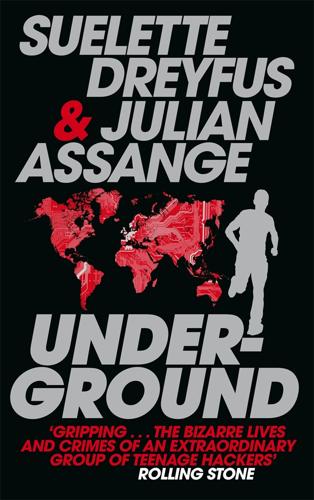
Underground
by
Suelette Dreyfus
Published 1 Jan 2011
It was basically impossible to learn about computer security unless you broke into secret security mailing list repositories to read what the system administrators – the keepers of all power in the early internet – were doing behind the scenes to secure their machines. Underground, along with Bruce Sterling’s The Hacker Crackdown and Steven Levy’s Hackers, shine a light onto this now lost world. The project called on a network of good people around the world who decided to let us in. These were not just hackers but others, people who were just willing to share resources because they wanted a good story, told well, for history’s sake. The critics have been kind to Underground; I hope it’s because it has delivered that.
…
He had already developed a fascination for computers, having received the simplest of machines, a Sinclair ZX81 with 1 k of memory, as a birthday present from his parents. Rummaging through outdoor markets, he found a few second-hand books on hacking. He read Out of the Inner Circle by Bill Landreth, and Hackers by Steven Levy. By the time he was fourteen, Anthrax had joined a Melbourne-based group of boys called The Force. The members swapped Commodore 64 and Amiga games. They also wrote their own demos – short computer programs – and delighted in cracking the copy protections on the games and then trading them with other crackers around the world.

Computer: A History of the Information Machine
by
Martin Campbell-Kelly
and
Nathan Ensmenger
Published 29 Jul 2013
Thierry Bardini’s Bootstrapping: Douglas Engelbart, Coevolution, and the Origins of Personal Computing (2000) does justice to a once-unsung hero of the personal-computer revolution. Books focusing on the Macintosh development include John Sculley’s insider account Odyssey: Pepsi to Apple (1987) and Steven Levy’s external view Insanely Great (1994). A selection of business histories of Microsoft (all of which discuss the Windows operating system) was listed in the notes to Chapter 10. We found the most thoughtful account of Microsoft’s forays into CD-ROM publishing and consumer networks to be Randall Stross’s The Microsoft Way (1996).
…
The early days are chronicled in Robert Reid’s Architects of the Web: 1,000 Days That Built the Future of Business (1997), while the crash is recounted in John Cassidy’s Dot.con (2003). As individual enterprises rise to prominence, business histories of them soon appear. We found useful Robert Spector’s Amazon.com: Get Big Fast (2000) and Karen Angel’s Inside Yahoo! (2001). The most significant work on Google to date is Steven Levy’s Into the Plex: How Google Works and Shapes Our Lives (2011). While highly celebratory, Andrew Lih’s The Wikipedia Revolution: How a Bunch of Nobodies Created the World’s Greatest Encyclopedia (2009) is nevertheless useful. Social networking discussion draws in part from David Kirkpatrick’s study of Facebook, The Facebook Effect: The Inside Story of the Company That Is Connecting the World (2010).

The Content Trap: A Strategist's Guide to Digital Change
by
Bharat Anand
Published 17 Oct 2016
Information in this section draws on Bharat Anand and Peter Olson, “The Random House Response to the Kindle,” HBS No. 709-486 (Boston: Harvard Business Publishing, February 27, 2009); Peter Olson and Bharat Anand, “The Kindle: Igniting the Book Business,” Book Business 12, no. 4 (June 2009): 26–28. Disclosure: I taught a paid executive education program for senior executives at Penguin Random House in 2013 and 2015. “Reinventing the Book” Steven Levy, “Amazon: Reinventing the Book,” Newsweek , November 17, 2007. “If it’s allowed to take hold” Ken Auletta, “Publish or Perish: Can the iPad Topple the Kindle, and Save the Book Business?,” New Yorker, April 26, 2010. the top ten CEOs of the past decade “The Entrepreneurs of the Decade: 2000 to 2009,” Inc ., December 2009.
…
the numbers hadn’t increased much “Apple’s iTunes Store Passes 35 Billion Songs Sold Milestone,” MacDailyNews, May 29, 2014, accessed March 30, 2016; http://mac -dailynews.com/2014/05/29/apples-itunes-store-passes-35-billion-songs-sold-milestone-itunes-radio-now-has-40-million-listeners/ . “If anything can play on anything” John Markoff, “Jobs Calls for End to Music Copy Protection,” New York Times . A tire manufacturer I owe this example to Felix Oberholzer-Gee. “This isn’t a device, it’s a service” Jeff Bezos quoted in Steven Levy, “Amazon: Reinventing the Book,” Newsweek . In 2009 Tata Motors Information about Tata Nano here and elsewhere in the book is drawn primarily from Krishna Palepu, Bharat Anand, et al., “Tata Nano—The People’s Car,” HBS No. 710-420 (Boston: Harvard Business Publishing, rev. March 28, 2011), and public sources where listed.

Data and Goliath: The Hidden Battles to Collect Your Data and Control Your World
by
Bruce Schneier
Published 2 Mar 2015
in 2012, it banned them from user-to-user: eBay (2 Oct 2012), “Sellers: E-mail addresses and some URLs no longer allowed in member-to-member messages,” http://announcements.ebay.com/2012/10/sellers-e-mail-addresses-and-some-urls-no-longer-allowed-in-member-to-member-messages. Websites that profit from advertising: Steven Levy (22 Apr 2014), “Inside the science that delivers your scary-smart Facebook and Twitter feeds,” Wired, http://www.wired.com/2014/04/perfect-facebook-feed. sites that allow you to opt out: Nate Anderson (24 Jul 2008), “.06% opt out: NebuAd hides link in 5,000-word privacy policy,” Ars Technica, http://arstechnica.com/uncategorized/2008/07/06-opt-out-nebuad-hides-link-in-5000-word-privacy-policy.
…
Hoffman et al. (10 Jun 1999), “Growing development of foreign encryption products in the face of U.S. export regulations,” Report GWU-CPI-1999-02, Cyberspace Policy Institute, George Washington University School of Engineering and Applied Science, http://cryptome.org/cpi-survey.htm. the crypto wars: This is a good account of those times. Steven Levy (May 1993), “Crypto rebels,” Wired, http://archive.wired.com/wired/archive/1.02/crypto.rebels_pr.html. NSA surveillance is costing: These three aspects were discussed in this document. Danielle Kehl et al. (29 Jul 2014), “Surveillance costs: The NSA’s impact on the economy, Internet freedom and cyberspace,” Open Technology Institute, New America Foundation, http://www.newamerica.net/publications/policy/surveillance_costs_the_nsas_impact_on_the_economy_internet_freedom_cybersecurity.

Becoming Steve Jobs: The Evolution of a Reckless Upstart Into a Visionary Leader
by
Brent Schlender
and
Rick Tetzeli
Published 24 Mar 2015
I believe that we pay taxes, and that the city then gives us services.” Over the last few months, a steady flow of visitors came by the house in Palo Alto. Bill Clinton came to visit, as did President Obama, for dinner with a select group of Silicon Valley leaders. John Markoff, of the New York Times, and Steven Levy, who had written several books about Silicon Valley, including ones about the development of the Macintosh and the iPod, dropped by together to pay their respects. Bill Gates wound up spending four hours with Steve one afternoon. “Steve and I will always get more credit than we deserve, because otherwise the story’s too complicated,” Gates says.
…
We also relied on passages from the following books: Gates, by Stephen Manes and Paul Andrews; Odyssey: Pepsi to Apple, A Journey of Adventure, Ideas, and the Future, by John Sculley; The Bite in the Apple: A Memoir of My Life with Steve Jobs, by Chrisann Brennan; Apple Confidential 2.0: The Definitive History of the World’s Most Colorful Company, by Owen W. Linzmayer; Dealers of Lightning: Xerox PARC and the Dawn of the Computer Age, by Michael A. Hiltzik; and Insanely Great: The Life and Times of Macintosh, the Computer That Changed Everything, by Steven Levy; as well as Moritz’s The Little Kingdom, and Wozniak and Smith’s iWoz. Other journalistic sources included “The Fall of Steve” by Bro Uttal, published in Fortune on August 5, 1985; and the PBS television documentary The Entrepreneurs, broadcast in 1986. The Golden Gate Weather website, http://ggweather.com/sjc/daily_records.html#September, provided the precise weather data for the day of Jobs’s visit to the Garden of Allah.
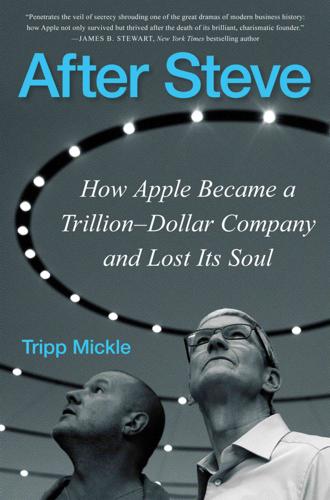
After Steve: How Apple Became a Trillion-Dollar Company and Lost Its Soul
by
Tripp Mickle
Published 2 May 2022
Desperately in need of a boost: Interview with then Apple design chief Robert Brunner; interviews with Tangerine’s Clive Grinyer, Peter Phillips, and Martin Darbyshire; interview with Steve Bailey; Burrows, “Who Is Jonathan Ive?”; Parker, “The Shape of Things to Come.” Chapter 3: The Operator On some days, Cook: Steven Levy, “An Oral History of Apple’s Infinite Loop,” Wired, September 16, 2018, https://www.wired.com/story/apple-infinite-loop-oral-history/. Tim Cook grew up wanting: Violla Young, “Tim Cook (CEO of Apple) Interview in Oxford,” YouTube, July 18, 2018, https://www.youtube.com/watch?v=QPQ8qQP4zdk: “I saw my dad go to work and not love what he did.
…
Much of the credit: Jon Rubinstein, Ive’s manager, led the development of the iMac, making the critical choices of the components and firmware that powered the machine. In his home country: John Ezard, “iMac Designer Who ‘Touched Millions’ Wins £25,000 Award,” Guardian, June 3, 2003. Over the next three weeks: Kahney, Jony Ive; interview with Doug Satzger. In most places that decision: Isaacson, Steve Jobs. In early 2001, Jobs moved: Steven Levy, “An Oral History of Apple’s Infinite Loop,” Wired, September, 16, 2018, https://www.wired.com/story/apple-infinite-loop-oral-history. “Jony and I think up”: Isaacson, Steve Jobs, 342. a Bang & Olufsen phone: Austin Carr, “Apple’s Inspiration for the iPod? Bang & Olufsen, Not Braun,” Fast Company, November 6, 2013, https://www.fastcompany.com/3016910/apples-inspiration-for-the-ipod-bang-olufsen-not-dieter-rams.

The Stack: On Software and Sovereignty
by
Benjamin H. Bratton
Published 19 Feb 2016
Woodruff, “Applications of the Shannon-Hartley Theorem to Data Streams and Sparse Recovery,” 2012, retrieved from IBM Watson researcher site May 8, 2015, http://researcher.watson.ibm.com/researcher/files/us-dpwoodru/pw12.pdf. 29. For the OptIPuter project, for example, each major component could be on a different continent, but they all work together as if it were a single self-contained machine. See http://www.optiputer.net/. 30. See, for example, Steven Levy, “Going with the Flow: Google's Secret Switch to the Next Wave of Networking,” Wired, April 17, 2012, http://www.wired.com/2012/04/going-with-the-flow-google/ and James C. Corbett, Jeffrey Dean, Michael Epstein, Andrew Fikes, Christopher Frost, JJ Furman, Sanjay Ghemawat, Andrey Gubarev, Christopher Heiser, Peter Hochschild, Wilson Hsieh, Sebastian Kanthak, Eugene Kogan, Hongyi Li, Alexander Lloyd, Sergey Melnik, David Mwaura, David Nagle, Sean Quinlan, Rajesh Rao, Lindsay Rolig, Yasushi Saito, Michal Szymaniak, Christopher Taylor, Ruth Wang, and Dale Woodford, “Spanner: Google's Globally-Distributed Database,” technical paper, October 2012, http://static.googleusercontent.com/media/research.google.com/en/us/archive/spanner-osdi2012.pdf. 31.
…
Sebastian Thrun, “Google's Driverless Car,” TED, March 2011, http://www.ted.com/talks/sebastian_thrun_google_s_driverless_car. The relative “autonomy” of the car from the driver is a gradient. The design problem is not one of full autonomy of the car replacing full autonomy of the driver, but of varying degrees of cyborgization, drawing on those with which car culture is already comfortable. 56. Steven Levy, In the Plex: How Google Thinks, Works, and Shapes Our Lives (New York: Simon & Schuster, 2011). 57. For those who honestly don't know, the Google driverless car project is a research initiative to develop cars that can autonomously navigate all roads without human steerage (or much of it), using a combination of laser-guided mapping, video cameras, radar, motion sensors, on-board computing, and other tools.
…
Such a system doesn't need independent taxi drivers, because the system knows where the quickest routes are and what streets are blocked, and can set an ideal route from the outset. The system knows all the conditions and can institute a more sophisticated set of rules that determines how the taxis proceed, and even figure whether some taxis should stay in their garages while fire trucks pass.” Steven Levy, “Going with the Flow: Google's Secret Switch to the Next Wave of Networking,” Wired.com, April 15, 2012, http://www.wired.com/2012/04/going-with-the-flow-google/all/. 59. John Thackara, “Lightness,” in In the Bubble: Designing in a Complex World (Cambridge, MA: MIT Press, 2005), 18–19: “Power tools are another example.
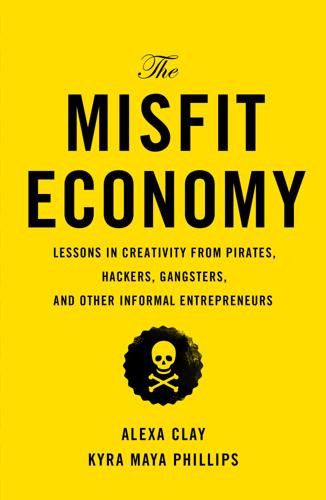
The Misfit Economy: Lessons in Creativity From Pirates, Hackers, Gangsters and Other Informal Entrepreneurs
by
Alexa Clay
and
Kyra Maya Phillips
Published 23 Jun 2015
Today Sam Roberts is working with his brother Oliver on 4G mobile telecommunication network deployments throughout Europe, and continuing to embrace the hacker imperative: the driving need to understand how systems work and then put them back together in enhanced forms. THE HACKER MOVEMENT In his book Hackers, Steven Levy chronicles the birth and development of the hacker movement. He starts with the first iteration of hackers: the group who coalesced during the early 1960s, when the Massachusetts Institute of Technology (MIT) acquired its first programmable computer. This cohort’s obsessive programming of the machines, and the relationship they built with the systems, gave rise to the Hacker Ethic, an informal, organically developed and agreed-upon manifesto that, in several iterations, still drives the hacker movement forward: • Access to computers—and anything that might teach you something about the way the world works—should be unlimited and total

Age of Context: Mobile, Sensors, Data and the Future of Privacy
by
Robert Scoble
and
Shel Israel
Published 4 Sep 2013
However, if after you returned you were looking up the name of the wonderful little shop you discovered up-island, you might see the same offer. In the former situation the ad is relevant; in the latter it’s worthless. Sometimes such ads are beneath worthless; they are downright tasteless. When tech author and journalist Steven Levy tweeted that a plane had crashed at San Francisco International Airport in June 2013, he reported that an Expedia ad suddenly appeared “urging me to fly somewhere on vacation.” Such gaffes are far from uncommon and often leave a long-lasting negative impression on the very people they are trying to attract.
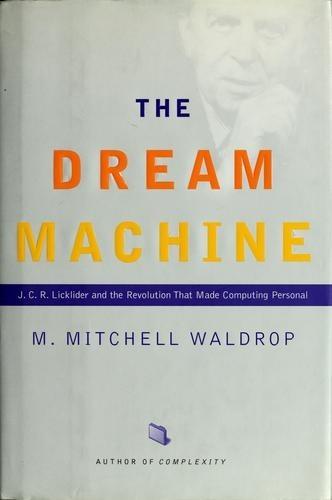
The Dream Machine: J.C.R. Licklider and the Revolution That Made Computing Personal
by
M. Mitchell Waldrop
Published 14 Apr 2001
But it just so happened that among the students in their class were several members of the Tech Model Railroad Club, a band of techno-geek undergradu- ates who spent their free time creating ever more elaborate train layouts con- trolled by ever more intricate electrical switching networks, the more ingenious the better. Borrowing an ancient MIT slang word for a practical joke, the railroad club's members had taken to calling any particularly clever bit of controller de- sign a hack. And as the writer Steven Levy described in 1984, the hackers in McCarthy and Rochester's course soon got so caught up in the fiendishly intri- cate joys of programming that they started hanging around the Computation Center till all hours, the better to gain access to the 704. There they were discov- ered one day by former railroad-club member Jack Dennis, now the staffer in charge of the TX-O, who asked them if they would like to come upstairs and see that machine.
…
Anyone can walk into anybody else's office, and a gentleman doesn't read anybody else's mail."24 But to the hackers-that fiendishly clever band of obsessives who had learned to program one-on-one at the TX-O and the PDP-1, and who had now found a haven on the ninth floor of Tech Square, in Marvin Minsky's AI Lab-passwords were anathema. As Steven Levy noted in his 1984 book, Hackers, "to the hackers, passwords were even more odious than locked doors. What could be worse than someone telling you that you weren't authorized to use his computer?" The whole thing was so . . . corporate, like hav- ing to wear a nametag and sign in with a guard in the lobby.
…
Taylor, Digital Systems Research Center Reports, vol. 61 (Palo Alto, Calif., 1990). 32. LICklIder, "Interactive Information Processing." 33. J. C. R. LicklIder, "The System System," In Human Factors In Technology, ed. E. Bennett, J. Degan, and J. Spiegel (New York: McGraw-Hill, 1963), 627-28. 34. Steven Levy, Hackers: Heroes of the Computer Revolution (Garden City, N.Y.: Anchor Press/Double- day, 1984), 28-29. 35. Ibid., 47. 36. Olsen, NMAH oral history. 37. Ibid. 38. QIoted In Clark, "The LINC Was Early and Small," 368. 39. "The Project MAC Interviews," 42. 40. "The CTSS Interviews," 44, 46. 41. Ibid., 42. 42.

The Internet of Us: Knowing More and Understanding Less in the Age of Big Data
by
Michael P. Lynch
Published 21 Mar 2016
While neuromedia is currently still in the realm of science fiction, it may not be as far off as you think.1 The migration of technology into our bodies—the cyborging of the human—is no longer just fantasy.2 And it shouldn’t surprise anyone that the possibilities are not lost on companies such as Google: “When you think about something and don’t really know much about it, you will automatically get information,” Google CEO Larry Page is quoted as saying in Steven Levy’s recent book In the Plex. “Eventually you’ll have an implant, where if you think about a fact, it will just tell you the answer.”3 This possibility raises some disquieting questions about society, identity and the mind. But as Larry Page’s remark suggests, the deeper question is about information and knowledge itself.
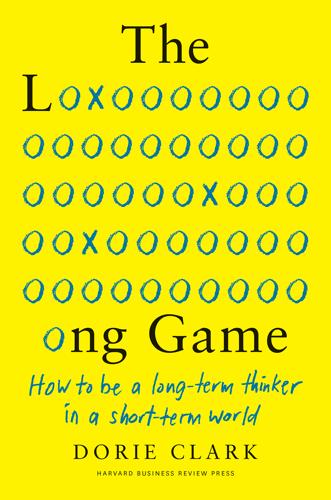
Long Game: How Long-Term Thinker Shorthb
by
Dorie Clark
Published 14 Oct 2021
Maria Konnikova, “The Struggles of a Psychologist Studying Self-Control,” The New Yorker, October 9, 2014. 3. BJ Fogg, “Start Tiny,” Tinyhabits.com, accessed March 9, 2021. 4. Jeff Bezos, “2017 Letter to Shareholders,” About Amazon. Amazon, April 18, 2018, https://www.aboutamazon.com/news/company-news/2017-letter-to-shareholders. 5. Steven Levy, “Jeff Bezos Owns the Web in More Ways Than You Think,” Wired, November 13, 2011, https://static.longnow.org/media/djlongnow_media/press/pdf/020111113-Levy-JeffBezosOwnstheWebinMoreWaysThanYouThink.pdf. Index accomplishments, savoring, 203–205 adaptability, 200–201. See also choices long-term thinking and, 5–6 advisers, 128, 129–154, 167, 170–171.

Why Liberalism Failed
by
Patrick J. Deneen
Published 9 Jan 2018
For a fuller discussion of this history, see Anthony Kronman, Education’s End: Why Our Colleges and Universities Have Given Up on the Meaning of Life (New Haven: Yale University Press, 2006), especially chapters 3–4. 6. A locus classicus that wed radical feminism with optimistic belief in technology’s ability to alter human nature remains Shulamith Firestone, The Dialectic of Sex (New York: Morrow, 1970). 7. Steven Levy, “GU NAACP President Discusses Diversity Issues,” Hoya, October 19, 2010. “I feel [that] money and the lack of it, as well as the lack of opportunity to participate in our consumerist, capitalist society and economy, proves difficult. For many minorities, they find that they’re not located on the same playing field as the rest of the nation.” http://www.thehoya.com/gu-naacp-president-discusses-diversity-issues/#.

The Code Breaker: Jennifer Doudna, Gene Editing, and the Future of the Human Race
by
Walter Isaacson
Published 9 Mar 2021
Because of its small size and highly specific targeting capability, the Cas13d that Hsu discovered was chosen by Qi as the best enzyme to target the coronavirus in human lung cells. In the competition to come up with good acronyms, Qi scored high. He dubbed his system PAC-MAN, which he had extracted from “prophylactic antiviral CRISPR in human cells.” The name was that of the chomping character in the once popular video game. “I like video games,” Qi told Wired’s Steven Levy. “The Pac-Man tries to eat cookies, and it is chased by a ghost. But when it encounters a specific kind of cookie called the power cookie—in our case a CRISPR-Cas13 design—suddenly it turns itself to be so powerful. It can start eating the ghost and start cleaning up the whole battlefield.”15 Qi and his team tested PAC-MAN on synthesized fragments of the coronavirus.
…
Jon Arizti-Sanz, Catherine Freije… Pardis Sabeti, and Cameron Myhrvold, “Integrated Sample Inactivation, Amplification, and Cas13-Based Detection of SARS-CoV-2,” bioRxiv, May 28, 2020. 13. Author’s interviews with Stanley Qi. 14. Silvana Konermann… and Patrick Hsu, “Transcriptome Engineering with RNA-Targeting Type VI-D CRISPR Effectors,” Cell, Mar. 15, 2018. 15. Steven Levy, “Could CRISPR Be Humanity’s Next Virus Killer?,” Wired, Mar. 10, 2020. 16. Timothy Abbott… and Lei [Stanley] Qi, “Development of CRISPR as a Prophylactic Strategy to Combat Novel Coronavirus and Influenza,” bioRxiv, Mar. 14, 2020. 17. Author’s interview with Stanley Qi. 18. IGI weekly Zoom meeting, Mar. 22, 2020; author’s interviews with Stanley Qi and Jennifer Doudna. 19.

Data-Ism: The Revolution Transforming Decision Making, Consumer Behavior, and Almost Everything Else
by
Steve Lohr
Published 10 Mar 2015
C3. http://faculty-web.at.northwestern.edu/economics/gordon/WSJ_121222.pdf. 8: The Yin and Yang of Behavior and Data Yoky Matsuoka was known as a robot wizard: Matsuoka’s descriptions and quotes come mainly from an interview on Nov. 18, 2011. Nest was cofounded by Tony Fadell: I did an article on Nest when it introduced its first thermostat in October 2011. But the definitive account of Nest’s founding was by Steven Levy, published online by Wired, titled “Brave New Thermostat: How the iPod’s Creator Is Making Home Heating Sexy,” Oct. 25, 2011. I’ve talked to Fadell several times in recent years, but his descriptions and quotes here, unless otherwise noted, come from two interviews, on May 8, 2012, and Nov. 13, 2013.

Insanely Great: The Life and Times of Macintosh, the Computer That Changed Everything
by
Steven Levy
Published 2 Feb 1994
Insanely Great: the Life and Times of Macintosh, the Computer That Changed Everything by Steven Levy ISBN 13: 9780670852444 ISBN 10: 0670852449 Hardcover New York, New York, U.s.a.: Viking Adult, 1994 ACKNOWLEDGMENTS I owe a huge debt to my sources at Apple, the thirdparty community, and the wider Macintosh world at large. For ten years they have patiently answered my queries, explained technical issues to me, and more often than not provided me with enlightening conversation that illuminated my thinking about matters both Mac and non-Mac. I am especially grateful to the help far beyond the call of duty to Mac Team members Bill Atkinson, Steve Capps, Andy Hertzfeld, Joanna Hoffman, and Susan Kare, who have always been there for me when I needed them.
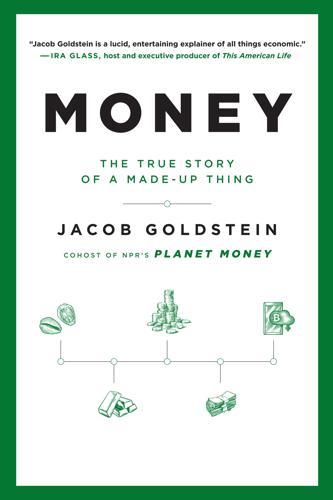
Money: The True Story of a Made-Up Thing
by
Jacob Goldstein
Published 14 Aug 2020
David Chaum published “Security Without Identification: Transaction Systems to Make Big Brother Obsolete” in Communications of the ACM. Chaum described his early life to me in a phone interview. The patent I quote from is for a “Cryptographic identification, financial transaction, and credential device.” The Wired quote is from “E-Money (That’s What I Want),” by Steven Levy. The New York Times Magazine quote is from “Dead as a Dollar,” by James Gleick. Citibank’s e-money program, and the international spread of DigiCash, are described in The Age of Cryptocurrency. The Greenspan quote is from a 1997 speech, “Privacy in the Information Age.” Timothy May described his discovery of Chaum’s work, and his role in creating the cypherpunks, in an interview with me.
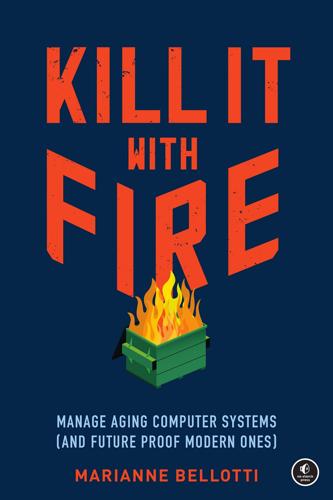
Kill It With Fire: Manage Aging Computer Systems
by
Marianne Bellotti
Published 17 Mar 2021
Legacy modernization projects do not fail because one mistake was made or something went wrong once. They fail because the organization deploys solutions that actually reinforce unsuccessful conditions. If you’re coming into a project in the middle, your most important task as a leader is figuring out where those cycles are and stopping them. 1 Steven Levy, In the Plex: How Google Thinks, Works, and Shapes Our Lives (New York: Simon & Schuster, 2011). 7 Design as Destiny Design is not about making things look pretty. Many software engineers I’ve worked with have never considered this fact before it was pointed out to them. It’s an easy mistake to make.

Internet for the People: The Fight for Our Digital Future
by
Ben Tarnoff
Published 13 Jun 2022
Smith, “Shopping Centers: The New Building Type,” Progressive Architecture (June 1952): 67–109. 86, Real malls are in the … On online mall rent-seeking, in addition to Sadowski, “The Internet of Landlords,” see Paul Langley and Andrew Leyshon, “Platform Capitalism: The Intermediation and Capitalization of Digital Economic Circulation,” Finance and Society 3, no. 1 (2017): 11–31. 88, In 1998, the same year … Steven Levy, In the Plex: How Google Thinks, Works, and Shapes Our Lives (New York: Simon and Schuster, 2011), 32–34. The paper was Sergey Brin and Lawrence Page, “The Anatomy of a Large-Scale Hypertextual Web Search Engine,” Computer Networks and ISDN Systems 30 (1998): 107–17. 88, Having too much data … IPv4, introduced in 1981, uses a 32-bit address space, which allows for approximately 4.3 billion addresses.
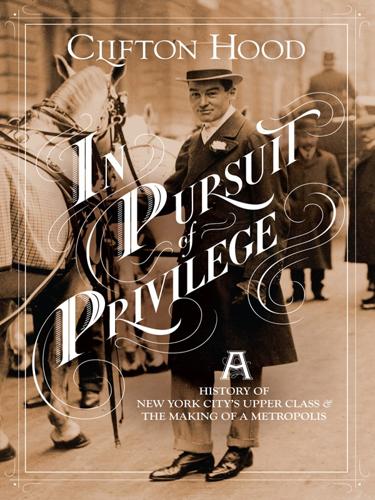
In Pursuit of Privilege: A History of New York City's Upper Class and the Making of a Metropolis
by
Clifton Hood
Published 1 Nov 2016
Social Register Association, Social Register, 1986 (New York: Social Register Association, 1985), 501; Social Register Association, Social Register, 1988 (New York: Social Register Association, 1987), 939, 998; Social Register Association, Social Register, 1990 (New York: Social Register Association, 1989), 910; Social Register Association, Social Register, 2013 (New York: Social Register Association, 2012), 887. 120. Quoted in Steven Levy, “Getting In,” New York Magazine 13 (June 30, 1980): 23. 121. Ibid., 23–24. 122. New York Times, April 7 and June 23, 1985. 123. New York Tribune, May 3, 1903, January 3, 1904; New York Times, May 4, 1902; “Town & Country Life,” Town and Country, 52 (June 14, 1902): 29–35; and “Town & Country Life,” Town and Country, 52 (June 21, 1902): 22–25. 124.
…
Once a bastion of white Protestants and a trifling number of Jews and Catholics, it did not run its first photograph of an African American bride until 1954. In the 1970s and 1980s, the presence of representative Asian Americans and African Americans became routinized, and in 2002 the Times began carrying announcements for same-sex couples. New York Times, May 29, 1983, August 18, 2002; and Steven Levy, “Getting In,” New York Magazine 13 (June 30, 1980): 23–24. 136. New York Times, September 14, 1997; W. P. Carey, 2011 Annual Report (New York: n.p., 2012), 2–5, 9–17; “Profiles: Executive Profile of Thomas E. Zacharias,” Bloomberg Businessweek, accessed June 26, 2011, http://investing.businessweek.com/research/stocks/people/person.asp?

This Is How They Tell Me the World Ends: The Cyberweapons Arms Race
by
Nicole Perlroth
Published 9 Feb 2021
—Gary McGraw, PhD, founder, Berryville Institute of Machine Learning and author of Software Security “Usually, books like this are praised by saying that they read like a screenplay or a novel. Nicole Perlroth’s is better: her sensitivity to both technical issues and human behavior give this book an authenticity that makes its message—that cybersecurity issues threaten our privacy, our economy, and maybe our lives—even scarier.” —Steven Levy, author of Hackers and Facebook For Tristan, who always pulled me out of my secret hiding spots. For Heath, who married me even though I couldn’t tell him where I was hiding. For Holmes, who hid in my belly. CONTENTS Author’s Note Prologue PART I: MISSION IMPOSSIBLE 1. Closet of Secrets 2.
…
On the subsequent fallout for tech companies and the NSA, see “Google’s Schmidt: NSA Spying on Data Centers Is ‘Outrageous,’ ” Wall Street Journal, November 4, 2013; Mike Masnick, “Pissed Off Google Security Guys Issue FU to NSA, Announce Data Center Traffic Now Encrypted,” Techdirt, November 6, 2013; Alexei Oreskovic, “Google Employees Lash Out at NSA over Reports of Cable Tapping,” Reuters, November 6, 2013; as well as my own reporting with Vindu Goel and David Sanger for the New York Times: “Internet Firms Step Up Efforts to Stop Spying,” December 5, 2013; and David E. Sanger and Nicole Perlroth, “Internet Giants Erect Barriers to Spy Agencies,” New York Times, June 6, 2014. I highly recommend Steven Levy’s comprehensive account, “How the NSA Almost Killed the Internet,” Wired, January 7, 2014. The first public account of Google’s Project Zero debut appeared in Wired. See Andy Greenberg, “Meet ‘Project Zero,’ Google’s Secret Team of Bug-Hunting Hackers,” July 15, 2014. The first major vulnerability Project Zero uncovered in Microsoft touched off a war of words between the two companies.
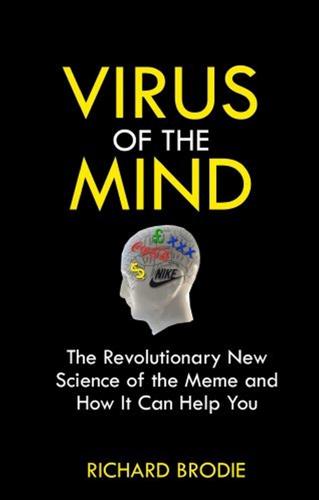
Virus of the Mind
by
Richard Brodie
Published 4 Jun 2009
.* When we use the word evolution, as in “the evolution of species by natural selection,” we’re making a distinction between the winners of that battle, which continue to exist, and the losers, *Experiments in modeling evolution through computers are part of the fascinating new field known as artificial life. Read Steven Levy’s excellent book Artificial Life (Vintage Books, 1993) to learn more about it. 48 Evolution which don’t. Natural selection means that the forces of nature are doing the selecting, as opposed to the artificial selection of breeding pedigreed dogs, for example, in which people do the selecting.
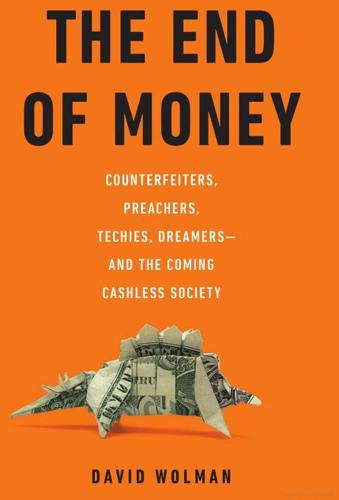
The End of Money: Counterfeiters, Preachers, Techies, Dreamers--And the Coming Cashless Society
by
David Wolman
Published 14 Feb 2012
v=VemU6EZtnwc. 22 Digital Money Blog, May 10, 2010; and Dave Birch, personal correspondence, November 2010. 23 William Greider, Secrets of the Temple: How the Federal Reserve Runs the Country (New York: Touchstone, 1987), p. 53. 24 Michael Salmony, Digital Money Forum address, London, March 10, 2010. 25 http://www.federalreserve.gov/boarddocs/rptcongress/annual09/sec5/c1t11.htm; and “As Plastic Reigns, the Treasury Slows Its Printing Presses,” New York Times, July 6, 2011. 26 John McCormick, “Loomis Fargo & Co.: Making Money Move, Efficiently,” http://www.baselinemag.com/c/a/Projects-Processes/Loomis-Fargo-Co-Making-Money-Move-Efficiently/, November 8, 2005; also Steven Levy, “E-Money (That’s What I Want),” Wired, December 1994. 27 Ronald Mann, Charging Ahead: The Growth and Regulation of Payment Card Markets (Cambridge, UK: Cambridge University Press, 2006), p. 39, quoting Swartz. 28 Daniel D. Garcia Swartz, Robert W. Hahn, and Anne Layne-Farrar, “The Economics of a Cashless Society: An Analysis of the Costs and Benefits of Payment Instruments,” Washington, D.C.: AEI-Brookings Joint Center for Regulatory Studies, 2004), p. 25, citing Humphrey et al. 29 Currency News, July 2009, pp. 6–7. 30 Digital Money Blog, May 11, 2009, “Viking Expedition,” citing “China sees change scarcity,” chna.org.cn, November 20, 2007. 31 David Birch, The Digital Money Reader (Guildford, UK: Mastodon Press, 2010), pp. 54–55, citing “Police Escort for Elderly ATM Users,” Daily Telegraph, May 6, 2009, and “DIY Students Tackle Japanese ATM Fraud,” Finextra.com, November 8, 2008. 32 http://online.wsj.com/article/SB10001424052748704482704576072231420350872.html?

Makers
by
Chris Anderson
Published 1 Oct 2012
The leaders of the Maker Movement echo the fervor of Steve Jobs, who saw in the personal computer not just the opportunity to start a company but also a force that would change the world. But don’t forget: he was right. Indeed, Jobs himself was inspired by his Maker upbringing. Writing in Wired,12 Steven Levy explained the connection, which led to the original Apple II in 1977: His dad, Paul—a machinist who had never completed high school—had set aside a section of his workbench for Steve, and taught him how to build things, disassemble them, and put them together. From neighbors who worked in the electronics firm in the Valley, he learned about that field—and also understood that things like television sets were not magical things that just showed up in one’s house, but designed objects that human beings had painstakingly created.
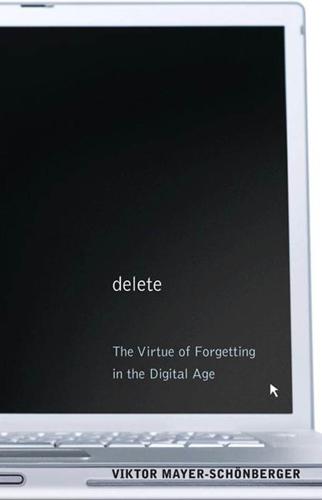
Delete: The Virtue of Forgetting in the Digital Age
by
Viktor Mayer-Schönberger
Published 1 Jan 2009
Darden School of Business Working Paper No. 03–05. 2003. Telegeography. Global Bandwidth Research Service. Washington, DC: Pri-Metrica 2008. Executive Summary available free of charge at http://www.telegeography.com/products/gb/index.php. Thompson, Clive. “A Head for Detail,” in The Best of Technology Writing, Steven Levy, ed. 94–114. Ann Arbor, MI: The University of Michigan Press. 2007. Timmer, John. “Google Bows to EU Pressure, Cuts Data Retention Period Again.” Ars Technica (Sept. 9, 2008). http://arstechnica.com/news.ars/post/20080909-google-bows-to-eu-pressure-cuts-data-retention-period-agaom.html. Turow, Joseph, Jennifer King, Chris Hoofnagle, Amy Bleakley, and Michael Hennessy.
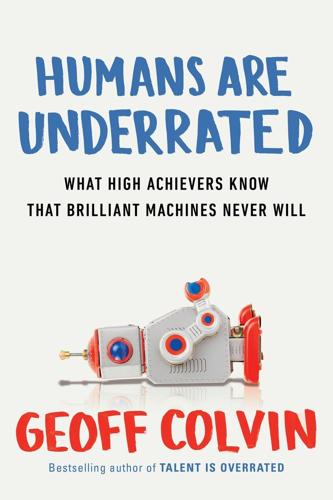
Humans Are Underrated: What High Achievers Know That Brilliant Machines Never Will
by
Geoff Colvin
Published 3 Aug 2015
Memorial Sloan Kettering Cancer Center in New York City uses Watson . . . http://www.mskcc.org/blog/msk-trains-ibm-watson-help-doctors-make-better-treatment-choices. Corporate Insight, a research firm . . . http://public.corporateinsight.com/blog/will-ibms-watson-make-your-financial-advisor-obsolete. A company called Narrative Science . . . Much of the description of the company comes from Steven Levy, “Can an Algorithm Write a Better News Story Than a Human Reporter?” Wired, 24 April 2012. Updated at www.narrativescience.com. In mid-2014, the Associated Press assigned . . . “The A.P. Plans to Automate Quarterly Earnings Articles,” New York Times, 1 July 2014, p. B5. Schools from the elementary level . . .
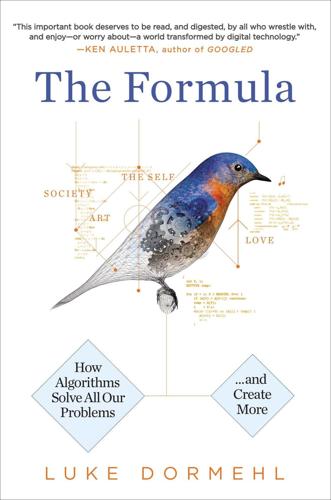
The Formula: How Algorithms Solve All Our Problems-And Create More
by
Luke Dormehl
Published 4 Nov 2014
Like many high-tech businesses, Google models itself as a libertarian utopia: the type of company where employees used to be allowed one extra day per week to pursue their own lines of inquiry, and are as likely to spend their time ascending Google’s indoor rock-climbing wall or having free food served up to them by a former Grateful Dead chef as they are to be coding. However, as Steven Levy points out in In the Plex, his 2011 study of Google, the search leviathan’s apparent loopiness is “the crazy-like-a-fox variety and not the kind calling for straightjackets.”26 Despite Google’s widely publicized quirks, its irreverent touches are data-driven to a fault. “At times Google’s largesse can sound excessive,” notes an article in Slate.

Creative Selection: Inside Apple's Design Process During the Golden Age of Steve Jobs
by
Ken Kocienda
Published 3 Sep 2018
Notes Please note that some of the links referenced in this work may no longer be active. 2. The Crystal Ball 1. Free Software Foundation, GNU Operating System. [Online]. Accessed November 12, 2017. Various pages on this website provide the history, the philosophy, and licenses for the GNU Project. https://www.gnu.org 2. Steven Levy, Insanely Great, the Life and Times of Macintosh, the Computer That Changed Everything (New York: Penguin Books, 1994). The Mac has been an inspiration to me from the moment I first saw one in college in 1984, and if Steven hadn’t written his book about how the people at Apple created it, you wouldn’t be reading this book right now. 3.
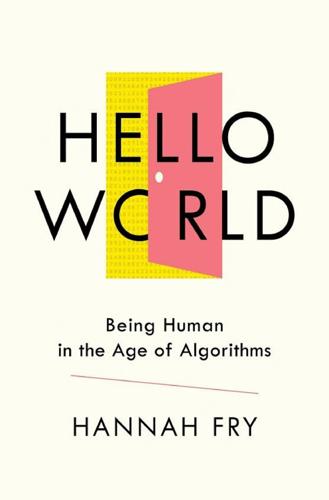
Hello World: Being Human in the Age of Algorithms
by
Hannah Fry
Published 17 Sep 2018
Feng-Hsiung Hsu, ‘IBM’s Deep Blue Chess grandmaster chips’, IEEE Micro, vol. 19, no. 2, 1999, pp. 70–81, http://ieeexplore.ieee.org/document/755469/. 3. Garry Kasparov, Deep Thinking: Where Machine Intelligence Ends and Human Creativity Begins (London: Hodder & Stoughton, 2017). 4. TheGoodKnight, ‘Deep Blue vs Garry Kasparov Game 2 (1997 Match)’, YouTube, 18 Oct. 2012, https://www.youtube.com/watch?v=3Bd1Q2rOmok&t=2290s. 5. Ibid. 6. Steven Levy, ‘Big Blue’s Hand of God’, Newsweek, 18 May 1997, http://www.newsweek.com/big-blues-hand-god-173076. 7. Kasparov, Deep Thinking, p. 187. 8. Ibid., p. 191. 9. According to Merriam–Webster. The Oxford English Dictionary’s definition makes more of the mathematical nature of algorithms: ‘a process or set of rules to be followed in calculations or other problem-solving operations, especially by a computer’. 10.
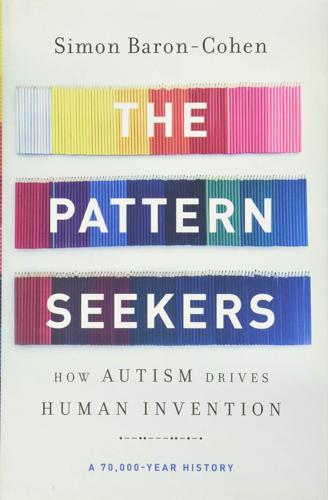
The Pattern Seekers: How Autism Drives Human Invention
by
Simon Baron-Cohen
Published 14 Aug 2020
His mother patiently taught him social skills long after the age when his peer group had intuitively mastered these, giving him a set of rules about how to behave in social situations. Although Gates’s affective empathy is clearly intact—he gives millions of dollars to alleviate suffering in the poorest parts of the world—these biographical accounts suggest that his social development was delayed, while his systemizing was way ahead of his peers. Steven Levy, reviewing the documentary in Wired magazine and having interviewed Gates dozens of times, commented that “Bill Gates arrived on Earth as a Martian.” His profile fits that of a hyper-systemizer. Edison famously went through 10,000 loops of checking and rechecking his if-and-then patterns to detect important mistakes or to find novel valuable patterns.

NeuroTribes: The Legacy of Autism and the Future of Neurodiversity
by
Steve Silberman
Published 24 Aug 2015
Asperger’s Association of New England, http://www.aane.org/asperger_resources/articles/adults/i_am_a_survivor.html 172 spacecraft: National Space Science Data Center. http://nssdc.gsfc.nasa.gov/nmc/spacecraftSearch.do?launchDate=1967&discipline=All the first undergraduate course in computer programming: Hackers: Heroes of the Computer Revolution, Steven Levy. O’Reilly Media, 2010, p. 11. he coined the term artificial intelligence: “A Proposal for the Dartmouth Summer Research Project on Artificial Intelligence,” J. McCarthy, M. L. Minsky, N. Rochester, and C. E. Shannon. Aug. 31, 1955. If his colleagues wanted him to read a paper: Scientific Temperaments, Philip Hilts.
…
Zerbe. http://www.gutenberg.org/files/22766/22766-h/22766-h.htm He advocated installing a terminal in every home: “The Home Information Utility,” John McCarthy. Man and Computer: Proceedings of the International Conference, Bordeaux, France, 1970. Basel. S. Karger, 1972, pp. 48–57. habitually unwashed, Coke-guzzling, Chinese-takeout-eating obsessives: See the descriptions of TMRC hackers in Hackers: Heroes of the Computer Revolution, Steven Levy. O’Reilly Media, 2010. As hard-core fans of science fiction, ham radio, and Japanese monster movies: “Spacewars and Beyond: How the Tech Model Railroad Club Changed the World,” Henry Jenkins. http://henryjenkins.org/2007/10/spacewars_and_beyond_how_the_t.html#sthash.vNI7iDoK.dpuf equal parts of “science, fiction, and science fiction”: Scientific Temperaments, p. 266.

Elon Musk
by
Walter Isaacson
Published 11 Sep 2023
Just as humans work collectively to stop evil actors, so too would a large collection of independent AI bots work to stop bad bots. For Musk, this was the reason to make OpenAI truly open, so that lots of people could build systems based on its source code. “I think the best defense against the misuse of AI is to empower as many people as possible to have AI,” he told Wired’s Steven Levy at the time. One goal that Musk and Altman discussed at length, which would become a hot topic in 2023 after OpenAI launched a chatbot called ChatGPT, was known as “AI alignment.” It aims to make sure that AI systems are aligned with human goals and values, just as Isaac Asimov set forth rules to prevent the robots in his novels from harming humanity.
…
Calia Cofield, “Blue Origin Makes Historic Reusable Rocket Landing in Epic Test Flight,” Space.com, Nov. 24, 2015; Davenport, Space Barons. 39. The Talulah Roller Coaster: Author’s interviews with Talulah Riley, Elon Musk, Maye Musk, Kimbal Musk, Navaid Farooq, Bill Lee. Junod, “Force of His Will.” 40. Artificial Intelligence: Author’s interviews with Sam Altman, Demis Hassabis, Elon Musk, Reid Hoffman, Luke Nosek, Shivon Zilis. Steven Levy, “How Elon Musk and Y Combinator Plan to Stop Computers from Taking Over,” Backchannel, Dec. 11, 2015; Cade Metz, “Inside OpenAI, Elon Musk’s Wild Plan to Set Artificial Intelligence Free,” Wired, Apr. 27, 2016; Maureen Dowd, “Elon Musk’s Billion-Dollar Crusade to Stop the A.I. Apocalypse,” Vanity Fair, Apr. 2017; Elon Musk talk, MIT Aeronautics and Astronautics Department’s Centennial Symposium, Oct. 24, 2014; Chris Anderson interview with Elon Musk, TED Conference, Apr. 14, 2022. 41.
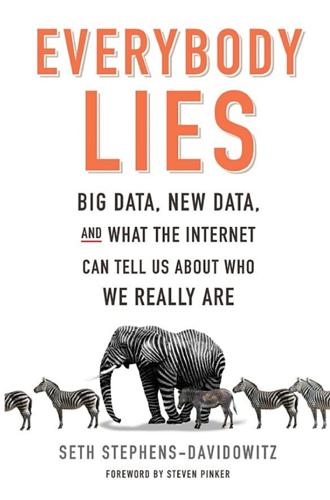
Everybody Lies: Big Data, New Data, and What the Internet Can Tell Us About Who We Really Are
by
Seth Stephens-Davidowitz
Published 8 May 2017
Also see Marcelle Chauvet, Stuart Gabriel, and Chandler Lutz, “Mortgage Default Risk: New Evidence from Internet Search Queries,” Journal of Urban Economics 96 (2016). 60 Bill Clinton: Sergey Brin and Larry Page, “The Anatomy of a Large-Scale Hypertextual Web Search Engine,” Seventh International World-Wide Web Conference, April 14–18, 1998, Brisbane, Australia. 61 porn sites: John Battelle, The Search: How Google and Its Rivals Rewrote the Rules of Business and Transformed Our Culture (New York: Penguin, 2005). 61 crowdsource the opinions: A good discussion of this can be found in Steven Levy, In the Plex: How Google Thinks, Works, and Shapes Our Lives (New York: Simon & Schuster, 2011). 64 “Sell your house”: This quote was also included in Joe Drape, “Ahmed Zayat’s Journey: Bankruptcy and Big Bets,” New York Times, June 5, 2015, A1. However, the article incorrectly attributes the quote to Seder.

Tubes: A Journey to the Center of the Internet
by
Andrew Blum
Published 28 May 2012
Google confirms at least one billion searches per day: Matt McGee, “By The Numbers: Twitter Vs. Facebook Vs. Google Buzz,” Search Engine Land, February 23, 2010 (http://searchengineland.com/by-the-numbers-twitter-vs-facebook-vs-google-buzz-36709). Its total cost was $1.8 million: For an account of Google’s arrival in The Dalles, see Steven Levy, In the Plex (New York: Simon & Schuster, 2011), pp. 192–95. “It was visionary—this little town…”: Ibid., p. 192. I’d even read a little note about it: The site has since been changed, but it was accessible as of June 2011 at http://www.google.com/corporate/datacenter/index.html; a copy is preserved here: http://kalanaonline.blogspot.com/2011/02/where-is-your-data-google-and-microsoft.html.
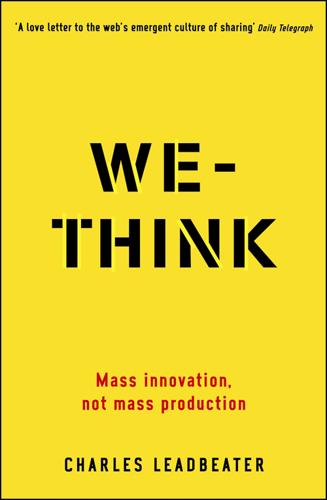
We-Think: Mass Innovation, Not Mass Production
by
Charles Leadbeater
Published 9 Dec 2010
Available from http:// msu.edu/%7enellison/facebook_ica_2006.pdf 12 Danah Boyd, ‘None of This Is Real: Identity and Participation in Friendster’, University of California, Berkeley. Available from http://www.danah.org/ papers/NoneOfThisIsReal.pdf 13 http://c2.com/cgi/wiki?WikiHistory 14 The Economist New Media Survey, ‘The Wiki Principle’, The Economist, April 2006. Available from http://www.economist.com/surveys/displaystory. cfm?story_id=6794228 15 See Steven Levy and Brad Stone, ‘The New Wisdom of the Web’, Newsweek, April 2006. Available from http:// www.msnbc.msn.com/id/12015774/site/newsweek 16 Fred Turner, From Counterculture to Cyberculture (Chicago, IL/London: University of Chicago Press, 2006) 17 Patrice Flichy, The Internet Imaginaire (Cambridge, MA: MIT Press, 2007) 18 Charles Leadbeater, ‘The DIY State’, Prospect 130, January 2007 19 Fred Turner, op. cit. 20 John Markoff, What the Dormouse Said: How the Sixties Counterculture Shaped the Personal Computer Industry (Penguin, 2006) 21 Patrice Flichy, The Internet Imaginaire (Cambridge, MA: MIT Press, 2007) 22 Jonathan Lethem, ‘The Ecstasy of Influence’, Harper’s Magazine, February 2007 23 Garrett Hardin, ‘The Tragedy of the Commons’, Science 162 (1968), pp. 1243–48 24 Elenor Ostrom, Governing the Commons (Cambridge University Press, 1990) 25 Lawrence Lessig, Code and Other Laws of Cyberspace (New York, NY: Basic Books, 1999) and Free Culture (New York, NY: Penguin Press, 2004) 26 Melvyn Bragg, The Routes of English (BBC Factual and Learning, 2000); Melvyn Bragg, The Adventure of English (Hodder & Stoughton Ltd, 2003) 27 Jonathan Lethem, ‘The Ecstasy of Influence’, Harper’s Magazine, February 2007 28 Cory Doctorow et al., ‘On “Digital Maoism: The Hazards of the New Online Collectivism” By Jaron Lanier’, Edge (2006). http://www.edge.org/discourse/digital_ maoism.html 29 Paul A.

Big Data: A Revolution That Will Transform How We Live, Work, and Think
by
Viktor Mayer-Schonberger
and
Kenneth Cukier
Published 5 Mar 2013
Kennedy Flagged by No-Fly List,” Washington Post, August 20, 2004, p. A01 (http://www.washingtonpost.com/wp-dyn/articles/A17073-2004Aug19.html). [>] Google’s hiring practices—See Douglas Edwards, I’m Feeling Lucky: The Confessions of Google Employee Number 59 (Houghton Mifflin Harcourt, 2011), p. 9. See also Steven Levy, In the Plex (Simon and Schuster, 2011), pp. 140–141. Ironically, Google’s co-founders wanted to hire Steve Jobs as CEO (despite his lack of a college degree); Levy, p. 80. Testing 41 gradations of blue—Laura M. Holson, “Putting a Bolder Face on Google,” New York Times, March 1, 2009 (http://www.nytimes.com/2009/03/01/business/01marissa.html).

The Buddha and the Badass: The Secret Spiritual Art of Succeeding at Work
by
Vishen Lakhiani
Published 14 Sep 2020
But these are wasting bullets. Wasting bullets is 100 percent correct, according to the OODA philosophy. Because you will shoot down more enemy planes. The pace of innovation is the most important thing. I don’t care if we fail 40 to 50 percent of the time. Google fails that often too. According to Steven Levy in his book In the Plex Google fails at 40 percent of everything they start. (Remember the Google Glass or Google Plus?) But by moving fast we learn, orient, adapt, and innovate faster than the competition. Failure is completely OKAY. In fact, it’s enshrined in our OKRs (50 percent of your OKRs must have a 50 percent rate of failure).

Listen, Liberal: Or, What Ever Happened to the Party of the People?
by
Thomas Frank
Published 15 Mar 2016
“Uber and the American Worker,” a speech Plouffe delivered at “the DC tech incubator 1776,” dated November 3, 2015, and available on the Uber website. http://newsroom.uber.com/2015/11/1776. 13. Schmidt can be seen making these statements in a YouTube recording of his SXSW talk, which also featured his coauthor, Jared Cohen, and the interviewer Steven Levy: https://www.youtube.com/watch?v=bmzcCSF_zXQ. 14. It Takes a Village: And Other Lessons Children Teach Us (Simon & Schuster, 1996), p. 294. 15. The economist Dean Baker suggested to me this interpretation of inno-as-circumvention. See “The Opportunities and Risks of the Sharing Economy,” his testimony before the House Subcommittee on Commerce, Manufacturing, and Trade, September 29, 2015. 16.

Cult of the Dead Cow: How the Original Hacking Supergroup Might Just Save the World
by
Joseph Menn
Published 3 Jun 2019
For kindly housing and looking after me during my research trips, I would like to thank Ralph and Shan Logan, Andrea Shallcross and Jonathan Burn, Rachel Layne and John Mulrooney, Barbara Bestor and Tom Stern, and assorted relatives. I am also indebted to a number of talented and hardworking authors who brought clarity to various aspects of historic and current issues in security touched on here, including John Markoff, Phil Lapsley, Fred Kaplan, Ronald Deibert, Shane Harris, Andy Greenberg, Bruce Sterling, Steven Levy, and Gabriella Coleman. For those interested in learning more about the bulletin board era, I strongly recommend Jason Scott Sadofsky’s multipart documentary and his text file collection, both publicly available. I would especially like to thank my keen-eyed editor, Colleen Lawrie, agent David Patterson, and media advisor Elinor Mills.

Artificial Unintelligence: How Computers Misunderstand the World
by
Meredith Broussard
Published 19 Apr 2018
It’s really very bizarre, but this was a self-energizing community. These hackers had their own language. They could get things done in three days that would take a month. If somebody appeared who had the talent, the magic touch, they would fit in.” The TMRC and Minsky’s lab were later immortalized in Stewart Brand’s The Media Lab and Steven Levy’s Hackers: The Heroes of the Computer Revolution, in addition to many other publications.6 The hacker ethic is also what inspired Mark Zuckerberg’s first Facebook motto: “Move fast and break things.” Minsky was part of Zuckerberg’s curriculum at Harvard. Minsky and a collaborator, John McCarthy, organized the very first conference on artificial intelligence, at the Dartmouth Math Department in 1956.
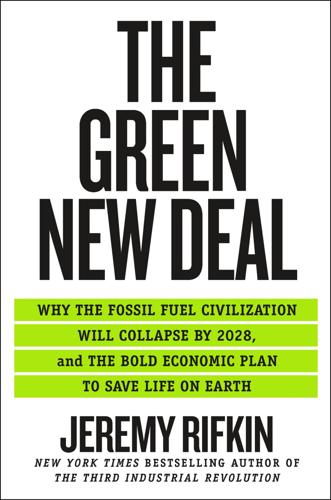
The Green New Deal: Why the Fossil Fuel Civilization Will Collapse by 2028, and the Bold Economic Plan to Save Life on Earth
by
Jeremy Rifkin
Published 9 Sep 2019
“The AT&T Issue Brief on Energy Management,” August 2018, https://about.att.com/ecms/dam/csr/issuebriefs/IssueBriefs2018/environment/energy-management.pdf (accessed February 22, 2019); “Intel Climate Change Policy Statement,” December 2017, https://www.intel.com/content/www/us/en/corporate-responsibility/environment-climate-change-policy.html (accessed February 22, 2019); Cisco, “CSR Environmental Sustainability,” https://www.cisco.com/c/en/us/about/csr/impact/environmental-sustainability.html (accessed February 22, 2019). 24. Steven Levy, “The Brief History of the ENIAC Computer: A Look Back at the Room-Size Government Computer That Began the Digital Era,” Smithsonian Magazine, November 2013, https://www.smithsonianmag.com/history/the-brief-history-of-the-eniac-computer-3889120/ (accessed March 12, 2019). 25. Simon Kemp, Digital in 2018: Essential Insights into the Internet, Social Media, Mobile, and Ecommerce Use Around the World, Hootsuite and We Are Social Global Digital Report, 3. 26.
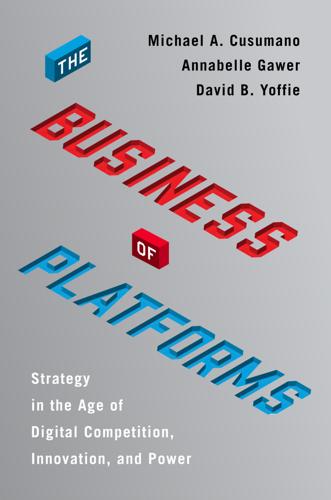
The Business of Platforms: Strategy in the Age of Digital Competition, Innovation, and Power
by
Michael A. Cusumano
,
Annabelle Gawer
and
David B. Yoffie
Published 6 May 2019
When measuring unique daily site visits, IE remained the market-share leader by a narrow margin in 2016, leading Chrome 43 percent to 39 percent, with Firefox a distant third at just over 10 percent. In terms of page views, Chrome has a huge lead, with over 60 percent share, while Firefox and IE battled for second place, with 15.7 percent and 13.7 percent, respectively. 52.Steven Levy, “Inside Chrome: The Secret Project to Crush IE and Remake the Web,” Wired, September 2, 2008. 53.Megan Geuss, “Which Browser Should You Use?” PCWorld, February 26, 2012. 54.Ann Bednarz, “Browser Wars,” Network World, November 2, 2011. 55.All quoted in “Google Cell Platform No Threat, Rivals Say: Move Seen to Give Search Engine Leg Up on Mobile Advertising,” Ottawa Citizen, November 6, 2007. 56.Jay Yarow, “Here’s What Steve Ballmer Thought About the iPhone Five Years Ago,” Business Insider, June 29, 2012. 57.Peter Bright, “Windows Phone 7: The Ars Review,” ArsTechnica, October 22, 2010. 58.Sascha Segan, “Microsoft’s Windows Phone 7 OS,” PCMag, October 20, 2010. 59.Joshua Topolsky, “Windows Phone 7 Review,” Engadget, October 20, 2010. 60.Dieter Bohn and Chris Ziegler, “Windows Phone 8 review,” Verge, October 29, 2012. 61.Bright, “Windows Phone 7.” 62.See Sam Oliver, “Nokia Ditches Symbian, Embraces Microsoft Windows Phone for New Handsets,” AppleInsider, February 11, 2011. 63.Pete Cunningham, quoted in Kevin J.

Inventor of the Future: The Visionary Life of Buckminster Fuller
by
Alec Nevala-Lee
Published 1 Aug 2022
Felsenstein dreamed of constructing a better network around a true personal computer, and, after hearing about a gathering for like-minded enthusiasts, he drove his pickup to the garage of an engineer named Gordon French, who hosted the first meeting of the Homebrew Computer Club on March 5, 1975. In his classic book Hackers: Heroes of the Computer Revolution, writer Steven Levy described it as “a textbook example” of Fuller’s concept of synergy, in which the whole became more than the sum of its parts, and with Felsenstein as its moderator, it grew into the birthplace of an entire industry. Fuller was there in spirit as well. Toward the back of the garage sat Steve Wozniak, who was working with Jobs on the computer that would be sold as the Apple II.
…
Lee Felsenstein: Lee Felsenstein, email to author, December 18, 2020. “an architect and engineer”: Charles Raisch, “Pueblo in the City,” Mother Jones, May 1976, 30. ideas for the Exploratorium: Hilde Hein, The Exploratorium: The Museum as Laboratory (Washington, DC: Smithsonian Institution, 1990), 239n10. Efrem Lipkin: Steven Levy, Hackers: Heroes of the Computer Revolution (Sebastopol, CA: O’Reilly Media, 2010), 164–65. Ken Colstad and Mark Szpakowski: “St. Jude Memorial and Virtual Wake,” https://people.well.com/conf/inkwell.vue/topics/190/St-Jude-Memorial-and-Virtual-Wak-page01.html (accessed April 2021). “a textbook example”: Levy, Hackers, 219.
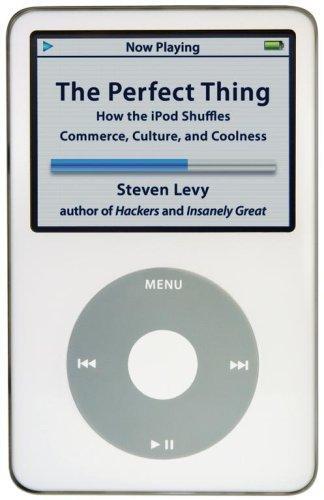
The Perfect Thing: How the iPod Shuffles Commerce, Culture, and Coolness
by
Steven Levy
Published 23 Oct 2006
The sequence of the chapters in the book has been shuffled in different copies, with only the opening and concluding sections excepted. "Shuffle" is a hallmark of the digital age—and The Perfect Thing, via sharp, insightful reporting, is the perfect guide to the deceptively diminutive gadget embodying our era. STEVEN LEVY is a senior editor and the chief technology correspondent for Newsweek magazine. He is the author of five previous books, including Hackers: Heroes of the Computer Revolution, which was voted the best sci-tech nonfiction book of the last twenty years by readers of PC magazine, and Insanely Great, the definitive account of the Macintosh computer.

Who Are We—And Should It Matter in the 21st Century?
by
Gary Younge
Published 27 Jun 2011
Johnson, Lyndon Joint Committee of Women’s Societies and Social Workers Jones, Melanie Jordan, Michael Judaism Jewish identity Jewish Life Information Center (ITIM) Zionism and Judge, Timothy Judiciary (American) Judt, Tony Kaiser, Jens Kamiya, Gary Karelitz, Avraham Yeshayahu Kasrils, Ronnie Katičić, Radoslav Katy, Judith Keane, Roy Kennedy, Geraldine Kennedy, Martin Kennedy, Robert Kerry, John Kerry, Teresa Heinz Khan, Chaka KhoiKhoi people King, Martin Luther King-O’Riain, Rebecca Chiyoko Kinsley, Michael Koppel, Ted Kroft, Steve Kyl, Jon Labour Party (UK) Lacorne, Denis Laing, Abraham Laing, Sandra Lajitas (Texas) Latif, Farasat Latinos/Latinas Lee, J. J. Leningrad Leterme, Yves Lévesque, René Levi sisters, Lilia and Alma Levitt, Steven Levy, Andrea Limbaugh, Rush Linkebeek List, Friedrich Little People of America Lloyd, T. Walker Locke, Jeremiah Lulu da Silva, Luiz Inácio MacIntyre, Alasdair McCain, John McCarthy, Joseph McCarthy, Mick McCourt, Frank McKay, Ruth B. Malcolm X Mamdani, Mahmood Marcerelli, Matthew Markiewicz, Countess Constance Marley, Bob Marriage– childbirth, parenthood and marital status forced marriage gay intermarriage Marshall, Thurgood Marx, Karl Marxism Marylebone Cricket Club Matthews, Chris Maupin, Armistead May, Rollo May, Theresa Melvin, Harold Metropolitan Police (UK) Mexico City student massacre Mfume, Kweisi Miles, Thomas J.

A More Beautiful Question: The Power of Inquiry to Spark Breakthrough Ideas
by
Warren Berger
Published 4 Mar 2014
From my interviews with Nikhil Goyal, April 2013; for more, see Goyal’s book, One Size Does Not Fit All: A Student’s Assessment of School (Bravura Books, 2012). 24 alumni have become known as the Montessori Mafia . . . Peter Sims, “The Montessori Mafia,” Wall Street Journal, April 5, 2011. 25 Marissa Mayer—now the head of Yahoo! . . . Steven Levy, “Larry Page Wants to Return Google to Its Startup Roots,” Wired, April 2011. 26 Dan Meyer, a high school math teacher . . . Meyer gave his talk, “Math Class Needs a Makeover,” at TEDxNYED, March 2010. 27 Why do movie tickets cost the same for hits or duds? . . . Robert H. Frank, “How Can They Charge That?
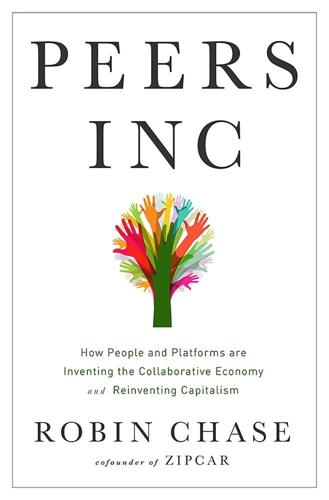
Peers Inc: How People and Platforms Are Inventing the Collaborative Economy and Reinventing Capitalism
by
Robin Chase
Published 14 May 2015
You could pay for your share of the driving expenses online, without having to awkwardly hand over exact change for your share of the trip expenses (we would charge each party 10 percent of the transaction for doing so). And both passengers and drivers could say whether they would ride with the other person again, creating a trusted network. I was proud of the product we launched with, and Steven Levy, the author of popular books about Apple and Google, broke the story about GoLoco in Newsweek: “If Chase has her way, GoLoco will be the behavioral equivalent of the Prius, zapping enviro-guilt while cooling off Gaia.”1 We persuaded close friends and employees to create complete personal profiles to fuel our start.
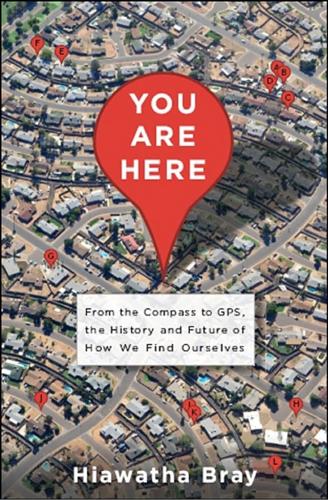
You Are Here: From the Compass to GPS, the History and Future of How We Find Ourselves
by
Hiawatha Bray
Published 31 Mar 2014
Jerry Brotton, A History of the World in Twelve Maps (London: Allen Lane, 2012), 417–418. 6. Kevin Maney, “Tiny Tech Company Awes Viewers,” USA Today, March 21, 2003. 7. John Timmer, “New Satellite to Give Google Maps Unprecedented Resolution,” Ars Technica, http://arstechnica.com/business/2008/09/new-satellite-to-give-google-maps-unprecedented-resolution/. 8. Steven Levy, “The Earth Is Ready for Its Close-Up,” Newsweek, June 6, 2005, 13. 9. UNOSAT Humanitarian Rapid Mapping Service, “Overview 2011,” http://unosat.web.cern.ch/unosat/unitar/Overview2011UNOSATRapidMapping_final2.pdf. 10. Danny Bradbury, “Taking Your Network to Extremes,” Computer Weekly, March 27, 2007. 11.

Gang Leader for a Day: A Rogue Sociologist Takes to the Streets
by
Sudhir Venkatesh
Published 13 Aug 2010
Bailey given money by at police robbery in politics popularity of promotion of prostitution and random gunshots and recruiting by at regional meeting Robert Taylor demolition feared by Robert Taylor survey by sales directors of on sex trade S.V. made gang leader by S.V.’s first meeting with S.V.’s information and on S.V.’s legal concerns S.V.’s relationship with S.V.’s teaching and S.V.’s underground-economy studies approved by S.V.’s writings as source of pride for Taneesha incident and at voter-registration drive Wilson family helped by worries of Justice Department, U.S. Justin (Taneesha’s baby) Kalia (gang member) Katchen (S.V.’s girlfriend) Keisha Kennedy-King College Kenny (gang member) Kris Lake Park projects scheduled demolition of LaShona (J.T.’s cousin) Las Vegas, Nev. Latin King Lee-Lee Legends South Levitt, Steven Levy, Cordella liberals Local Advisory Council (LAC) Los Angeles, Calif. ”Lounge,” Mae, Ms. (J.T.’s mother) background of at back-to-school party cooking of move of on prostitutes on sex trade visitors to Mafia Marcus, Reggie, see Reggie, Officer marijuana Marna Mayne (gang leader) MCs (Mickey Cobras) MC Southside Fest Medicaid men of neighborhood network of Mexican Americans Michael (gang member) Millie Milwaukee, Wis.
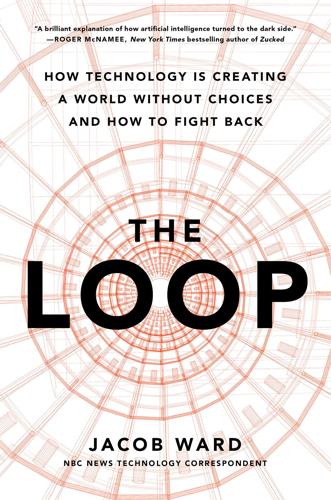
The Loop: How Technology Is Creating a World Without Choices and How to Fight Back
by
Jacob Ward
Published 25 Jan 2022
As usual with AI, it’s about offloading the laborious System 1 work: “We can automate a lot of the more repetitive mechanical aspects and present the human with just the most critical information at the end of the day, so they can make an informed decision about what’s happening.” According to a 2018 report from Wired’s Steven Levy, Customs and Border Patrol tested Lattice for ten weeks, and detected fifty-five people attempting to cross the US-Mexico border in the process. The company has been widely criticized by academics and watchdogs, including Whittaker, for selling technology that made policies like the Trump administration’s family-separation policy easier to implement.

What Algorithms Want: Imagination in the Age of Computing
by
Ed Finn
Published 10 Mar 2017
In Snow Crash, Hiro Protagonist satirically defines the icon of the hacker figure, working at the periphery of monolithic cultural systems to make crucial interventions through technical skill, idealistic motivation, and a blithe disregard for traditional mores. Hiro is a character right out of the trickster archetype that technology journalist Steven Levy chronicles in Hackers; a character who came to life around Silicon Valley pioneer Stewart Brand’s Hackers Conference in 1984.2 The computational systems of the novel, from the various security systems to the Metaverse itself, were created by hackers and are subject to their manipulations. As a high-water mark in the cyberpunk genre, Snow Crash both embellished and consecrated hackers as potent and capricious architects of computational reality.
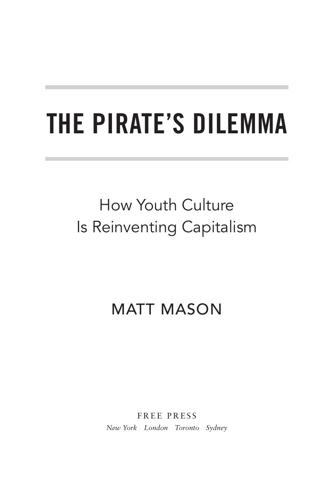
The Pirate's Dilemma: How Youth Culture Is Reinventing Capitalism
by
Matt Mason
Anders Bylund, “Mark Cuban on the tiered Internet,” Arstechnica.com, February 8, 2006. http://arstechnica.com/articles/culture/cuban.ars. Nicol Wistreich, “Disney Co-Chair recognises ‘piracy is a business model’,” Netribution.co.uk, October 10, 2006. www.netribution.co.uk/2/content/view/972/182/. Steven Levy, “Q&A: Jobs on iPod's Cultural Impact,” Newsweek, October 15, 2006. www.msnbc.msn.com/id/15262121/site/newsweek/print/1/displaymode/1098/. Associated Press, “‘Patent trolling’ firms sue their way to profits,” MSNBC, March 18, 2006. www.msnbc.msn.com/id/11860819/. Kristen Philipkoski, “Monsanto Prevails in Patent Fight,” Wired, May 21, 2004. www.wired.com/science/discoveries/news/2004/05/63555.
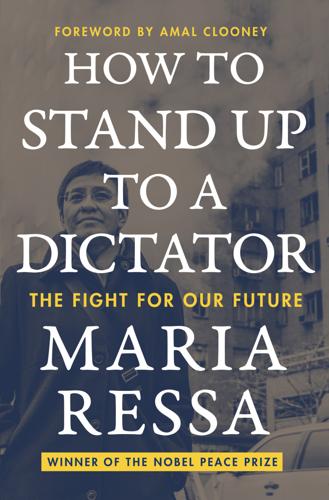
How to Stand Up to a Dictator
by
Maria Ressa
Published 19 Oct 2022
“Duterte Declares State of Lawlessness in PH,” Rappler, September 3, 2016, https://www.rappler.com/nation/145043-duterte-declares-state-of-lawlessness-ph/. 36.Editha Caduaya, “Man with Bomb Nabbed at Davao Checkpoint,” Rappler, March 26, 2016, https://www.rappler.com/nation/127132-man-bomb-nabbed-davao-checkpoint/. 37.These were the specific stories on the websites that had the misleadingly repurposed Rappler story: http://ww1.pinoytribune.com/2016/09/man-with-high-quality-of-bomb-nabbed-at.html; http://www.socialnewsph.com/2016/09/look-man-with-high-quality-of-bomb.html; http://www.newstrendph.com/2016/09/man-with-high-quality-of-bomb-nabbed-at.html. 38.Rappler Research, “Davao Bombing,” Flourish, July 8, 2019, https://public.flourish.studio/visualisation/230850/. 39.Ralf Rivas, “Gambling-Dependent Philippines Allows POGOs to Resume Operations,” Rappler, May 1, 2020, https://www.rappler.com/business/259599-gambling-dependent-philippines-allows-pogos-resume-operations-coronavirus/. 40.This is the now-nonexistent link to the Rappler Facebook post that was taken down: https://www.facebook.com/rapplerdotcom/posts/1312782435409203. 41.John Naughton, “The Goal Is to Automate Us: Welcome to the Age of Surveillance Capitalism,” Guardian, January 20, 2019, https://www.theguardian.com/technology/2019/jan/20/shoshana-zuboff-age-of-surveillance-capitalism-google-facebook. 42.There are four books about Facebook that I would recommend: David Kirkpatrick’s The Facebook Effect: The Inside Story of the Company That Is Connecting the World (New York: Simon & Schuster, 2010) traces the beginning and the development of Mark Zuckerberg. Published in 2010, it came out at a time of wonder. On the business model, Shoshana Zuboff coined the term surveillance capitalism in 2019; see The Age of Surveillance Capitalism: The Fight for a Human Future at the New Frontier of Power (New York: Public Affairs, 2019). Steven Levy’s Facebook: The Inside Story (New York: Blue Rider Press, 2020) chronicled the company’s fall. And finally, Sinan Aral’s The Hype Machine: How Social Media Disrupts Our Elections, Our Economy, and Our Health—and How We Must Adapt (New York: Currency, 2020) details some of the dangers but remains a favorable view of the giant, providing the possibility of redemption. 43.Naughton, “The Goal Is to Automate Us.” 44.James Bridle, “The Age of Surveillance Capitalism by Shoshana Zuboff Review—We Are the Pawns,” Guardian, February 2, 2019, https://www.theguardian.com/books/2019/feb/02/age-of-surveillance-capitalism-shoshana-zuboff-review. 45.Shoshana Zuboff wants the market in our behavioral data, like the slave trade, abolished.
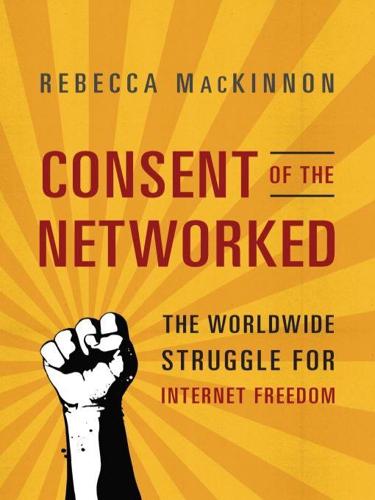
Consent of the Networked: The Worldwide Struggle for Internet Freedom
by
Rebecca MacKinnon
Published 31 Jan 2012
Today, things are more subtle”: Jailan Zayan, “Egypt, Tunisia Finding that Road to Freedom Is Rocky,” Agence France Presse, May 26, 2011. 6 President Barack Obama waxed enthusiastic about the political power of social networking: Full transcript at www.whitehouse.gov/the-press-office/2011/04/20/remarks-president-facebook-town-hall (accessed June 21, 2011). 7 A classic example was Google’s clash with the Chinese government: A full account of those events can be found in Steven Levy, In the Plex: How Google Thinks, Works, and Shapes Our Lives (New York: Simon & Schuster, 2011). Also see John Pomfret, “In China, Google Users Worry They May Lose an Engine of Progress,” Washington Post, March 20, 2010, www.washingtonpost.com/wp-dyn/content/article/2010/03/19/AR2010031900986.html (accessed June 21, 2011). 9 geopolitical vision for a digitally networked world: Eric Schmidt and Jared Cohen, “The Digital Disruption: Connectivity and the Diffusion of Power,” Foreign Affairs 89, no. 6 (November/December 2010), 75–85. 10 In his book The Filter Bubble, Eli Pariser: Eli Pariser, The Filter Bubble: What the Internet Is Hiding from You (New York: Penguin Press, 2011). 10 Siva Vaidhyanathan warns: Siva Vaidhyanathan, The Googlization of Everything (And Why We Should Worry) (Berkeley: University of California Press, 2011). 10 As Harvard’s Joseph Nye points out in The Future of Power: Joseph S.

The End of Secrecy: The Rise and Fall of WikiLeaks
by
The "Guardian"
,
David Leigh
and
Luke Harding
Published 1 Feb 2011
“It’s about understanding the environment in which we operate, taking it apart, and then expanding upon it and recreating it. Central to it is the idea that information should be free, combined with a deep distrust of authority.” House points to a book, Hackers: Heroes of the Computer Revolution, by Steven Levy, which chronicles the rise of the “hacker ethic” at MIT. “Hackers believe that essential lessons can be learned about … the world from taking things apart, seeing how they work, and using this knowledge to create new and even more interesting things,” Levy writes. “They resent any person, physical barrier, or law that tries to keep them from doing this.
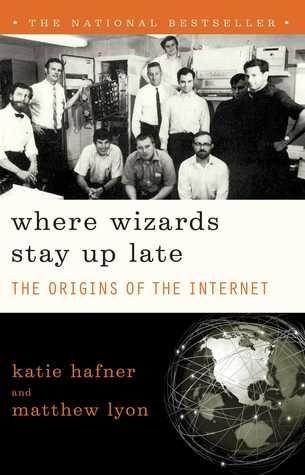
Where Wizards Stay Up Late: The Origins of the Internet
by
Katie Hafner
and
Matthew Lyon
Published 1 Jan 1996
Steve Wolff helped us understand the often labyrinthine events that took place in the 1980s, particularly concerning NSF’s role in the development of the Internet. The manuscript was read in whole or in part in various stages of completion by Vint Cerf, Lyman Chapin, Steve Crocker, Peter Denning, Frank Heart, Bob Kahn, John Kelley, Larry Landweber, Steven Levy, Hank Long, Paul McJones, Alex McKenzie, Peter Preuss, Larry Roberts, Einar Stefferud, Bob Taylor, John Vittal, Dave Walden, and Susan Zacharias. Everett Hafner, perfectionist and workhorse, kept us honest. The manuscript benefited tremendously from the keen mind and careful pen of Richard Lyon.
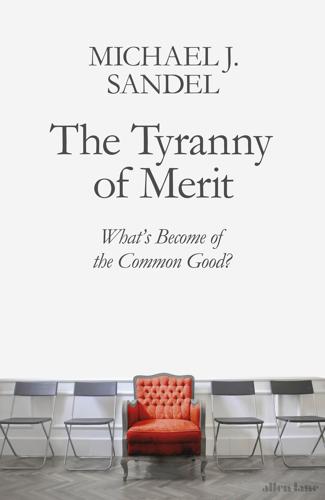
The Tyranny of Merit: What’s Become of the Common Good?
by
Michael J. Sandel
Published 9 Sep 2020
Kim Parker, “The Growing Partisan Divide in Views of Higher Education,” Pew Research Center, August 19, 2019, pewsocialtrends.org/essay/the-growing-partisan-divide-in-views-of-higher-education . 73. Obama quoted in Adam J. White, “Google.gov ,” The New Atlantis , Spring 2018, p. 15, thenewatlantis.com/publications/googlegov . The video of Obama’s talk at Google is at youtube.com/watch?v=m4yVlPqeZwo&feature=youtu.be&t=1h1m42s . 74. Ibid. See also Steven Levy, In the Plex: How Google Thinks, Works, and Shapes Our Lives (New York: Simon & Schuster, 2011), p. 317. 75. Author’s search of Obama’s use of “cost curve,” using the online archive of the American Presidency Project, presidency.ucsb.edu/advanced-search . 76. Author’s search of Obama’s use of “incentivize,” using the online archive of the American Presidency Project, presidency.ucsb.edu/advanced-search . 77.
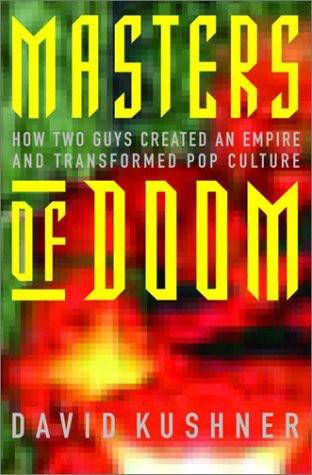
Masters of Doom: How Two Guys Created an Empire and Transformed Pop Culture
by
David Kushner
Published 2 Jan 2003
Carmack had heard about hackers: In 1982 a Disney movie called Tron told the story of a video game designer, played by Jeff Bridges, who hacked himself into a video game world; in a 1983 movie called WarGames, Matthew Broderick played a young gamer who hacked into a government computer system, and nearly triggered Armageddon. But this book’s story was different–it was real. Written by Steven Levy in 1984, it explored the uncharted history and culture of the “Whiz Kids Who Changed Our World.” The book traced the rise ol renegade computer enthusiasts over twenty-five rollicking years, from the mainframe experimentalists at MIT in the fifties and sixties to the Homebrew epoch of Silicon Valley in the seventies and up through the computer game start-ups of the eighties.

Utopia Is Creepy: And Other Provocations
by
Nicholas Carr
Published 5 Sep 2016
The internet had transformed many things, but it had not transformed us. The New New Age The yearning for a higher consciousness didn’t burst with the bubble. Web 1.0 may have turned out to be spiritual vaporware, but now we have the hyper-hyped upgrade: Web 2.0. In a new profile of the influential technology publisher Tim O’Reilly, Wired writer Steven Levy suggests that “the idea of collective consciousness is becoming manifest in the internet.” He quotes O’Reilly: “The internet today is so much an echo of what we were talking about at Esalen in the ’70s—except we didn’t know it would be technology-mediated.” Levy then asks, rhetorically, “Could it be that the internet—or what O’Reilly calls Web 2.0—is really the successor to the human potential movement?”
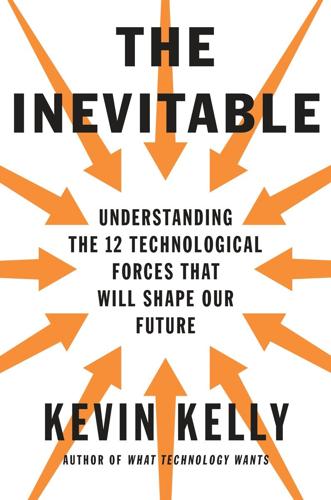
The Inevitable: Understanding the 12 Technological Forces That Will Shape Our Future
by
Kevin Kelly
Published 6 Jun 2016
Nelson, Literary Machines (South Bend, IN: Mindful Press, 1980). “intertwingularity”: Theodor H. Nelson, Computer Lib: You Can and Must Understand Computers Now (South Bend, IN: Nelson, 1974). total number of web pages: “How Search Works,” Inside Search, Google, 2013, accessed April 26, 2015. 90 billion searches a month: Steven Levy, “How Google Search Dealt with Mobile,” Medium, Backchannel, January 15, 2015. 50 million blogs in the early 2000s: David Sifry, “State of the Blogosphere, August 2006,” Sifry’s Alerts, August 7, 2006. 65,000 per day are posted: “YouTube Serves Up 100 Million Videos a Day Online,” Reuters, July 16, 2006. 300 video hours every minute, in 2015: “Statistics,” YouTube, April 2015, https://goo.gl/RVb7oz.
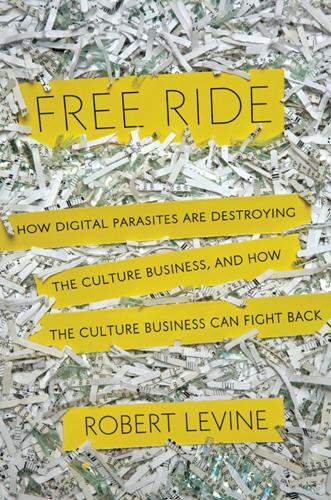
Free Ride
by
Robert Levine
Published 25 Oct 2011
More important, Napster would have had to change the expectations of an audience it had conditioned to expect free music, and it would have had to do so while competing with illegal services that were still free—and free to offer copyrighted movies and unreleased music when it couldn’t. That hasn’t kept technology pundits from insisting the music business missed its big chance. In The Perfect Thing: How the iPod Shuffles Commerce, Culture, and Coolness, the former Newsweek technology correspondent Steven Levy blames the labels for not making their content free online the way newspapers did, although that didn’t work out very well for them (or for Newsweek, for that matter).20 Levy writes that when he interviewed Barry, he saw a look in his eyes that said, “Why didn’t they work with us?”21 But Barry is hardly as naive as Levy makes him sound, and even he doesn’t think the labels were as clueless as some people say.
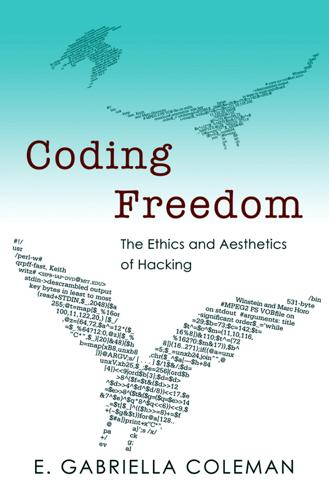
Coding Freedom: The Ethics and Aesthetics of Hacking
by
E. Gabriella Coleman
Published 25 Nov 2012
Hackers, however, evince considerable diversity and are notoriously sectarian, constantly debating the meaning of the words hack, hacker, and hacking. Yet almost all academic and journalistic work on hackers commonly whitewashes these differences, and defines all hackers as sharing a singular “hacker ethic.” Offering the first definition in Hackers: Heroes of the Computer Revolution, journalist Steven Levy (1984, 39) discovered among a couple of generations of MIT hackers a unique as well as “daring symbiosis between man and machine,” where hackers placed the desire to tinker, learn, and create technical beauty above all other goals. The hacker ethic is shorthand for a list of tenets, and it includes a mix of aesthetic and pragmatic imperatives: a commitment to information freedom, a mistrust of authority, a heightened dedication to meritocracy, and the firm belief that computers can be the basis for beauty and a better world (ibid., 39–46).
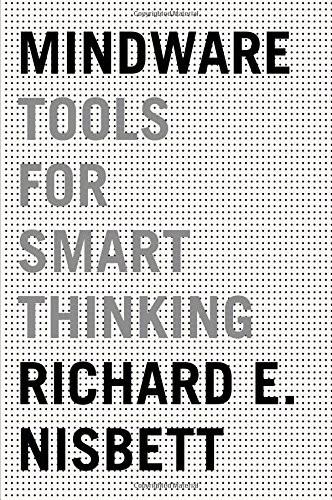
Mindware: Tools for Smart Thinking
by
Richard E. Nisbett
Published 17 Aug 2015
Kim, Beom Jun KISS (Keep It Simple, Stupid) Kissinger, Henry Kitayama, Shinobu Korea Kremer, Michael Krugman, Paul Kuhn, Thomas Kunda, Ziva kurtotic curves Lakatos, Imre Larrick, Richard Latané, Bibb Latin law of large numbers; observations and; sample values and learning; animal studies of; classroom size and; of language; machine; standardized tests as measures of; statistics, everyday benefits of; unconscious; about Venn diagrams; see also reinforcement learning theory Lehman, Darrin Lempert, Richard Lepper, Mark leptokurtic curve Levi, Primo Levitt, Steven Levy, Dan Lewicki, Pawel Life of Samuel Johnson, The (Boswell) LifeSkills Training Lincoln, Abraham Lingua Franca Literary Digest Liu, Amy Liu, Shu-hsien Logan, Robert logic; conditional; of cost-benefit theory; of decision theory; deontic; formal (see also syllogisms); propositional; violations of; see also reasoning London: weather in London School of Economics loss aversion Lowell, Amy Lysenko, Trofim macroeconomics Maier, N.R.F.

Dragnet Nation: A Quest for Privacy, Security, and Freedom in a World of Relentless Surveillance
by
Julia Angwin
Published 25 Feb 2014
And in 1999, the United States dropped: Jeri Clausing, “White House Eases Export Controls on Encryption,” New York Times, September 17, 1999, http://www.nytimes.com/library/tech/99/09/biztech/articles/17encrypt.html. It developed the “Clipper chip” to encrypt: John Markoff, “Technology; Wrestling over the Key to the Codes,” New York Times, May 9, 1993, http://www.nytimes.com/1993/05/09/business/technology-wrestling-over-the-key-to-the-codes.html. copies of the encryption keys: Steven Levy, “Battle of the Clipper Chip,” New York Times, June 12, 1994, http://www.nytimes.com/1994/06/12/magazine/battle-of-the-clipper-chip.html?pagewanted=all&src=pm. In 1994, Matt Blaze at AT&T Bell Labs: Matt Blaze, in discussion with author, May 8, 2013. “It is insufficient to protect ourselves”: Bruce Schneier, Applied Cryptology: Protocols, Algorithms, and Source Code in C (New York: Wiley, 1996).

The Raging 2020s: Companies, Countries, People - and the Fight for Our Future
by
Alec Ross
Published 13 Sep 2021
Anduril was contracted to build: Lee Fang, “Defense Tech Startup Founded by Trump’s Most Prominent Silicon Valley Supporters Wins Secretive Military AI Contract,” Intercept, March 9, 2019, https://theintercept.com/2019/03/09/anduril-industries-project-maven-palmer-luckey/. The company went on to build: Steven Levy, “Inside Palmer Luckey’s Bid to Build a Border Wall,” Wired, June 11, 2018, https://www.wired.com/story/palmer-luckey-anduril-border-wall/. Russian president Vladimir Putin remarked: Radina Gigova, “Who Vladimir Putin Thinks Will Rule the World,” CNN, September 2, 2017, https://www.cnn.com/2017/09/01/world/putin-artificial-intelligence-will-rule-world/index.html.

Talk to Me: How Voice Computing Will Transform the Way We Live, Work, and Think
by
James Vlahos
Published 1 Mar 2019
After a colleague shared Colossal Cave Adventure on a computer network, the game was passed around to more and more players. It attained a 1970s sort of virality and inspired other popular interactive text-based adventure games including Zork. In 1981 Crowther’s creation was honored by being the first game available for the original IBM PC. Decades later, the noted technology writer Steven Levy would note, “Playing adventure games without tackling this one is like being an English major who’s never glanced at Shakespeare.” Like Eliza, text-based computer games such as Colossal Cave Adventure were also many people’s first experience of something powerful: communicating with what felt like a sentient machine.

Sandworm: A New Era of Cyberwar and the Hunt for the Kremlin's Most Dangerous Hackers
by
Andy Greenberg
Published 5 Nov 2019
Extra thanks to Dan Novack for his steel backbone as legal counsel, and others at Doubleday/Penguin Random House, including Sean Yule, Beth Pizio, Kate Hughes, Todd Doughty, Michael Goldsmith, Hannah Engler, and Ingrid Sterner. Other miscellaneous but heartfelt thanks go out (in no particular order) to Mike Assante, Sam Chambers, James Lewis, Kenneth Geers, Alan Paller, Oleh Derevianko and the staff of ISSP in Kiev, Anne Applebaum, Cliff Stoll, Steven Levy, Alex Gladstein, Maryna Antonova, Khatuna Mshvidobadze, Zurab Akhvlediani, Elena Ostanina, Autumn Maison, Roman Dobrokhotov, Fyodor Mozgovoy, Adrian Chen, Joshua Corman, Trevor Timm, Ben Wizner, Edward Snowden, Patrick Neighorn, Cristiana Brafman Kittner, Marina Krotofil, Ben Miller, Anna Keeve, Ranson Burkette, Ilina Cashiola, Jessica Bettencourt, Sarah Kitsos, Jaime Padilla, Mike Smith, Walter Weiss, Nadya and Stephan Wasylko, Natalie Jaresko, Tom Mayer, Jasmine Lake, Bryan Fogel, Sarahana Shrestha, Sabrina Bezerra, Sam Greenberg, Naima Zouhali, and Steve Worrall, and a very big, special thank-you to Bertha Auquilla.
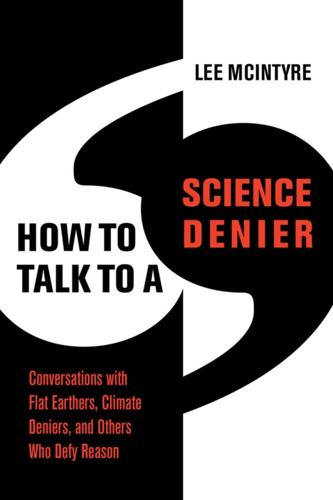
How to Talk to a Science Denier: Conversations With Flat Earthers, Climate Deniers, and Others Who Defy Reason
by
Lee McIntyre
Published 14 Sep 2021
Oliver Milman, “Revealed: Quarter of All Tweets about Climate Crisis Produced by Bots,” Guardian, February 21, 2020, https://www.theguardian.com/technology/2020/feb/21/climate-tweets-twitter-bots-analysis; Ryan Bort, “Study: Bots Are Fueling Online Climate Denialism,” Rolling Stone, February 21, 2020, https://www.rollingstone.com/politics/politics-news/bots-fueling-climate-science-denialism-twitter-956335/. 33. Whether or not Zuckerberg wants Facebook to be the “arbiter of truth,” so many people get their news from his website that perhaps it already is. Steven Levy, “Mark Zuckerberg Is an Arbiter of Truth—Whether He Likes It or Not,” Wired, June 5, 2020, https://www.wired.com/story/mark-zuckerberg-is-an-arbiter-of-truth-whether-he-likes-it-or-not/. 34. Tony Romm, “Facebook CEO Mark Zuckerberg Says in Interview He Fears ‘Erosion of Truth’ but Defends Allowing Politicians to Lie in Ads,” Washington Post, October 17, 2019, https://www.washingtonpost.com/technology/2019/10/17/facebook-ceo-mark-zuckerberg-says-interview-he-fears-erosion-truth-defends-allowing-politicians-lie-ads/. 35.
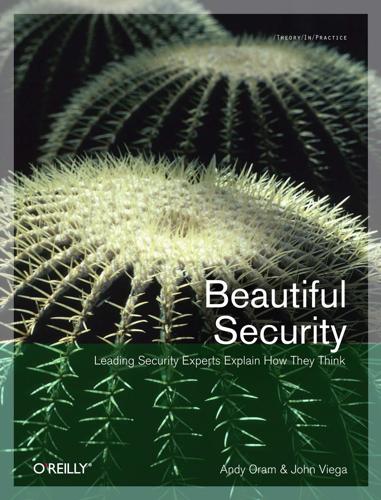
Beautiful security
by
Andy Oram
and
John Viega
Published 15 Dec 2009
What do you have to hide? Twenty years later, the cultural attitude is closer to, Why don’t you have it? Don’t you understand that you have to protect your data? The definitive history of The Crypto Wars and the cultural shift in cryptography has not yet been written. Nonetheless, a good place to start is Steven Levy’s Crypto: How the Code Rebels Beat the Government Saving Privacy in the Digital Age (Penguin). From PGP 3 to OpenPGP After the status of PGP 2 became calmer, Phil, along with Derek Atkins and Colin Plumb, started work on a new version of PGP software, PGP 3. PGP 3 contained a number of improvements to the RFC 1991 protocol, including: • Support for multiple public-key pairs in a PGP key.
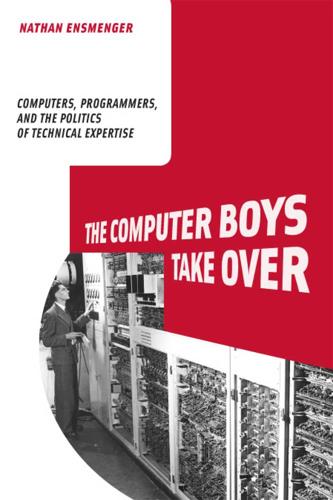
The Computer Boys Take Over: Computers, Programmers, and the Politics of Technical Expertise
by
Nathan L. Ensmenger
Published 31 Jul 2010
David Anderegg, Nerds: Who They Are and Why We Need More of Them (New York: Jeremy P. Tarcher, 2007); Benjamin Nugent, American Nerd: The Story of My People (New York: Scribner, 2008). 7. Joseph Weizenbaum, Computer Power and Human Reason: From Judgment to Calculation (New York: Penguin, 1976); Steven Levy, Hackers: Heroes of the Computer Revolution (Garden City, NY: Anchor Press, 1984); Katie Hafner, CYBERPUNK: Outlaws and Hackers on the Computer Frontier, Revised (New York: Simon and Schuster, 1995). 8. Philip Scranton, “None-too-Porous Boundaries: Labor History and the History of Technology,” Technology and Culture 29, no. 744–778 (1988); Stephen Barley, “Technicians in the Workplace: Ethnographic Evidence for Bringing Work into Organization Studies,” Administrative Science Quarterly 41, no. 3 (1996): 404–441; Nelly Oudshoorn and Trevor Pinch, eds., How Users Matter: The Co-construction of Users and Technologies (Cambridge, MA: MIT Press, 2003). 9.
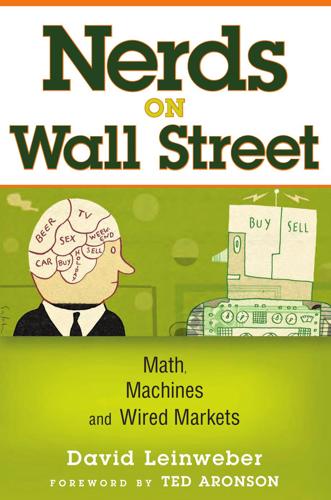
Nerds on Wall Street: Math, Machines and Wired Markets
by
David J. Leinweber
Published 31 Dec 2008
It has links in to all of these references, plus color and animated versions of the black & white screen grabs found in the book. The site will be updated often with new and topical items. Notes 1. A term of respect popularized by Michael Lewis in his 1989 book, Liar’s Poker (W.W. Norton). 2. Emanuel Derman, “Finance by the Numbers,” Wall Street Journal, August 22, 2007. 3. Much of Steven Levy’s 1984 book Hackers: Heroes of the Computer Revolution (Doubleday) takes place in the PDP-1 lab at MIT. Hacking had no criminal connotation at the time. The book is still in print. 4. Start with Herman Kahn’s On Thermonuclear War (Princeton, NJ: Princeton University Press, 1960) for a weighty tome, or “How RAND Invented the Postwar World,” by Virginia Campbell, in Invention & Technology magazine (Summer 2004) for a much more compact read. 5.
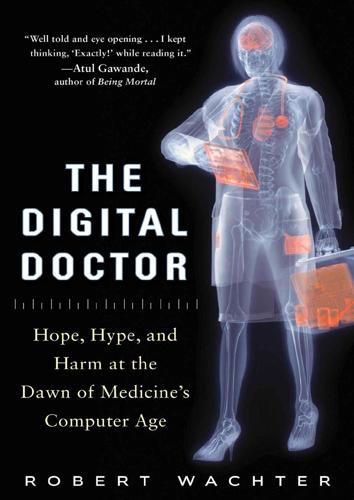
The Digital Doctor: Hope, Hype, and Harm at the Dawn of Medicine’s Computer Age
by
Robert Wachter
Published 7 Apr 2015
This breadth allows him to prescribe commonsense solutions to the problems emerging from the inevitable marriage between the fields, which he reveals as a more troubled union than many suspect. The Digital Doctor not only enlightens and awakens, but is a delight to read—rare for such an important book.” —Steven Levy author of Hackers and In the Plex “A fascinating and insightful look at the digital transformation of healthcare, thoroughly researched and brought to life by dozens of stories and interviews with practicing clinicians. Wachter plots a realistic road map for navigating the obstacles ahead, without the hype that frequently accompanies digital health solutions.

The Fugitive Game: Online With Kevin Mitnick
by
Jonathan Littman
Published 1 Jan 1996
What are programs "useful in unscrambling cellular telephone codes" doing on Shimomura's computer? I flip the page to "The Greatest Hits of Hacking," photos of six of the most famous hackers of all time, Mitnick, Poulsen, Morris, and others. But that's just part of Newsweek's hacker coverage for the week. On the facing page is an article by Steven Levy, the author of Hackers. It's the photo that catches my eye, an inspired, superimposed cybermontage, a giant close-up of Shimomura's intense face glowing with magenta and fluorescent green light. Above his flowing black locks floats a miniature ghost of the warrior in Buddha pose, hands poised on the keyboard, and at his side, what looks like the sword of a samurai.
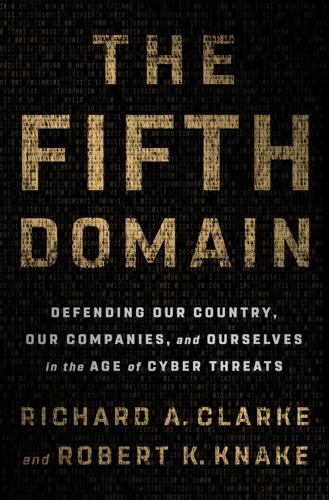
The Fifth Domain: Defending Our Country, Our Companies, and Ourselves in the Age of Cyber Threats
by
Richard A. Clarke
and
Robert K. Knake
Published 15 Jul 2019
As the internet has gone from being the place you go to visit bulletin boards on esoteric topics to undergirding all of modern existence, the early vision for cyberspace as a domain beyond the reach of the state now seems hopelessly naïve. The internet pioneer John Perry Barlow is often held up as the embodiment of this “techno-utopian” vision for the internet. The founder of the Electronic Frontier Foundation (EFF), Barlow is a fascinating character. Steven Levy described him as a “cowboy, poet, romantic, family man, philosopher, and ultimately, the bard of the digital revolution.” When he died in early 2018, Rolling Stone titled his obituary “John Perry Barlow, Grateful Dead Lyricist, Dead at 70.” Barlow wrote such classics as “Mexicali Blues” with band member Bob Weir.

Habeas Data: Privacy vs. The Rise of Surveillance Tech
by
Cyrus Farivar
Published 7 May 2018
Mailsafe: Harold Joseph Highland, “Encryption packages offer business users a choice,” Computerworld, July 13, 1987. Available at: https://books.google.com/books?id=-_HA2pUErI8C&pg=PT94&dq=%22rsa+mailsafe%22&hl=en&sa=X&ved=0ahUKEwjDrPHLhMPUAhWV8oMKHdVwBhoQ6AEIMTAC#v=onepage&q=%22rsa%20mailsafe%22&f=false. Around that same time, Phil Zimmerman: Steven Levy, Crypto (Penguin Books, 2002), p. 191. Pretty Good Privacy: John Markoff, “Move on Unscrambling Of Messages Is Assailed,” The New York Times, April 17, 1991. Available at: http://www.nytimes.com/1991/04/17/business/move-on-unscrambling-of-messages-is-assailed.html. “to obtain the plaintext contents”: Joseph Biden, “All Information (Except Text) for S.266 - Comprehensive Counter-Terrorism Act of 1991,” January 24, 1991. https://www.congress.gov/bill/102nd-congress/senate-bill/266/all-info.

System Error: Where Big Tech Went Wrong and How We Can Reboot
by
Rob Reich
,
Mehran Sahami
and
Jeremy M. Weinstein
Published 6 Sep 2021
believe the story about Gates: Ciara O’Rourke, “No, the Gates Foundation Isn’t Pushing Microchips with All Medical Procedures,” PolitiFact, May 20, 2020, https://www.politifact.com/factchecks/2020/may/20/facebook-posts/no-gates-foundation-isnt-pushing-microchips-all-me/; Linley Sanders, “The Difference Between What Republicans and Democrats Believe to Be True About COVID-19,” YouGov, May 26, 2020, https://today.yougov.com/topics/politics/articles-reports/2020/05/26/republicans-democrats-misinformation. When Gates was asked: Steven Levy, “Bill Gates on Covid: Most US Tests Are ‘Completely Garbage,’” Wired, August 7, 2020, https://www.wired.com/story/bill-gates-on-covid-most-us-tests-are-completely-garbage/. “putting power in people’s hands”: Mark Zuckerberg, “A Blueprint for Content Governance and Enforcement,” Facebook, November 15, 2018, https://www.facebook.com/notes/751449002072082/.
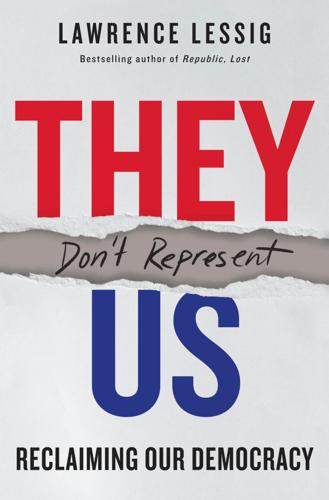
They Don't Represent Us: Reclaiming Our Democracy
by
Lawrence Lessig
Published 5 Nov 2019
Others are clear there’s a competitive harm, but unsure about the remedy. For a fantastic analysis of the antitrust problem raised by “free” data, see Dirk Bergemann and Alessandro Bonatti, “The Economics of Social Data” (working paper, January 15, 2019) (while identifying a competitive problem, the authors have no clear remedy beyond data portability). 94.Steven Levy, In the Plex: How Google Thinks, Works, and Shapes Our Lives (New York: Simon & Schuster, 2011), 172–73. 95.Microsoft acquired Skype for $8.5 billion on May 10, 2011. “Microsoft Officially Welcomes Skype,” Microsoft, October 13, 2011, available at link #124. Microsoft revealed its speech recognition capabilities through an announcement that demonstrated Star Trek–like technology (the “universal translator”).

The Perfect Weapon: War, Sabotage, and Fear in the Cyber Age
by
David E. Sanger
Published 18 Jun 2018
Cook’s social and political intuition: Todd Frankel, “The Roots of Tim Cook’s Activism Lie in Rural Alabama,” Washington Post, March 7, 2016, www.washingtonpost.com/news/the-switch/wp/2016/03/07/in-rural-alabama-the-activist-roots-of-apples-tim-cook/?utm_term=.5f670fd2354d. “more than 5½ years”: Computer-security experts question that figure, because Apple does not fully realize how quickly the NSA’s supercomputers can crack codes. the agency developed the “Clipper chip”: Steven Levy, “Battle of the Clipper Chip,” New York Times, June 12, 1994, www.nytimes.com/1994/06/12/magazine/battle-of-the-clipper-chip.html. the Clinton administration retreated: Susan Landau, Listening In: Cybersecurity in an Insecure Age (New Haven: Yale University Press, 2017), 84. Morell and his colleagues sided with Big Tech: Richard A.

The Coming Wave: Technology, Power, and the Twenty-First Century's Greatest Dilemma
by
Mustafa Suleyman
Published 4 Sep 2023
GO TO NOTE REFERENCE IN TEXT Over many hours, Lemoine Nitasha Tiku, “The Google Engineer Who Thinks the Company’s AI Has Come to Life,” Washington Post, June 11, 2022, www.washingtonpost.com/technology/2022/06/11/google-ai-lamda-blake-lemoine. GO TO NOTE REFERENCE IN TEXT He told an incredulous Wired interviewer Steven Levy, “Blake Lemoine Says Google’s LaMDA AI Faces ‘Bigotry,’ ” Wired, June 17, 2022, www.wired.com/story/blake-lemoine-google-lamda-ai-bigotry. GO TO NOTE REFERENCE IN TEXT “As soon as it works” Quoted in Moshe Y. Vardi, “Artificial Intelligence: Past and Future,” Communications of the ACM, Jan. 2012, cacm.acm.org/magazines/2012/1/144824-artificial-intelligence-past-and-future/fulltext.

Dawn of the New Everything: Encounters With Reality and Virtual Reality
by
Jaron Lanier
Published 21 Nov 2017
If you pay attention, you’ll find cameos of me in early cyberpunk novels. My head might float by. Flattering Mirror Fiction about VR has mostly been quite dark ever since cyberpunk. The Matrix movies; Inception. Meanwhile, norms for tech journalism became hell-bent on positivity. VR engaged a new generation of journalists, like Steven Levy, Howard Rheingold, Luc Sante, and Mondo 2000’s Ken Goffman, aka R. U. Sirius. I’ll highlight two figures who were particularly influential as well as dear to me: Kevin Kelly and John Perry Barlow. Kevin is a fine example of a trusted friend with whom I disagree completely. When I met him, he was editing and writing in publications connected to Stewart Brand’s world, post–Whole Earth Catalog; he later became the first editor in chief of Wired.
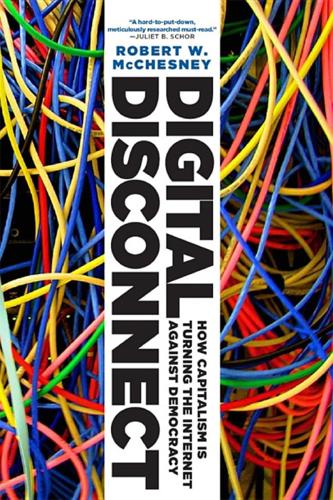
Digital Disconnect: How Capitalism Is Turning the Internet Against Democracy
by
Robert W. McChesney
Published 5 Mar 2013
They also became conglomerates because media economics, as discussed in chapter 3, are rather unlike traditional markets for goods and services. Conglomeration is an especially effective way to reduce risk. An excellent discussion of this is in Wu, Master Switch, ch. 17. 137. Jaron Lanier, You Are Not a Gadget: A Manifesto (New York: Knopf, 2010), 87. 138. Steven Levy, “How the Propeller Heads Stole the Electronic Future,” New York Times Magazine, Sept. 24, 1995, 58. 139. Lanier, You Are Not a Gadget, 87. 140. Adam Smith, The Wealth of Nations (1776; New York: Modern Library, 1937), 173. 141. This episode is chronicled in John Motavalli, Bamboozled at the Revolution: How Big Media Lost Billions in the Battle for the Internet (New York: Viking, 2002).
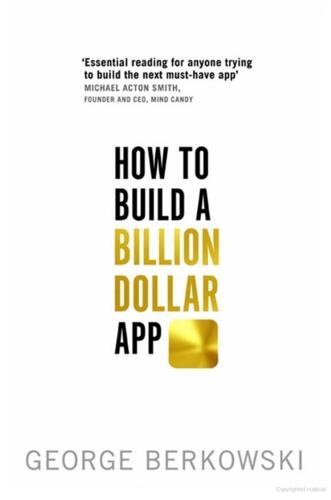
How to Build a Billion Dollar App: Discover the Secrets of the Most Successful Entrepreneurs of Our Time
by
George Berkowski
Published 3 Sep 2014
Chapter 37: People at a Billion-Dollar Scale 1 Victoria Baret, ‘How the Kids at Box Are Disrupting Software’s Most Lucrative Game’, Forbes, 4 March 2013 issue, www.forbes.com/sites/victoriabarret/2013/02/13/box-aaron-levie-mobile-enterprise-software/. 2 Eric Savitz, ‘SurveyMonkey To Raise $794M In Recap; Valuation $1.35 Billion (Updated)’, article on Forbes.com, 17 January 2013, www.forbes.com/sites/ericsavitz/2013/01/17/surveymonkey-to-raise-794min-recap-valuation-1-35-billion/. 3 ‘How Dave Goldberg of SurveyMonkey Built a Billion-Dollar Business and Still Gets Home by 5.30 p.m.’, article and video interview on FirstRound.com, firstround.com/article/how-dave-goldberg-of-surveymonkey-built-a-billion-dollar-business-and-still-gets-home-by-5-30. 4 Ibid. 5 Mike Rose, ‘Supercell’s Secret Sauce’, article on Gamasutra.com, 7 December 2012, www.gamasutra.com/view/feature/183064/supercells_secret_sauce.php. 6 Ibid. 7 Alyson Shontell and Andrea Huspeni, ‘15 Incredible Employee Perks That Will Make You Wish You Worked at a Startup’, article on BusinessInsider.com, 31 May 2012, www.BusinessInsider.com/killer-startup-perks-2012-5. 8 Heather Leonard, ‘Facebook Generates Over $1 Million in Revenue Per Employee’, article on BusinessInsider.com, 19 March 2013, www.BusinessInsider.com/facebook-has-high-revenue-per-employee-2013-3. 9 Megan Rose Dickey, ‘“Clash of Clans” Maker Had a Monster Year in 2013: Revenue Increased Nearly Ninefold’, article on BusinessInsider.com, 12 February 2014, www.BusinessInsider.com/gaming-startup-supercell-2013-revenue-2014-2. 10 Steven Levy, ‘Google’s Larry Page on Why Moon Shots Matter’, article on Wired.com, 17 January 2013, www.wired.com/business/2013/01/ff-qa-larry-page/all/. 11 Peter Murray, ‘Google’s Self-Driving Car Passes 300,000 Miles’, article on Forbes.com, 15 August 2012, www.forbes.com/sites/singularity/2012/08/15/googles-self-driving-car-passes-300000-miles/. 12 For more information about Project Loon, visit www.google.com/loon/. 13 ‘Google X’, entry on Wikipedia, en.wikipedia.org/wiki/Google_X.
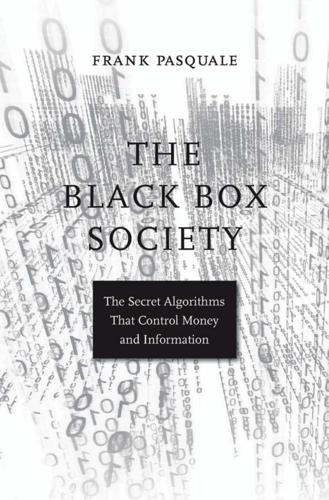
The Black Box Society: The Secret Algorithms That Control Money and Information
by
Frank Pasquale
Published 17 Nov 2014
Laurianne McLaughlin, “The Straight Story on Search Engines,” ComputerWorld, June 25, 2002, http://www.computerworld.com.au /article /27204 /straight _story_search _engines/. (“Despite our misgivings, the situation is not completely hopeless. There’s always Google. Not only does Google deliver exceptionally relevant matches, but it’s also the best of the bunch at identifying ads.”) 67. Steven Levy, In the Plex: How Google Thinks, Works, and Shapes Our Lives (New York: Simon & Schuster, 2010); John Battelle, The Search: How Google and Its Rivals Rewrote the Rules of Business and Transformed Our Culture (New York: Portfolio, 2005); Randall Stross, Planet Google (New York: Free Press, 2008). 68.
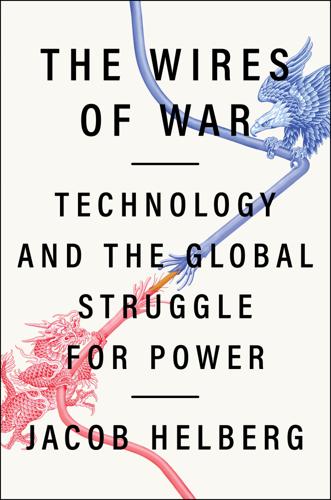
The Wires of War: Technology and the Global Struggle for Power
by
Jacob Helberg
Published 11 Oct 2021
Propaganda Campaign in Vietnam (New York: Westview Press, 1981), 3, 29. 5 Rid, Active Measures, 12. 6 Stephen Kinzer, All the Shah’s Men: An American Coup and the Roots of Middle East Terror (Hoboken, NJ: Wiley, 2003), 5–6. 7 Onora O’Neill, “Shoot the messenger,” The Guardian, May 1, 2002, https://www.theguardian.com/comment/story/0,3604,707820,00.html. 8 Michiko Kakutani, review of David Shenk, “Data Smog”: Created by Overload of Information, New York Times, July 8, 1997, https://archive.nytimes.com/www.nytimes.com/books/97/07/06/daily/data-book-review.html. 9 Niraj Chokshi, “That Wasn’t Mark Twain: How a Misquotation Is Born,” New York Times, April 26, 2017, https://www.nytimes.com/2017/04/26/books/famous-misquotations.html. 10 Soroush Vosoughi, Deb Roy, and Sinan Aral, “The Spread of True and False News Online,” MIT Initiative on the Digital Economy, http://ide.mit.edu/sites/default/files/publications/2017%20IDE%20Research%20Brief%20False%20News.pdf. 11 Craig Silverman, “This Analysis Shows How Viral Fake Election News Stories Outperformed Real News On Facebook,” BuzzFeed News, November 16, 2016, https://www.buzzfeednews.com/article/craigsilverman/viral-fake-election-news-outperformed-real-news-on-facebook#.sf9JbwppAm. 12 Jamie Susskind, Future Politics: Living Together in a World Transformed by Tech (New York: Oxford University Press, 2018), 230. 13 Brooke Donald, “Stanford researchers find students have trouble judging the credibility of information online,” Stanford News and Media, November 22, 2016, https://ed.stanford.edu/news/stanford-researchers-find-students-have-trouble-judging-credibility-information-online. 14 Joel Breakstone, Mark Smith, and Sam Wineburg, “Students’ Civic Online Reasoning,” Stanford, https://stacks.stanford.edu/file/druid:gf151tb4868/Civic%20Online%20Reasoning%20National%20Portrait.pdf. 15 Matt McKinney, “ ‘If it’s going viral, it must be true’: Hampton Roads kids struggle with fake news, teachers say,” Virginian-Pilot, November 28, 2016, https://www.pilotonline.com/news/education/article_4a785dfb-3dd3-5229-9578-c4585adfefb4.html. 16 Yosh Halberstam and Brian Knight, “Homophily, Group Size, and the Diffusion of Political Information in Social Networks: Evidence from Twitter,” National Bureau of Economic Research, November 2014, https://www.nber.org/system/files/working_papers/w20681/w20681.pdf. 17 Zeynep Tufekci, “YouTube, the Great Radicalizer,” New York Times, March 10, 2018, https://www.nytimes.com/2018/03/10/opinion/sunday/youtube-politics-radical.html. 18 “The Flat Earth Society,” Facebook, https://www.facebook.com/FlatEarthToday/. 19 Singer and Brooking, LikeWar, 126. 20 Steven Levy, “ ‘Hackers’ and ‘Information Wants to Be Free,’ ” Medium, November 21, 2014, https://medium.com/backchannel/the-definitive-story-of-information-wants-to-be-free-a8d95427641c#.y7d0amvr3. 21 Michael M. Grynbaum, “Right-Wing Media Uses Parkland Shooting as Conspiracy Fodder,” New York Times, February 20, 2018, https://www.nytimes.com/2018/02/20/business/media/parkland-shooting-media-conspiracy.html. 22 Jennifer Kavanagh and Michael D.

Invisible Women
by
Caroline Criado Perez
Published 12 Mar 2019
This is bad enough when it comes to human-on-human recruitment, but with the rise of algorithm-driven recruiting the problem is set to get worse, because there is every reason to suspect that this bias is being unwittingly hardwired into the very code to which we’re outsourcing our decision-making. In 1984 American tech journalist Steven Levy published his bestselling book Hackers: Heroes of the Computer Revolution. Levy’s heroes were all brilliant. They were all single-minded. They were all men. They also didn’t get laid much. ‘You would hack, and you would live by the Hacker Ethic, and you knew that horribly inefficient and wasteful things like women burned too many cycles, occupied too much memory space,’ Levy explained.
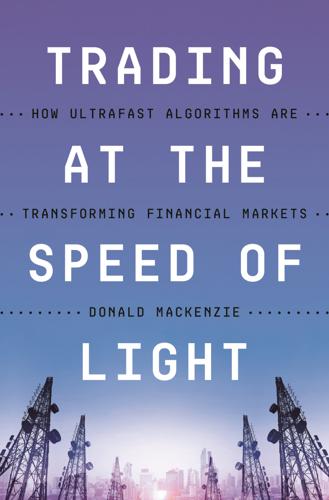
Trading at the Speed of Light: How Ultrafast Algorithms Are Transforming Financial Markets
by
Donald MacKenzie
Published 24 May 2021
That was a time-consuming and expensive process, and though the resultant system usually worked, it was typically neither elegant nor efficient. Island’s system, in contrast, had both been conceived and most of its original core software written by just one person, Josh Levine. His approach was captured by Steven Levy’s description in Hackers (Levy 1984), even though the programmers Levy discusses were from an earlier generation. Hackers, as the term was originally used, were not necessarily people who broke into computer systems, but rather programmers who saw themselves as part of an informal but identifiable subculture, with a loosely related set of beliefs and preferences: distrust of authority, bureaucracy, and centralization; disdain for organizational rank; support for freedom of information and for ready, widely available, hands-on access to computer systems; and, perhaps above all, a distinctive programmer’s aesthetic.
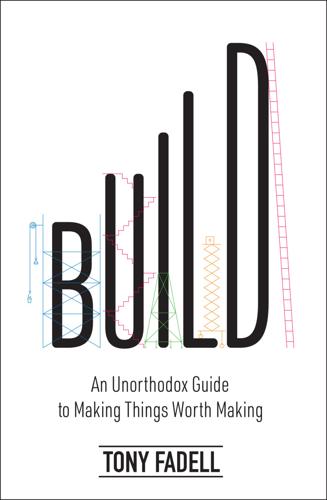
Build: An Unorthodox Guide to Making Things Worth Making
by
Tony Fadell
Published 2 May 2022
Reading List Here are some of the books and articles that have helped me, my friends, and mentors, in no particular order: Give and Take: Why Helping Others Drives Our Success, Adam Grant In Praise of Shadows, Jun’ichirō Tanizaki The Monk and the Riddle, Randy Komisar Why We Sleep: Unlocking the Power of Sleep and Dreams, Matthew Walker The Messy Middle: Finding Your Way Through the Hardest and Most Crucial Part of Any Bold Venture, Scott Belsky The Perfect Thing: How the iPod Shuffles Commerce, Culture, and Coolness, Steven Levy Creative Confidence: Unleashing the Creative Potential Within Us All, David Kelley and Tom Kelley Trillion Dollar Coach: The Leadership Playbook of Silicon Valley’s Bill Campbell, Eric Schmidt, Jonathan Rosenberg, and Alan Eagle The Hard Thing About Hard Things: Building a Business When There Are No Easy Answers, Ben Horowitz Super Founders: What Data Reveals About Billion-Dollar Startups, Ali Tamaseb Thinking, Fast and Slow, Daniel Kahneman Noise: A Flaw in Human Judgment, Daniel Kahneman, Olivier Sibony, and Cass R.
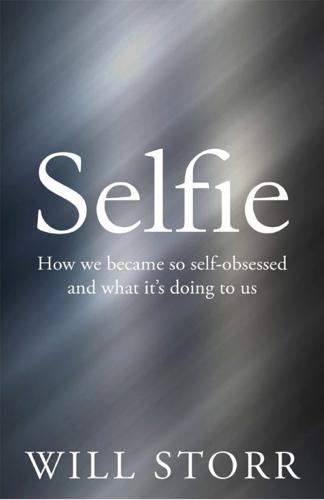
Selfie: How We Became So Self-Obsessed and What It's Doing to Us
by
Will Storr
Published 14 Jun 2017
In 1968, the year of the demo, the Institute’s co-founder Michael Murphy had written: ‘Esalen: Where Man Confronts Himself’, Michael Murphy, Stanford Alumni Almanac, May 1968. with one 1985 Esquire story reporting ‘scientists’: ‘Encounters at the Mind’s Edge’, George Leonard, Esquire, June 1985. Tim O’Reilly, the man who in 2005 christened the internet’s: ‘The Trend Spotter’, Steven Levy, Wired, 1 October 2010. ‘There is an impression that Doug goes off in a corner and hatches ideas’ . . . etc.: Bootstrapping, Thierry Bardini (Stanford University Press, 2000), pp. 198–200. Engelbart was treating his people like ‘laboratory animals’: ‘Chronicle of the Death of a Laboratory: Douglas Engelbart and the Failure of the Knowledge Workshop’, Thierry Bardini and Michael Friedewald, History of Technology (2003), 23, pp. 191–212, at p. 206.
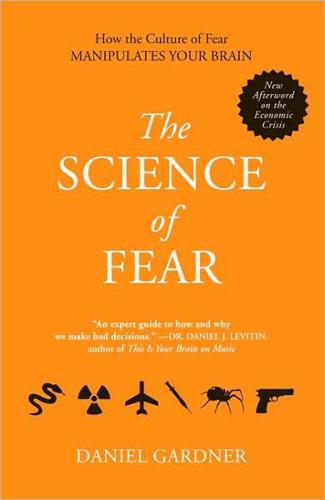
The Science of Fear: How the Culture of Fear Manipulates Your Brain
by
Daniel Gardner
Published 23 Jun 2009
Kent, Robert Kern, Montague Kerry, John Kessler, David Kim Jong King . J. Knetsch, Jack Kolbig, Uwe Kone, Daboula Koop . Everett Kramer, Barry Krewski, Daniel Kunstler, James Howard Lanning, Ken Leiserowitz, Anthony Leovy, Jill Lessner, Richard Levin, Irwin Levitt, Steven Levy, Douglas Lewinsky, Monica Lewis, Jeffrey Lichtenfeld, Leonard Lichtenstein, Sarah Lichter, Robert Livingstone, Ken Loewenstein, George Lomborg, Bjorn Lunsford, Jessica Luntz, Frank Lynch, Timothy Macallair, Daniel Macdonald, Ken Mack, Andrew MacLeod, Ian mad cow disease.

The Future of Ideas: The Fate of the Commons in a Connected World
by
Lawrence Lessig
Published 14 Jul 2001
Merges, “Institutions for Intellectual Property Transactions: The Case of Patent Pools,” in Expanding the Boundaries of Intellectual Property, Rochelle Cooper Dreyfuss and Diane Leenheer Zimmerman, eds. (Oxford: Oxford University Press, 2001), 127-28. 96 Bessen and Maskin, “Sequential Innovation, Patents, and Imitation.” 97 Steven Levy, “The Great Amazon Patent Debate,” Newsweek (March 13, 2000): 74 (“I asked Bezos if Amazon would have developed 1-Click even if there were no patent system to protect it and anyone could legally rip it off. 'Yes,' he responded without hesitation. 'Very definitely.' “). This point suggests a related reason to be skeptical about these patents.

How I Became a Quant: Insights From 25 of Wall Street's Elite
by
Richard R. Lindsey
and
Barry Schachter
Published 30 Jun 2007
Presentation Speech by Professor Bertil Näslund of the Royal Swedish Academy of Sciences, December 10, 1997. From Les Prix Nobel, the Nobel Prizes 1997, Tore Frängsmyr, ed., Nobel Foundation, Stockholm, 1998. 9. Perry Mehring, Fischer Black and the Revolutionary Idea of Finance (Hoboken, NJ: John Wiley & Sons, 2005). Chapter 1 1. Much of Steven Levy’s 1984 book, Hackers: Heroes of the Computer Revolution, takes place in the PDP-1 lab at MIT. Hacking had no criminal connotation at the time. The book is still in print. 2. It is now complete, and is utterly awesome. See the video at http://www.deltawerken.com/The-Oosterschelde-storm-surgebarrier/324.html.

The Wizard of Menlo Park: How Thomas Alva Edison Invented the Modern World
by
Randall E. Stross
Published 13 Mar 2007
Even the loquacious Johnson: Edward Johnson to Uriah Painter, 7 December 1877, PTAE, 3:661. feeling quite well: Over one hundred years later, Steve Jobs borrowed the same parlor trick when he pulled the first Macintosh computer out of a bag and had it introduce itself on stage in January 1984: “Hello, I am Macintosh. It sure is great to get out of that bag.” See Steven Levy, Insanely Great: The Life and Times of Macintosh, the Computer That Changed Everything (New York: Viking, 1994), 182. Edison was given credit: “The Talking Phonograph,” Scientific American, 22 December 1877, PTAED, MBSB10300. In France, Leon Scott claimed that his phonautograph anticipated Edison’s phonograph, which he criticized for not creating an intelligible visual record of human speech.
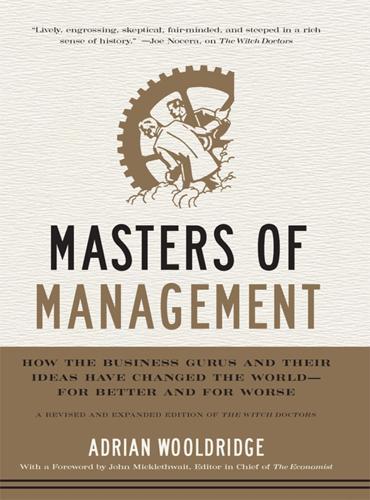
Masters of Management: How the Business Gurus and Their Ideas Have Changed the World—for Better and for Worse
by
Adrian Wooldridge
Published 29 Nov 2011
Howard Gardner, Five Minds for the Future (Boston: Harvard Business Press, 2007), pp. 18–19. CHAPTER 6: RETHINKING THE COMPANY 1. Auletta, Googled, pp. 17–18. 2. Martin Thomas, Loose: The Future of Business Is Letting Go (London: Headline, 2011), pp. 181–82. 3. Auletta, Googled, p. 21. 4. Steven Levy, “Larry Page wants to return Google to its startup roots,” Wired, March 18, 2011. 5. Auletta, Googled, p. 15. 6. Mark Zuckerberg, speech at Cannes Lions International Advertising Festival, June 23, 2010. 7. Don Tapscott and Anthony Williams, Macrowikinomics: Rebooting Business and the World (New York: Portfolio, 2010), p. 253. 8.

Like, Comment, Subscribe: Inside YouTube's Chaotic Rise to World Domination
by
Mark Bergen
Published 5 Sep 2022
GO TO NOTE REFERENCE IN TEXT Chapter 2: Raw and Random endless rodent problem: Amici’s owner didn’t recall mice on the premises, but the building was shared with another restaurant, which has since changed hands. GO TO NOTE REFERENCE IN TEXT YouTube could net at least: Botha also wrote that Reid Hoffman, a Flickr investor and former PayPal leader, had assured YouTube that Flickr would not be trying video anytime soon. GO TO NOTE REFERENCE IN TEXT later call YouTube: Steven Levy, In the Plex: How Google Thinks, Works, and Shapes Our Lives (New York: Simon & Schuster, 2011), 249. Additional context about Amazon, Microsoft, and Google from Sequoia Capital. GO TO NOTE REFERENCE IN TEXT she cried once it began: Catherine Buni and Soraya Chemaly, “The Secret Rules of the Internet,” The Verge, April 13, 2016, https://www.theverge.com/2016/4/13/11387934/internet-moderator-history-youtube-facebook-reddit-censorship-free-speech.
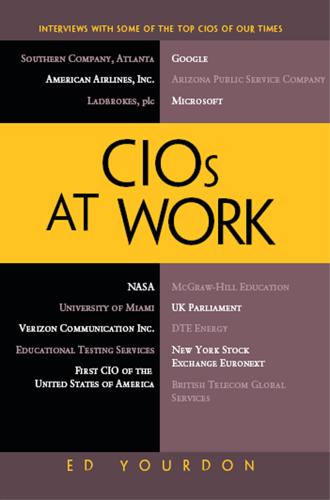
CIOs at Work
by
Ed Yourdon
Published 19 Jul 2011
The creation of the ARPANET, the creation of DARPA, without which we wouldn’t have had the ARPANET, without which we wouldn’t have had the NSFnet, without which we wouldn’t have had the Internet, without which we wouldn’t have had Google, right? Yourdon: Yeah, that’s true. That is a good point. No one has mentioned that, and that obviously is a social or human creation, that led to all this other stuff. Fried: And there’s this other unique—I’m a big fan of Steven Levy’s book, Hackers [Doubleday, 1984]. Yourdon: Mm-hmm. Fried: There was this unique point in time where our culture was created that we now see evidenced in Linux and open-source software—and in a dramatically lower cost to compute that comes from that. And as a result now people talk about open-source hardware as well, but this notion that people should be able—if you believe what Levy has in the book, it came out of this belief that computers should be open, that anyone should be able to use them and experiment with them and learn to program.
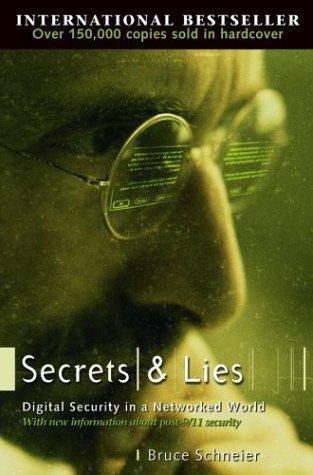
Secrets and Lies: Digital Security in a Networked World
by
Bruce Schneier
Published 1 Jan 2000
–Jim Wallner, National Security Agency “The news media offer examples of our chronic computer security woes on a near-daily basis, but until now there hasn’t been a clear, comprehensive guide that puts the wide range of digital threats in context. The ultimate knowledgeable insider, Schneier not only provides definitions, explanations, stories, and strategies, but a measure of hope that we can get through it all.” –Steven Levy, author of Hackers and Crypto “In his newest book, Secrets and Lies:Digital Security in a Networked World, Schneier emphasizes the limitations of technology and offers managed security monitoring as the solution of the future.” –Forbes Magazine Secrets and Lies DIGITAL SECURITY IN A NETWORKED WORLD Bruce Schneier Wiley Publishing, Inc.
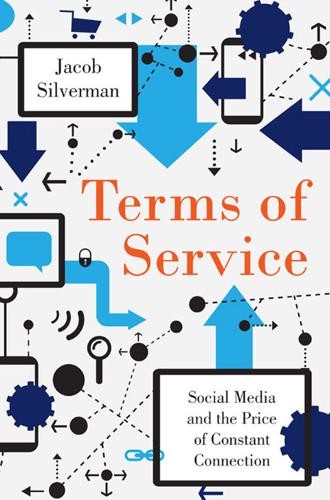
Terms of Service: Social Media and the Price of Constant Connection
by
Jacob Silverman
Published 17 Mar 2015
June 19, 2009. nytimes.com/2009/06/20/us/20ventura.html. 341 “I think in tweets”: David Roberts. “Goodbye for Now.” Grist. Aug. 19, 2013. grist.org/article/goodbye-for-now. 342 “an escalating cycle”: Lasch. Culture of Narcissism, 90. 343 “the performing self”: ibid. 345 “Awareness commenting on awareness”: ibid. 346 “like television”: Steven Levy. “Inside the Science That Delivers Your Scary-Smart Facebook and Twitter Feeds.” Wired. April 22, 2014. wired.com/2014/04/perfect-facebook-feed. 346 “method actors”: de Zengotita. Mediated, 11. 347 “conflictual ways”: “Fetishism of Digital Commodities and Hidden Exploitation: The Cases of Amazon and Apple.”

Dealers of Lightning
by
Michael A. Hiltzik
Published 27 Apr 2000
Cost of Dorado and comparison to VAX: Thacker in Goldberg, p. 285. Cost of VAX: Bell, Gordon, in Goldberg, p. 45. It was difficult to think: Thacker in Goldberg, p. 285. They were such an efficient heater: Sosinski. Xerox executives made: Perry & Wallich, p. 73. Chapter 23: Steve Jobs Gets His Show and Tell You can have your Lufthansa heist: Steven Levy, Insanely Great, p. 78. Joe Wilson had predicted: Jacobson & Hillkirk,, p. 58. The answer was to create: George White, 10/6/97. When the company raised $7 million: Michael Moritz, The Little Kingdom, p. 271. Raskin recollection of Jobs and Wozniak: Raskin, “Mac and Me,” in The Analytical Engine 2.4, November 1995 (Computer History Association of California).

Dark Mirror: Edward Snowden and the Surveillance State
by
Barton Gellman
Published 20 May 2020
More valuably, the EFF lays out a method for thinking about the particular “threat model” in each case. I also sent one of the occasional blog posts I wrote for Time online, “The Case of the Stolen Laptop: How to Encrypt, and Why,” Techland, August 6, 2010, http://ti.me/1Qjdu5f. the cypherpunks of the 1990s: See Steven Levy, Crypto: How the Code Rebels Beat the Government, Saving Privacy in the Digital Age (New York: Viking, 2001). See also Eric Hughes, “A Cypherpunk’s Manifesto” (1993), www.activism.net/cypherpunk/manifesto.html; and John Perry Barlow, “A Declaration of the Independence of Cyberspace,” Electronic Frontier Foundation, February 8, 1996, www.eff.org/cyberspace-independence.
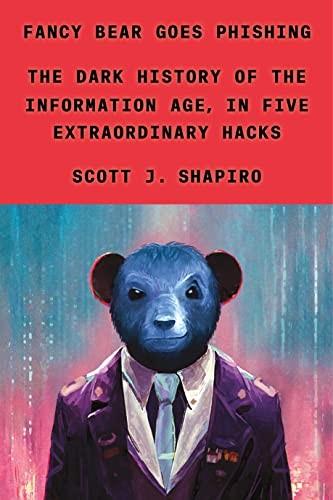
Fancy Bear Goes Phishing: The Dark History of the Information Age, in Five Extraordinary Hacks
by
Scott J. Shapiro
Dimand, The History of Game Theory, Volume 1: From the Beginnings to 1945 (New York: Routledge, 2002), 129. few branches of mathematics: The American Mathematical Society dedicated a whole issue of articles laying out some of von Neumann’s contributions. See Bulletin of the American Mathematical Society 64, no. 3, pt. 2 (May 1958), especially the Stan Ulam article. (it weighed thirty tons): Steven Levy, “A Brief History of the ENIAC,” Smithsonian Magazine, November 2013, https://www.smithsonianmag.com/history/the-brief-history-of-the-eniac-computer-3889120/. Levy claims that the ENIAC had 18,000 vacuum tubes, the figure used in the text, but other estimates range from 17,468 to 19,000. to study natural systems: John von Neumann, Theory of Self-Reproducing Automata, edited and completed by Arthur W.

Rebel Code: Linux and the Open Source Revolution
by
Glyn Moody
Published 14 Jul 2002
And they brought me over to somebody else who was a manager, who talked with me, and said, ‘OK, we’ll hire you.’” Little did he suspect it at the time, but Stallman was about to enter a kind of hacker’s paradise. The hot-house environment created by a tightly knit bunch of great programmers inventing and exploring the new worlds opened up by computing is vividly evoked in Steven Levy’s 1984 book Hackers. Levy describes the classic hacker life: feats of virtuoso coding that ignored minor irritations like times of the day or night; sleeping on the floor of the AI Lab when exhaustion finally won out over inspiration; the countless Chinese meals, the heated conversations, the love of word-play, the pranks.

Big Blues: The Unmaking of IBM
by
Paul Carroll
Published 19 Sep 1994
Michael Killen, IBM: The Making o f the Common View (New York: Harcourt Brace Jovanovich, 1988), 206-210. 3. Manes and Andrews, Gates, 323. 4. Ibid., 361. Magic: The People, Power and Politics Behind the IBM Personal Computer (New York: Facts on File, 1988), 62-63. 2. Stephen Manes and Paul Andrews, Gates (New York: Doubleday, 1993), 136. 3. Chposky and Leonsis, Blue Magic, 75. 4. Steven Levy, Hackers: Heroes o f the Com puter Revolution (N ew York: Dell Publishing Co., 1984), 386. 3 1. William Rodgers, Think: A Biography o f the Watsons and IBM (New York: Stein and Day, 1969), 20-22. 2. Ibid., 11. 3. Ibid., 28-29. 4. Thomas J. Watson, Jr., and Peter Petre, Fa ther, Son ir Co.: My Life at IBM and Beyond (N ew York: Bantam Books, 1990), 19. 5.

Likewar: The Weaponization of Social Media
by
Peter Warren Singer
and
Emerson T. Brooking
Published 15 Mar 2018
THE EMPIRES STRIKE BACK 83 “‘Truth’ is a lost cause”: Peter Pomerantsev and Michael Weiss, “The Menace of Unreality: How the Kremlin Weaponizes Information, Culture and Money” (report, Institute of Modern Russia, 2014), http://www.interpretermag.com/wp-content/uploads/2014/11/The_Menace_of_Unreality_Final.pdf. 83 “Information wants”: Steven Levy, “‘Hackers’ and ‘Information Wants to Be Free,’” Backchannel (blog), Medium, November 21, 2014, https://medium.com/backchannel/the-definitive-story-of-information-wants-to-be-free-a8d95427641c. 83 “The Net interprets”: Philip Elmer-Dewitt, “First Nation in Cyberspace,” Time, December 6, 1993, http://kirste.userpage.fu-berlin.de/outerspace/internet-article.html. 83 “the Japanese guy”: Bruce Sterling, “Triumph of the Plastic People,” Wired, January 1, 1995, https://www.wired.com/1995/01/prague/. 84 first so-called internet revolution: Olesya Tkacheva et al., Internet Freedom and Political Space (RAND, 2013), 121. 84 government censors: Lev Grossman, “Iran Protests: Twitter, the Medium of the Movement,” Time, June 17, 2009, http://content.time.com/time/world/article/0,8599,1905125,00.html. 84 98 percent of the links: “Iran and the ‘Twitter Revolution,’” Pew Research Center, June 25, 2009, http://www.journalism.org/2009/06/25/iran-and-twitter-revolution/. 84 “The Revolution”: Andrew Sullivan, “The Revolution Will Be Twittered,” The Daily Dish (blog), The Atlantic, June 13, 2009, http://www.theatlantic.com/daily-dish/archive/2009/06/the-revolution-will-be-twittered/200478/. 84 Nobel Peace Prize: Lewis Wallace, “Wired Backs Internet for Nobel Peace Prize,” Wired, November 20, 2009, https://www.wired.com/2009/11/internet-for-peace-nobel/. 84 Mohamed Bouazizi: Yasmine Ryan, “The Tragic Life of a Street Vendor,” Al Jazeera, January 20, 2011, http://www.aljazeera.com/indepth/features/2011/01/201111684242518839.html. 85 “Is Egypt about to have”: Abigail Hauslohner, “Is Egypt About to Have a Facebook Revolution?
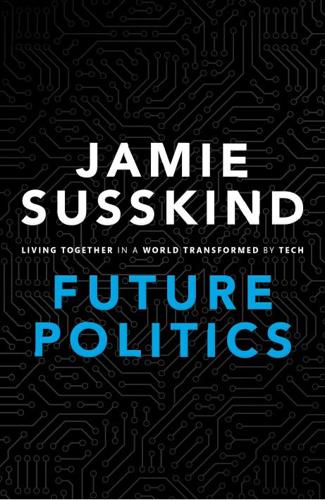
Future Politics: Living Together in a World Transformed by Tech
by
Jamie Susskind
Published 3 Sep 2018
Tom Simonite, ‘Pentagon Bot Battle Shows How Computers Can Fix Their Own Flaws’, MIT Technology Review, 4 August 2016 <https://www.technologyreview.com/s/602071/pentagon-botbattle-shows-how-computers-can-fix-their-own-flaws/?utm_ campaign=socialflow&utm_source=twitter&utm_medium=post> (accessed 1 December 2017). 54. Rawls, Theory of Justice, 326–31. 55. Steven Levy, Crypto: How the Code Rebels Beat the Government—Saving Privacy in the Digital Age (New York: Penguin, 2002), 1. 56. Robert Scoble and Israel Shel, The Fourth Transformation: How Augmented Reality and Artificial Intelligence Change Everything (CreateSpace Independent Publishing Platform, 2017), 124.
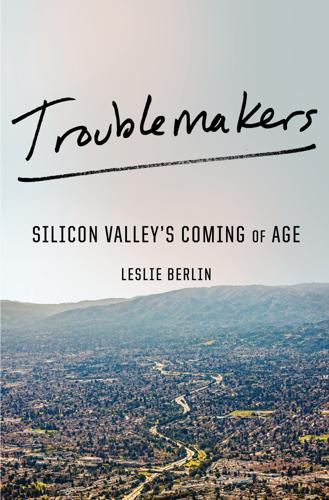
Troublemakers: Silicon Valley's Coming of Age
by
Leslie Berlin
Published 7 Nov 2017
A deep bow to these people who shared their expertise and assistance: the Center for Advanced Study in the Behavioral Sciences 2012–2013 fellows, Janet Abbate, Bob Andreatta, David Brock, Carolyn Caddes, Martin Campbell-Kelly, Catherine de Cuir, Beth Ebben, Benj Edwards, Bret Field, Terry Floyd, Daniel Hartwig, the HP Alumni Association, Paula Jabloner, Kathy Jarvis, Laurene Powell Jobs, Kris Kasianovitz, Mike Keller, Chigusa Kita, Greg Kovacs, Steven Levy, Sara Lott, Anna Mancini, Natalie-Jean Marine Street, John Markoff, Pam Moreland, Mary Munill, Tim Noakes, Bill O’Hanlan, Margaret O’Mara, Sue Pelosi, Nadine Pinell, Sarah Reis, Paul Reist, Nora Richardson, James Sabry, Larry Scott, Lenny Siegel, Lisa Slater, Kurt Taylor, Bill Terry, and Fred Turner.
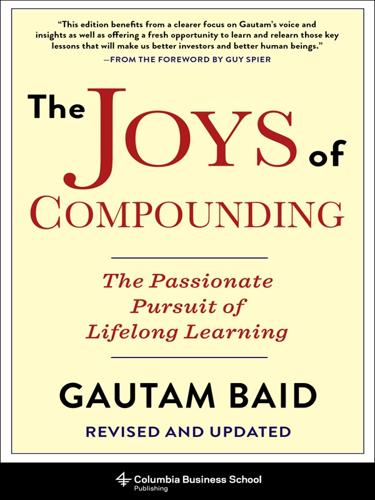
The Joys of Compounding: The Passionate Pursuit of Lifelong Learning, Revised and Updated
by
Gautam Baid
Published 1 Jun 2020
Anshul Khare, “Investing and the Art of Metaphorical Thinking,” Safal Niveshak, November 21, 2016, https://www.safalniveshak.com/investing-art-metaphorical-thinking. 13. Dean LeBaron and Romesh Vaitilingam, Dean LeBaron’s Treasury of Investment Wisdom: 30 Great Investing Minds (Hoboken, NJ: Wiley, 2001). 14. Steven Levy, “Jeff Bezos Owns the Web in More Ways Than You Think,” Wired, November 13, 2011, https://www.wired.com/2011/11/ff_bezos. 15. Aye M. Soe, Berlinda Liu, and Hamish Preston, SPIVA U.S. Scorecard, S&P Dow Jones Indices, Year-End 2018, https://www.spindices.com/documents/spiva/spiva-us-year-end-2018.pdf. 16.

Never Let a Serious Crisis Go to Waste: How Neoliberalism Survived the Financial Meltdown
by
Philip Mirowski
Published 24 Jun 2013
,” on Hyman Minsky influence of on “informational efficacy” and “allocative efficiency,” on Keynesian Theory in New York Review of Books orthodox economics profession on reason for becoming an economist “The Return of Depression Economics,” Kydland–Prescott notion L La Bute, Neil Laibson, David Laissez-faire Lal, Deepak LAMP (Liberal Archief, Ghent) Lanchester, John Landsbanki Lange, Oskar Lasn, Kalle Late Neoliberalism Lehman Brothers Leoni, Bruno Les Mots et les Choses Levin, Richard Levine, David Levitt, Steven Levy, David Lewis, Michael, The Big Short Liberatarianism Liberty Institute Liberty International Liberty League LIBOR scandal Lilly Endowment LinkedIn L’Institut Universitaire des Hautes Etudes Internationales at Geneva Litan, Robert Competitive Equity The Derivatives Dealer’s Club “In Defense of Much, But Not All, Financial Innovation,” writings of Lloyd’s Bank Lo, Andrew on economic crisis Harris & Harris Group Professor of Finance A Non-Random Walk Down Wall Street “Reading About the Financial Crisis,” Lohmann, Larry “Looting: The Economic Underworld of Bankruptcy for Profit” (Romer) Lowenstein, Roger LSE (London School of Economics) Lucas, Robert E.

The Practice of Cloud System Administration: DevOps and SRE Practices for Web Services, Volume 2
by
Thomas A. Limoncelli
,
Strata R. Chalup
and
Christina J. Hogan
Published 27 Aug 2014
• Krishnan details Google’s DiRT program in “Weathering the Unexpected” (Krishnan 2012). • Allspaw explained the theory and practice of Etsy’s program in “Fault Injection in Production” (Allspaw 2012b). • Tseitlin details the Netflix Simian Army and explains how it has improved resilience and maximized availability in “The Antifragile Organization” (Tseitlin 2013). Later Steven Levy was allowed to observe Google’s annual DiRT process first-hand for an article he wrote for Wired magazine titled “Google Throws Open Doors to Its Top-Secret Data Center” (Levy 2012). After the 2012 U.S. presidential election, an article in The Atlantic magazine, “When the Nerds Go Marching in,” described the Game Day exercises conducted by the Obama for America campaign in preparation for election day 2012 (Madrigal 2012).

The Art of UNIX Programming
by
Eric S. Raymond
Published 22 Sep 2003
“Hints for Computer System Design”. October 1983. Available on the Web. [Lapin] J. E. Lapin. Portable C and Unix Systems Programming. Prentice-Hall. 1987. ISBN 0-13-686494-5. [Leonard] Andrew Leonard. BSD Unix: Power to the People, from the Code. 2000. Available on the Web. [Levy] Steven Levy. Hackers: Heroes of the Computer Revolution. Anchor/Doubleday. 1984. ISBN 0-385-19195-2. Available on the Web. [Lewine] Donald Lewine. POSIX Programmer's Guide: Writing Portable Unix Programs. 1992. O'Reilly & Associates. ISBN 0-937175-73-0. 607pp.. [Libes-Ressler] Don Libes and Sandy Ressler.
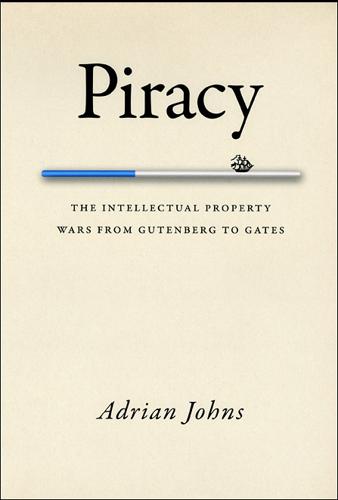
Piracy : The Intellectual Property Wars from Gutenberg to Gates
by
Adrian Johns
Published 5 Jan 2010
By 1963 a TMRC acolyte named Stewart Nelson (who had experimented with phones and radio in Poughkeepsie before arriving at MIT) had made the obvious next step, using a PDP1 computer to sing MF tones into the AT&T network. Soon the students had made their way into systems across the nation. Department of Defense contractors were a particular target. The subsequent trajectory of hacking from Cambridge to Palo Alto and beyond has been well known since Steven Levy’s classic Hackers. Originally a term for a practical joke of the childish but technically neat kind long popular at places like MIT and Caltech, it now came to mean the virtuoso feats of computer cognoscenti – those who neglected every other aspect of life in order to tweak digital systems to create elegant solutions (“hacks”) to tricky problems.

Four Battlegrounds
by
Paul Scharre
Published 18 Jan 2023
Norton, April 24, 2018), 137–145. 31. RACE TO THE BOTTOM 254“race to the bottom”: Portions of this chapter are adapted, with permission, from Paul Scharre, “Debunking the AI Arms Race Theory,” Texas National Security Review 4, no. 3 (Summer 2021): 121–132, http://dx.doi.org/10.26153/tsw/13985. 254“move fast and break things”: Steven Levy, “Mark Zuckerberg on Facebook’s Future, from Virtual Reality to Anonymity,” Wired, April 30, 2014, https://www.wired.com/2014/04/zuckerberg-f8-interview/. 254“We are under so much pressure”: Jack Shanahan, interview by author, April 1, 2020. 254twenty-five years from initial concept: F-35 Joint Strike Fighter (JSF) Program (Congressional Research Service, updated May 27, 2020) https://fas.org/sgp/crs/weapons/RL30563.pdf; The Joint Advanced Strike Technology (JAST) program, which later became the Joint Strike Fighter program, was created in 1993.

Genius: The Life and Science of Richard Feynman
by
James Gleick
Published 1 Jan 1992
Does the new terminology express cynicism or disdain by particle theorists toward their own creations?” “An Historian’s Interest in Particle Physics,” in Brown et al. 1989, 53. 310 THE WINTER FERMI DIED: Gell-Mann, interview. 311 MOST OF HIS BODY WAS CREMATED: Thomas S. Harvey, telephone interview; William L. Laurence, “Key Clue Sought in Einstein Brain,” New York Times, 20 April 1955; Steven Levy, “My Search for Einstein’s Brain,” New Jersey Monthly, August 1978, 43. 311 VARIOUS NINETEENTH-CENTURY RESEARCHERS: Could 1981. 312 IS THERE A NEUROLOGICAL SUBSTRATE: Obler and Fein 1988, 6. 313 ENLIGHTENED, PENETRATING, AND CAPACIOUS MINDS: Duff 1767, 5. 313 RAMBLING AND VOLATILE POWER: Ibid., 9. 313 IMAGINATION IS THAT FACULTY: Ibid., 6–7. 314 IN POINT OF GENIUS: Gerard 1774, 13. 314 A QUESTION OF VERY DIFFICULT SOLUTION: Ibid., 18. 315 IT IS ONE OF THE HOPES: Quoted in Root-Bernstein 1989, 1. 315 A PHYSICIST STUDYING QUANTUM FIELD THEORY: Coleman, interview. 315 FROM GEOMETRY TO LOGARITHMS: Hood 1851, 10–11. 316 THE ASTROPHYSICIST WILLY FOWLER: Thorne, interview; Fowler, interview conducted by Charles Weiner, 30 May 1974, AIP: “I just thought Feynman’s talking through his hat, what can he possibly mean, what can general relativity have to do with these objects?”
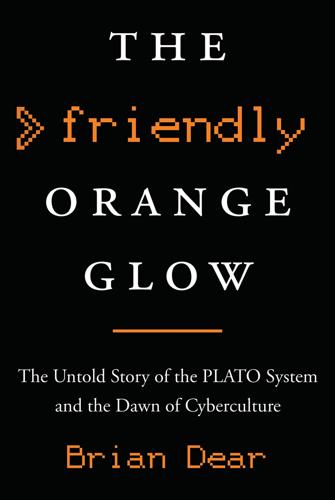
The Friendly Orange Glow: The Untold Story of the PLATO System and the Dawn of Cyberculture
by
Brian Dear
Published 14 Jun 2017
I’m also grateful for the kindness and hospitality of Paul Tenczar (who made himself available for numerous interviews over the years) and his wife, Darlene; they let me rummage through a suitcase full of Paul’s photographic slides. Thanks to Andy Hertzfeld, Paul Resch, Bill Galcher, Donald Norman, Dan O’Neill, and Ray Ozzie for reviewing all or portions of the manuscript over the years. Thanks also to writers Steven Levy and John Markoff, whose inspiring writing, support, and encouragement have helped give me the strength to finish this book. Thanks to Ralph Nader and William C. Taylor, authors of The Big Boys: Power and Position in American Business (Pantheon, 1986), who without hesitation gave me two boxes full of all of their research on Control Data Corporation, including raw interview transcripts and handwritten reporter’s notes, which I put to extensive use in Part Three of this book.

I Want My MTV: The Uncensored Story of the Music Video Revolution
by
Craig Marks
and
Rob Tannenbaum
Published 19 Sep 2011
Both articles took disapproving tones. Time sniffed that “the majority of clips now in circulation are labored ephemera with heavily imitative associations,” unfavorably compared Duran Duran (“an affable, uninspired British band currently aglow with success”) to Beethoven, and concluded, “the pervading silliness is worrisome.” Steven Levy, writing in Rolling Stone, unfavorably compared “superficial, easy-to-swallow” acts such as Adam Ant to Bob Dylan. To bolster his accusation that “heavy-metal pounding” videos were dangerously violent, he quoted Dr. Thomas Radecki, chairman of the right-wing National Coalition on TV Violence, who a year later testified to Congress on behalf of the PMRC (Parents Music Resource Center) and served on their board of directors.
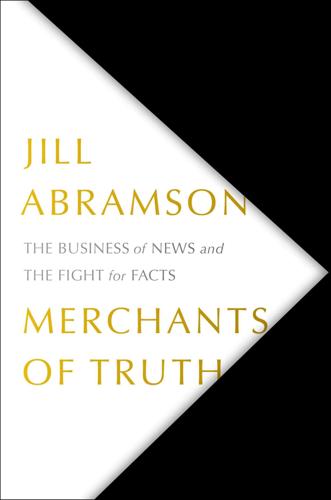
Merchants of Truth: The Business of News and the Fight for Facts
by
Jill Abramson
Published 5 Feb 2019
By October inbound traffic: Justin Osofsky, “More Ways to Drive Traffic to News and Publishing Sites,” Facebook, October 21, 2013, https://www.facebook.com/notes/facebook-media/more-ways-to-drive-traffic-to-news-and-publishing-sites/585971984771628. One change would privilege: Varun Kacholia, “News Feed FYI: Showing More High Quality Content,” Facebook, August 23, 2013, https://www.facebook.com/business/news/News-Feed-FYI-Showing-More-High-Quality-Content. Only a few years earlier: Steven Levy, “Inside the Science That Delivers Your Scary-Smart Facebook and Twitter Feeds,” Wired, April 22, 2014, https://www.wired.com/2014/04/perfect-facebook-feed/. So Facebook launched an internal effort: Victor Luckerson, “Here’s How Facebook’s News Feed Actually Works,” Time, July 9, 2015, http://time.com/collection-post/3950525/facebook-news-feed-algorithm/.
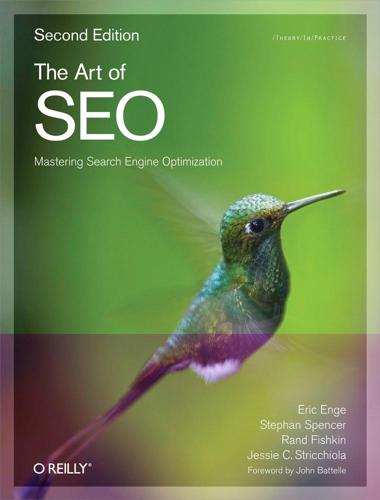
The Art of SEO
by
Eric Enge
,
Stephan Spencer
,
Jessie Stricchiola
and
Rand Fishkin
Published 7 Mar 2012
Embedding important keywords or entire paragraphs in an image or a Java console renders them invisible to the spiders. Likewise, the search engines cannot easily understand words spoken in an audio file or video. However, Google has begun to leverage tools such as Google Voice Search in order to “crawl” audio content and extract meaning (this was first confirmed in the book In the Plex by Steven Levy, published by Simon & Schuster). Baidu already has an MP3 search function, and the Shazam and Jaikoz applications show the ability to identify song hashes today as well. Using alt attributes, originally created as metadata for markup and an accessibility tag for vision-impaired users, is a good way to present at least some text content to the engines when displaying images or embedded, nontext content.

Digital Empires: The Global Battle to Regulate Technology
by
Anu Bradford
Published 25 Sep 2023
Citron & Neil Richards, Four Principles for Digital Expression (You Won’t Believe #3!), 95 Wash. Univ. Law Rev. 1353, 1353 (2018). 80.Citron & Richards, supra note 79, at 1353. 81.Packingham v. North Carolina, 137 S. Ct. 1730, 1737 (2017). 82.Goldsmith, The Failure of Internet Freedom, supra note 19; Bomse, supra note 8, at 1717–1718, 1725. 83.Steven Levy, Battle of the Clipper Chip, N.Y. Times Mag., June 12, 1994, https://www.nytimes.com/1994/06/12/magazine/battle-of-the-clipper-chip.html. 84.Press Release, President Clinton, A Framework for Glob. Elec. Com., https://clintonwhitehouse4.archives.gov/WH/New/Commerce/read.html, discussed in Goldsmith, The Failure of Internet Freedom, supra note 19. 85.Magaziner, Framework, supra note 18. 86.U.S.
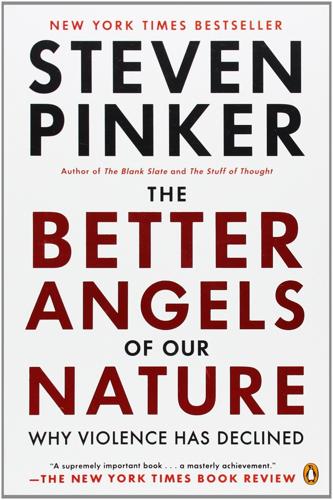
The Better Angels of Our Nature: Why Violence Has Declined
by
Steven Pinker
Published 24 Sep 2012
Lawrence, Saint Lea, Rod leaders: complexity of speeches intelligence of motives of narcissism of openness to experience in overconfidence in selection of women see also autocracy; democracy; despotism; monarchy League of Nations Leary, Timothy LeBlanc, Steven Lebow, Richard Ned Lee, Harper Lehrer, Tom Lemkin, Raphael Lennon, John Leonardo da Vinci Leopold, king of Belgium Levi, Michael Levi, Primo Levi, Werner, The Coming End of War Leviathan: aggression curbed by and commerce emergence of and human nature international introduction of concept legitimate use of force by monarchies and Pacifist’s Dilemma in violence triangle see also anarchy; government; states Levin, Jack Levitt, Steven Levy, Jack Lewis, Bernard liberal democracy liberalism: classical and conservatism and gentle commerce and intelligence and morality and nationalism and Rights Revolutions use of term Liberal Peace Liberia, civil war in libertarianism Liebenberg, Louis life history theory lightning strikes limbic system Lincoln, Abraham Lindow Man literacy Lithgow, William Li Zhisui Lloyd George, David Locke, John Some Thoughts Concerning Education Two Treatises on Government Lodge, David Loewenstein, George London Blitz Long, William Long Peace chemical weapons democratic peace disarmament great power wars and Humanitarian Revolution introduction of concept Kantian Peace Liberal Peace nuclear peace numbers related to violence in 20th century Lorenz, Konrad loss aversion Lott, Trent Luard, Evan Luria, Alexander Luther, Martin macabre voyeurism Macaulay, Thomas McCauley, Clark McClure, Samuel McCormack, Mary Ellen McCullough, Michael MacDonald, Heather Mack, Andrew McKinley, William McLuhan, Marshall McNamara, Robert S.
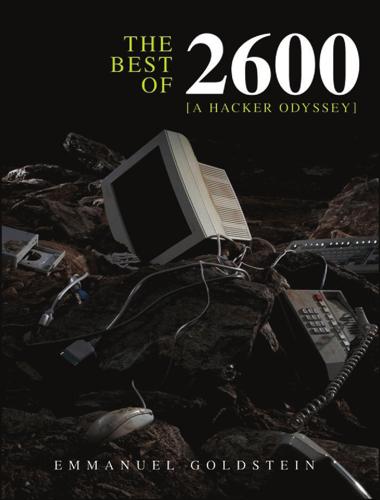
The Best of 2600: A Hacker Odyssey
by
Emmanuel Goldstein
Published 28 Jul 2008
Until now, however, hackers have had to worship their idols from afar. Cyberpunk: Outlaws and Hackers on the Computer Frontier unites hackers in this true-life testimony by presenting an in-depth, up-front view of these “techno-menaces” without the overreactive doomsday prophecies that usually accompany such a work. Cyberpunk is a fitting sequel to Steven Levy’s classic Hackers. Whereas Levy’s treatise addressed the origins of hacking in its infancy, Cyberpunk is the New Testament depicting hacking as it is in the here and now. More than just a synthesis of current trends, however, Cyberpunk depicts the hacking lifestyle and cyberpunk culture that has evolved alongside our boundless fascination with computers and information.